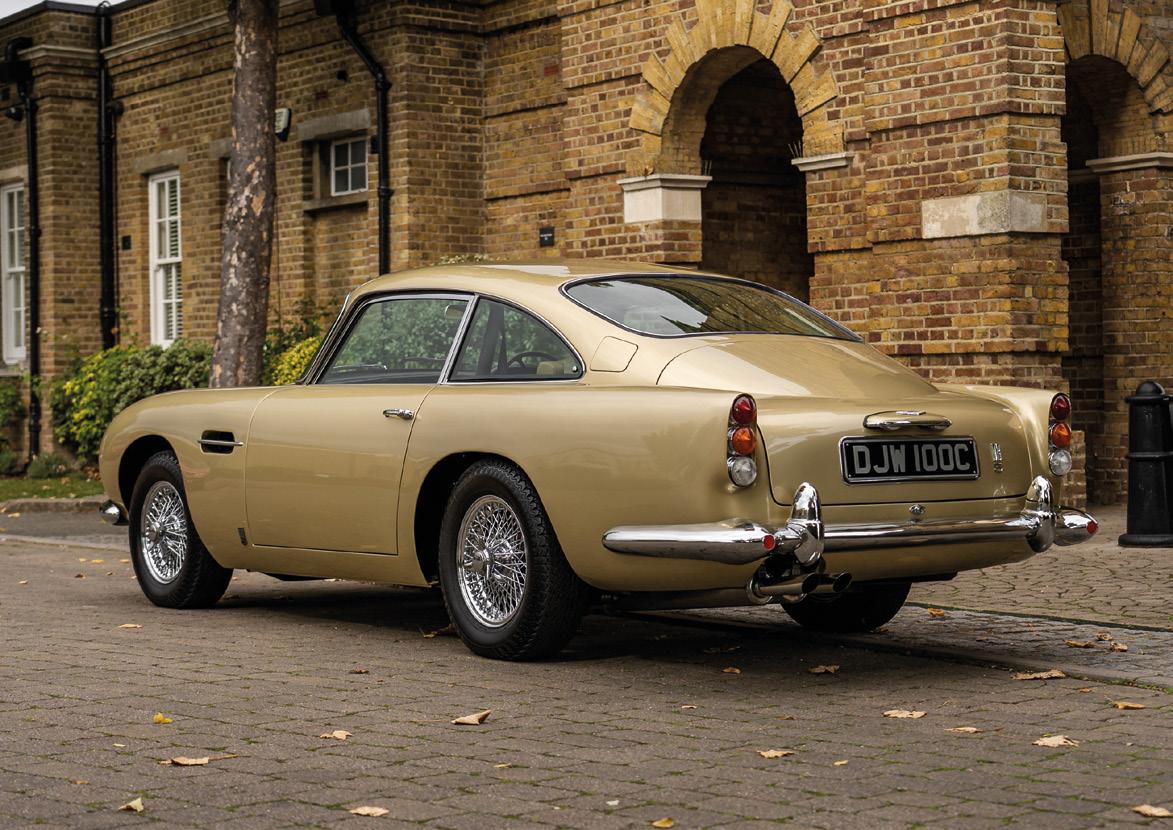




90 1963 AC Greyhound
55 1934 Alvis Speed 20SB Vanden Plas
‘Flatback’ Saloon
201 1949 Armstrong Siddeley 16hp Hurricane
80 1965 Aston Martin DB5
214 1996 Aston Martin DB7
79 1996 Aston Martin DB7 Volante
99 1997 Aston Martin DB7
98 1995 Aston Martin DB7 Coupe
103 2006 Aston Martin DB9 Volante
97 1957 (Aston Martin) Lagonda DB 3 Litre
MKII Saloon
107 c.1992 Aston Martin Virage
87 1938 Austin 10 Cambridge
67 1928 Austin 16/6 Salmons Tickford
All-Weather Saloon
225 1957 Austin A35 Van
62 1959 Austin A35 Van
52 1954 Austin Healey 100
Modified to ‘M’ Specification
42 1955 Austin-Healey 100
Modified to M-Specification
246 1965 Austin Mini Cooper MkI
24 1981 Austin-Morris Mini 95L Pickup
86 1932 Austin Seven RN Saloon
9 1974 Autobianchi 500 Giardiniera Estate
111 1924 Bentley 3 Litre Vanden Plas Tourer
50 1925 Bentley 3 Litre Speed Model Vanden Plas Tourer
41 1934 Bentley 3.5 Litre ‘Figoni et Falaschi’ Style Tourer
48 2003 Bentley Arnage R
100 2000 Bentley Arnage Red Label
215 1996 Bentley Brooklands
238 2005 Bentley Continental GT
58 1996 Bentley Continental R
13 1988 Bentley Eight
8 1956 Bentley S1 Continental Coupe
22 1958 Bentley S1
85 1959 Bentley S1 Saloon
211 1949 Bentley MkVI Saloon
227 1950 Bentley MkVI Saloon
95 1997 Bentley Turbo RT LWB
21 1987 BMW 320i Baur Cabriolet
1974 BMW 3.0 CSi
1986 BMW 635 CSi
1986 BMW 635CSi Coupe
2004 BMW 645Ci
20 1999 Bristol Blenheim 2
1934 BSA 3-Wheeler TW35-10
249 1915 Buick ‘Four’ Model C37 Tourer
224 1938 Buick Series 80 Roadmaster
c.1912 Cartercar Model R Roadster
1941 Chevrolet Special Deluxe Sedan
1965 Chevrolet Corvette Sting Ray Convertible
2 1955 Daimler Conquest Century
Coupe
1960 Daimler Dart
17 1962 Daimler Dart SP250 ‘B-Spec’
1949 Daimler DB18 2 ½ Litre Foursome
Coupe
1955 Daimler Empress III DF 308 by Hooper
1933 Daimler Fifteen Sportsman’s Coupe
1977 Daimler Sovereign 4.2 Coupe
1970 Ford Galaxie
1931 Ford Model A Roadster
1918 Ford Model T Delivery Van
1923 Ford Model T Roadster
1914 Ford Model T Tourer
1928 Hadfield Bean
c.1955 Hamilton Riley Special
1929 Humber 9/28 Light Tourer
1903 Humberette 5hp Two-Seater
1969 Jaguar E-Type
1970 Jaguar E-Type 4.2 Roadster
1972 Jaguar E-Type V12 Coupe
1973 Jaguar E-Type V12 Coupe
1959 Jaguar MkI 3.4 Litre
1963 Jaguar MkII 3.4
1966 Jaguar MKII 3.4 Litre
1966 Jaguar MkII 3.8
1994 Jaguar XJ6 3.2
1989 Jaguar XJR-S Hyper
1988 Jaguar XJ-S V12 Convertible
1988 Jaguar XJ-S V12 Convertible
1988 Jaguar XJ-S V12 Convertible
1990 Jaguar XJ-S V12 Convertible
1992 Jaguar XJS V12 Coupe
1960 Jaguar XK150 SE 3.4 Litre FHC
1957 Jaguar XK150 SE 3.8 Litre FHC
1958 Jaguar XK150 SE FHC
1959 Jaguar XK150 S 3.8 Litre
Coupe
2008 Jaguar XK 4.2
2010 Jaguar XK 5.0 Portfolio
1999 Jaguar XK8 Coupe
1999 Jeep Wrangler 4.0 Sport
1972 Jensen Interceptor III
78 1928 Lagonda 14/60 Two-Litre
Semi Sports Tourer
1972 Lamborghini Espada Series II
1953 Lanchester 14 Saloon
1935 Lanchester Twelve Light Six
Head Coupe
1972 Lancia Fulvia 1600 HF
1964 Land Rover Series IIA
Coupe
1971 Lotus Elan +2 ‘S’ 130
1991 Maserati Bi -Turbo Spyder E
1911 Maxwell Model AB Runabout
1909 McIntyre Model NN ‘Utility’
1958 Mercedes-Benz 190 SL
1960 Mercedes-Benz 190SL Roadster
1964 Mercedes-Benz 220 SEB
1990 Mercedes-Benz 260 E
1977 Mercedes-Benz 450 SL
1985 Mercedes-Benz 560 SL
1987 Mercedes-Benz 560 SL
2009 Mercedes-Benz CL500
1998 Mercedes-Benz SL 320
1991 Mercedes-Benz SL 500
2003 Mercedes-Benz SL 500
1968 MG B GT
1972 MG B Roadster
1937 MG TA
1937 MG TA Q Special
1949 MG TC Supercharged
1947 Morgan 4-4 Series I
1969 Morgan 4/4 1600
1997 Morgan 4/4 1.8
1963 Morris Mini Cooper MkI 997cc
1949 Oldsmobile Rocket 88
1996 Pilgrim Speedster
1934 Pontiac “8” Cabriolet Coupe Series 603
1969 Porsche 911 E Targa 2.0
1970 Porsche 911 E Targa 2.2
1994 Range Rover Classic LWB 4.2 LSE
Registration Number ‘255 D’
1934 Riley 9 Lynx Tourer
1926 Rolls-Royce 20hp Landaulette
1926 Rolls-Royce 20hp
& McKay Saloon
1931 Rolls-Royce 20/25 Cabriolet De Ville
1932 Rolls-Royce 20/25 Drophead Coupe
1931 Rolls-Royce 20/25 Light Saloon
1930 Rolls-Royce 20/25 Sedanca de Ville
1933 Rolls-Royce 20/25 Sports Saloon
1982 Rolls-Royce Corniche Convertible
1989 Rolls-Royce Corniche II Convertible
1990 Rolls-Royce Corniche Convertible
1991 Rover Mini Cooper
1934 Rolls-Royce Phantom II Continental Sedanca Coupe
1937 Rolls-Royce Phantom III Sports Limousine
1965 Rolls-Royce Phantom V
1975 Rolls-Royce Silver Shadow I
1980 Rolls-Royce Silver Shadow II
1995 Rolls-Royce Silver Spirit III
1995 Rolls-Royce Silver Spirit III
1938 Rover 10hp Coupe
1992 Rover Mini British Open Classic
1995 Safari Serengeti Deluxe
1956 Studebaker Golden Hawk
1967 Sunbeam Alpine Series V
1954 Swallow Doretti
1925 Talbot 10/23 Tourer
1930 Talbot AM90 Close-Coupled
1961 Thames Trader
1936 Triumph Gloria Vitesse Tourer
1955 Triumph TR2
1959 Triumph TR3A
1962 Triumph TR3B
1969 Triumph TR6
1971 Triumph TR6
1973 Triumph TR6
1962 (1959) TVR Grantura
1971 Vanden Plas 1300
1956 Volkswagen ‘Oval Window’ Beetle
1968 Volkswagen Prowler Dune Buggy
1968 Volkswagen Type 2 Camper Van
1932 Wolseley Hornet Special Eustace Watkins Daytona


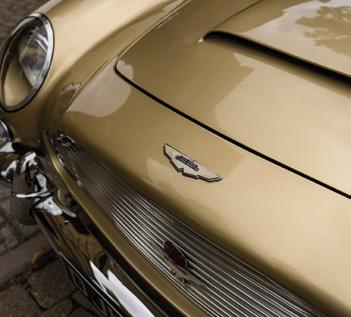
Prospective purchasers are respectfully advised to read the Terms and Conditions of Sale carefully before bidding on any lot, as they form the terms of your contract with us, whether or not you are a successful bidder.
Admission H&H has the right at its sole discretion, without assigning any reason whatsoever, to refuse admission to any of its sales or indeed its premises to any person. The purchase of a catalogue does not constitute an entry ticket or guarantee entry.
All intending buyers are required to complete a Bidder’s Registration Form. This will enable you to bid at the sale by means of a number allocated to you. All prospective bidders must provide photographic identification and bank card details to verify their identity. Lots sold will be invoiced to the registered bidder.
We reserve the right to request banker’s references from prospective purchasers and these should be supplied in time to allow them to be taken up prior to the sale. Failure to comply with this could result in the facility to bid being withdrawn.
Solely for the convenience of bidders, a currency converter is provided at H&H sales. The rates quoted for conversion of other currencies to pounds sterling are indicative only and provided by our partner Argentex. We will not be responsible for any errors, inaccuracies or omissions in the currency converter.
In the case of Commission, Telephone and Online Internet bidding, the following increments will apply:
Under £1,000 At the Auctioneers discretion
£1,000 - £2,000 £100
£2,000 - £5,000 £200/300
£5,000 - £10,000 £500
£10,000 - £20,000 £1,000
£20,000 - £50,000 £2,000/3,000 £50,000 - £100,000 £5,000
Over £100,000 At the Auctioneers discretion
Purchasers are reminded that a Buyers’ Premium is payable on all lots and is subject to VAT at the prevailing rate. The rates are as follows:
Motor Cars 12.5% (minimum of £150)
Registrations 15% (minimum of £50)
Motorcycles 15% (minimum of £50)
Bicycles 15% (minimum of £10)
Automobilia 15% (minimum of £5)
Please be reminded that the insurance is the buyer’s responsibility from the fall of the hammer.
H&H is acting as the agent of the Seller in offering his lot for sale by auction. We cannot and do not inspect each lot in detail to verify the Seller’s description - often we only see it shortly before the Sale. Therefore, we cannot and do not take responsibility for the condition of the lot or the accuracy of its description. This is the reason for our very specific terms as to roadworthiness (Condition 19.1) and absence of warranties (Condition 12.1), which intending purchasers should read carefully.
We will make reasonable efforts to execute commission and telephone bids when instructed provided they are received by 5pm the day before the Sale. Lot(s) will be bought as cheaply as is allowed by other bids and reserves. Where more than one commission bid is submitted at the same winning amount, the commission bid submitted to the Auctioneer first will be the winning bid. We reserve the right to request a refundable deposit of approximately 10% of the intended bid amount.
For immediate clearance of Lot(s) full payment must be made to H&H Classics Limited by means of Visa Debit or Credit Card, Maestro, MasterCard, Cash up to the GBP equivalent of €10,000 or Interbank Transfer by 12.00 noon the day following the sale. In any event purchasers are reminded that clearance of Lot(s) may only be effected once we have received cleared funds in our account. For Purchaser’s wishing to pay by bank transfer our bank account details are as follows:
NatWest, 23 Sankey Street, Warrington, Cheshire, WA1 1XH
Account Name: H&H Classics Client Account Account No: 58868984
Sort Code: 01-09-17
BIC: NWBKGB2L
IBAN: GB20NWBK01091758868984
Buyers are reminded that the presence of an old HVIF (FIA papers) or other documentation does not constitute a ‘promise’ on behalf of the MSA or other issuing authority that they will be re-issued on demand. A car’s application for a Historic Technical Passport will be subject to the prevailing regulation in Appendix K and can be reviewed, much the same way Veteran Cars can be re-dated, as new information comes to light. The Issuing Authority can refuse to issue new papers. Any prospective purchaser should check the position of the Lot prior to bidding.
When mention is made of the Veteran Car Club of Great Britain Dating Plates and Certificates in this catalogue it should be borne in mind that the Veteran Car Club of Great Britain does from time to time review cars already dated and, in some instances, where fresh evidence becomes
available, alter the date. Whilst the Club makes every effort to ensure accuracy, the date shown on the Dating Plate or Dating Certificate cannot be guaranteed as correct and intending purchasers should make their own enquiries as to the date of the car.
Export licences may be required for any lot manufactured or produced 50 years or more prior to the date of export from the U.K. It is the responsibility of the buyer to obtain the licence and correct documentation prior to the exportation of the lot.
PLEASE NOTE: We have been advised that vehicles registered on, and imported from, the Isle of Man are not subject to Import Duty. Nor is a NOVA application required for their re-registration in the United Kingdom.
Any motor vehicle is sold as a collector’s item and not as a means of transport. Buyers are specifically warned that any vehicle sold as such may well have had parts replaced and paint renewed or be made up of parts from other vehicles the condition of which may be difficult to establish. The Auctioneer has to rely on information as to the date, condition and authenticity provided by the Seller and does not provide its own description, and does not and cannot undertake its own inspection of vehicles or other Lot and it is the responsibility of the Buyer to ensure that the Lot conforms to the description in the catalogue. The Auctioneer cannot check or verify the authenticity of the chassis or VIN number under which a vehicle is offered, but relies on the Seller’s description. Buyers should take particular care to verify in advance the authenticity of a vehicle that is claimed to have important racing, rallying or ‘exworks’ history as it was common in period for a competition vehicle of a single identity to have more than one chassis, body or other mechanical components. This may have happened several times, both in a vehicle’s ‘works’ career and thereafter in private owner hands. Sometimes ‘works’ vehicles were fitted with different registration plates, so that a vehicle could meet a particular event’s start date deadline. These historical factors may lead to there being in existence multiple and competing claimants to the same vehicle identity.
A representative of our preferred transport provider E.M. Rogers will be present at the sale to assist with any transport requirements. All lots are held at the purchaser’s risk at the fall of the hammer and must be removed not later than 1pm on the day following the sale. Please note, if lot(s) are not removed by then the standard charges as stated in our Terms and Conditions will apply.




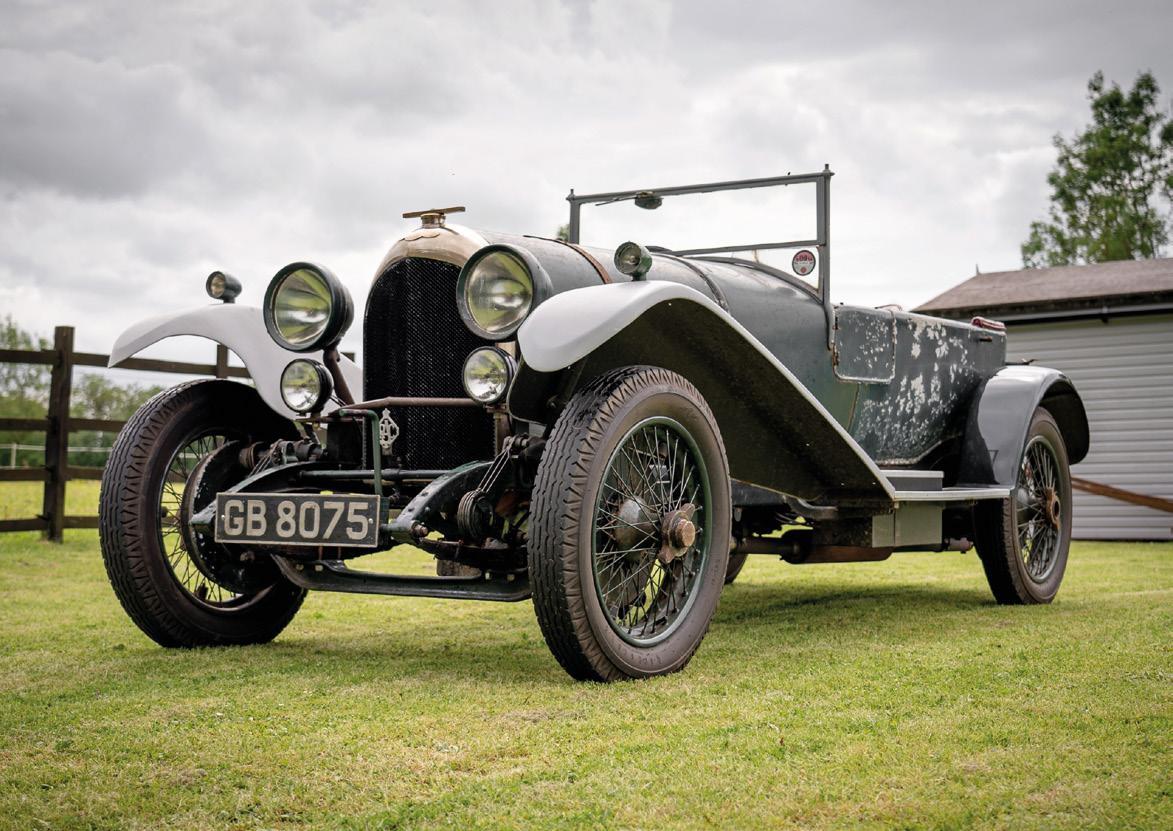

Born in 1940, the only child of only children parents, Bob was educated at Stockport Grammar School then read natural sciences at Christ Church, Oxford. He joined William Deacon’s Bank, and had a stellar ascent through it and its subsequent iterations ending up as Group Treasurer of the Royal Bank of Scotland. He grasped the opportunity of early retirement in 1990 and moved to the Isle of Man where he had been left a house by an aunt. But Bob was far from being inactive, throwing himself into the local community and taking on the turnaround of a local private bank as its Executive Chairman.
Sailing had been a preoccupation during his time in the City, but on coming to the Isle of Man, Bob switched his energies and focus to collecting “quality cars” – principally the products of Cricklewood, Derby and Crewe, but with some maverick exceptions such as Maserati and
Caterham. Daimlers and Lanchesters also featured, and he had to move to a large country house to find garaging for the ever-growing collection. His cars were regularly campaigned at rallies for the appropriate marque and were often deserved winners of various trophies. He also got involved in the relevant enthusiast clubs, usually ending up as Chairman – and his list of appointments included the Chairmanship of the Manx Classic Car Club and the Manx Motor Racing Club.
Bob was always a keen supporter of local charities, particularly maritime and those involving young people, and many will have cause to remember with gratitude his generosity and his apparently bottomless well of technical knowledge on “quality cars”, so freely shared. Bob left his Estate predominantly to Charity with the RNLI being the Residuary Beneficiary. Thus, in effect, the entire proceeds of the car collection sale will be received by the RNLI.

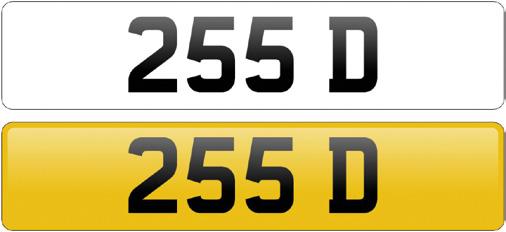
Registration Number ‘255 D’, due to be offered on a Retention Certificate.
Offered from the late Robert Riding’s Estate, the vast majority of which has been left to charity with the RNLI as the predominant beneficiary.

A replacement for the now outmoded Consort, the Conquest first saw the light of day in the Spring of 1953. One of just 234 Drophead Coupes understood to have been produced, chassis 87672 was manufactured in 1955 and registered new on the 10th of February that year, being registered new to a Willerby & Co. Ltd. of London W1 as ‘PXR 739’. Fitted with the 2433cc straight-six engine allied to the three-speed pre-selector gearbox, the Daimler presents in Dark Blue paintwork, with a complementary Dark Blue leather interior upholstery. Entering into the Robert Furniss Riding collection last year, the Drophead is offered from the late Robert Riding’s Estate the vast majority of which has been left to charity with the RNLI as the predominant beneficiary.

Subject to much-documented improvement work through the 1960s, upon entering into the custody of the first private owner, the renovation included a complete engine overhaul, electrical remediation, and steering refreshment. A worthy restoration project, since entering the collection in 2021, the Daimler has benefitted from engine recommissioning, removal of filler and rust in the bodywork, and some fabrication of repair panels to the cost of some £2,100 in total. Offered with a history file that contains the original ‘Buff’ RF60 logbook, invoices relating to the work completed in the 1960s, correspondence with Stratstone Ltd. and the first private owner, invoices relating to the restoration work already partook, an owner’s handbook, and a selection of MOT certificates from the 1970s/80s.

Unveiled in 1922, the 20hp was a second string to the Rolls-Royce bow - a shorter, more economical sibling to the Silver Ghost which broadened the marque’s reach across the wealthy classes.


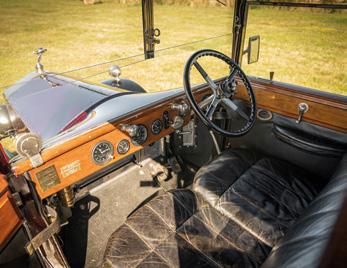
Taking delivery on the 6th of March 1926, the renowned London coachbuilder Hooper & Co proceeded to clothe chassis ‘GOK 48’ as a Landaulette (Barker Body number 5290). Supplied new to a Mrs Stafford of the Hyde Park Hotel in Knightsbridge, the Rolls-Royce was acquired by its second owner a W. Shearer Esq of Messers Balfour & Co. in Chislehurst, Kent on the 12th of July 1934. Returning to London in 1937, the 20hp was purchased by a Dr Grayton Hume of the famous Harley Street, London.
From here, unfortunately, the history of ‘GOK 48’ is unknown until 1967 when the 20hp was discovered in a semi-derelict state. Entrusted to Richard Moss who embarked on a two-year restoration, by December 1967 it was found that the frame was in extremely sound condition. With the comprehensive restoration completed, ‘YN 9313’ embarked on its first outing to the 1969 Blenheim Palace rally, winning its class on the day. Additional award wins ensued up until the 1990s.
The beneficiary of comprehensive restoration work between 1989 and 1992 with invoices to the sum of approximately £42,000. It was subsequently acquired by Robert Furniss Riding as an addition to his private collection in 2001, who spent further funds on maintenance and improvement. ‘YN 9313’ is now offered at No Reserve from the late Robert Riding’s Estate, the vast majority of which has been left to charity with the RNLI as the predominant beneficiary.
‘GOK 48’ is accompanied by a history file that includes an original handbook; RREC awards; a vast quantity of invoices for work completed since 1988; a collection of previous MOTs from 2001-2012; RREC chassis card records; technical literature and diagrams; sundry paperwork; and current V5C document. This decidedly attractive Rolls-Royce’s return to the market for the first time in twenty-one years is surely an opportunity not to be missed.
The Bi -Turbo was first made in 1981 as an up-market Sports-Saloon employing a unitary-construction bodyshell. This attempt to broaden the market for one of the great names of Italian motoring history was equipped with MacPherson strut front suspension, independent rear suspension via coil-sprung trailing arms and disc brakes on all four wheels and could be ordered with either a V6 or V8 motor of 2.0, 2.5, 2.8 or 3.2-litre capacity.
Manufactured in 1991, the Zagato-bodied Spyder was supplied new via Maserati dealers Kesterlian Sackville, Manchester, being registered new as ‘H577 ANF’ on the 1st of October that year. Fitted with the 2790cc V6 engine with the (special order) four-speed ZF automatic transmission, the Maserati is finished in Red with Cream leather interior upholstery and a Black hood. The Bi-Turbo has a recorded mileage just shy of 53,500 miles (at time of consignment) and has had only five owners from new, residing in the ownership of Robert Furniss Riding from 2001. Offered at ‘No Reserve’ from the late Robert Riding’s Estate, the vast majority of which has been left to charity with the RNLI as the predominant beneficiary.



Generously equipped air-conditioning, electric-powered seats, powerassisted steering, four-speed automatic gearbox and the full Maserati enhancement kit, the Bi-Turbo Spyder has received much improvement during its current ownership. Enhancements have recently included servicing and a cambelt change less than 500 miles previous, with replacement power-steering belts, and new front brake pads in 2016. A further cambelt change and service, air-conditioning remediation, electrical fettling, overhauled front struts and suspension were also provided in 2021.
The Maserati is offered with a history file which includes the original stamped service book (displaying entries from Maserati main dealers and specialists), owner’s manual, original sales literature, a large collection of invoices from during Robert’s ownership, copies of previous V5C documents, previous Isle of Man tax discs and the Isle of Man registration document. 1 of just 147 RHD 2.8 litre Spyders made, this rare and stylish modern classic is temptingly offered at ‘No Reserve’.

Manufactured in 1971, the 1300 offered was provided to BMC distributors Cockshoots of Hyde and retained by them for a few months as a dealer demonstrator. Spotted in the showroom by the late Robert Furniss Riding’s mother, who is said to have remarked on the ‘Bentley-style grille’ on a small car, the family purchased the Vanden Plas on the 1st of April 1971. Passed from mother to Robert upon her passing, the Vanden Plas is now offered from the late Robert Riding’s Estate at ‘No Reserve’, the vast majority of which has been left to charity with the RNLI as the predominant beneficiary. Fitted with the 1300cc straight-four engine allied to the four-speed AP automatic transmission, the ‘ADO16’ presents in Trafalgar Blue with complementing Grey interior upholstery.
A highly original and unrestored example, presenting with factory spot welds evident, the Vanden Plas has recently benefitted from a full service, brake fluid change, and new water pump in 2018 (to the cost of some £1,500); a replacement battery in 2019; and fuel system remediation in 2021. Accompanied by a history file that contains the owner’s handbook, the original stamped Passport to Service; servicing record folder; a large selection of older servicing and work invoices dating back to the early 1990s; recent invoices for work completed; several MOT certificates from the 1980s and 1990s; scans of previous registration documents; period photographs; and the Isle of Man registration document.



‘Powerful, docile, delightfully easy to control and a thoroughbred, it behaves in a manner which is difficult to convey without seeming to over-praise,’ (The Motor magazine’s conclusion after testing a Phantom II Continental in March 1934).
France’s enviable network of Route Nationales was used by both W.O. Bentley and Henry Royce to test the mettle (and metal) of their prototypes. Indeed, it was a high-speed encounter with a fledgling Rolls-Royce New Phantom that reputedly convinced W.O. to increase the engine capacity of his first six-cylinder offering to 6½ litres. Conscious that a number of ‘owner/drivers’ preferred the more sporting mien of a Bentley, Royce and one of his development engineers Ivan Evernden set about developing a higher performance and more responsive version of the recently introduced 7.7 litre Phantom II. Christened the Continental in recognition of its high-speed touring capabilities, the newcomer debuted during late 1930 (just in time to go head-to-head with the equally impressive Bentley 8 Litre). Sat on a shorter wheelbase chassis (144in), it also featured a higher rear axle ratio, lowered steering column and revised rear suspension when compared to the standard model. Often hailed as the ultimate six-cylinder Rolls-Royce and notable as the last design to be overseen by Henry Royce himself, the Phantom II Continental was prodigiously expensive with many examples costing £2,500 or more once completed (the equivalent to six or seven averaged-priced houses at the time!)
Sold to a ‘Who’s Who’ of contemporary society, the 270 examples made were owned by the likes of: Sir Malcolm Campbell, Woolf Barnato, Prince Ali Khan, the Prince of Nepal, various members of the British nobility, the Rothschilds, the Maharajas of Bahawalpur and Jodhpur, N S Gulbenkian and Noel Coward.
According to its accompanying RREC copy build sheets, chassis 175RY was specified for use in the ‘UK and on the Continent. Both Fast Touring’. Intended like most such owner/driver machines to typically carry two people (but capable of accommodating five), its supremely elegant Sedanca Coupe coachwork was crafted by H.J. Mulliner. A Three-Position Drophead Coupe in all but name, the Rolls-Royce was supplied new via Jack Barclay Ltd of Hanover Square, W1 to Richard Tredenham Fox-Carlyon Esq of Costislost, Washaway, Cornwall who was a mere twenty-two years old at the time. Among the county’s largest landowners whose fortunes had been bolstered by various tin mines, the Carlyon family may have found the Phantom II Continental unwieldy on Cornwall’s tight and twisty roads because it was returned to Jack Barclay Ltd a matter of months later. The Sedanca Coupe’s second owner was the renowned dance band leader Bert Ambrose Esq. who had it repainted Black with a contrasting coachline before taking delivery during January 1935 with the balance of the manufacturer’s original guarantee intact. Alternating residencies between The Embassy Club and The May Fair Hotel during the 1930s and typically paid £10,000 per year or more for his services, Ambrose part-exchanged a Bentley Speed Six Coupe and paid a further £1,700 to acquire chassis 175RY! Obviously much taken with the Rolls-Royce, the dance band leader kept it for eighteen years by which time changing musical tastes had reduced his income.
Briefly owned by Frederick Maurice who gave his address as The Athenaeum Club, Waterloo Place, London W1, the Phantom II Continental belonged to James George Tuddenham of Cawston, Norfolk from 1954 until 1969. Apparently little used towards the end of his tenure, the Sedanca Coupe was bought by the renowned Rolls-Royce dealer Frank Dale and retained by his stepson, Ivor Gordon, for the next twenty-five years; a testament to how special they both felt chassis 175RY to be. Mechanically recommissioned by marque specialist Jack Humphrey at the heady cost (in 1969) of £367, the imposing Three Position Drophead Coupe became a familiar sight at RREC gatherings during the 1970s and 1980s. Entrusted to Michael Walker’s Garage for a thorough engine overhaul, partial rewiring and exhaust repairs during 1984 at a cost of a further £13,000, the by now Powder Blue Phantom II Continental joined New Zealander Roy Southward’s stable a decade later.
A capable restorer who ran the family engineering business and whose father had founded the Southward Car Museum on Kapiti Coast, Roy had the Rolls-Royce refinished in its current Dark Blue livery. Invoices on file attest to further New Zealand maintenance prior to the Sedanca Coupe being repatriated in 2001. Offered for sale by the famous marque specialist P&A Wood the next year, chassis 175RY joined the late Robert Furniss Riding’s collection during January 2003.
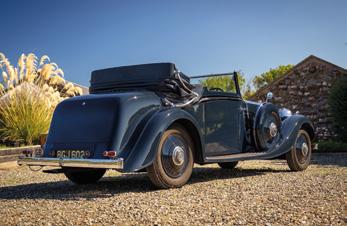
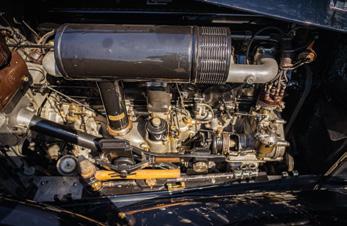


Awarded The Peter Blond Trophy at the Rolls-Royce Enthusiasts’ Club’s Annual Rally a few months later, the 2005 running of the same event saw the H.J. Mulliner-bodied masterpiece claim a Class Prize for Elegance and judged the second most elegant attendee. Entrusted by the late Mr Riding to J & M Bentley and Partners for some £7,352 worth of fettling during 2003, a new tonneau cover and headlining were fitted with attention also being paid to the carpets, leather upholstery, paintwork, cooling system and general mechanics etc. Repainted in 2018 at a cost of £12,730, more recent work has seen the Sedanca Coupe benefit from a new condenser / spark plugs, replacement oil strainer gasket and lubrication service etc.
Accompanying paperwork includes the aforementioned RREC copy build cards plus an original specification book and handbook; pictures from different times; documentation and pictures relating to Bert Ambrose’s ownership; a very large quantity of invoices from various stages of the Phantom’s life; a good number of previous MOTs dating back to 1970; technical literature; RF60 ‘Buff’ logbook and copies of previous logbooks; and a current V5C document. The Rolls-Royce Phantom II Continental had some claim to being the very best car money could buy when new. This example, with its beautifully proportioned H.J. Mulliner coachwork, and boasting matching chassis and engine numbers, is among the most stylish we have encountered and surely worthy of a place in another world class collection. A fabulous opportunity.



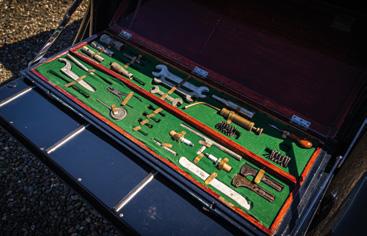

Rolls-Royce introduced the 20/25 in 1929 as a successor to the outgoing 20. Though the newcomer was primarily aimed at owner drivers, many examples were nevertheless sold to customers with chauffeurs. Power came from an enlarged version of the straight-six unit used in the 20. Now 3,699cc, it made for swifter acceleration and a higher top speed of up to 75mph. Bodywork for the 20/25, was to the taste of each individual customer, and Freestone & Webb, Gurney Nutting, Park Ward, Thrupp & Maberly, Mulliner, and Hooper were among the many coachbuilders selected to clothe these fine motorcars. Nearly 4,000 20/25 chassis were ultimately produced, making it the company’s best-selling model between the wars. Today’s Rolls-Royces are undoubtedly technological wonders in their own way, and the company, though no longer British owned, does at least conduct its manufacturing on English soil.


Chassis number GBT80 was initially destined for bodying by Mann Egerton with six-light Saloon coachwork designated, however, in March 1932, the Norwich coachbuilders deferred delivery, with the chassis subsequently delivered to Carlton Carriage Company of London in May 1932. Provided with the attractive Close-Coupled Drophead Coupe coachwork the 20/25 presents in today, the 20/25 was supplied new through Garner & Lees of Conduit Street, London to the first owner, W. A. Hunt Esq of Sloane Street, London, SW1 and registered ‘GY 2058’. Post-war GBT80 was exported to San Francisco, thought to be sometime during the 1950s, passing through several custodians, with it known that American F1 and race car driver Phil Hill, Don Williams (formerly of Automotive Classics), and a Bill Schlenker owned the car stateside.
A body-off restoration was commissioned by Bill Schlenker, and with the restoration reaching completion in 1975, GBT80 quickly became an award winning example, achieving third place in the 1975 U.S.A National RROC Rally for pre-war 20/25s. Acquired in 1979 by a Charles ‘Chuck’ LaRocco Esq, the Rolls-Royce is thought to have been annually displayed at events on the West Coast, winning numerous awards and being maintained by Hill & Vaughn of Santa Monica. An unfortunate incident with a wet driveway resulted in a further restoration in 1980, with the engine also overhauled by specialists in San Jacinto (California) and invoices on file for the restoration accumulating to an approximate $65,000 dollars between 1979 and 1986.
Again achieving award-winning status on multiple occasions, the 20/25 was thereafter acquired by Rolls-Royce and Bentley collector and aficionado Stanley Barraclough in 1989, who had formed and subsequently sold his Yorkshire Biscuits firm. Shipping GBT80 to the Isle of Man to join his illustrious collection of ‘Best of Breed’ Rolls-Royce and Bentleys, Barraclough was tragically killed at the age of 65 as a pedestrian in a road traffic accident in 1995, with his collection auctioned by Sotheby’s at their 1996 RREC sale – where GBT 80 was procured by Robert Furniss Riding. Now offered at No Reserve from the late Robert Riding’s Estate, the vast majority of which has been left to charity with the RNLI as the largest beneficiary.
Under Robert’s ownership, the Carlton 20/25 has been subject to much maintenance and improvement work including overhauled front wheel hubs, relined brake shoes, repainting, rear brake overhaul, renewed starter equipment and servicing. Boasting matching chassis and engine numbers, GBT80 is accompanied by a large history file that includes a photograph album of restoration work; a vast quantity of invoices for work completed in America; a collection of invoices relating to the current ownership; RREC chassis card records; numerous pictures throughout the car’s life; copy of the Sotheby’s auction catalogue; Isle of Man tax discs; and the registration document for the Island. This decidedly attractive Rolls-Royce’s return to market for the first time in twenty-six years is surely an opportunity not to be missed.


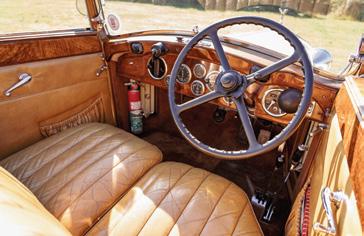

Unveiled in Autumn 1955 some six months after its Bentley S1 Standard Steel Saloon sibling, the Continental version was only available to coach-built special order. Featuring a higher compression ratio and taller back axle ratio, the newcomer was found capable of over 120mph. Underpinned by the same cruciform-braced box-section chassis as the ‘basic’ S1 complete with independent front suspension, a well-located ‘live’ rear axle and servo-assisted four-wheel drum brakes, most of the coachbuilders that clothed it favoured aluminium over steel. Lighter and nimbler than the standard factory offering, Continentals were typically some fifty percent more expensive too. Long considered among the best engines Bentley ever made, the S1’s 4.9 litre straight-six was famed for its blend of torque, refinement and durability and was thus well-suited to the standard fit four-speed automatic transmission. Among the era’s fastest and most exclusive four-seaters, the last of 431 S1 Continentals was completed in 1959.
Mentored by A.F. McNeil at J. Gurney Nutting & Co Ltd during the mid-1930s and subsequently promoted to Chief Designer there, John Polwhele Blatchley joined Rolls-Royce during World War Two. A stylistic influence on every generation of Bentley from the MKVI through to the T-Series, he took control of in-house coachbuilder Park Ward’s designs from 1952 onwards and was later credited with penning the Rolls-Royce Corniche. Decidedly elegant but with various a la mode twists such as its subtly integrated vestigial tail finds, Park Ward’s Design Number 701 for the Bentley S1 Continental chassis was typical of Blatchley’s creative ethos. Evolving through issues one and two, later versions of the sleek, two-door Fixed Head utilised the same taillights as the Standard Steel Saloon integrating them into the base of the tailfins. Park Ward bodied a total of sixty-nine Bentley S1 Continental chassis to its Design Number 701 (with forty-five being to right-hand drive specification).
Originally finished in Shell Grey with Red leather upholstery – the same combination it sports today – chassis BC36BG was supplied new via K.D.M. & Cherrington of London W1 to Mrs Dermot Daly of Little Compton Manor in the Cotswolds on 28th September 1956. Mrs Daly who had been widowed when her previous husband Captain Singer of the Singer Sewing Machine family died during WW2 kept the Bentley for ten years. Thereafter it is known to have passed through the hands of A.D. Allen Esq of Cirencester and Broughtons of Cheltenham (whose kickplate still adorns the driver’s door aperture) before migrating to America. Accompanying invoices show that the S1 Continental was treated to an extensive mechanical and cosmetic restoration by Euro Motors of Washington DC (a factory Rolls-Royce Bentley agent at the time). The work totalled over $50,000 and was completed in 1990. Repatriated three years later and UK road registered as ‘XYJ 405’, the two-door Fixed Head was purchased by its previous keeper from Porters of Kensington. Obviously in rude mechanical health, the Bentley finished second in class on the 1998 Louis Vuitton Rally of China. Fettled by marque specialist P.J. Fischer Classic Automobile (their sticker is still visible in the rear windscreen), chassis BC36BG joined the late Robert Furniss Riding’s collection via a Christie’s auction in March 2001.
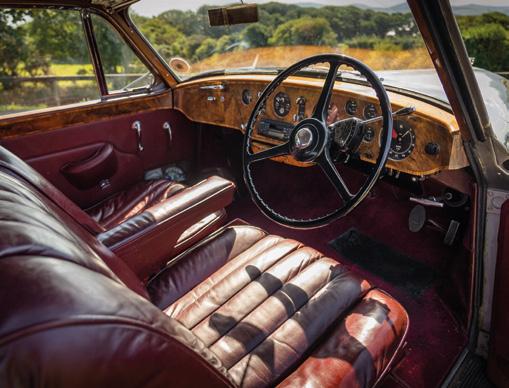
Entrusted to English Automotive Services later that same year, the Bentley had attention paid to its bodywork, paintwork, interior and exhaust plus general servicing at a cost of £13,022. The braking system and suspension dampers were refreshed / improved during 2015-2016 with new tyres being fitted too (the associated bills totalling £9,375). Uprated with power steering using factory reconditioned parts by Frank Dale & Stepsons in 2019, the renowned marque specialists were also responsible for installing electronic ignition and a Kenlowe fan; overhauling the differential and renewing the rear wheel bearings / brake master cylinders / fuel pumps and spark plugs etc (all of which amounted to £34,000).
Accompanied by a large documentation file which includes (but is not limited to) some pictures from the S1’s life; a very large quantity of invoices relating to work and servicing completed; copies of factory records; an original handbook; Louis Vuitton Rally literature; the Rolls-Royce Enthusiasts Club chassis cards; a good number of Isle of Man tax discs; copies of previous UK logbooks and the Isle of Man registration document. A great opportunity to acquire an iconic post-war performance Bentley at no reserve.

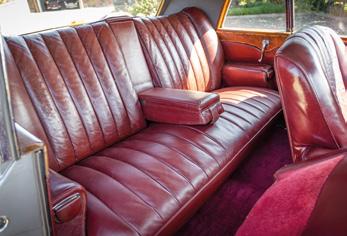


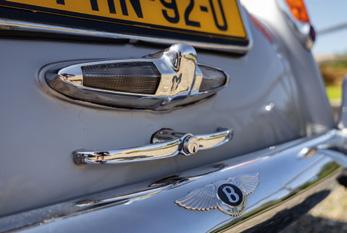


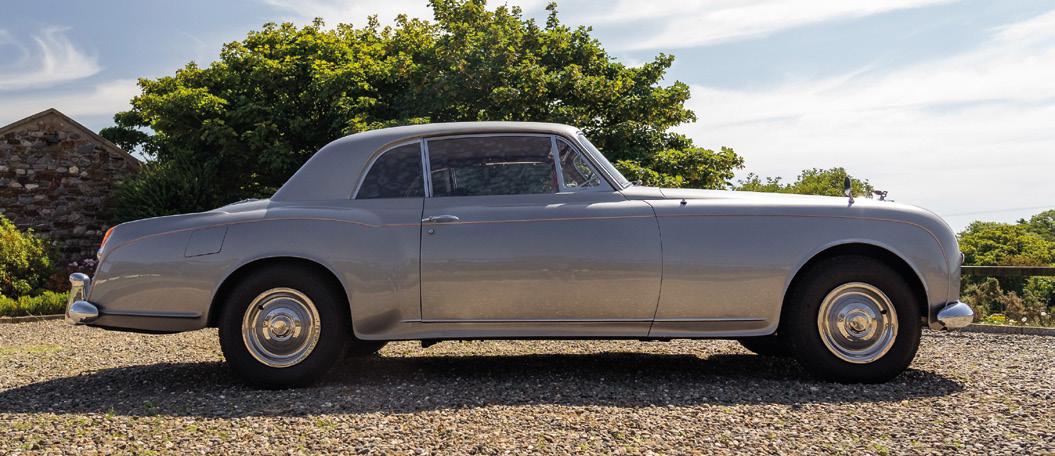


£14,000*
The 500 Giardiniera, an estate version of the iconic Fiat 500 was the longestrunning model of the Italian ‘people’s car’. Production began in 1960 until 1966 as a Fiat badged model, however, from 1968, following the move of production to the Desio plant, the Giardiniera (aka the 500K in some markets) was built and badged by subsidiary Autobianchi up until 1977. Other 500 models were updated in 1967 whereas the Giardiniera retained the iconic features such as the ‘suicide doors’ into the 1970s. It possesses the classic features with space, to create a flat loading space, the engine was laid under the floor of the boot. The roof on this model also stretches all the way to the rear, not stopping above the driver and front passenger as it does in other models of the same period. A total of 327,000 Giardinieras were produced, and from 1968 sold only as Autobianchi Giardiniera. It was never officially imported into the UK.
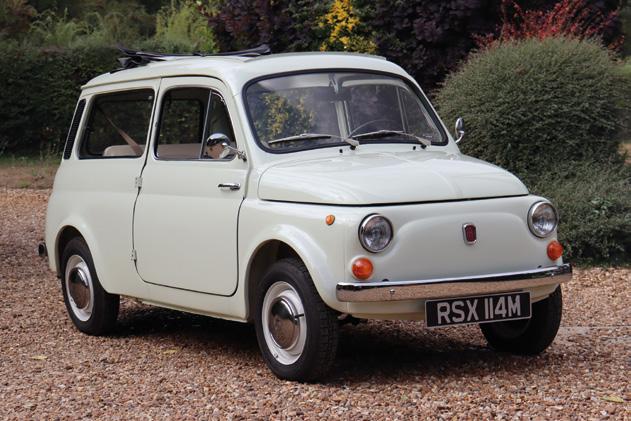
‘RSX 114M’ is a 1974 Italian sourced vehicle that has been the subject of an extensive restoration by Deal of Kelvedon from 2015 to 2018 and finished in Avorio Chiaro. With a credible 77,139km displaying, there has been a recent engine overhaul in current ownership. The vendor describes the car as ‘Excellent’ overall. Having been located in Sicily by a UK owner with Italian heritage it was shipped to the UK where it was entrusted to Deal of Kelvedon for an extensive restoration. The intention was to use the vehicle in a florist business as a promotional vehicle. After some years and a documented expenditure of nearly £30,000, the owner’s marriage failed and the Giardiniera had to be sold. It was not entirely finished at this stage as the money and time had run out, so when acquired by the current owner there was still work to do.
The vendor advises us that numerous items that were required were sourced and fitted to complete and that close inspection would reveal many new panels, no rust and no filler. The vendor has bestowed the car with a new screen, rear opening side windows, quarter light frames and channels, door and window handles, an engine overhaul and NOS carb, new fuel pump, new thermostatic engine warm-up device, hazard flashers, new coil, points, plugs and an original style tool kit obtained (tool box correctly labelled Autobianchi). The interior trim is new Fawn vinyl and the floor feature correct rubber matting. New tyres were fitted all round. Offered with a collection of invoices for c.£30,000 and the V5C.



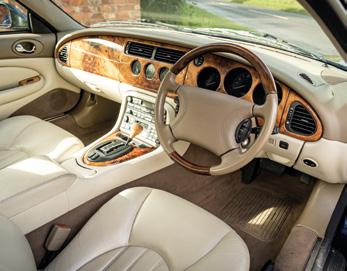
One owner and
Estimate: £11,000 - £13,000*
new
Reg
Like the E-Type before it, the XK8 made its debut at the Geneva Salon and was immediately available in either coupe or convertible guise. It also had the distinction of being the first Jaguar to be powered by an eight-cylinder engine. This then, was a ‘cat’ with strong DNA but also its own distinctive personality.
At the time of the newcomer’s unveiling, Jaguar Cars was owned by Ford, as was Aston Martin, and it made sound economic sense for the XK8 and similarly targeted DB7 to share the same platform; which itself was derived from that of the outgoing XJS. The biggest of many differences between new and old, was the adoption of Jaguar’s second-generation independent rear suspension system, previously found on the XJ40 Saloon. Prior to 2003, the power came from either a normally aspirated (XK8) or supercharged (XKR) 4.0-litre version of the company’s DOHC V8 AJ26 engine.
First registered in September 1999, ‘V467 KOH’ is finished in eyecatching Sapphire Blue Metallic and rides on the factory optional 18” alloy wheels. The interior is a perfect combination of comfort and practicality, with space for four occupants surrounded by supple two-tone leather and wood veneers. Supplied new by Paramount Jaguar of Stourport, this one owner example has only covered just 29,700 miles from new (atoc) and is offered with the original book pack, handbooks and replacement service book with 15 stamped entries. Whilst the V5C document shows one former keeper, this was simply an address change for the sole owner – Mr. J. A Simpson in December 2005. The car is to be sold with a valid MOT certificate for twelve months and offers a rare opportunity to become just the car’s second custodian in twenty-three years. With values rising for low-mileage, modern classics, ‘V467 KOH’ could prove to be a very shrewd investment for the purchaser.
Introduced in May of 1962, the monocoque MG B was a welcome progression from the body-onframe T-Series and MG A models that preceded it. The more modern construction resulted in weight savings, reduced manufacturing costs, and notably tauter handling. Initially, the B was only available in Roadster form – the Pininfarina-penned hatchback GT derivative, with 2+2 seating, not being offered until October 1965. At launch, the model was powered by a three-bearing version of the 1798cc B-Series engine that produced 95bhp at 5,400rpm. However, this unit was replaced by a fivebearing unit two years into production. The MkII model of 1967 brought an updated manual gearbox with revised ratios and synchromesh. By the time GT production ceased in 1980, a total of 125,282 are said to have been produced.
Coming from long term previous ownership, this B GT is finished in striking Red paintwork. A 1968 example of the MG B, it presents itself in the iconic form, with chrome wire wheels, knock-off hubs, and chrome at every angle, from a time before US Federal laws took charge of the designer’s role! Complementing the look is a Black interior with Red piping to the seats and a 3 spoke sports steering wheel. In 2014 this B GT was fitted with new front brake calipers. ‘UDM 609G’ is offered with a collection of old MOT certificates and a few invoices.

Estimate: £12,000 - £14,000*
Reg No: OXS 713 Chassis No: XGCAH113508 MOT: Exempt

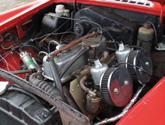
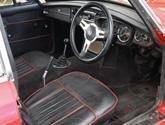
Manufactured in 1941, the Special Deluxe offered was supplied new to South Africa, being assembled by General Motors South Africa Ltd. In Port Elizabeth. Fitted with 3.5-litre straight-six engine with a three-speed manual column change transmission, the Chevrolet is finished in the striking colour combination of two-tone Blue paintwork, with a complementary Blue and Grey interior upholstery. The mileage is recorded at c.95,200 miles, with the Chevrolet employed in military service with the SAAF (South African Air Force), with SAAF/SALM 8S stamped into the chassis plate on both edges and has been confirmed by the Air Force Museum in South Africa. Unfortunately, they also confirmed that records of details of individual vehicles service are not traceable.
‘OXS 713’ has window winders that are embossed with a springbok jumping in a blue roundel, the insignia reputedly used by the SAAF unofficially from 1947. Discovered by the vendor in Paarl in late 2020, the Chevrolet was imported into the United Kingdom in March 2021. Registered in the United Kingdom, the Chevrolet then benefitted from renewed grille surround components, a full carburettor overhaul, and new plugs, coil, points, and condenser. The brakes and drivetrain were checked and serviced, with intake manifold seals and fuel pump renewed. Offered with a current V5C and presenting with nice patination, this is an interesting opportunity to purchase a piece of Americana design with interesting South African military history.
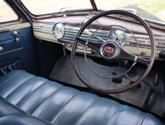

In 1980, by now in Rolls-Royce ownership, the T Series Bentley, along with the R-R Silver Shadow sister model, was replaced by the Mulsanne and R-R equivalent. The bodyshell was longer, wider and lower and gave owners 30 per cent greater glass area. Initially, engines for both Bentley and R-R were normally aspirated 6,750cc V8s. A turbocharger was added for the more powerful Mulsanne Turbo in 1982 (with 200 bhp boosted to 300, 135 mph top speed and 0-60 mph time down to 7.6 sec.) and an improved Turbo R followed in 1985, by when there was also a cheaper (£49,497) Bentley Eight with non-turbo motor, mesh grille and younger, more minimalist interior.

With just c.52,500 miles from new and current ownership since 1994, and just 3 formers private keepers prior to that, this Bentley Eight is finished in Vermillion Red complemented by a Cream leather with Red piping interior with matching sumptuous Red carpet. In the custodianship of the current owner since 1994, he tells us the Eight “has very rarely been out in the rain, is always garaged and has just been fitted with a new battery. The service book is stamped up to 2005 at 50,707 miles. The Eight is offered with the original handbook and aforementioned service book, the original tool kit and a collection of old tax discs.




Estimate: £18,000 - £22,000*
Reg No: BGO 448B Chassis No: 241130808 MOT: Exempt

Acquired as a project in 2017 and subsequently subject to an extensively documented restoration over a 2-year period, finishing in May of 2019, this Series IIA is offered for sale having covered only 316 miles since completion. Presented in the ever-desirable Bronze Green with contrasting Black interior, ‘BGO 448B’ was purchased by its current owner approximately one year after it was completed, directly from his uncle, who restored the car. Since its purchase, the car has been dry stored, being both used on occasion and exhibited at shows.
Now offered for sale once more due to lack of use, included with the vehicle is not only an impressive physical history file, but a digital one too, with the latter containing 29 folders photographically documenting the restoration from start to finish, as well as guides, wiring diagrams, further history and a breakdown of costs, with invoices for parts totalling over £14,000. Included with the physical history file is also an impressive collection of previous receipts as mentioned above, some previous V5C documents, the DVLA registration documents and the current V5C which displays only 2 former keepers. The vendor rates the condition of the bodywork, engine, electrical equipment, paintwork, transmission and interior trim all as ‘Excellent’.
Subject to an extensive, body-off restoration
Reg
Chassis
An evolution of the Louis Coatalen-designed Talbot 8/18, the Georges Roeschrevised 10/23 was introduced in 1923. Powered by an enlarged 1074cc version of its predecessor’s innovative four-cylinder engine (complete with a three-bearing pressure-fed crankshaft, water pump, coil ignition and overhead valves) allied to a three-speed manual transmission, the newcomer also gained a differential and effective four-shoe drum brakes for its rear axle. Bodied in-house by Darracq, the 10/23 sat on a quarter-elliptic leaf-sprung chassis with a 9ft of 9ft 4in wheelbase and could be had with 2-seater, 4-seater, coupe, and saloon coachwork. Refined through L, T, and Z configurations, the model’s 2,800 sales saved the London-based firm from bankruptcy. Of the 5,460 Talbot 8/18, 10/23 and 12/30 light cars made between 1922-1926, the Talbot Owners’ Club estimates that just 50 have survived.

Understood to have been supplied new to Australia in 1925, being delivered on the 28th of March 1925 to a Mr. Adrian Eldhout Esq of Victoria. Fitted with the colonial engine with a radiator fan, the 10/23 was fitted with the Tourer body style upon arrival in Australia. The accompanying Government of Victoria Owners Certificate document commences in 1933 with the registered owner showing as Mr. Henry Cordner Esq of Murrumbeena. Passing through several keepers around the Melbourne area, the longest being a Miss Edna M. Mansfield for some seven years and subsequently a Mr. Gordon T. Douglas Esq from 1943 until 1952. The Talbot’s history is from then unknown between 1952 and 1989, until being repatriated to the United Kingdom in December 1989.

Having just five owners since arriving back in the United Kingdom, the Talbot entered into previous ownership in 2005 who retained ‘SV 9591’ until 2021. Subject to a body-off restoration in 2009, and is still worthy of close inspection now, the 10/23 has covered less than 100 miles since completion. Recently provided with a new set of tyres and a fresh battery in preparation for sale, the vendor rates the car as ‘excellent’ throughout. Finished in the appealing colour combination of Blue and Black, which is thought to be the original colour scheme from the early Australian owner’s document, a complementary Black leather interior upholstery finishes the Talbot. Offered with a history file which details the known ownership; Production and Sales Record from ‘The Invincible Talbot’; the aforementioned Australian Owners Certificate; an original Instruction book; sales literature; invoices related to the restoration; a few previous MOT certificates; and a current V5C document.


Built in late 1989, this 6.0-litre V12 XJR-S was initially a demonstrator for Stratstone of Mayfair. It was subsequently sold to Maxwell Fleet Services on 13th October 1989 (registered RAM 246 to Mr Robert Maxwell). It was then sold to Polly Peck International on 3rd August 1990. Next, it passed to the 3rd owner who kept it for some 8 months before being bought by the current owner in July 1993.
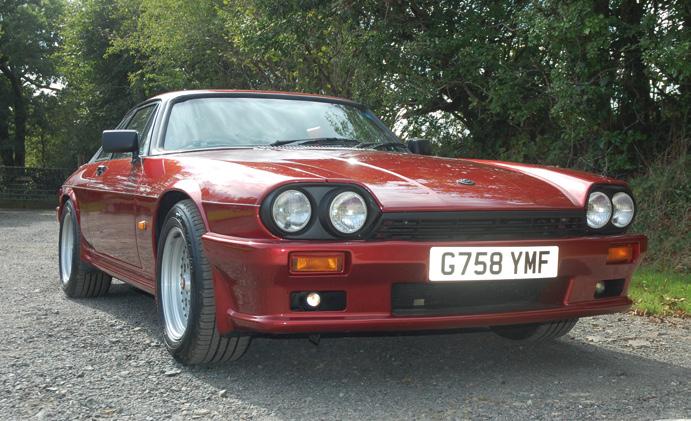
In early 2000 we are advised the car was converted to Hyper specification utilising the Mk2 conversion kit which included suspension, tubular manifolds and exhaust system. At the same, time it was repainted in Jaguar Flamingo Red. Around 2008 the car returned to the Hyper workshops for a freshen up. Aldridge Trimming carried out a full retrim in grey and a Hyper updated dash top was fitted along with later fully electric front seats and a later rear window shelf. In 2010 it was put into dry storage before emerging in 2019 for recommissioning. Work included a thorough overhaul of the front and rear suspension with new parts fitted – a breakdown is included in the history file. In 2021 the bodywork was tidied up and four new tyres fitted along with an aerial mast and bonnet struts. Details of this work are again evidenced in the accompanying paperwork.
Unfortunately, Paul Hands of Hyper cannot produce any paperwork as we are informed the computer on which the conversion work was stored has lost the data. Furthermore, a number of invoices were unfortunately mislaid in a house move by the current owner. However, some history and assorted MOTs along with the books from Jaguar are included. Although the indicated mileage is some 92,000, the current mileage is actually some 110,000 as the speedo was changed for a second-hand unit in 2005. This exciting TWR XJR-S is offered with a current MOT to September 2023.

Estimate: £28,000


£32,000*
Supplied new in March 1962 to a Henry Ford Owen Esq of Grimsthorpe, the accompanying original ‘Buff’ logbook documents seven subsequent owners (all from the North of England). By 1979, ‘728 BPY’ is understood to have covered some 70,000 miles and was still in regular use, later selling to a Mr. Phillip Stephens of London who used the car sparingly and carried out some minor mechanical works. In the early 1990s, the roadster passed into the hands of Karl Zachau Esq. who embarked on a major restoration, with much of the work carried out by A&B Bodyworks of Lincoln, all of which is documented in the sizeable history file. Believed to have covered a mere 10,000 miles in the last 40 years, the car was purchased by our vendor in 2019 – a well-known figure in ‘Dart’ circles who simply couldn’t resist buying the car due to its “outstanding” chassis and potential. He set about improving the roadster which involved the removal of the engine, grinding of the crankshaft, and fitment of new shell bearings. Before reinstallation, the engine bay was fully detailed and new engine mounts were installed. Other works included a rebuild of the dynamo, a new water pump and ancillary pipes, a new petrol pump, and a new ignition coil and set of HT leads. Said to “drive superbly”, the car benefits from a rack and pinion steering upgrade and was aesthetically improved with a host of new chrome-plated components.
Supplied with a UK V5C registration document, original ‘Buff’ logbook, a large file of receipts, and an unused full tonneau cover. Our vendor rates the bodywork, engine, electrical equipment and transmission as “Very Good’, whilst he rates the paintwork and interior trim as “Good to Very Good”. Just 2,645 Darts were hand-built in Coventry during a five year production run, making them exclusive ‘in-period’ and good examples like this relatively rare in the collector market today.
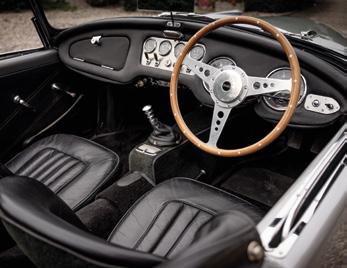
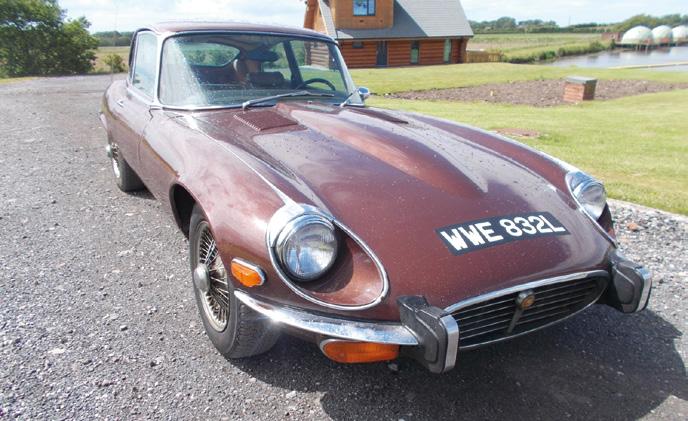

Estimate: £26,000 - £30,000*
Reg No: WWE 832L MOT: Exempt
Chassis No: 1S75166BW

The Jaguar E-Type wowed the world upon its launch in 1961. Here was a sportscar that offered performance to beat Ferrari and Aston Martin at just half the price, wrapped up in a beautiful muscular body that was unlike any other contemporary sportscar. This combination of style, speed and value endeared it to the world’s elite and the E-Type was one of the coolest cars to be seen in throughout the 60s and 70s. The range expanded with a 2+2 derivative joining the Coupe and Roadster and evolved through steady stages until the final Series 3 V12s bowed out in 1975. Weighing just a few pounds more than the smaller 4.2L engine it replaced, the alloy-blocked 5.3L V12 produced 272 BHP with vastly improved torque at 349 lb/ft. Even though the E-Type has now celebrated its 60th birthday it is still one of the most beautiful cars ever produced.
Despatched to Jaguar Cars, New York, NY in 1973, this is a Jaguar E Type 2+2 Series 3; a V12 Coupe iteration of the marque with an automatic gearbox. It is left-hand drive, having been repatriated to the UK and originally wore a Sable exterior paint finish. Described as an extremely solid and complete car that starts, runs and drives. Back in the United States, the car had just 1 former owner, a Dr Lawrence Cohen and c.14,800 miles displaying on the odometer. A matching numbers example of the iconic Jaguar E-Type, retaining engine number ‘7S 12595 LA’, it is UK registered and still retains its original Cinnamon leather interior. ‘WWE 832L’ is offered with its bookpack, containing the original handbook and service passport with stamps and the V5C. In addition, and those documents are accompanied by the car’s Jaguar Heritage Certificate.

For many, the definitive Jaguar sports saloon, the MkII was introduced in October 1959. A peerless blend of elegance and muscularity, its sleek lines clothed an evolution of the Coventry marque’s first monocoque design. Powered by derivatives of the same XK DOHC straight-six engine that had swept Jaguar to five Le Man’s victories, the MkII was quick to dominate contemporary saloon car racing. Equipped with coil-andwishbone independent front suspension, a leaf-sprung Salisbury rear axle and servo-assisted four-wheel disc brakes, the rangetopping 3.8 boasted nearly seven times the horsepower of a Mini 850 and a 126mph top speed! Blessed with one of the alltime great automotive interiors, its stylish instrumentation, rich wood veneers and sumptuous leather upholstery all conspired to cosset and cocoon occupants.

KUD 600D is a 3.8 Litre Jaguar MkII Saloon that was first registered on the 1st of November 1966. Finished in a Metallic Dark Blue with a Black leather interior, this car is fitted with the desirable manual gearbox and overdrive. Having been owned by the vendor’s family since 1995, this MkII has been meticulously looked after by the current and previous custodians. While under the ownership of a Mr Lazarowicz, the car completed a major overhaul by Southern Classics in July 1993, costing £8,395 and had a stainless steel exhaust fitted at a cost of £732. In 1994 it received a complete respray in Metallic Dark Blue. The current owners have upgraded the car with an XJ6 steering rack pump and power steering, a Kenlowe fan, larger carburettors, a fluted bonnet, upgraded front & rear brakes, and a fuel catalyst conversion. It has a refurbished Black leather interior, a Moto Lita wooden steering wheel, a stainless steel exhaust and knock-off wire wheels. Over the last 12 months, a further £8,500 has been lavished on engine and brake overhauls. It comes with a sheaf of invoices, correspondence, old V5s, MOTs and Tax Discs, a full photographic record of the engine, brake and body overhaul, a tool kit and original workshop & maintenance manuals.
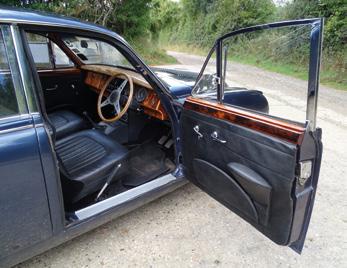
Estimate: £38,000 - £45,000*
Named after one of its former parent company’s fighter aircraft, the Bristol Blenheim was unveiled in September 1993. Priced from £110,000, it may have been a left-field choice when compared to other British handbuilt grand tourers such as the Aston Martin V8 or Bentley Continental R but there were still those who valued its narrow track and unmatched visibility. The staple Chrysler 5.9 litre V8 benefited from the adoption of electronic manifold fuel injection and was allied to a more sophisticated four-speed automatic gearbox. Criticisms as to the Bristol’s overly ornate radiator grille were addressed with the arrival of the Blenheim 2 in January 1998 which also boasted a reduced turning circle, power boost and reputed 150mph top speed. Only in ‘production’ for eighteen months or so, it is estimated that between six and ten Blenheim 2 cars were made with Bristol losing money on each one!

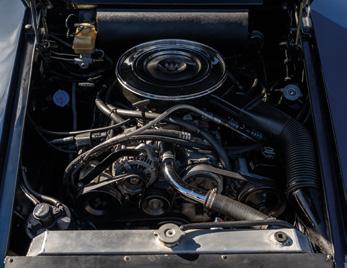
Supplied new to a world-renowned, London-based heart surgeon and serial Bristol owner, ‘S973 GEU’ was specified in Beaufighter Blue with Cream leather upholstery. Costing £118,778 before the addition of extras including a grab handle, uprated stereo system and heated front windscreen, the Blenheim 2 has been factory maintained for most of its life (the first owner’s profession meaning that reliability was paramount). Sadly, the four-seater was caught up in the administration of Bristol Cars such that the associated bills have been mislaid. However, accompanying paperwork does include an invoice detailing its conversion to partial Blenheim 3S specification during late 2001. Totalling £23,329.28, work saw the frontal appearance and interior remodelled accordingly plus a widening of the track and fitment of new alloy wheels / tyres. Passing to the first keeper’s son and then a holding company, ‘S973 GEU’ was in family ownership from new until 2022. Starting readily upon inspection and running well, this Blenheim 2 / 3S has covered a warranted 63,000 miles and remains highly presentable. Offered for sale with V5C Registration Document, copy factory invoices / correspondence and MOT certificate valid until April 2023.
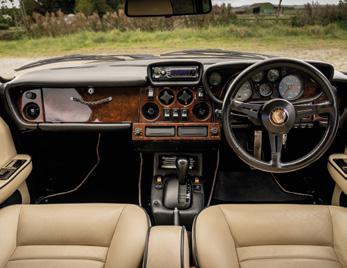



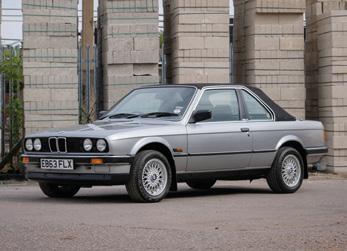
First registered in 1987, this genuine Baur 320i Cabriolet is one of 300 UK cars presented in Silver with contrasting Grey pattern interior and the all-important manual gearbox. This particular example benefits from complementary BBS wheels, although does also include the original bottle top wheels in very good condition. Recently subject to a service by Richard RPM including hydraulic tappet adjustment, the car now displays 100,205 miles on the odometer.
Included with the vehicle is 2 sets of keys with spare dealer keyring, the original bookpack including warranty terms, alarm guarantee and operating instructions, Baur cabriolet booklet, owner’s handbook and BMW Service booklet. Also included is an impressive collection of invoices and receipts from both BMW main dealers and specialists from 1996 to present, MOTs dating back to 1993 at 27,671 miles and the V5C document which displays 7 former keepers. The vendor rates the condition of the bodywork, engine, electrical equipment, paintwork, transmission and interior trim all as ‘Very Good’.


The Bentley S1 was unveiled in April 1955. A very different car from its predecessors, it was longer and wider and based on a much stiffer chassis. Though the traditional body-on-chassis construction facilitated the manufacture of special-bodied versions, most were delivered with the standard offering produced by Pressed Steel Ltd, featuring alloy doors, bonnet and boot lid. Powered by the final iteration of the company’s venerable 4.9-litre straight six engine featuring revised cylinder-head porting, power was quoted at 178bhp. As standard, the unit drove through a four-speed automatic gearbox with steering column control. Suspension was independent at the front by wishbones and coil springs and employed a leaf-spring mounted live axle at the rear. Braking was by drums all round. A total of 3,107 examples were produced between 1955 and 1959.
Repatriated to the UK within the last year, from New York State, this is an original right-hand drive Bentley S1. From the dealer plates on the car, it is likely this S1 was supplied new by Rolls-Royce/ Bentley dealer H.R. Owen Ltd in the UK; the car then made its way to Canada before crossing into New York State. Finished in White, the colour scheme is complemented by an interior with upholstery in Red leather and matching Red door cards, trim and carpets. This elegant and well-travelled Bentley S1 is offered with a V5C document and has recently had attention paid to the braking system.
Offered here is a lovely early example of the technically brilliant, fifth-generation SL, aptly finished in Brilliant Silver. In the attractive cabin, two-tone grey leather and trim sits alongside wood-effect inserts, adding to the opulence you’d expect. Powered by Mercedes’ well-proven M113 5.0-litre V8 the driver has 302bhp and 460Nm available to them, rolling on smart 17” 5-spoke alloys, refurbished in 2020. The ‘Vario Roof’ on these SLs performs its balletic manoeuvres in approximately 14 seconds. Recently, the car has been the subject of a mechanical refresh by a Mercedes-Benz main dealer at a cost of around £23,000. The work included suspension components, all electrics, including the roof mechanism, a tidy-up paint-wise and refreshed alloy wheels along with everything else that ‘needed doing’ at the time. An attractive example of an SL500, there is even the cherished number, ‘E2 LRJ’, included as part of the sale.
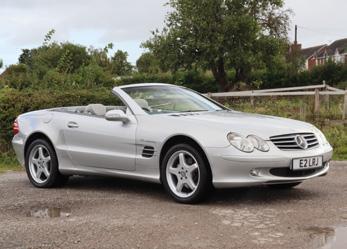
A file of paperwork consists of MOT records and an extensive collection of invoices from main dealers, Mercedes – Benz of Newbury, which included servicing of the all important electrohydraulic suspension system amongst other extensive work to bring the car up to the standard expected of such a car. ‘E2 LRJ’s’ complete bookpack includes the service booklet with 10 entries. Having covered 109,500 miles from new the Benz is offered with a fresh MOT certificate.

Less than 2 miles since restoration
Estimate: £14,000 - £16,000*
Reg No: BCA 887W Chassis No: XLV10010758792 MOT: Exempt

First registered in 1981, ‘BCA 887W’, a rare 95L pickup, spent 2 years in its first ownership before being purchased by a farmer from Chester. The car spent most of its life working as a farm vehicle until it was eventually laid up in a barn in 1997 having covered some 35,630 miles.
Following its purchase, the owner undertook an extensive restoration spanning over a 4 year period. The owner insisted on using nothing but new-old stock and M-machine parts, which required, at times a 14 month wait for panels to be manufactured. The car was repainted in its original shade of Nautilis Blue, and the bed received Gravitax treatment in the bed for protection. In dry storage since completion of the restoration in 2015, ‘BCA 887W’ has driven less than 2 miles and has been transported to just 1 show, with the odometer currently displaying an unwarranted but believed genuine 35,633 miles. Due to this lack of use, the vendor has decided that the car must find a new home. The vehicle comes accompanied with a small collection of receipts and invoices for parts used in the restoration as well as the V5C document which displays 2 former keepers.

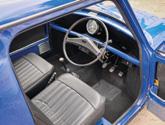
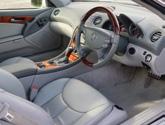
The 190SL was introduced in 1955 – the year Mercedes swept all before it on the Mille Miglia with the 300SLR. Indeed, the graceful, new two-door, convertible grand tourer was sold alongside the roadgoing version of the SLR – the 300SL – whose styling it strongly resembled. In fact, the underpinnings of the two cars were quite different and, while the 300SL had a purpose-built tubular spaceframe (W198), its smaller sibling was built on a shortened version of the ‘Ponton’ saloon (W121) platform, which was of monocoque construction. The 190SL also boasted an all-new engine – an over-square SOHC straight-four unit of 1897cc that produced some 120bhp, which was sufficient to propel the car to a maximum speed of 112mph. The engine was coupled to a manual four-speed gearbox. The suspension comprised double wishbones and coil springs at the front and a coil-sprung swing axle at the rear. Steering was by recirculating ball and braking by power-assisted drums all around.
Built to the highest standards and among the quickest comparable cars of the time, the 190SL featured a well-appointed cockpit, notable comfort for its occupants and relatively generous luggage space.
Under the circumstances, even the steep asking price of £2,693 did nothing to deter purchasers. Options included a third seat placed transversely behind the front ones which was big enough to carry an adult. The 190SL continued in production until 1963 when both it and the 300SL were replaced by the 230SL (W113), by which time 25,881 190SLs had been produced.

Completed during the 1958 model year (one of 2,722 examples manufactured that year), this particular example, chassis 1210408501057, was manufactured in left-hand drive configuration and is thought to have resided in Canada from shortly after its production. Finished in Black (DB40) with Red leather interior trim, and a Beige hood, the 190 SL is next known to have been purchased by a gentleman based in Edmonton, Alberta, Canada in 1986 and was retained in his possession until the late-1980s. Relocated to the United Kingdom in c.1990 and registered ’BSK 768’, the previous family acquired chassis number 1210408501057 in 1990, remaining in the family until 2022. Used and enjoyed for three years, and displayed as some classic car events (with event stickers present in the windscreen), the 190 SL was taken off the road in October 1993 and laid up in the garage in preparation for a full restoration which sadly never got chance to occur. Purchased by the vendor for a restoration which will unfortunately not materialise, the 190 SL is now offered for sale having been off the road for almost thirty years. The Mercedes-Benz’s engine turns freely, and the car has some pleasing original features, such as the original dashboard clock, and all present chassis plates and body tags. With a recorded mileage of just over 92,000 miles, the Mercedes is accompanied by a history file, which contains correspondence from MercedesBenz, paperwork verifying the provenance of the car; paperwork relating to the 190 SLs time in Canada; Canadian and Scottish purchase receipts; an original owner’s manual; sundry paperwork; a current V5C document and a repair and tune-up guide. Offered with many receipts associated with the purchase of repair panels, this is a scarce and exciting opportunity to acquire a 190SL restoration project, with recent long-term family ownership.

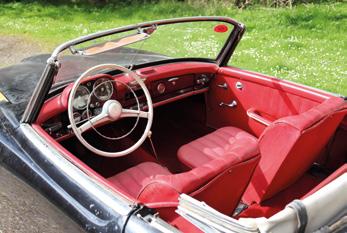
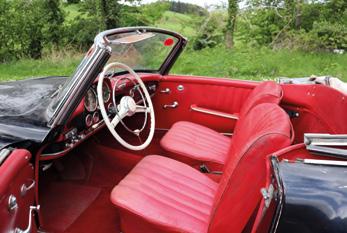
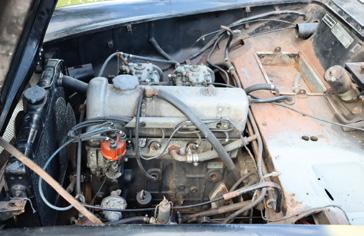

Based on the flagship S-class W111 ‘fintail’ Saloon, with its signature upright headlights and imposing traditional MercedesBenz grille, the Coupe comprised a light and airy pillarless glasshouse over a distinctive two-door body. The 220 Coupe was very well appointed inside, featuring Mercedes textured leather and wood trimmings. The model’s 2195cc, SOHC engine employed mechanical fuel injection of the same type as the ‘Pagoda’ SLs - its 120bhp being sufficient to propel the car at up to 106mph.

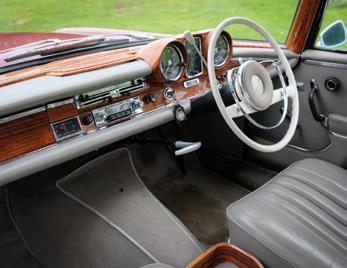
Presented in a very attractive combination of Maroon with contrasting Ivory leather interior, ‘DTV 301B’ was subject to a comprehensive restoration between 2009-2011, which included an overhaul of the body, engine and running gear before being resprayed in its original colour. Fitted with a period Blaupunkt radio with iPod connectivity, an electric aerial, front and rear seatbelts and tastefully uprated 14”steel wheels, with chrome and body colour hubcaps, this presents a wonderful opportunity for a driveable and comfortable classic with exquisite style.

In current ownership since November 2013, this 220 SEB has been dry stored throughout and serviced appropriately.
In December of 2018, the car was subject to a full-service including spark plugs, the suspension greased, a new battery fitted, replacement brake pipes and some minor chassis repairs at a cost of £1,977. In August of 2022, the car was subject to works preparing it for sale, totalling over £400 and an MOT was applied, with it being valid until 17th August 2023. Included with the vehicle is a collection of previous MOTs dating back as far as 1994, a collection of invoices for previous works completed, written details of the restoration work with some supporting images from Bucklow Garage Ltd and the V5C document which displays 5 former keepers.

Estimate: £18,000 - £22,000*
Introduced at the 2005 Frankfurt Motor Show, the secondgeneration Jaguar XK range (codenamed X150) was styled by Ian Callum. Deliberately evoking the E-Type via its oval grille, speeding teardrop glasshouse and muscular haunches, the newcomer featured bonded/riveted aluminium construction, all-round independent suspension, power steering and fourwheel disc brakes. Powered by either a 4.2-litre V8 or 5.0-litre engine, both in supercharged or non-supercharged form, the standard-fit six-speed automatic transmission could either be left to its own devices or made to swap cogs by the steering wheel-mounted paddle shifts. A rival to the Porsche 911 (997) and Mercedes-Benz SL (R230), the Jaguar (X150) XK / XKR remained in production until 2014 by which time a mere 54,000 had been sold (compared to 212,704 Porsche 997s and 169,443 Mercedes-Benz R230s).
Manufactured in 2010 (being UK registered in November that year), this XK Portfolio is finished in Grey with Piano Black leather interior upholstery and is fitted with the 5.0-litre V8 engine. Having covered a mere 25,708 miles from new (at time of consignment), ‘LF60 LFF’ has had just three owners from new, being in current registered ownership since 2016 and with the previous custodianship from 2010. Well-specified from new, the features include 20-inch Kalimnos alloy wheels; active ventilated front seats (heating and cooling); climate control; electronic brake force distribution and stability control; Xenon headlamps; keyless entry; front and rear parking aids; touchscreen entertainment system with Bowers and Wilkins Hi-Fi and heated steering wheel. Accompanied by the stamped book displaying ten stamps, four from main dealer Guy Salmon Jaguar and a further six from specialists, most recently at 25,698 miles in August this year.

with two keys and current V5C document.



Capitalising on the success of the Fox & Nicholl Team Cars at Le Mans, Talbot are understood to have built some 216 examples of the 90. Available with a choice of wheelbase lengths, the model was underpinned by a substantial ladder frame chassis featuring all-round leaf-sprung suspension and four-wheel drum brakes. Developing up to 93bhp, its advanced 2276cc straight-six OHV engine was allied to four-speed manual transmission (though, later versions could be had with a four-speed pre-selector gearbox). Potential buyers could choose from a range of factory bodystyles or employ the services of an independent coachbuilder. Regardless of the coachwork worn, most 90s were capable of the 90mph top speed that their name implied. An understandably popular choice with sporting motorists, the Talbot enjoyed continued competition success as a privateer entry at events such as the Irish GP, Ards TT and Brooklands thanks to the efforts of Bill Esplen (‘GN 5872’) and the Burt brothers (‘GO 1568’) etc.
A genuine AM90 Speed Model, ‘GP 6096’ is understood to be one of just twelve such chassis to be fitted with Close Coupled Drophead Coupe coachwork by Offord and indeed the sole known survivor (although, a very similar car which was built under sub-contract by Carlton still exists). According to its copy factory build record, chassis 30000 was erected on 1st January 1931 and as such is accepted by the Vintage Sports Car Club as being of Vintage manufacture (which in turn allows it to run with other pre-1931 machinery in VSCC events). The AM90 is accompanied by a very large and interesting history file which chronicles the last six decades of its life. Thought to have belonged to Mr D. English during the mid-1950s, other keepers have included Mr Williamson, Mr John Gray, Mr Brian Fidler, Mr Peter Theobald, Mr Peter Sutcliffe, Mr Gillie Andrew, Mr Tim Wadeson, Mr Michael Manning, Mr M. Jones and Mr J. Radgick.
Mr Gray was the Sunbeam Talbot Darracq Register’s secretary and there is a photo on file of him showing none other than Georges Roesch over ‘GP 6096’ (the 90 engine was reputedly Roesch’s favourite among all those he designed for Talbot). Mr Theobald took the Close Coupled Drophead Coupe to Rhodesia in 1968 and thereafter it relocated to South Africa. Mr Sutcliffe used the fourseater for a long distance rally during his brief tenure (1977-1978) and Mr Wadeson finally repatriated the AM90 to the UK in the early 2000s. Substantially improved during Mr M. Jones’s custodianship, chassis 30000 benefited from a thorough engine overhaul (reground crankshaft with shell bearings, Arrow rods, new pistons, new timing gears and new oil pump gears etc) plus the installation of a down draught carburettor, free-flow exhaust and new Dynastart bearings (the unit having been otherwise rejuvenated for a previous keeper) all of which was carried out by marque specialists Arthur Archer and Foppe d’Hane. Further boasting a ‘New Zealand’ cartridge oil filter conversion, solid state voltage regulator, correct complete new ‘wet’ radiator and halogen headlights, the Talbot was entrusted to marque specialist Ian Polson for a back axle refurbishment and new petrol tank. Foppe d’Hane restored the wooden body support frame as necessary before the coachwork was treated to a bare metal respray in Dark Blue. Re-upholstered in contrasting Light Blue, the interior is protected by a Black double duck hood.
A delightful and seemingly very well sorted motorcar, the Talbot has completed numerous STD Register Tours around the UK, Ireland and France etc over the past fifteen years. While, the Drophead Coupe’s most recent long distance outing saw it successfully finish the 26th Rally International du Pays de Fougeres from May 20th-23rd 2022. Indeed, the AM90 Speed Model is only coming to market because the vendor considers that he has too many cars to give them all the usage they deserve. Accompanying paperwork encompasses the aforementioned history file, bills substantiating the work undertaken and an original first edition handbook and spares list. ‘GP 6096’ is summed up as ‘a very rare and usable car with wind-up windows and relaxed cruising ability’.


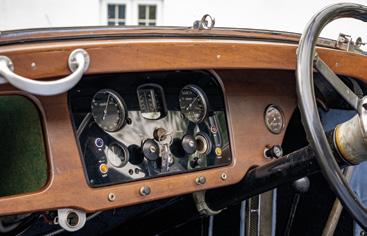

Porsche’s 911 is an automotive phenomenon like no other. Its tail-heavy configuration has been described as a ‘triumph of engineering over design’ and its maker sought to pension it off as much as 40 years ago. Yet it is still with us, still being developed and refined, and still frequently trouncing the opposition on road and track. In 1968, the model’s wheelbase was increased by 57mm, and the rear overhang was reduced by the same amount. The model year 1970 saw the engine capacity was enlarged to 2.2-litres and then subsequently to 2.4-litres in 1971, being offered in three levels of tune, namely: T (130bhp), E (165bhp), and S (190bhp).
Conceived to fit between the 911 T and the 911 S, the E designation stood for Einspritzung, German for “injection,” noting the mechanical fuel injection. The Targa appeared in 1966 with a built-in rollover hoop for fear that convertibles might be banned for safety reasons. The earliest design utilized a removable clear plastic window that could be taken down to create a near-full convertible when the centre roof panel was also removed. Porsche soon substituted a large, fixed wrap-around glass backlight to improve weather sealing.
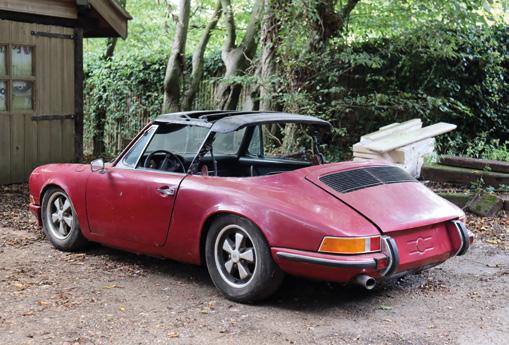
A desirable first year of the production ‘B-Series’ 911 E, the Porsche is understood to have been supplied new to Canada in left-hand drive configuration. One of just 2,270 2.0-litre 911 Es reputedly produced with the 1991cc flat-six air-cooled engine (that utilised mechanical fuel injection) and allied to the five-speed manual transmission, chassis number 119210175 is finished in its original (and believed rare) colour combination of Burgundy Red Metallic paintwork with Black interior upholstery. Reputed to have resided in Canada until c.2018 when the 911 Targa was exported to the United States in ‘barn find’ condition, shortly after being imported into the United Kingdom.
In current ownership since arriving in the United Kingdom, the Porsche has been UK registered ‘UBD 587G’ and has remained in ‘barn find’ condition ever since, awaiting restoration. Showing a recorded mileage of 25,649 kilometres (thought 125,649 kilometres; c.78,000 miles), the 911 is now offered as a very worthy candidate for restoration and is thought to be complete. Offered with paperwork relating to the importation, a copy of a previous registration document from the Province of Ontario, and a current V5C document.





For the 1939 model year, Rover added a two door Coupe version of the ‘10’ (10hp) model, sometimes referred to as a Doctor’s Coupe. Just 250 were built in 1938 (1939 model year) and 525 built in total between 1938 and 1940, before civilian production ended in order to move to production for the ‘war effort’ following the outbreak of WWII.
Believed to be one of only five roadworthy examples of the model known to the Rover Register and 1 of 250 built for the 1939 model year, this is a rare survivor of the marque. With history, that includes usage by a medical officer during WW2, it is finished in a handsome Sage Green over Black with a Green leather upholstery. 1938 luxuries include a steel sliding sunroof, a rear window blind, a tool kit, semaphore trafficators, and an operational lubrication system.


Said to be ‘much admired when out and about’, the Coupe has benefitted from a very comprehensive restoration between 1994 – 2013 by two enthusiast owners and at a cost in excess of £20,000. The c.20 year full and detailed photographic restoration is all chronicled in three accompanying photo albums accompanied by numerous invoices etc. 10hp Coupe survivors are rare and ‘GEV 799’ offers an excellent opportunity to become the next custodian of a very elegant Rover in good order throughout.
1994 Jaguar XJ6 3.2

Just c.23,794kms from new
Estimate: £11,000 - £13,000*
Reg No: L683 DUE Chassis No: SAJJFKLG3AJ704275 MOT: January 2023

This 1994 Jaguar XJ40 has the 3.2-litre engine and has covered just 23,794kms (14,614 miles) at the time of consignment. A Japanese import, the car is right-hand drive due to the Japanese driving on the same side of the road as the UK. Prior to being repatriated, the car has been in the long-term ownership of a seemingly fastidious Japanese owner and goes some way to explain the unusually impressive condition of this XJ40. It is likely the car has never been exposed to salted road surfaces with the paintwork still evoking the appearance of a factory finish. All the brightwork and rubber looks to be well preserved. With a clean appearance, the interior matches up to the youthful exterior, the general lustre of the compartment is fresh and bright. The engine bay appears a few years old. All painted surfaces are still intact, plated parts are barely tarnished and plastic parts still look fresh from the shelf. The Jaguar tool-kit and space saver wheel look unused. Cars like this are often described as ‘time warp’ cars, presenting in a condition not dissimilar to a car’s condition back in the era when it was built. There’s a service history, which is albeit written in Japanese. The original Japanese handbooks are present, along with a Japanese mileage verification certificate. ‘L683 DUE’ has a current MOT, which runs until Jan 30th 2023.
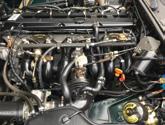

1961 Thames Trader Estimate: £11,000 - £13,000*
Reg No: SHV 352 Chassis No: 59438 MOT: Exempt
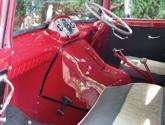
The distinctive cab design, which sets it apart from all other British commercial vehicles, was available in weights from 2 to 7 tons, powered by either petrol or diesel engines in 4 or 6 cylinders guises. The lower weight vehicles were available with 118 and 138 inch wheelbases, the heavy weight vehicle with 138, 152 and 160 inch wheelbases, there was also a 108 inch tipper wheelbase. In addition, there was also a low frame chassis model – typically used for furniture van bodywork.

Offered here is a MkI version, denoted by the name Thames Trader in Red on a chrome strip along the bottom of the bonnet opening. Believed to have originally been in service as a box van used by a house removal firm, it has since been altered with the addition of a usable rear flatbed in more recent times. With 8-stud axles and 20 inch wheels the identification tag describes it is a ‘516E’. The engine is a 6 cylinder petrol engine. The subject of a previous self-evident restoration this 1961 MkI Thames Trader has recently been shod with new tyres and been the subject of a brake overhaul. It is offered with a collection of invoices, a V5C and it is also tax exempt as an historic vehicle.

Estimate: £11,000 - £13,000*
Reg No: NYA 466E Chassis No: B39501581900/HRO MOT: August 2023
Delivered new in July 1967 to a Mr Bruford of Weston-Super-Mare and finished in Polar White with contrasting black interior, ‘NYA 466E’ remained in its first ownership until c.1973, before being passed to its second owner, a mechanic, who kept the car for approximately 29 years and performed all maintenance himself, until being sold in August 2002.

Retaining much of its original specification, it has been regularly maintained at a trusted garage during its current 20-year ownership and kept in a dry garage throughout. In September 2019 electronic ignition was added and the car also benefits from a stainless-steel exhaust. Recent work includes replacement tyres, shock absorbers and the car being Waxoyled between. Along with the ‘no advisory’ MOT, in August of this year, the car also benefitted from an oil change and health check in preparation for sale.

Accompanied by an impressive history file containing a large collection of MOTs dating back to 1975 at 34,000 miles nearly every year through to present day, the odometer now displaying only 82,101. Invoices totalling nearly £12,000 are present, an original logbook, Routes owner’s handbook, workshop manual, spares list, several Sunbeam Alpine Owner’s magazines and related booklets and finally a cover and a number of spares.



The TVR development car that went to Monza, and the Tulip Rally
Estimate: £35,000 - £40,000*
Reg No: 603 FM MOT: Exempt
Chassis No: 7C 119
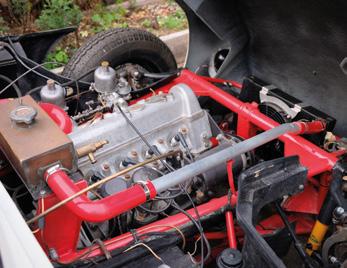
This particular Grantura, sold through H&H as a project in November of 2019 with little known history, as it turns out, may well be a rather historically important car. Now confirmed in writing by Keith Aitchison himself as the development vehicle taken to Monza on the press run with Hopton, as well as believed to be one of two cars to compete in the 1962 Tulip rally and further races and events in the UK as a development vehicle. Although this provenance is not supported by the TVR club, the vendor has undertaken significant research in his ownership and included with the vehicle is a timeline from December 1958 through to its sale in November 2019. Each event is dated, with accompanying evidence listed, thus providing a convincing case.
In August of 1962, Chassis 7C 119 was registered and sold as a new vehicle, purchased by an Alan Rhodda. Rhodda would be the sole owner of the car, until it was ultimately sold with H&H Classics in November of 2019, having apparently just covered 20,600 miles. Since its purchase, the car has been repainted, the seats reupholstered in their correct colour in high quality leather by a Jaguar Heritage craftsman, and much more. The engine, still the original Coventry Climax number 8409, has been borescoped and confirmed as stage 3 in good condition, and the car is now offered for sale with a much improved history file containing an original sales brochure, buff logbook showing 1 previous owner from new, Coventry Climax letters signed by Coventry Climax chief engineer Whalley Hassan confirming the provenance on the engine and built date, numerous Smiths letters discussing rev counter issues thought to be linked to the B-series engine fitted to the car on the Tulip Rally and a large collection of receipts for restoration and recommissioning.


Estimate: £30,000 - £35,000*
The brainchild of legendary engineer Antonio Fessia, the Fulvia derived its name from a Roman road that connected Tortona to Torino. Launched at the 1963 Geneva Salon as a four-door Saloon, the newcomer was styled in-house by Piero Castagnero who also penned a two-door Coupe derivative that entered production in 1965. Utilising the same independent front suspension, well-located beam rear axle and four-wheel disc brakes as its existing sibling, but sat on a 150mm shorter wheelbase, the Fulvia Coupe was among the best handling cars of the 1960s / 1970s. The work of Zaccone Mina, its narrow angle DOHC V4 engine ranged in size from 1216cc to 1584cc and was allied to four- or (later) five-speed manual transmission. Responsible for Lancia’s first official foray into motorsport since withdrawing from F1 during 1955, the Fulvia Coupe placed 8th overall on its competitive debut, the 1965 Tour de Corse. Winning the Italian Rally Championship every year from 19651973 (except 1970), the Works Cars fielded by Cesare Fiorio also scooped the 1972 International Championship for Manufacturers with two rounds to spare.
One of just 400 or so right-hand drive Lancia Fulvia 1600 HF cars made (from a total production run of 3,670), this particular example was originally delivered to the UK and later exported to Japan. Finished in a striking Red with a Grey interior, the Fulvia was re-imported into the UK in 2016 where the current vendor acquired it in 2019. Having benefitted from a recent respray to a very high standard, over the last two years the car has been subjected to an improvement programme by renowned Lancia Specialist Omicron, costing over £14,000. This work included an engine tune-up, gearbox overhaul, brake system overhaul, fitment of power steering, new fuel tank and a new fuel pump. This rare RHD 1600HF is said by the vendor to be in very good to excellent condition all round and is offered for sale with a recent maintenance history file and current V5C.


The 1950s saw Jaguar win the world’s greatest endurance race – the Le Mans 24-hours – more times (five) than any other manufacturer. A blend of existing and new technology, the XK150 was the Coventry firm’s last model to feature a separate chassis but its first to be available with fourwheel disc brakes. Unveiled in 1959, the range-topping 3.8 litre ‘S’ could be had in Roadster, Fixed Head Coupe or Drophead Coupe guises (the latter being the most expensive). With a quoted 265bhp and 260lbft of torque on tap thanks to its straight-port cylinder head and triple SU carburettors, Jaguar’s flagship sportscar could only be had with four-speed manual plus overdrive transmission. Reputedly capable of 0-60mph in 7.6 seconds and 141mph, its performance was on a par with rival Aston Martin, Maserati and Ferrari offerings. Decidedly rare, total right-hand drive XK150 ‘S’ 3.8 litre Drophead Coupe production amounted to just 69 cars.
According to its accompanying Jaguar Heritage Trust Certificate, this particular example – chassis number T827463DN – was completed on 29th September 1959 as a ‘home market’ XK150 3.8 Litre S Drophead Coupe. The engine number quoted on the Heritage Certificate and in the original ‘Buff’ logbook is VS2153-9, while the latter document also gives the capacity as 3.8 litres (3781cc). A ‘VS’ prefix is more normally associated with a 3.4 Litre S unit and curiously the car’s chassis plate is stamped with the engine number VAS1013-9 (‘VAS’ being the typical prefix for a 3.8 Litre S powerplant).
The apparent anomaly was rendered academic many years ago when the Drophead Coupe was fitted with a replacement 3.8 Litre engine from a 1964 Jaguar MK X Saloon. Supplied new via Moores of Brighton to F.J. Collis Esq of Gellihaf House, Blackwood, the 2+2-seater was initially finished in Cream and first road registered as ‘YCD 354’ on 31st October 1959. Known to have migrated to Westland, Keighley, London and Hertfordshire thereafter, the Jaguar is understood to have been treated to a bare metal respray during the 1990s and to have participated in various Kop Hillclimb events from the late 2000s into the early 2010s. Entrusted to Jaguar Land Rover Specialist Tom Lenthall Ltd during March 2018, the XK150 S was fitted with electronic ignition, new Coopercraft disc brakes all round and five fresh tyres plus having attention paid to its steering, suspension, clutch and overdrive unit etc at a cost of £14,543.58. Despatched to another marque specialist, Fender Broad, later that same year, the Drophead Coupe benefited from a thorough drivetrain refurbishment, engine bay tidying and rustproof treatment with the associated bills totalling a further £26,070. Finally, 2019 saw ‘YCD 354’ sent to a third marque specialist, Twyford Moors, for some £7882.24 worth of improvements. Starting readily upon inspection and running well, this rare and desirable XK150 S 3.8 Litre Drophead Coupe presents as an older restoration. Offered for sale with V5C Registration Document, Heritage Certificate, original logbook, old MOTs dating back to 1985 and the aforementioned recent bills.






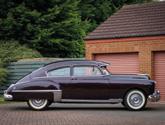
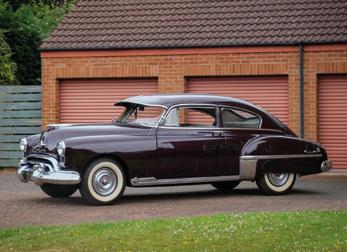
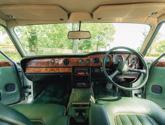
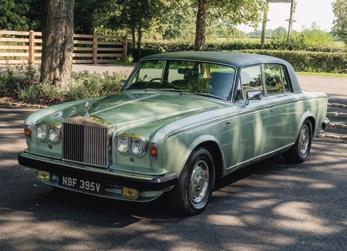
37
Estimate: £18,000 - £22,000*
Reg No: 72 RNM Chassis No: 498K9918
This Kansas City built 1949 Oldsmobile Rocket 88 fastback was first purchased by a Kansas potato farmer who used the car for 3 years before he died. From here, it rested in one of his barns for nearly 27 years until it was discovered and purchased by a member of the Oldsmobile Club of America. Later, the car would be purchased by a Bob Taylor, who would bring the car to the UK in 1980 and own it until at least 1998.
Still presented in its original shade of Garnet Maroon with cloth interior, ’72 RNM’ is featured in the book ‘Oldsmobile 1948 – 1963’ by Brooklands. Purchased by its current owner from a collector in Leeds in 2018, this example benefits from a 12v conversion with high torque starter, front disc brakes and has recently benefited from 4 new Longstone tyres. Included with the vehicle is an original owner’s manual, hydramatic drive booklet, Whirlaway instruction leaflet, photocopy of the general and technical specifications data, photocopies of the pages the vehicle features in in the book ‘Oldsmobile 1948 – 1963’ by Brooklands, some photocopies of pages from a magazine on Oldsmobile parts manuals and the current V5C document.

Estimate: £12,000 - £14,000*
Reg No: NBF 395V Chassis No: SRH0039229 MOT: September 2023
The combination of changes to the original Silver Shadow introduced in 1977 was sufficient for RollsRoyce to hail the new model `Shadow II’. The upgrades included a switch to rack-and-pinion steering, revised front-end suspension geometry, new carburettors, and revised exhaust and cooling fans all aimed at improving fuel consumption.
Recently taken out of long-term dry storage and with just 75,300 miles and four former private keepers from new, ‘NBF 395V’ is finished in Pacific Green complemented to a Green leather interior and Dark Green Everflex roof. The ‘Shadow II’ has benefitted from a full repaint in its original shade. Light recommissioning work has been undertaken, including a brake caliper overhaul, ‘full service’ with plugs, filters and all fluids, including a hydraulic flush, air conditioning re-gas, exhaust olives and MOT preparation.
From new, original extras included non-standard paint, Everflex roof, RR motifs to rear quarters, picnic tables, rear recess with hinged lid in rear armrest, lambswool rugs in Green, still present and in excellent condition, plus a change of colour for the Everflex roof to Dark Green. Accompanying, is a file that covers almost all of the car’s 42 years, starting with the original order, invoice, build sheets and delivery documents. The original Rolls Royce & Bentley owner’s handbook, service book, tool kit, collection of invoices and old MOT certificates are also present.
The history of Morgan’s 4/4 model can be traced right back to the company’s departure from its traditional 3-wheeler output in 1936. The 4-4 (and post WW2 4/4) designation simply meant fourwheel four-cylinder. Separate chassis construction, Morgan’s famous sliding pillar independent front suspension (get the grease gun out!) and ash-frame clad with conventional panel pinned bodywork and cutaway doors provided an outlet for the buyer who did not trust new-fangled steel coachwork and monocoque ‘shells. After five separate series of cars, the 4/4 was re-named the 4/4 1600 in 1968
With just 2 former keepers and 87,267 miles from new, this pretty 1969 example has been the subject of an extensive restoration in 1988, which included a new chassis. Additionally, ‘RSC 578H’ has received new woodwork, new wings and a repaint. Power is delivered from a 1600cc Kent engine, mated to a 4-speed transmission. The engine casing is believed to be of the desirable 711M type, which came with much stronger square main bearing caps. We have also been made aware that the Morgan was given an engine overhaul in 1999, some 1,350 miles ago. The specification includes the weather gear, consisting of side screens, soft top and tonneau cover. Offered with a collection of invoices and old MOT certificates ‘RSC 578H’ is offered with a fresh MOT certificate.


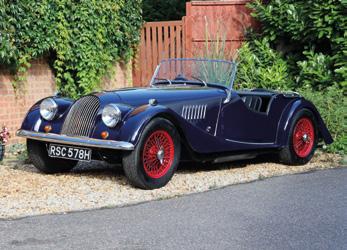
Estimate: £13,000 - £16,000*
Reg No: UU 4537 Chassis No: 6385 MOT: May 2023



Humber Limited had an important year during 1923, with the adoption across the range of new inlet over exhaust engines, replacing the previously adopted sidevalve units, along with the introduction of a new luxury small car, the 985cc 8hp (later called the 8/18). Very much a ‘big car in miniature’, it was generously equipped by the standards of the day. Developed through the 1056cc, 9/20 to the improved 9/28hp introduced in 1929.
Finished in traditional Mole/ Cream livery with Tan hide interior and reported to be in good order throughout. In its current custodianship since 2015 with ownership records dating back to 1956, ‘UU 4537’ is known to both the Humber Register and the VSCC. In regular use and well maintained in recent years, ‘UU’ is reported to drive well and this surely represents an excellent opportunity to acquire a very tidy example of the well-respected Humber 9/28 in Light Tourer iteration.
A file of paperwork accompanies ‘UU’ and includes the original handbook and sales‘brochur’, V5C and VE60, old MOTs and the current MOT (May 2023,), a 2014 Humber Workshop Report and subsequent invoices to covering an engine overhaul and a quantity of invoices covering various ongoing service works, workshop notes, sketches and so on.
Estimate: £80,000 - £90,000*
Based on the contemporary Rolls-Royce 20/25hp, the 3½-Litre Bentley was slightly shorter in the wheelbase and employed a tuned (115bhp) twin-SU-carburettor version of the former’s overheadvalve six. Add to this already remarkable package a four-speed synchromesh gearbox and servoassisted brakes, and the result was a vehicle offering the driver effortless sports car performance in almost absolute silence. “...the ability to traverse the rapidly crowding roads of Great Britain in less time, and with less effort, were points strong in its favour” observed Johnnie Green in Bentley, 50 Years of the Marque.

‘The Silent Sports Car’, as it was swiftly dubbed, had few peers as a tireless long-distance tourer, combining as it did traditional Rolls-Royce refinement with Bentley performance and handling. By the time production ceased in 1937 total of 1,177 3½-Litre models had left the Crewe factory, which went on to produce a further 1,234 of the successor 4¼-Litre model before this highly successful line came to an end in 1939. As befitted its sporting nature, the Derby Bentley was almost always fitted with owner-driver saloon or drophead coupé coachwork, the standard designs being the work of Park Ward.
Supplied new on 31 May 1934, this particular 3.5L was designed and created to the specification of eminent aircraft designer and engineer Sir Roy Feddon. Featuring an aerodynamic design with the rear portion of the car being visibly flat, this body shape was dubbed the ‘Aero Saloon’, and was reportedly the first vehicle to be wind tunnel tested in model form, at Vickers of Weybridge. When completed, the car was tested at Brooklands, clocking over 100mph – a particular feat in its day. This particular example, personally owned by Feddon until 1949, passed hands to owners in Devon and Buckinghamshire until 1963, when it was laid up and unused until purchased as a project by its previous owner the early 1980s.
Shortly after its purchase, the previous owner undertook a painstaking restoration, including unique ‘Figoni et Falaschi’ style coachwork by renowned coachbuilder Rod Jolley. Within the history file, there is hand-written notes documenting a 1600 hour restoration at a cost of £9760, with the car finished in Ford Monaco Red and Sorbet with matching red leather upholstery. Completed in Late 1987 and enjoyed for a further 10 years, ‘AXM 19’ was purchased by its current owner in December of 1997.

Now in ownership for some 25 years, this Bentley is well known to the Bentley Drivers club, having participated in a number of social rallies in Europe including a number of rallies in the Alps and Pyrenees, as well as rallies as far as New Zealand. As such, the car has been well looked after, with it being looked after largely by Michael Hibberd and Britannia Motor Engineering in current ownership, as well as Fiennes Engineering on a number of occasions. Prior to its trip to New Zealand, ‘AXM 19’ was subject to an engine overhaul at a cost of £16,026, with there being invoices on file in current
ownership totalling a staggering £138,000, with the most recent works being extensive works with Michael Hibberd in June of 2021 to the sum of £8,880.
Included with the vehicle is a comprehensive history file including the aforementioned invoices dating back to 1997, further invoices relating to the restoration dating back to 1987 with a photograph of the vehicle as a project prior to restoration, Communications with Sir Roy Feddon in September of 1963, where Feddon confirms the body was ‘specifically made to (his) requirements’, a copy of an article the vehicle was featured in from, a large collection of previous MOTs dating back to 1988, two original continuation books and the V5C document.

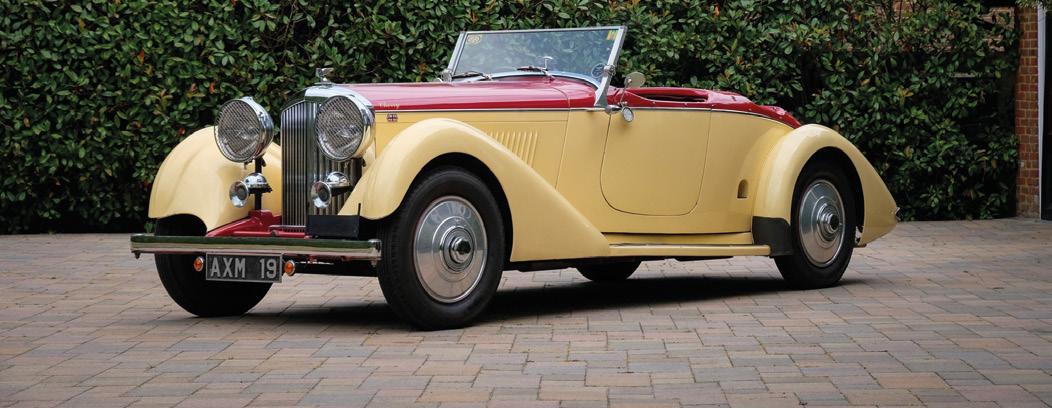


Estimate: £90,000 - £100,000*
As part of his publicity campaign to promote the newly introduced Austin-Healey 100/4 BN1, Donald Healey entered a team of four pre-production cars for the 1953 Le Mans 24-hour race. Running with standard windscreens, interiors and even bumpers, two of this mildly tweaked quartet survived to finish 12th and 14th overall. Eager to capitalize on this success (and also to comply with the event’s homologation requirements) Healey persuaded BMC to list a ‘Le Mans kit’ (twin 1.75 inch SU carburettors, high-lift camshaft, revised distributor advance curve and stronger valve springs etc) in its parts catalogue for 1954. Known officially as part P-280, it was available to fit on new or old models alike, and by dealers or private individuals.
This particular Healey was manufactured in 1955 and despatched directly to Donald Healey Garages in Warwickshire, where it is believed upon delivery the car was subject to full M-Specification conversion. Subsequently, the car was purchased that same year by a prominent member of St. Louis, Missouri society and senior officer in the Sports Car Club of America, Lester Seasongood. Seasongood was an insurance broker, as well as national secretary of the SCCA, area steward and active competitor; a leading light in motorsport in the period.

2 years later, in 1957, the car was sold to fellow competitor and editor of the St. Louis post, Jim Lawrence, who campaigned the car for a couple of seasons until it was once more sold to a Phil Larson in 1968. Documentary records and films from the period show what a fascinating and vibrant motor racing culture the SCCA engendered. Grids comprised of all the great European and American sportscars of the period, all racing together by enthusiasts, amateurs and professionals alike, with fabulous variety – with Porsche 356s, MG As, Austin Healeys, Chevrolet Corvettes, Ferrari 250 GT TDFs, TR3s….the list goes on and demonstrates what a fascinating cauldron of competitive spirit and legend the SCCA was in the United States in the mid-late 1950s.
In later years, the car returned to the UK, being repatriated in 2001 and between 2003 and 2005 was subject to a comprehensive restoration by the then owner, Mark Barnes. This restoration is photographically documented in an extensive history file, which also details its conversion to righthand drive, whilst retaining its original colourway of Old English White over Lobelia Blue – one of just 108 cars finished in this colour scheme. ‘890 XUD’ also retains its original specification laminated windscreen and heater, and very importantly, its original engine. In addition, the car benefits from a lightened and balanced Denis Welch flywheel; significantly improving throttle response. As well as this, 4 speed gearbox, front disc brakes and servo, new U/J’s, competition clutch and thrust bearing, a lightweight Dynamite alternator, expansion tank and high ratio rear axle.
In current ownership since 2015, this Healey has been well looked after, in 2017 having completed the GP Nuvolari without faults, as well as having been prepared, and importantly, registered for the Mille Miglia. Included with the vehicle is an impressive history file containing a large collection of previous receipts and invoices, previous race history, photographic history of the restoration, current

FIVA identity card, Heritage Certificate confirming the car is a ‘matching numbers’ example and is presented in its original colourway. A copy of the 2011 article in Classic Car Buyer, where the car was road tested, is also included.
Complete with a UK V5C registration, this Healey is ready to be campaigned in the Mille Miglia and other historic circuit events, or simply enjoyed for the vehicle it is by its next custodian.

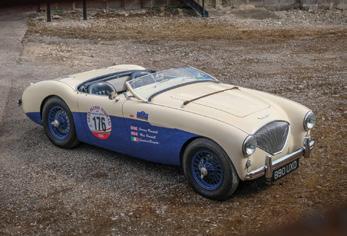

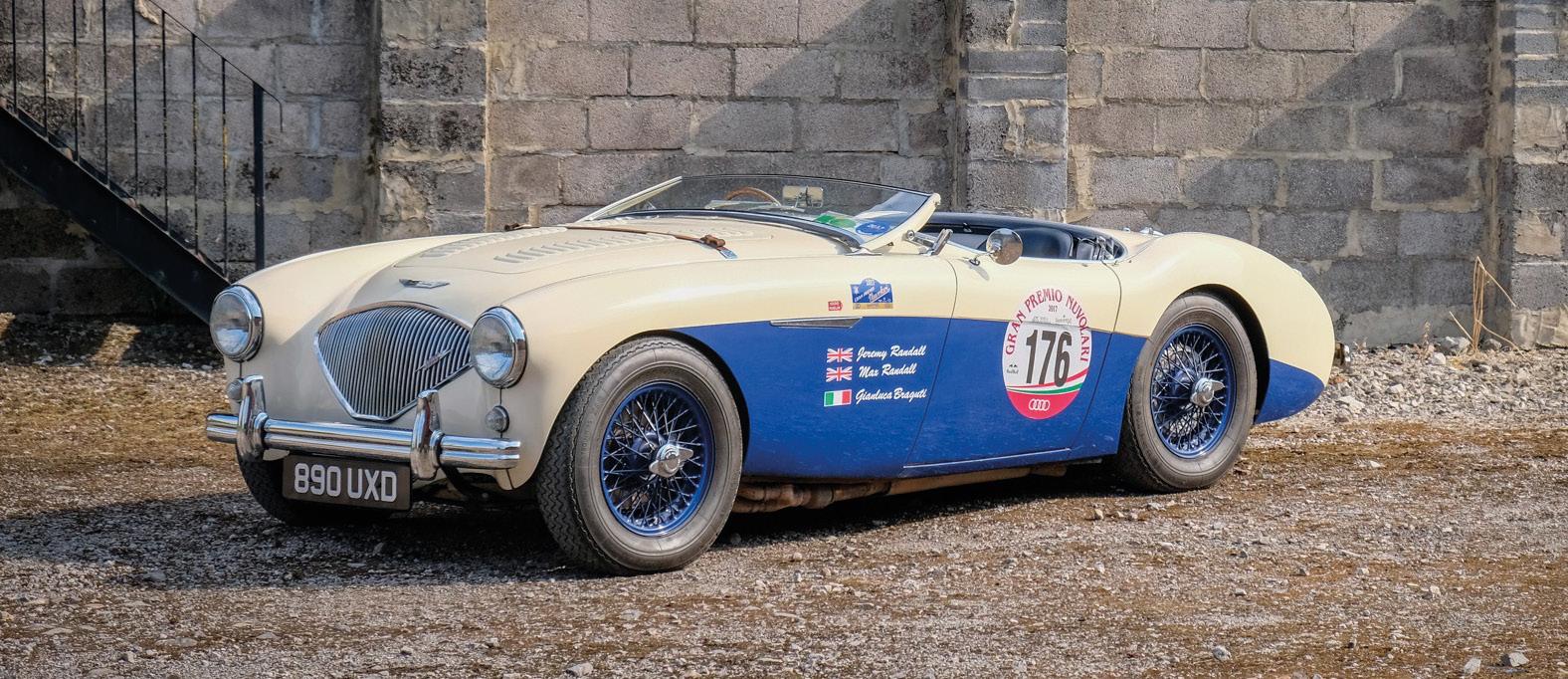
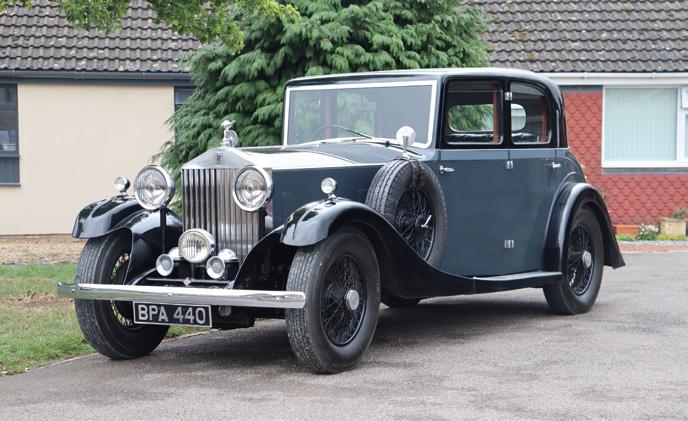
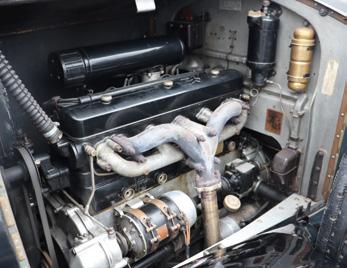

Chassis No: GGA3
Highlighting its `straight waistline, swept tail, and swept valanced wings and running boards’, The Autocar magazine also pictured chassis GGA3 as part of an article entitled `Coachwork of Character – A Review of Special Bodies of All Types for Large and Small Chassis’ which was published on February 16th 1934. One of just nine 20/25 chassis to be clothed by E.D. Abbott Ltd of Farnham, the Sports Saloon is the only one to this design and was supplied new to Mrs Duffus of Cumberland Court, London W1. The Rolls-Royce’s elegant exterior was complemented by an equally stylish interior featuring mother-of-pearl inlays as well as leather upholstery and silk pulls. Intended for use `in the UK –mainly touring’ and to carry two passengers most of the time, the Sports Saloon belonged to tank commander Lt Colonel C.M.F. Deakin by late 1945. Thereafter, it is known to have passed through the hands of Colonel R.J.K. Fenton (Woodbridge), Paddon Bros (London), Dr F.L. Lawson (Ontario), Dr J.C. Wain (Pennsylvania), James F. Labadie (Ohio), Dale W. Beavers (Ohio), John H. Parnell (Louisiana), Lyn Thomas (Dyfed), Les J. Jones (New Tredegar) and Norman Cawood (Skipton). Extensively restored by Mr Cawood between 1995 and 2010, chassis GGA3 has since been treated to stainless steel exhaust and not to mention being reunited with its original `BPA 440’ number plate. The interior has benefitted from freshening of its luxury, with a new headlining, Wilton carpets and has mother of pearl inlays. Illustrated in `Coachwork on Rolls-Royce 19061939’ (L. Dalton), `The Flying Lady’ magazine and the RollsRoyce Owners’ Club’s 20/25 handbook, this most attractive Sports Saloon has been the receiver of much recent cosmetic and mechanical work in recent years and through its ownership and enthusiast custodianship. Offered with a copy of its chassis card record, a collection of old MOTs and a pad of written notes documenting some of GGA3’s history.
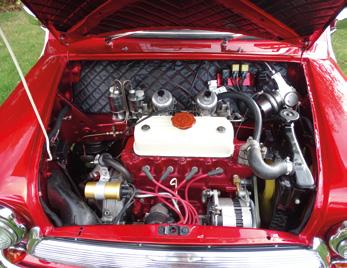
Estimate: £25,000 - £35,000*
In the words of the vendor, the owner of the restoration company which restored the Mini for his own collection:


‘’The body has new front wings, new front panel, half a new roof, new ‘A’ panels, new door skins and new rear valance. It has been sandblasted and then painted in etching primer. All filler work completed before being painted in 3 coats of high build primer, then 6 coats of top coat – Cherry Apple Red. After this, it had 3 coats of lacquer. The roof has been painted in WT3 Old English White with Diamond lacquer. The wheel arches were painted to match the roof. The underside has had stone-chip which has been applied with a spray gun to give a smoother finish, then painted red on top.
The engine has been stripped, reboarded +40, crank reground, then rebuilt with new pistons, new shell in the crank. With a semi-high lift camshaft with a duplex chain and rota side steel gear set. It has had new valve guides in the head along with the head being port and polished. Roller-rockers were fitted, twin 1 ½ inch carbs with a Manifold 2-inch exhaust fitted. As for the suspension; the subframes have been sandblasted and painted along with all suspension parts, and put back together with all new bushes and bearings. The Mini was also fitted was a new steering rack and aluminium Minilite wheels. The wiring loom has been made in-house.
The Mini has an all-bespoke interior, made in-house. The dash is to our own design with little touches to bring it together like the door handles and steering wheel matching. The seats are handmade in Cream leather with matching leather door cards and a Cream vinyl roof lining. The Red piping, Red carpet and seatbelts all pick up on the exterior colour again bringing the car together.’’
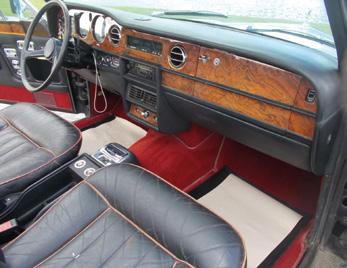
In production between 1971 and 1996, the Rolls-Royce Corniche Drophead is the epitome of luxury open-air motoring. Fabled for its extravagantly sumptuous interior and hushed drivetrain, it was powered by a tuned version of Crewe’s staple 6750cc V8 engine mated to an automatic transmission. Equipped with firmer springs, thicker anti-roll bars, and revised steering geometry, it proved a more satisfying drive than its humbler saloon car siblings. The presence of olio-pneumatic suspension and a plethora of electric motors ensured that it remained a singularly cosseting experience. The Corniche received its first major revision in 1977 and included new rack-and-pinion steering and alloy-and-rubber bumpers, which replaced the earlier chrome bumpers, along with an oil cooler, aluminium radiator, and bilevel air-conditioning system.

From its build date in 1982, this elegantly styled Rolls-Royce Corniche Convertible, left these shores for a new life in the USA, finished in Georgian Silver over Black Masons. Heading Stateside it was configured in left-hand drive left-hand drive with the addition of Rolls-Royce rubber mats, lambswool over-mats and a tonneau cover for the lowered hood. Now repatriated, the Corniche’s UK registration is in process and merely awaiting the UK registration number and new UK V5C. Displaying c.28,000 miles on the odometer, we are informed by the vendor that the car starts, runs and drives. With an MOT into August 2023, the book pack with owner’s wallet and service book are present, as is the original Rolls-Royce tool kit. There is a US Carfax Report that accompanies the car.

A restoration project with much potential
Estimate: £22,000 - £26,000*
Reg No: EVG 805H MOT: Exempt
Chassis No: 911210635
In 1968, the Porsche 911’s wheelbase was increased by 57mm, and the rear overhang was reduced by the same amount. The model year 1970 saw the engine capacity was enlarged to 2.2-litres and then subsequently to 2.4-litres in 1971, being offered in three levels of tune, namely: T (130bhp), E (165bhp), and S (190bhp).
Conceived to fit between the 911 T and the 911 S, the E designation stood for Einspritzung, German for “injection,” noting the mechanical fuel injection. The Targa appeared in 1966 with a built-in roll-over hoop for fear that convertibles might be banned for safety reasons. The earliest design utilized a removable clear plastic window that could be taken down to create a near-full convertible when the center roof panel was also removed. Porsche soon substituted a large fixed wrap-around glass backlight to improve weather sealing.
A desirable first year 2.2 engined ‘C-Series’ 911 E, the Porsche was is understood to have been supplied new to the United States of America in left-hand drive configuration. One of just 2, 476 2.0-litre 911 Es reputedly produced during 1970 with the 2195cc flat-six air-cooled engine (with mechanical fuel injection) allied to the five-speed manual transmission, with the total 2.2-litre production thought to be just 4,243. Chassis number 911210635 was last finished in Red paintwork with interior upholstery trimmed in Black. Understood to have resided in America until c.2018 when the 911 Targa was imported into the United Kingdom in ‘barn find’ condition.
In current ownership since arriving in the United Kingdom, the Porsche has been UK registered ‘EVG 805H’ and has remained in ‘barn find’ condition ever since, awaiting restoration. Showing a recorded mileage of 82,941 miles, the 911 is now offered as a restoration project with undoubtable potential and is thought to be mostly complete. Offered with paperwork relating to the importation, a copy of a previous registration document from the State of Florida, and a current V5C document.





Estimate: £16,000 - £20,000*
Launched in 1975, Jaguar’s XJS was never envisaged as a direct replacement for the E-Type. More of a soporific grand tourer than an out-and-out sports car, it was designed to seamlessly blur borders rather than blast down back roads. To this end, it was equipped with automatic transmission as standard. Though, when fed the quoted 295bhp and 31’lbft of torque developed by a post 1981 H.E. (high efficiency) 5.3 litre V12 engine, this still resulted in a claimed top speed of 150mph and 0-60mph in less than eight seconds. Introduced at the 1988 Geneva Motor Show, the long awaited full Convertible version featured a reinforced floorpan, frameless doors and sophisticated electric hood (complete with heated glass rear window). Underpinned by the same all-round independent coil-sprung suspension and power assisted rack and pinion steering as its fixed head Coupe siblings, the soft-top came with anti-lock brakes as standard. Priced at some £40,000, a waiting list was quick to form. Supplied new by Jaguar of Liverpool, this attractive XJ-S V12 Convertible is finished in White with a complementing Black leather interior with a Black hood. Today, the Convertible displays just 46,050 recorded miles and was a one owner car from 1988 to 2021, the current vendor is only its second keeper. ‘F602 LMW’ was supplied with cruise control, air conditioning, automatic transmission, fog lamps, electric windows and mirrors, heated seats and a removable Jaguar radio cassette player, de rigueur in 1988. The inside is well presented with its cossetting sea of Connolly handmade stitched leather and burr walnut wood, it even possesses the original carpet branded Jaguar mats. The Jaguar has the well-known V12 engine attached to a 4-speed automatic. A neat tonneau is present along with the tool kit and original jack. Offered with owner’s wallet, handbooks and the service book and a collection of invoices and old MOT certificates.
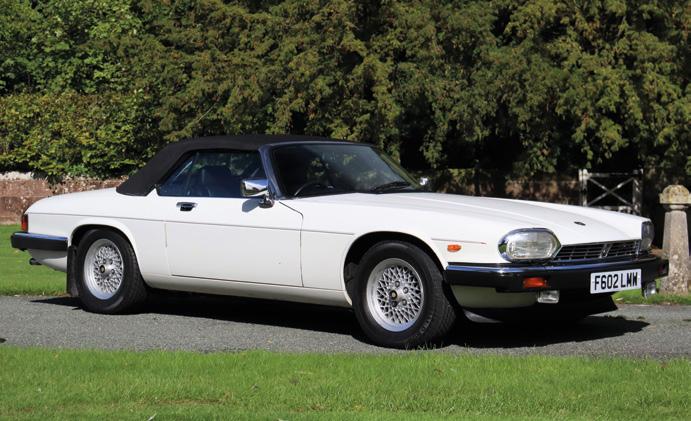

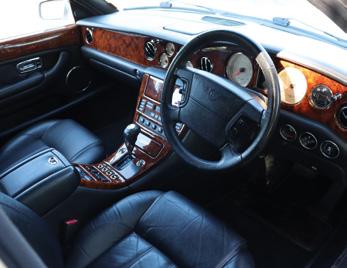
Estimate: £18,000 - £22,000*
The Bentley Arnage and its Rolls-Royce sibling, the Silver Seraph, were phased in during the spring of 1998 as replacements for derivatives of the long-serving Mulsanne (Bentley) and Silver Spirit (Rolls-Royce). The bodies for the new cars were built at the Bentley factory in Crewe, while the engines were outsourced.
Initially available as a single model, the models expanded with the option of the Arnage Red Label and Arnage Green Label.
The Red Label was initially powered by a Cosworth-built version of Bentley’s stalwart single-turbo OHV 6.75-litre V8, while the short-lived Green Label utilised a Bentley-modified version of the Arnage’s original BMW unit. The Red label gave way to the Arnage R in 2002. In common with the long wheelbase RL launched the previous year, it was powered by a completely reworked version of Bentley’s venerable 6.75-litre V8 engine.
Courtesy of Bosch Motronic engine management and a pair of Garrett T3 turbochargers it produced 399bhp and a whopping 616lb-ft of torque.
Manufactured in 2003, the Arnage R offered was supplied new to the United Kingdom, being registered new on the 31st of March that year. Fitted with the 6750cc V8 twin-turbo engine allied to the automatic transmission, the Bentley is finished in Silver with Black leather interior upholstery and wooden trim. Entering into current ownership in 2019, ‘LK03 UYD’ has covered a mere c.57,000 miles from new. Specified from new with the optional extra of a factory sunroof, the Bentley benefitted from much improvement upon entering into current ownership, with some £4,400 worth of expenditure, including a new airbag control unit sensors and servicing with Silverlady, and four new tyres. Serviced again by Silverlady in April this year, the Bentley is offered with a history file which includes the original book pack with stamped service book, as well as a collection of invoices from the current ownership, some previous MOTs and a current V5C document.

BMW’s so called ‘New Class’ compact Saloons and Coupes manufactured between 1962 and 1975 quite simply saved the company from extinction. Introduced in 1965, the 2000C and 2000CS Coupes featured distinctive-looking Karmann-built bodies and luxurious interiors and, having set a trend, were superseded in 1968 by the first of the E9 Coupes – the 2800CS. The length and wheelbase of the newcomer were extended to accommodate the 2788cc straight-six engine from the E3 Saloon, and the nose of the Karmann monocoque body was restyled to echo that of its four-door sibling. The 170bhp of the new, silky smooth powerplant was sufficient to propel the handsome Coupe to 60mph in 8.5 seconds and on to a top speed of a whisker under 130mph. The fully independent suspension was by MacPherson struts up front and semi-trailing arms at the rear. Braking was still by disc/ drums and the steering by a power-assisted ball and nut system. The 2800CS was supplanted by the 3.0CS and 3.0Csi in 1971, for which the engine was bored out to give a capacity of 2986cc. Credited with developing 200bhp and 200lbft of torque, the fuel-injected variant was reputedly capable of 0-60mph in 7.5 seconds and 139mph. Interestingly, the 3.0 Csi is rarer in RHD, manual transmission configuration than the 3.0 CSL with just over 400 being made (between the ‘226’ and ‘435’ series).
Finished in the stunning combination of Fjord Blue metallic with Black leather upholstery, chassis 2265479 was first registered as ‘XPC 86N’ by Surrey Council on 3rd September 1974. Belonging to its last owner for the best part of twenty years, the BMW has since undergone a comprehensive refurbishment courtesy of the vendor’s professional bodyshop. Said to be in ‘superb overall’ condition, the result is surely one of the best on the market? Among the finest looking Coupes of the 1970s, the E9 is a true design classic. The BMW Club UK estimates that as few as 120 RHD 3.0 Csi cars have survived to the present day. A notably smart example, ‘XPC 86N’ is offered for sale with V5C Registration Document, digital photos documenting its bare metal restoration and history file (the latter containing numerous receipts attesting to upkeep and expenditure over time).
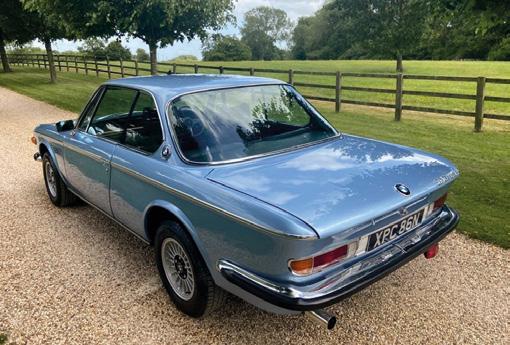

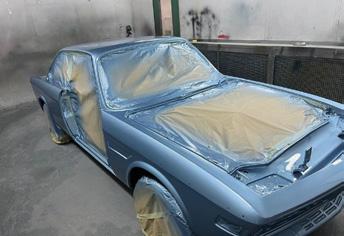




82 years in current family ownership
Estimate: £160,000 - £180,000*
Reg No: GB 8075 Chassis No: 854 MOT: June 2023
Mindful that the 3 Litre model which bore his name was among the most expensive cars on the market, W.O. Bentley wasted little time in proving its competitive worth. Victorious in the Whitsun Brooklands meeting on May 16th 1921, the design also distinguished itself the following year at the Indianapolis 500 and Tourist Trophy with Bentley netting the Team Prize on the latter event. Justifiably proud of its achievements on the Isle of Man, Bentley not only published a celebratory booklet entitled `The Blue Riband’ but also launched a commemorative `T.T. Replica’. Based on the short standard 9ft 9½in wheelbase chassis, the newcomer boasted a high compression engine, close-ratio gearbox and 90mph top speed. Responsible for giving Bentley its first taste of success at Le Mans when Captain John Duff and Frank Clement drove one to fourth place overall during the inaugural 24-hour race on May 26th-27th 1923, the ‘T.T. Replica’ evolved into the ‘Speed Model’ that same year. Achieving two outright Le Mans 24-hour victories and some 513 sales, the latter has long been among the most sought after 3 Litre variants.
Fitted with Four-Seater Sports Tourer coachwork by Vanden Plas, chassis 854 was supplied new via G.M. Gladstone Motors Ltd of Glasgow to Charles F. Kennedy Esq. of Finnarts, Ballantrae and first registered as ‘GB 8075’ on 4th March 1925. Directly descended from Hugh Kennedy of Ardstinchar who famously fought for Joan of Arc and is often cited as Scotland’s first golfer, ‘C.F.K.’ sold the Bentley to H.W.J. Taylor Esq. of Woodlands House, Trossachs in 1929 before accepting Lord Inchcape’s offer for his estates and emigrating to Tasmania the following year. Remaining north of the border with its Third and fourth keepers, M. Mitchell Jnr and Ronald Graham Esq., the 3 Litre suffered accident damage in the latter’s hands such that its frame was straightened, and a reconditioned front axle bed installed (an earlier mishap had already resulted in a new radiator). Passing to Yorkshireman Anthony Metcalfe-Sibson Esq. thereafter, the Sports Tourer had been fitted with a replacement engine and gearbox (1126 taking the place of 855) by the time that the vendor’s father encountered it in a Richmond field! Bought with the last of his wedding present money, the 3 Litre spent the Second World War ferrying its new owner around on Ministry of Aircraft Production duties (he had been invalidated out of the Army following a double dose of pneumonia). The advent of peace saw the family relocate to Rochester, Kent and take up residence on a government surplus motor torpedo boat. Refusing forty times what he paid for it, the vendor’s father used ‘GB 8075’ to move his brood and their possessions to a bricks and mortar home in first Birmingham and then Iver Heath during the 1950s (one memorable copy photo on file depicts the Speed Model with a teak dinghy on its back).
Another house move to Lichfield in 1957 saw the Speed Model taken off the road and subsequently stripped pending an intended restoration. Still in pieces when the vendor inherited it during 1985, the refurbishment finally began two years later but was not completed until 2010.
The different stages and costs of the work are recorded on an accompanying typewritten log.
Rebored to 82mm and fitted with new pistons and hardened valve seats, the replacement 3 Litre engine (which the vendor’s father had already uprated to Speed Model specification) also benefited from a full flow oil filter conversion and re-white metalled bearings etc. A new 4-star differential cage and associated bolts were acquired and an uprated 3.78:1 crown wheel and pinion installed. The front and rear wings were repaired and the original Vanden Plas coachwork reunited with the chassis. The steering, brakes and suspension were gone through (albeit the original and rare ‘Andre Hartford’ remote damper adjustment mechanism was not reinstated). The plywood seat backs were renewed but an original kept which quite remarkably appears to be numbered in chalk as ‘1112’ (the same number that Vanden Plas allocated to the body). The dashboard carries a host of original instruments, and a surviving door card sports a Bentley Motors Ltd Standard Bodies plaque for chassis 854 (Bentley and Vanden Plas numbering the coachwork differently).
Sparingly but regularly driven since 2013, one of the Speed Model’s most memorable trips was to the Isle of Man for the Bentley Drivers’ Club’s Three Litre Centenary Raid earlier this year with ‘GB 8075’ successfully completing a lap of the famous TT circuit (which was the site of Cricklewood’s first major competitive success). Seemingly retaining its original chassis, front crossmember, bonnet, Vanden Plas coachwork, steering box and rear axle nosepiece, this glorious W.O. Bentley exhibits an inimitable patina. Paperwork on files includes: a V5C registration document, two ‘Buff’ logbooks, current MOT Certificate, old tax discs, photographs, a chronological schedule of expenditure during the restoration (with supporting invoices, notes and sketches), a copy of ‘Technical Facts’ and other literature. Additionally, ‘GB 8075’ comes with various service parts and spares etc encompassing an original radiator stone guard, scarce ‘Andre Hartford’ remote damper adjustment mechanism and an ultra-rare (and likely original to the car) ‘map wallet’. It is rare indeed for a W.O. Bentley to retain its original coachwork and rarer still for one to have been in single-family ownership for eighty-two years. A wonderful opportunity.






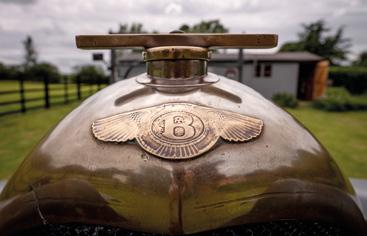
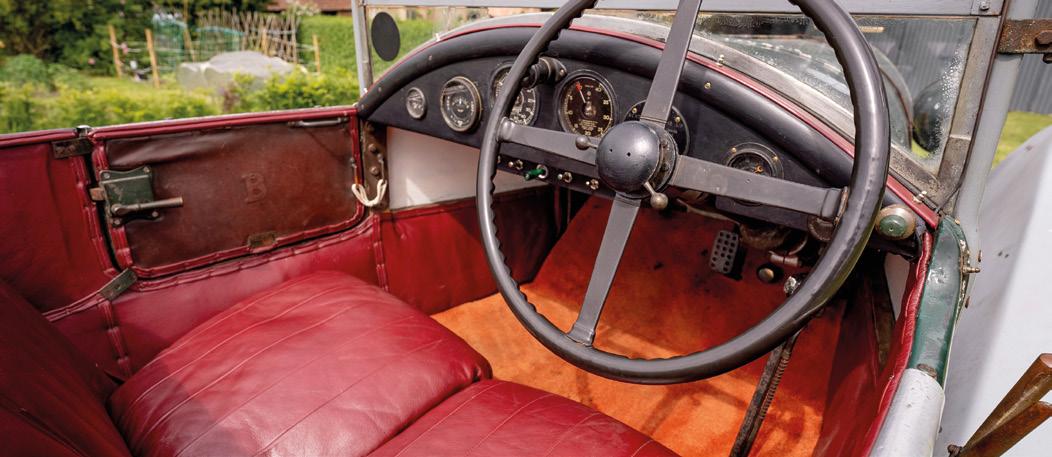

‘The Studebaker Golden Hawk was penned by Raymond Loewy who has been hailed as: ‘The Man Who Shaped America, The Father of Streamlining and The Father of Industrial Design’. Only available for a single year – 1956 – the model was built at Studebaker’s South Bends, Indiana factory and differed from its siblings in being propelled by a high-quality Packard 352 cu in (5.7 litre) V8 engine rated at 275hp. Boasting a higher power to weight ratio than any other American car at the time, the Golden Hawk could sprint from 0-60mph in 8.7 seconds – a remarkable turn of speed for the 1950s – and sported bespoke wheel trims with proud red stars to their centres.
The seventh oldest known survivor from the 4,071 made, chassis number 603011 was found by the vendor via www.1956goldenhawk.com – a website that caters to the model’s worldwide following.
Thought to have covered just 83,500 miles from new, the Studebaker was first purchased by a successful farmer in Idaho, USA who dry stored it in an old wooden railway wagon for forty years.
The Golden Hawk then passed to a Canadian enthusiast based in Florida, John Herbert, who had it extensively and expensively refurbished changing the colour scheme from Glenbrook Green / Seaside Green to Metallic Blue with Cream fins in the process.

Having acquired chassis 603011 in 2014, the vendor had it stripped down, each body part soda blasted, necessary primer and undercoat layers built-up and Midnight Blue and Yellowstone topcoats applied to mimic the colour scheme of the original launch model which he feels sets the design’s lines off to best advantage.
The work was carried out over several years by approved top quality bodywork specialists Hanstons Bodyshop and Garage Services, Broadheath, Altrincham who have done a remarkable job of the highest quality. There is a photographic record of the restoration. Even the rubbers have been renewed. Not neglecting the mechanical side of things, the seller entrusted the Studebaker to an American car expert - E.G. Wright Motor Engineer of Ashton under Lyne - whose work is highly respected. He replaced the automatic transmission front and rear brake drums and brake bands and a new lockup clutch. The hydrovac brakes and servo system were completely reconditioned. The car was fully serviced with the last bout of maintenance being completed earlier this year.
The Packard engine has always been, and remains, ‘sweet as a nut’. This is probably due, in part, to the car being off the road for 40 years and therefore covering a lower mileage than might be expected for a 1956 machine. ‘316 UYK’ is not far below concours condition. All the new parts are originals from the USA including bumpers, lights and bright work. No expense has been spared in the restoration project and subsequent servicing.
This 1956 Golden Hawk is rare, stunning in appearance and utterly genuine. It has been the centre of attention at the only two classic car shows it has attended. Pleasingly retaining its original Idaho plates and build sheet, this stunning Studebaker must be considered an appreciating asset, particularly in the present stormy economic climate!’
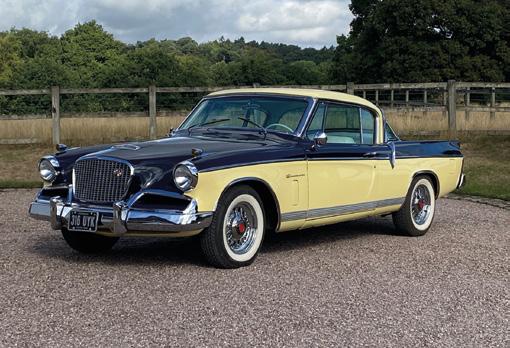


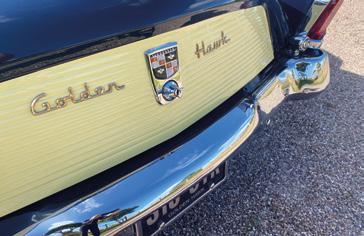


Estimate: £70,000 - £80,000*
As part of his publicity campaign to promote the Austin-Healey 100/4 BN1, Donald Healey entered a team of four pre-production cars for the 1953 Le Mans 24-hour race. Running with standard windscreens, interiors and even bumpers, two of this mildly tweaked quartet survived to finish 12th and 14th overall (an amazing result for such comparatively inexpensive cars in near showroom condition). Eager to capitalize on this success (and also to comply with the event’s homologation requirements) Healey persuaded BMC to list a ‘Le Mans kit’ (twin 1.75 inch SU carburettors, high-lift camshaft, revised distributor advance curve and stronger valve springs etc) in its parts catalogue for 1954. Known officially as part P-280, it was available to fit on new or old models alike and by dealers or private individuals. Adopted by BMC themselves (together with the addition of a louvred bonnet complete with leather strap) for the 100M version of the BN2 100/4 introduced at the 1955 London Motor Show, it has remained a popular modification package ever since.
According to its accompanying British Motor Industry Heritage Trust certificate, this particular example was initially finished in Healey Blue metallic with Blue upholstery (the same combination it pleasingly sports today). Completed on 9th February 1954, the 100 was supplied new to America where it is thought to have seen competition usage before being repatriated by Road & Race Restorations of Manchester in February 1990. Interestingly, the copy C&E 386 form on file lists the car as an ‘Austin-Healey 100/4 M’ which suggests that it had been modified to ‘Le Mans’ (or ‘M’) specification in-period. The two-seater’s first UK owner, Rodney Cobb, had it thoroughly gone through by renowned marque specialist Orchard Restorations. He also added his name to the list of previous keepers recorded in the Big Healey’s original Service Manual. Subsequently pressed into service as an endurance rally car, ‘YSU 274’ boasted an alloy cylinder head, BN4 four-speed plus overdrive gearbox and front disc brakes when it was issued with a FIVA identity card during July 2004. Enjoyed on events such as the Classic Marathon (London to Prague), Rallye International des Alpes and HERO Irish Trial etc, the two-seater was fettled and improved by Croft Engineering using parts from Denis Welch Motorsport and A Head 4 Healeys Ltd etc. Treated to an engine overhaul by Ian McPherson & Son Ltd of Manchester in 2012, a minor bump seven years later provided the impetus for a body off, chassis up restoration which left ‘YSU 274’ in the super smart condition it remains today. A few stickers, Sabelt seat harnesses and the presence of a dash-mounted trip meter are all clues to the 100’s competitive past but otherwise it looks as if it would be more at home on a concours field than being thrashed through a special stage! Starting readily and running well during our recent photography session, ‘YSU 274’ feels tractable but rather more potent than a standard BN1. Suitable for use as a fast road car or a return to timed events, this gorgeous looking Big Healey is worthy of close inspection. Offered for sale with V5C Registration Document and history file.

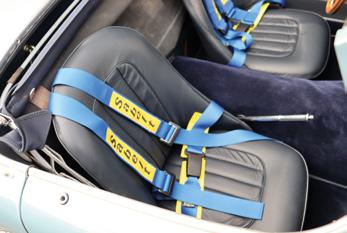

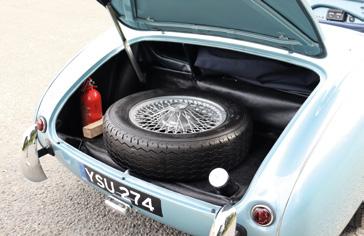

The Daimler DB18 utilised an evolution of its 15hp pre-WW2 predecessor’s chassis and 2.5-litre straight-six engine. A redesigned cylinder head was employed and a popular pre-selector gearbox featured, while automatic chassis lubrication was a further refinement. Both Barker and Tickford were to design and build elegant ‘foursome’ drophead coupes on this chassis and the 1949 models still retained the distinctive separate chrome headlamps.


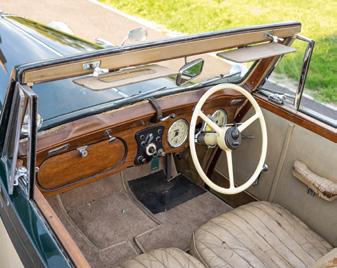
Supplied new to Bristolian entrepreneur Norman Ricketts of Tellisford House and registered in the name of his company ‘Consortium Property Holdings’, ‘LHU 916’ has remained in single family ownership for some 73 years, following bequeathal to his son Maurice in 2010. Offered with factory correspondence dating back to the late 1940s, other paperwork on file includes letters from secretaries and a chauffeur, along with the car’s green folding logbook from 1971. Invoices on file show a comprehensive restoration was undertaken by WM Jones and Bence Ltd over a twelve-month period (during 1970-1971). Almost two decades later, the car was treated to a replacement gearbox at around the 90,000 mile mark, which is backed up by a selection of MOT certificates dating back to 1971.
Starting, driving and remaining un-temperamental during our recent photography session, the vendor states that ‘LHU 916’ has recently completed some long-distance journeys to the South Coast without issue and is ready to be used and enjoyed by the purchaser. Perhaps suitable for preservation-class events, this droptop Daimler does feature wonderfully patinated paintwork and wear to the interior commensurate with age and could be sympathetically restored at the discretion of the purchaser (but hopefully left as-is). Described by our vendor as “Good” with regards to its bodywork, paintwork, engine, electrical equipment, transmission and interior trim, this Barkerbodied Drophead Coupe offers an affordable route into open-top British touring, for a fraction of the price of the DB18 ‘Special Sports’ models of the same period.
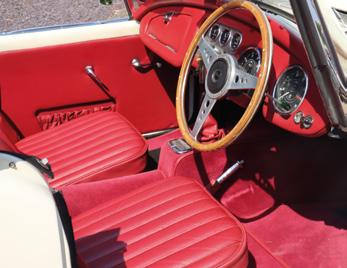
Estimate: £35,000 - £45,000*
Reg No: 79 AXP MOT: Exempt
Chassis No: 101410
The futuristic Daimler Dart was introduced at the New York Motor Show in 1959 and had its European debut at the 1959 Earls Court Motor Show; the Dart name was soon dropped after the threat of legal action from Chrysler who had a car of that name within their Dodge division. Thereafter this new sports car was known as the Daimler SP250. Power was provided by the 2.5 litre, Edward Turner designed, V8 that soon became revered for the smoothness in its power delivery with 140bhp on tap. The coachwork was constructed with glass-reinforced plastic providing a tough, strong and lightweight shape that enhanced performance with, some might say, exciting and non-traditional looks. The 120mph plus capability was recognised by the police and they were soon being used as high-speed chase cars.
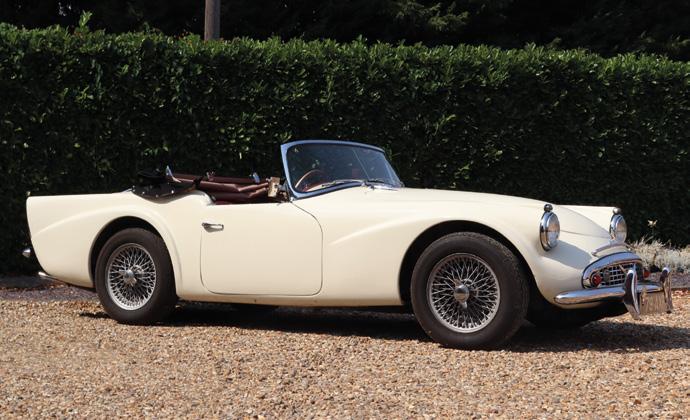
Having previously been in long-term previous ownership, ‘79 AXP’ has had just 3 former keepers on the V5C. The original ‘Buff’ logbook is still with the car. In recent times the Dart has been the subject of a previous engine overhaul by Russ Carpenter which has a photographic record. It is also fitted with an overdrive (with a new solenoid recently fitted) and has benefitted from an alloy radiator and electronic ignition.
The Dart has been upgraded to a ‘B Spec.’. Jaguar had bought Daimler in 1960, and was immediately concerned about chassis flex. They brought out the ‘B Spec.’ version, with consisted of extra outriggers on the chassis and a strengthening hoop between the A-posts. There were also other detail improvements, including an adjustable steering column. The upgrades to this car include rack and pinion steering and strengthening of the sills and the bulkhead. Additional work, that has refreshed its presentation, has included the fitting of new wheels and tyres and a refurbished interior plus a Mohair hood. The Dart is accompanied by a collection of old MOT certificates dating back to 1966, a collection of invoices and some old tax discs.
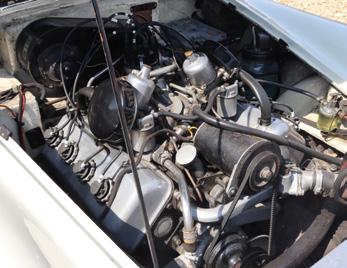

Estimate: £80,000 - £100,000*
A mercurial character who became renowned within the London motor trade for sourcing the very best pre-owned exotica, Charles Follett would travel anywhere in the UK for the right car building-up an enviable client base in the process. A member of the Brooklands set, his ‘black book’ comprised society’s elite from racing drivers to celebrities via members of the aristocracy. Given sufficient funding to buy showrooms in the heart of Mayfair, he became the Alvis concessionaire for London and the Home Counties during 1931. Seriously impressed at the Coventry firm’s engineering integrity but dismayed at the staidness of its offerings, Follett set about turning the marque into a Lagonda, Sunbeam, Invicta and (later) Bentley rival. Decades before Jaguar came up with its famous ‘Grace . . . Space . . . Pace’ slogan, he was adamant that all three were intrinsic to making a car appeal to wealthy buyers.
Introduced in late 1931, the Alvis Speed 20 SA was the first model which Follett could really sink his teeth into. Based around a low-slung, double-dropped chassis frame, powered by a lusty 2511cc OHV straight-six engine and boasting 90mph performance, it proved an ideal canvas for the coachbuilder’s art. Conscious that Vanden Plas’ order book had thinned considerably due to RollsRoyce’s acquisition of Bentley and the subsequent hiatus in the latter’s production, he approached the London company with a bold proposal. Follett would order a minimum of 100 bodies from them if they would (a) cut the average cost from £600 to £195 per chassis and (b) devise a range of suitably rakish designs over which he would have sign off. Vanden Plas capitulated and came up with a notably stylish Saloon, Tourer and Drophead Coupe which The Autocar hailed as ‘very attractive special bodies’.
Often at loggerheads with Alvis’ supremo T.G. John and his chief engineer G.T. Smith-Clarke over the ‘unnecessary’ expense of a la mode coachwork, Follett once denied the pair access to their own boardroom while he laid out the £895 required to buy a Speed 20 in one pound and ten shilling notes just so they would better appreciate that looks and amenities were as important as driving dynamics when such sums were involved. Embracing the ‘Race on Sunday, Sell on Monday’ ethos, Follett campaigned a series of Alvis cars at Brooklands. Evolving from SA to SB guise in September 1933, the Speed 20 gained a four-speed all-synchromesh gearbox, independent front suspension and adjustable rear dampers. While, stylistically the model was enhanced via a forward sweeping scuttle / bonnet join line, 19-inch wire wheels and larger Lucas P100 headlights. Again tasked by Follett with clothing the Speed 20SB to best effect, Vanden Plas produced a variety of open and enclosed bodies the best looking of which was undoubtedly a two-door saloon cum fixed head coupe known as the ‘Flatback’.
A close-coupled, Four Light design with notably slim A-, B- and C-Pillars, the ‘Flatback’ also sported a distinctive swage line that accentuated its airy glasshouse and ‘letter box’ rear window. A spectacular
exemplar of the ‘airline’ styling trend which captivated the automotive industry on both sides of the Atlantic during the mid-1930s, the Speed 20 SB ‘Flatback’ is arguably the best-looking enclosed Alvis ever made. Indeed, for many its desirability is second only to that of the (again) Vanden Plasbodied 4.3 Litre Short Chassis Tourers. Often finished in two-tone liveries, the four-seater sported extravagantly peaked, full flowing wings as well as a louvred scuttle and external fuel filler neck. Long prized by collectors for being among the most elegant pre-WW2 Saloons, only eight of the thirty-six Speed 20 SB ‘Flatbacks’ made are known to have survived to the present day.
Initially finished in Black with Brown leather upholstery and Cream coachlines that not only adorned the swage line but also extended to the trailing edge of the bonnet louvres, chassis 11288 was despatched from the Works on March 8th 1934. Issued with the London registration number ‘AYN 15’, the rakishly elegant ‘Flatback’ was supplied new to one of Europe’s richest men, Hugh Grosvenor, 2nd Duke of Westminster, GCVO, DSO. Able to call upon a fleet of up to seventeen Rolls-Royces, it is thought that the Duke – known familiarly as Bend’Or - used the Alvis for personal transport (as a twodoor it was not best suited to chauffeur duties). Memorably described by the politician and diarist Sir Henry ‘Chips’ Channon as ‘magnificent, courteous, a mixture of Henry VIII and Lorenzo Il Magnifico, he lived for pleasure—and women—for 74 years. His wealth was incalculable; his charm overwhelming; but he was restless, spoilt, irritable, and rather splendid in a very English way’, Grosvenor was used to getting what he wanted when he wanted it and could afford anything.


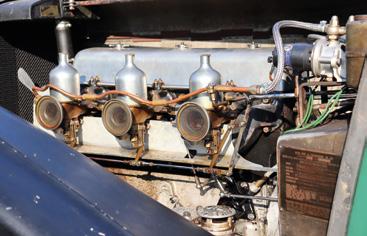

Representing Great Britain at the 1908 Olympics as a power boat racer, he privately funded the development of a Rolls-Royce Silver Ghost Armoured Car whilst on active service during World War One. A close friend of Sir Winston Churchill, Bend’Or had a private railway line for commuting between his fifty-four bedroom family seat, Eaton Hall in Cheshire, and a London property empire which encompassed much of Mayfair and Belgravia. The owner of a four-mast sailing ship ‘The Flying Cloud’ and an extravagant steam yacht ‘The Cutty Sark’, Grosvenor was a frequent visitor to Monte Carlo where he met Gabrielle ‘Coco’ Chanel during 1923. The two embarked upon an affair which lasted into the next decade with the legendary fashion designer commenting thus: ‘wealth of such magnitude ceases to be vulgar. It is beyond all envy and assumes the proportions of a catastrophe. Moreover, I say it because wealth makes Westminster the last representative of a departed civilization’. Just a drop in an ocean of playthings, the Speed 20SB was only retained for fifteen months. Thereafter, ‘AYN 15’ is known to have belonged to W.M. Anderson Esq of Rhysnant Hall, R.M.R. Davies Esq of Swansea, A. Davies Esq of Penrith and L.V. Halliwell Esq of New Earswick before entering the current family ownership in 1961 by which time its Black paintwork had been augmented with Green side panels. Renowned in Alvis Owners’ Club circles for the length of time he owned the ‘Flatback’, the vendor’s late father chose to conserve rather than restore it. To this end, the original BTH magneto was refurbished by D.H. Day (1973), the gearbox refreshed (1974) and the radiator renewed courtesy
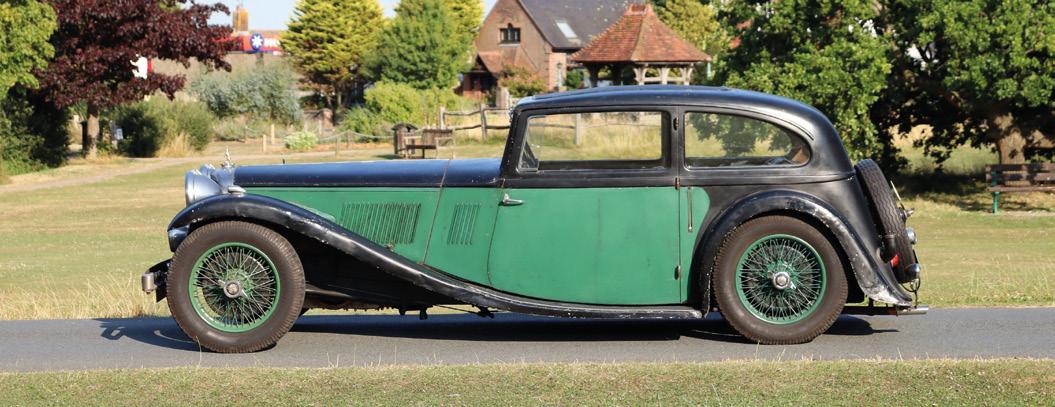
of Great Western Radiators / Motor Metalcraft (1980). Keith Taylor of Tectus Engineering thoroughly overhauled the factory-fitted straight-six engine using a brand-new crankshaft made by Farndon Engineering (1991-1993). Idle for a few years prior to being inherited by the seller, the Speed 20SB was entrusted to MCI Ltd of Blackburn for light recommissioning during 2020. While, the next year saw Tudor Wheels Ltd recondition the rear wheels and fit new tyres; the clutch relined and the engine tuned (carburettors balanced, ignition timing adjusted etc) by former Crosthwaite & Gardiner engineer John Moore.
Starting readily and running well during our recent photography session, this wonderful Post Vintage Thoroughbred is coming to market for the first time in sixty-one years because the vendor finds himself far too aware of its value, history and unique state of preservation whenever he drives it. The plan is to replace ‘AYN 15’ with a smaller, less precious, four-cylinder Alvis and transfer across the replica hare mascot which the seller bought his father as a birthday present many moons ago. Surely a worthy entrant in the preservation class of any world class concours event and, dare we say it, a ‘must have’ for the true Alvis aficionado, this most special of all the ‘Flatbacks’ is worthy of close inspection. Offered for sale with V5C Registration Document, continuation buff logbook, copy Alvis Car Record and numerous bills / invoices.


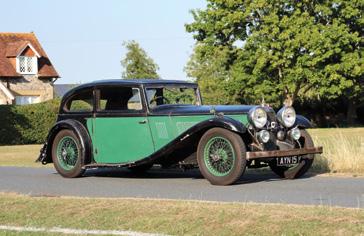

Reg
The Swallow Doretti was built by Swallow Coachbuilding Company of Walsall. The name Swallow was purchased from Jaguar just after the second world war. The Swallow Doretti was a sports car introduced in 1954 and was designed by Frank Rainbow. His design was based on the running gear of a Triumph TR2 and was offered only in convertible form. The car was powered by the Standard Triumph 90 bhp four-cylinder engine and drove the rear wheels via a 4-speed gearbox. The chassis was Swallow’s own design. Thought by journalists of the time to be a better handling car than the TR2 as the engine was placed further back in the chassis. Just 276 examples were built before production ceased in 1955.
First registered in September 1954, it was put into storage for some 20 years and did not emerge again until the early noughties. The car was acquired in 2016 by a retired engineer who then restored. The car was found to have the incorrect engine and thus necessitated the acquisition of a correct TR2 engine. At the same time, the opportunity was taken to include a number of performance-enhancing upgrades, increasing the engine capacity to 2,138cc. A ‘fast road’ camshaft was employed plus hardened valve seats. A very rare Le Mans inlet manifold was found, enabling SU 1 ¾ HS6 carburettors to be fitted to the low port cylinder head. The transmission underwent a complete overhaul.


During the restoration, major items were renewed, including a new hi-torque starter motor, new fuel pump and a new hydraulic master cylinder. The car was totally rewired. The wire wheels were rebuilt with the rear wheels rebuilt in order to achieve a wider track. A new bespoke hood was ordered and the car comes with a tonneau cover and side screens. The car has covered just 500 miles since the rebuild was completed and it is now ready to enjoy. Offered with a collection of invoices, Brown log book and photographs of the restoration.


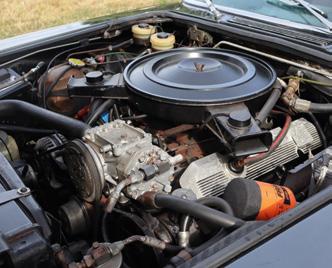

Estimate: £40,000 - £50,000*
Chassis
Introduced at the October 1971 Earls Court Motor Show, the Jensen Interceptor III shared the same striking Vignale-penned sheetmetal and advanced tubular-chassis frame as its predecessors, but was readily distinguishable by its cast headlight surrounds, GKN alloy wheels and comprehensively revamped interior. Initially powered by a Chrysler 6.3-litre V8 engine, the model was soon upgraded with an even larger 7.2-litre unit. Boasting Torque-Flite three-speed automatic transmission and four-wheel disc brakes as standard, the 2+2-seater Coupe was both impressively refined and seriously quick. Indeed, the 7.2-litre versions were reputedly capable of 0-60mph in 6.4 seconds and 140mph. The model was bought by celebrities as diverse as Led Zeppelin drummer John Bonham, golfer Peter Butler, British Foreign Secretary Lord Carrington and World Motorcycle Champion Phil Read.
Of the 2,477 Interceptor IIIs made, just 703 were 128-series cars.
Beautifully finished in Gunmetal metallic with original Cherry Red leather upholstery, chassis number 128-4785 displays 53,200 miles which the previous owner warranted. Accruing an average of 8,000 miles per annum up until 1977, the Jensen was then used more sparingly and with only 500 miles to its odometer over the ensuing 9 years. In long term ownership from 1992-2009, `RVT 728L’ appeared on the BBC television programme `Top Gear’ two years into his tenure. Previously fitted with a new Holley four-barrel carburettor and stainless-steel exhaust in recent years, the Jensen has since been thoroughly checked over and treated to a comprehensive automatic gearbox overhaul by Mr Gearbox of Sheffield by a previous owner. The current owner has spent around £3,000 on the Jensen, since its purchase. Work completed, included a new starter motor; replacement alternator; refurbished steering rack and, specifically, 8 hours of work on the brakes, which included new calipers, pads etc. “The brake pedal has always been crunchy.”
The Interceptor pleasingly retains its original `Jensen Car Company Ltd’ tax disc holder, `Jensen Cars Ltd’ rear window sticker and even a period fire extinguisher! Enormous value when compared to period rivals such as the Aston Martin V8 and Iso Grifo, this much loved, low mileage Interceptor is worthy of closer inspection. ‘RVT 728L’ is owned by a BAFTA winning, British theatre and screen actor.
Though launched at the 1991 Geneva Motorshow, many elements of the John Heffernan/Ken Greenley-penned Continental R had been seen at the same Salon back in 1984, when Bentley unveiled their ‘Project 90’ concept. The Continental tag was intended to recall memories of the elegant Bentley Continentals of the ‘50s and ‘60s. The new model was based on the Turbo R floorpan and powered by the same 6.75-litre turbocharged V8 engine, (complete with alloy cylinder heads, Bosch K Motronic fuel injection and digital ignition system), that was believed to produce in the region of 325bhp, though the company never quoted power figures in those days. Whatever, it was sufficient to allow a top speed of 145mph and 0-60mph time of 6.6 seconds. The engine drove through a four-speed GM 4L80-E automatic gearbox. The striking two-door body featured more curvature than other Rolls-Royce and Bentley Saloons of the time. Unlike all others since the S3 of 1965, its body was unique to the marque. The Continental R was produced from 1991 to 2003, during which time just 1,290 examples were made.
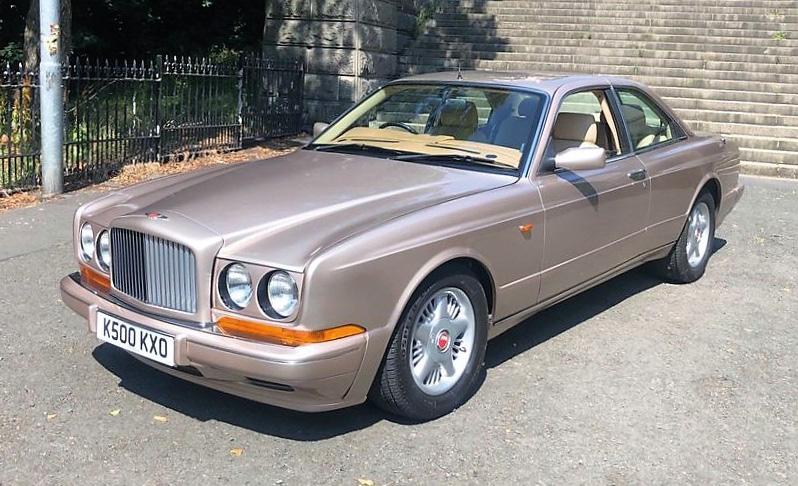
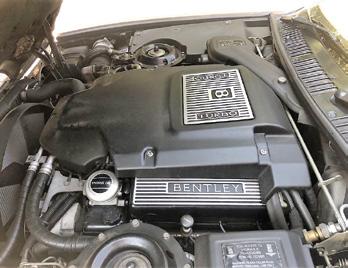
Supplied new via Mead of Burnham to a billionaire fashion mogul turned property magnate at a cost of £188,755.67 on 20th May 1996, this particular example was finished in the decidedly handsome combination of Silica Metallic with Sandstone leather upholstery. Retained by its first owner for a decade, accompanying paperwork indicates that he had it main dealer serviced or fettled at: 889, 4,251, 8,515, 11,830, 14,676, 20,662, 23,595, 27,514, 30,252, 30,562, 33,412, 36,091, 37,153, 38,761, 38,966, 40,490, 40,949, 41,662, 43,199 and 45,087 miles. Changing hands twice thereafter before entering the current (fourth) custodianship in 2019, the Bentley remains highly presentable. Entrusted to M.B. Jarvie Ltd less than 1,000 miles ago the associated bill totalled £1,308.25. Among the nicest Continental Rs we have had the pleasure of offering, ‘K500 KXO’ is offered for sale with V5C Registration Document, history file and fresh MOT certificate.

The Morgan 4/4 was in production for an amazing eighty-three years (1936-2019), a fact that earned both manufacturer and model a place in the Guinness Book of Records. The Malvern Company’s first four-wheeled / four-cylindered design (hence the name), it stayed true to the same tried and tested formula for generations. Unveiled in 1993, the Morgan 4/4 1800 was faster, cleaner and more frugal than many of its predecessors. Based around a box-section ladder-frame chassis equipped with independent ‘sliding pillar’ front suspension, a leaf-sprung ‘live’ rear axle and disc / drum hydraulic brakes, the aluminium over ash construction of its bodywork contributed towards a commendably low kerb weight (circa 868kg). Embracing the marque tradition of using proprietary running gear, the newcomer was powered by a Ford-sourced 1796cc four-cylinder ‘Zetec’ engine (complete with fuel-injection and double-overhead camshafts) allied to five-speed manual transmission. Impractical yet beguiling, the 4/4 1800 sported a basic interior, minimal luggage space and potentially argumentative hood offset by a singularly involving driving experience and vivid acceleration.
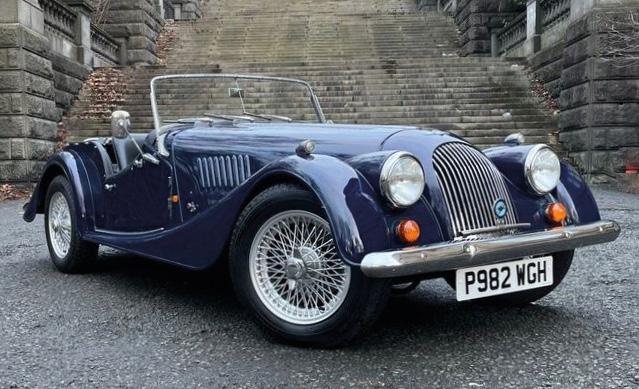
Ordered through Wykehams Ltd of London in late November 1995 but not delivered until April 1997, ‘P982 WGH’ was specified with a galvanised chassis, Indigo Blue paintwork, Black upholstery, badge bar, map reading light, rustproofing and luggage rack. Serviced at 1,475, 5,936, 12,672, 18,271, 22,490, 23,621, 25,152 and 26,127 miles, the 26,700 currently shown by the odometer is warranted to represent the total covered from new. Dry stored from December 2002 – February 2014 and again between December 2015 – January 2021, the two-seater is summed up by the seller as ‘a nice, clean, low mileage example’. Despatched to Bell & Colvill in March 2021, a month before it was acquired by its current (third) registered keeper, this appealing 4/4 is offered for sale with V5C Registration Document, stamped service book, sundry paperwork and fresh MOT certificate.


Unveiled in prototype form at the 1954 New York Motor Show, the Mercedes-Benz 190 SL was a ground-breaking design. Far more civilised than many contemporary sports cars, its ethos foreshadowed that of the ‘personal luxury cars’ which dominated the American market the following decade. Featuring a monocoque bodyshell, wind-up windows, snug fitting soft-top and all-round independent suspension years before the likes of Jaguar, Austin-Healey, MG and Triumph caught up, the newcomer was powered by a 1.9 litre SOHC four-cylinder engine allied to four-speed, all synchromesh manual transmission which endowed it with a 107mph top speed. The 190 SL’s rear suspension might have been derived from that of Mercedes-Benz’s all-conquering W196 Grand Prix cars but it was the Convertible’s styling that really grabbed buyers’ attention. Second fiddle to the 300 SL (W198) Roadster or not, the 190 SL (W121) was still bewitchingly pretty. Only in production from 1955 – 1963 during which time some 25,881 examples were made, the model’s popularity has been perpetuated by appearances in hundreds of films, advertisements, pop videos and even on the pages of Playboy magazine. A true 1950s icon, its appeal remains strong today.

The Mercedes-Benz 190SL offered here was originally delivered to the United Kingdom in March 1960. Being a rare, original right-hand drive car, it is finished in a striking, period correct Mercedes Grey with a Red leather interior and matching hood. In May 1988 the car was acquired by a Mr L. Campbell from Boars Hill, Oxfordshire who kept the car until September 2009. He then sold the 190SL to Mr J.M. Meredith from Penarth, Wales. Under his ownership, the roadster was meticulously maintained to a very high standard, as the collection of invoices on file will attest. However, for the current vendor nothing but the best will do, so after acquisition of the Mercedes in July 2019, it was decided to subject the car to an extensive and costly restoration by Classic & Sportscar Centre of Malton, North Yorkshire. The bodyshell was stripped back to bare metal and carefully rebuilt, refinished and repainted to almost better than factory specification. This same approach was also used for the rebuild of the engine, transmission, suspension and the reupholstering of the interior and hood. The extensive photographic record together with the supporting invoices clearly shows the thoroughness of the entire project, the cost of which came to well over £95,000! The car comes with all tools, the aforementioned restoration invoices and photographs, and a thick folder containing invoices, old and current V5c and MOTs dating back to 1973.

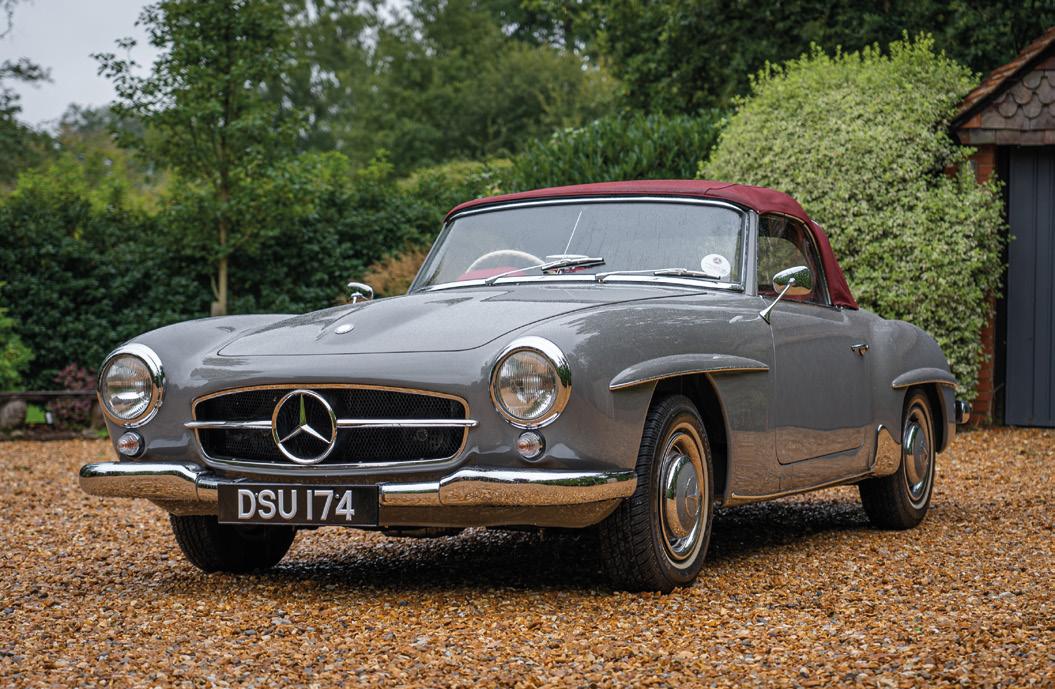
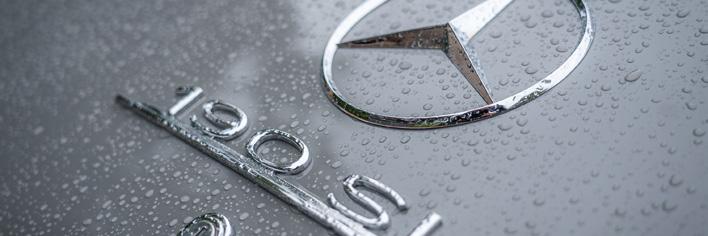

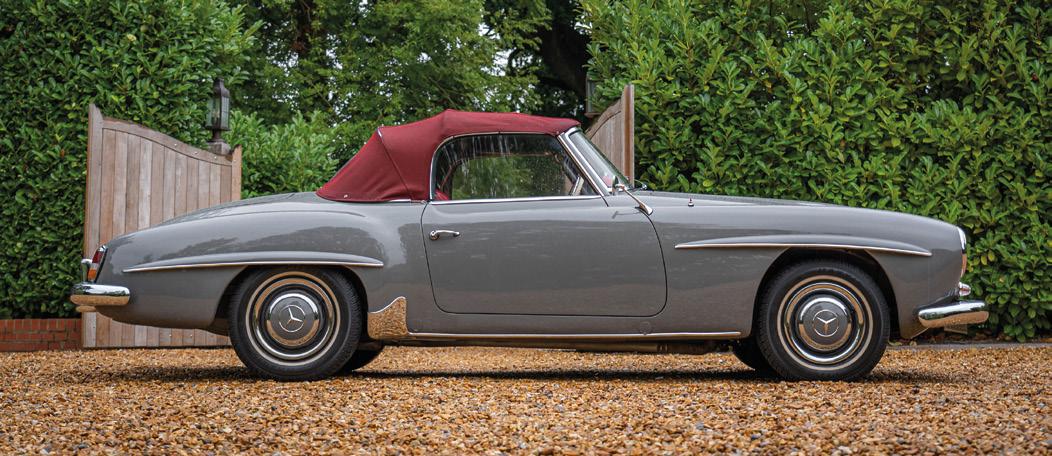



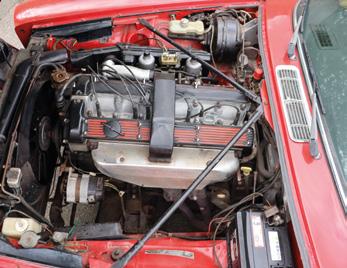
Chassis No: 2H2081BW
The Daimler Sovereign was a name applied to a sequence of luxury cars built by Jaguar but carrying the Daimler badge between 1966 and 1983 and were based on contemporary Jaguar body shells, chassis and engines. The standard or long wheelbase saloon models were joined later that year by a striking new variant; an elegant pillarless Coupé, all being built on the short-wheelbase chassis with a Black vinyl-covered roof and available with either the 4.2 litre straight-six XK unit or the 5.3 litre, V12. This handsome design retained the saloon’s supple allround independent coil and wishbone suspension, disc brakes and power steering. Performance was predictably strong with both variants reputedly able to exceed 120mph. Rarer than its Jaguar brother, just 1,677 Daimler Sovereign 4.2 Coupés are thought to have been produced by the time production ended in 1978 with 613 built in 1977 and only six in the final year. Chassis number 2H2081BW was supplied new to the United Kingdom, being registered new on the 23rd of February 1977. Fitted with the 4245cc straight-six engine allied to the threespeed automatic transmission, the Daimler is finished in the attractive colour combination of Red with Beige leather interior upholstery, and a Black Everflex roof. The odometer records the mileage at 65,728 miles, which is believed but not warranted, to be genuine. In long-term previous ownership, the Daimler is understood to have been taken off the road in 1997. Remaining off the road until the present day, the Sovereign Coupe is offered for sale running and driving, however, it will require some recommissioning before being pressed into road use. Accompanied by the owner’s and servicing handbook, as well as a V5C document, this is a rare opportunity to purchase one of these stylish three-door Coupes, that were in production for a mere three years.


Estimate: £16,000 - £20,000*
Reg No: 9108 E MOT: Exempt
Chassis No: AV5LCS181381
Introduced in 1956, the A35 replaced the highly successful Austin A30. The name reflected the larger and more powerful 34 hp (25 kW) A-Series inline-four engine, enabling a slightly higher top speed and better acceleration. A slightly easier-tooperate remote-control gear-change was provided. Like the A30, the A35 was offered as a two- or four-door saloon and twodoor “Countryman” estate and also as a van. The latter model continued in production through to 1968. A rare coupe utility (pickup) version was also produced in 1956, with just 477 sold.
According to the vendor this lovely Austin A35 Van is still in its original specification and condition, except for a respray a few years ago to rejuvenate the paintwork. It has not had any welding done and the seals and have not needed replacing. The original engine has been fitted with an unleaded head and the car runs on a full set of SP75 Dunlop cross ply tyres (5 in total).
The Austin comes with a very rare, original green rubber floor mat - water based painted to suit the colour of the van and a history file with pictures of the repaint, invoices, old MOT’s and a current V5. Due to its exceptional condition this A35 Van has won 1st prize several times at the Austin A30-A35 Owners Club
International Rally Commercial Class and 2nd in Supreme Class (all classes of Austins).
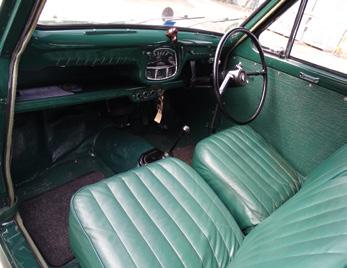
Chassis No:
Introduced in October 1955, the TR3 was indeed a little different from the preceding TR2. Changes to the Standard Vanguard-derived 2-litre engine boosted power from 90 to 95bhp, but the most obvious difference was the adoption of an ‘egg box’ radiator grille. The engine developed 100bhp courtesy of a new cylinder head by mid-1956; then in August, Girling front disc brakes and the stronger Phase III Vanguard rear axle were standardised. Cosmetically revised, but mechanically indistinguishable, the TR3A was phased-in during 1957. New front-end styling featured a full-width grille incorporating sidelights/indicators, and for the first time there were locking door and boot handles plus an improved interior.

Chassis number TS50310 is a home-market, right-hand-drive example, and was registered new in the United Kingdom on the 28th of April 1959. Finished in White (as original) with a complementary Blue interior upholstery, the TR3A is fitted with the 1991cc straight-four engine, allied to the four-speed manual transmission with overdrive. Supplied new to a Colin White Esq. of Burley in Wharfedale, West Yorkshire, the Triumph passed through four further keepers during the 1960s and 1970s, with it thought that the fourth keeper retained the car from the early 1970s until 2010. Purchased by the vendor in 2012 and affectionally nicknamed ‘Viv’, ‘WYF 134’ was then provided a comprehensive restoration between 2012 and 2014.

The chassis and bodywork were completely repaired and repainted, engine overhauled, gearbox and overdrive unit professionally renovated, an interior refresh, and a new wiring loom fitted. Invoices on file total some £12,664 with the new tonneau, soft-top and sidescreens trimmed by Fulcher Coachtrimmers costing £2,434 alone. New wire-wheels and tyres were fitted to complete the restoration. Provided further improvement since the restoration’s conclusion, an aluminium radiator was fitted in 2016 and refreshed starting equipment in 2017. Accompanied by a history file which includes the original ‘Buff’ logbook, a large collection of invoices relating to the restoration and since, and current V5C document.
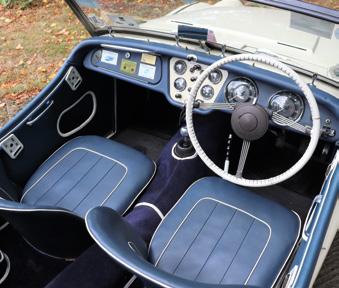
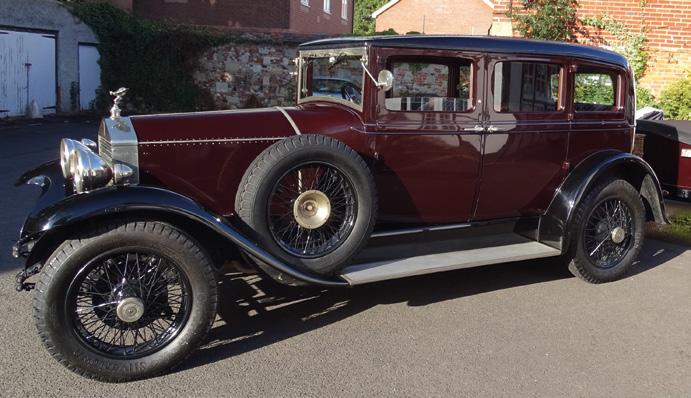


Offered at no reserve with part of the proceeds going to charity
Chassis No: GUK 76
GUK76, a 1926 20hp has resided in Australia all of its life and is affectionately known as ‘Old Marjorie’. She has recently been shipped back to the UK to compete in the 2022 RREC Annual Rally and to show what Australian craftsmanship was like all those years ago. ‘Old Marjorie’ was originally an open tourer but apparently the second owner felt there was too much breeze coming in so in 1930 embarked upon having it changed to a saloon body. The car was given to a Sydney motor coach builder Bryden & McKay, as Smith & Waddington had folded by that time, due to ‘The Great Depression’. It is the only Rolls Royce motorcar Bryden & May ever bodied. It is thought that the body was new old stock that the firm purchased and then put their own embellishments on to it. The interior and fittings are completely original and show a lovely “Art Deco” appearance. In 2021, before coming over to the UK, “Old Marjorie” was judged the most outstanding and authentic Rolls Royce motor car in Australia. It beat all other Rolls Royce and Bentley motor cars in the Australian Concours held in Geelong, Victoria.
She is offered with a custom-made trailer to carry luggage around on long trips, something she’s done many times and without falter. In preparation for the big UK tour she did over 2,500 miles through outback Australia (Sydney to Mildura, onto Broken Hill and then back to Sydney) to prove that she was fit for purpose to send her overseas to tackle the monster journey ahead. Then back over here in the UK she has travelled over 6,500 miles through Ireland, 2 trips up into Scotland and a rally back in Britain. In 2022 at the Annual Rally the car was judged Grand Champion of Great Britain (Class 5) and given the Touring Trophy for cars in that class - 20hp cars. Finished in Maroon and Black with a lovely Dark Red hide interior she still looks immaculate after all those miles.
Launched in 1975, Jaguar’s XJS was never envisaged as a direct replacement for the E-Type. More of a soporific grand tourer than an out-and-out sports car, it was designed to seamlessly blur borders rather than blast down back roads. To this end, it was equipped with automatic transmission as standard. Though, when fed the quoted 295bhp the 5.3 litre V12 engine, still claimed a top speed of 150mph and 0-60mph in less than eight seconds.


With just 32,800 miles from new and supplied new by Heddell and Deeks Motors Ltd (Jaguar) of Dorset, ‘E149 RFX’ is finished in the tasteful and elegant Talisman Silver, complemented with a Deep Blue leather interior and hood, the latter used with the supplied matching tonneau cover. Within the cabin the Jaguar supplied in-car systems are still in place in the form of a radio cassette head unit and an economy/ trip computer along with ‘speed control’.
The convertible ‘cat’ was the subject of a major service and mechanical fettling just last year (2021). New front calipers, new Pirelli tyres, a refurbished back axle, a new stainless steel exhaust system and mechanical fettling at a cost of c.£2,400, is documented in a collection of invoices. Offered with its tool kit, original bookpack, handbooks, service book and a collection of old MOT documents there is also a recent MOT (into August 2023). The vendor currently grades the paintwork, interior, engine and gearbox all as ‘Very Good’.


Estimate: £20,000 - £24,000*
Reg No: 391 GWD MOT: June 2023
Chassis No: 1635660N
Introduced in 1959, the MkII has long been Jaguar’s best-loved sports saloon. Its combination of svelte good looks, strong performance and gentlemen’s club interior has successfully charmed every passing generation. Based around a more sophisticated version of its MkI predecessor’s monocoque bodyshell, equipped with independent coil-and-wishbone front suspension, a Panhard-rod located ‘live’ rear axle and fourwheel disc brakes, the newcomer was powered by a choice of race-bred 2.4 litre, 3.4 litre and 3.8 litre XK DOHC straight-six engines. Although, slower on paper than their range-topping 3.8 litre siblings, the 3.4 litre cars nonetheless boasted some 210bhp and 216lbft of torque, outputs sufficient to ensure a circa 120mph top speed and spirited acceleration (especially when fitted with the desirable four-speed manual plus overdrive gearbox).
Chassis number 1635660N is a desirable UK-supplied example, being registered new in the United Kingdom on the 20th of June 1963. Fitted with the 3442cc straight-six Jaguar engine allied to the four-speed manual transmission with overdrive, the Jaguar is finished in the complementary colour combination of Blue with a matching Grey leather interior upholstery and Blue carpets.
The odometer shows the mileage as c.38,610 miles, with the MkII residing in current registered ownership since 2013. ‘391 GWD’ is understood to boast matching chassis and engine and features an almost complete original toolkit. An older restoration which included a full repaint, the Jaguar has good panel gaps and has been sensibly upgraded with power-assisted steering and an electric fan, ‘391 GWD’ is also fitted with a stainless-steel exhaust system and wire-wheels. Supplied with a history file that contains the operating, maintenance and service handbook; service manual; spare parts catalogue; a collection of previous invoices; a few previous MOT certificates; an MOT certificate until June 2023; and current V5C document.


This particular Austin Sixteen Light Six All-Weather Saloon was originally ordered by K.M. Laursen & Co, who were a Premier Car Dealership in Copenhagen, Denmark. It was first registered on March 12, 1929 and delivered to its first owner, cork manufacturer Kr. Pedersen. The Car Body and Chassis Numbers are dated from around November 1928 and this is confirmed by door handles and other parts all stamped with dates in Nov 1928.

In 1938 the car was re-registered to a grocer, Kr V.A. Michelsen, Amager of Landevej 15 Copenhagen, which was close to the airport. During WWII the car was thankfully stored without damage, but unfortunately, the owner appears to have had been unwell and died in the beginning of the fifties. His widow kept the car and over the following years used it very little. The car was then bought by Count Preben Ahlefeldt-Laurvig Bille, whose family still owns the beautiful Egeskov Castle on the island of Fyn, which dates from 1405. In 1967 the count sold the car to Hans Sørensen in North Seeland who did some unlisted work on the car and who then sold the car to a baker on the small island in Kattegat Læsø, who bought it as an investment. A few years later the Tickford was again sold for long-term ownership to Asbjøm Rømn-Simonsen, who owned the car from 1980 till 1998. In 1998 it was sold to a well-known Irish car collector, Jim Boland. After Mr Boland’s death, his family put the car up for auction in 2018 where the current vendor acquired the Austin.

Since this acquisition a restoration ensued, costing well over £23,000 with invoices for all the works completed being kept on file. The engine was overhauled by Formhall Racing and comes with a “Lifetime Warranty”. The car was also treated to a new clutch, radiator, water pump, starter motor and inlet & exhaust manifolds. According to the vendor, the Austin runs and drives beautifully and is presented in excellent condition, ready to give the next owner years of enjoyment.

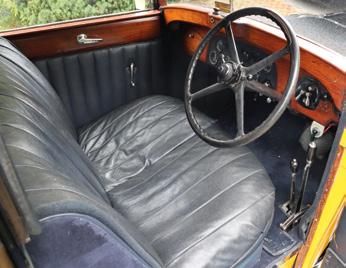
£25,000 - £35,000*
Launched in 1929, the Rolls-Royce 20/25 was powered by a 3669cc OHV straight-six engine allied to four-speed manual transmission. Usefully faster than its 20hp predecessor, the model remained in production until 1936 by which time some 3,827 had been sold. Capable of supporting a wide variety of coachwork, the 20/25hp’s substantial ladder frame chassis was equipped with all-round semi-elliptic leaf-sprung suspension, four-wheel drum brakes and a mechanical servo.

In family ownership for c.60 years and with connections to the ‘Forces Sweetheart’ Dame Vera Lynn, the very elegant and distinctive Black and Yellow 1931 Rolls Royce 20/25 offered, is clothed in coachwork by Thrupp and Maberly Ltd. Utilising chassis GFT34 and engine number Z3J, the 20/25 was registered as a ‘Cabriolet De Ville Closed’. ‘GX 7255’ was originally in the ownership of Captain (later Major-General Sir) Miles Graham, latterly the Tote Board Chairman. The Rolls then passed to the Onsite Flooring Company. Later purchased in 1960 for £120 in part exchange for a Standard Avon Special from a dealer in Paddington, with instalments being £10 per month for six months. In 1962 the car was sold again, in order to purchase a Mini for General Practice use, however, the Rolls was bought back for the same princely sum of £200 when that owner went to Hong Kong in 1965. ‘GFT 34’ was also featured in a Rowland Emett painting.
Icon and entertainer Dame Vera Lynn lived in the same village as the vendor and annually attended the Ditchling Village Fair (Sussex) riding in ‘GX 7255’. She can be seen with the car in a photograph taken at the Village Fair in 1982. A doctor (GP), he could also be found carrying out his rounds of the Ditchling area, in the car. With recent servicing and a mechanical check (there is a photographic capture of the £2,292.47 invoice), ‘GX7255’s’ story is about to continue with a new custodian. Offered with the driver’s handbook, the Autovac handbook, a collection of old MOTs and invoices dating back to the 1960s. Accompanied by an original 1930s ‘Buff’ logbook and a copy of the chassis card record.


Reg
The Pilgrim Speedster is a Beetle-based kit car that, in the words of the business; “....evokes all the elegant lines and cheeky looks of the original cars from the ’50s.” Originally, Porsche created the Speedster at the request of its North American importer, Max Hoffman. He was having great success with the 356 Coupe but was convinced he could rival the coincident British Roadsters if armed with an open variant of the car. The Speedster was born in 1954 by creating a cut-down version of the Cabriolet with all creature comforts removed. The spartan cockpit featured lightweight bucket seats with fixed backrests, and instrumentation was limited to a speedometer and temperature gauge; an instant hit, particularly in Southern California.
This particular homage to the Porsche Speedster, was supplied in kit form, for the original builder to build c.1996. As with many similarly Porsche inspired kits, it is based upon a 1966 Volkswagen Beetle floorpan/chassis. Retaining a typical VW air-cooled 1600cc engine (similar in design to the Porsche 356/Speedster Boxer engine) and 4-speed gearbox, as in this case, any Speedster evocation offers better performance due to the power-to-weight ratio. ‘JNJ 525D’ car rides on Porsche 356 replica wheels painted in Cream. Inside there is a Cream carpet with Red piping and complementing are a Red dash top and period-style Red bucket seats. An appropriate threespoke sports steering wheel finishes off the interior well. Nicely detailed with appropriate Gold badging which works well with the Cream paint and has a smart appearance. On the HPI report, the car is stated as a 1966 Volkswagen; the original donor chassis. The Pilgrim Speedster is offered with the current V5C Registration Document.



In production for twenty-five years (between 1971 and 1996), the Rolls-Royce Corniche Drophead came to epitomize luxury openair motoring. An accepted accoutrement alongside the private jet and crewed yacht for those with a suitably transcontinental lifestyle, the model boasted an extravagantly sumptuous interior and notably hushed drivetrain. Named after a French region synonymous with gently winding roads and breathtaking scenery, it was powered by a tuned version of Crewe’s staple 6750cc V8 engine mated to automatic transmission. Featuring firmer springs, thicker anti-roll bars and revised steering geometry, the drophead proved a more satisfying drive than its humbler saloon car siblings. Though, the presence of olio-pneumatic self-levelling rear suspension and a plethora of electric motors ensured that it remained a singularly cosseting experience. Visually distinguished by its light alloy wheels, the Corniche III was launched in 1989. Fettled by in-house coachbuilder Mulliner Park Ward’s finest craftsmen, the newcomer benefited from the same split level air-conditioning, power assisted rack and pinion steering, Bosch fuel injection, ABS brakes, aluminium radiator and external oil cooler etc as its predecessor. Only made between 1989 and 1992 during which time just 452 are thought to have left the Crewe factory, the Corniche III blended rarity and elegance in equal measure.

Although registered to different individuals and companies over time, this handsome Rolls-Royce Corniche III Convertible has, to all intents and purposes, been in single family ownership from new. Finished in the gorgeous combination of Rhapsody Blue metallic matched to Blue-piped Magnolia leather upholstery, it cost some £126,013.41 to extract from the showroom; an even more significant sum thirty-two years ago. Covering an average of just 2,700 miles per annum, the Corniche III currently displays 86,500 miles to its odometer. Said to have been ‘well maintained over the years’, there are two files accompanying the car containing a substantial amount of historic paperwork including details on the extensive service history plus old MOT certificates and invoices.
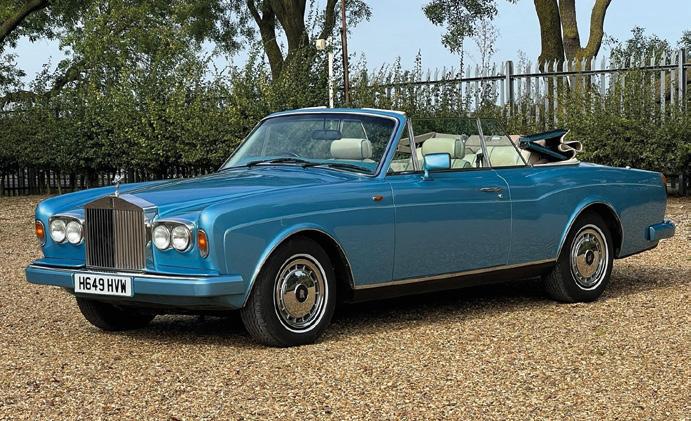
Triumphantly unveiled at the 1961 Geneva Motor Show, the Jaguar E-Type created a furore thanks to its supercar performance, stunning looks and modest price tag. Early racing success at the hands of Graham Hill and Roy Salvadori amongst others helped cement the newcomer’s reputation. Built as a monocoque with an engine-cradling front sub-frame, the E-Type’s combination of all round independent suspension and disc brakes allied to rack-and-pinion steering resulted in excellent road-holding and handling capabilities. The indomitable straight-six XK twin-cam engine supplied abundant power. A continual programme of E-Type development that saw the model metamorphose through three Series. Introduced in 1968, the Series II cars were distinguishable by their revised bumper and light arrangements. Less noticeable was the increased size of the front air intake that in conjunction with dual cooling fans made the Series II better behaved in hot weather and heavy traffic. With its 4235cc engine developing a quoted 265bhp and 283lbft of torque, it was reputedly capable of nearly 150mph and 0-60mph in 7.5 seconds.
In current family ownership for 30 years, this stunning home-market Jaguar E-Type Series II FHC is presented in the ever-popular Opalescent Silver Blue with contrasting Dark Blue leather interior, and features a desirable manual transmission. First despatched on 23 December 1968 to a private individual from Anglesey, ‘KEY 4G’ passed hands to its second owner, Mr Dawson, a garage owner from Derby. Mr Dawson owned the car for some 16 years, in which time he resprayed the car in Black. In 1984, the car would be purchased by a Mr White, also from Derbyshire. White would fully restore the E-Type close to its original specification, giving it the Opalescent Silver Blue paintwork it wears to this day from the Powder Blue it started life as, and would actually go on to meet the current owner and her late husband. 5 years after his purchase, in 1989, the car would be sold to a Mr Collier, living in Yorkshire, who would then go on to sell the car to the late husband of the current owner in 1993.


‘KEY 4G’ has played a pivotal role in its current family, being taken with them to live in Belgium for three years, as well as Germany for five. The car has always been looked after, driven occasionally and stored professionally, but due to lack of use is now offered for sale to find a new home where it will be enjoyed as much as it has already.
‘KEY 4G’ comes accompanied with an impressive history file, which contains a large collection of organised previous invoices In both current ownership and previous ownership. As well as this, previous tax discs dating back to 1989, a number of historical photographs, an impressive collection of previous MOTs for most years dating back as far as 1976, its Heritage Certificate which shows the car as a right-hand drive UK FHC in Light Blue with Dark Blue interior and still retaining its original engine and of course the current UK V5C document, which correctly shows 5 former keepers. Finally, the car comes with a large box of spare parts, which will be ever useful for the new owner. The vendor rates the condition of the bodywork, engine, electrical equipment, paintwork, transmission and interior trim all as ‘Very Good’.


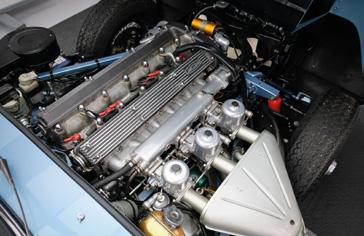

to
Reg
The Jaguar XK150 was the third and final stage in the evolution of the XK concept. Described as the car with grace, space, and pace, this model was launched in May 1957, initially with a choice of fixedhead and drophead coupé bodies. The open two-seater followed nearly a year later. All cars used the XK140 chassis but this time the bodywork was of a much more modern appearance and for the first time featured a one-piece curved windscreen. Inside the vehicle, the walnut veneer on the dashboard and door cappings had been replaced with padded leather trim. Mechanically, it had clearly become a more muscular car. All the production cars were of the “Special Equipment” model, one of the main changes to the XK150 was the Dunlop disc brakes which were used both front and rear as opposed to drums which were fitted to the XK140.
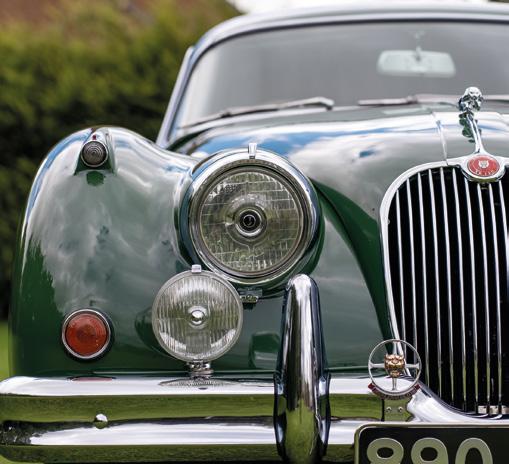
The engine was available in standard tune, or in a higher-performance version on the Special Equipment models. The Standard model had the 3. 4 litre 190 bhp of the earlier car. In 1960 the 220 hp (164 kW; 223 PS) 3. 8 litre engine, fitted in the full-sized luxury MkIX saloon since October 1958 became available. It was tuned to produce up to 265 bhp (198 kW; 269 PS) in “S” models and propel an XK150 to 135 mph (217 km/ h), and from 0–60 mph in around 7. 0 seconds. Overdrive which had been optional also became a standard fitment in 1958.
This car build was completed on 21 April 1958 and dispatched on 2 May 1958 to John B. Clarke Motor Co., Johannesburg, South Africa. It was sold new on 22 July 1958, to Monarch Investments of Waderville, Transvaal. It was one of two cars purchased by two Cape Town architects (partners) at the time (the other being 824396, both cars were built to the same specifications except that 824396 was fully automatic), this car being in the possession of a Mr. Whitehead. Around about 1960, the car was sold to his nephew, also Mr. Whitehead. The car is fitted with overdrive. The original paint colour was Pearl Grey with a Light Blue interior. The car eventually transferred to Dennis Cronje of Johannesburg (a senior 747 pilot with South African Airways) who carried out a meticulous restoration, completed during 1993 and 94, also changing the colour from Pearl Grey to Sherwood Green with a Tan interior. The cylinder head was changed to an “S” type triple SU carbs specification. Straight port head serial no. ZA9061-8 (Photos of this restoration are on file). At this time the owner fitted the “S” badges to the car which remain today. While in South Africa, the current vendor purchased the car in November 2008 complete with the original cylinder head (V3679-8) and a spare 3.8 engine (ZA9061-8) from a Jaguar MkIX. The car had a bottom-end respray in June 2009. The Mark IX engine was stripped, machined, high compression pistons fitted, all components balanced, head refurbished (larger valved), and refitted into the car in July 2009. Current engine specification is 3.8S. The original gearbox was also overhauled at the same time. With the works carried out at that time, over £12k was spent on the engine and gearbox (receipts are available).
The car was shipped back to the UK in December 2010. Since then, new wheels and Vredestein classic sport tyres have been fitted. The front suspension, steering components, and brakes both front and back have been refurbished. The car was re-upholstered in 2019 ie. new carpets, bucket seats, and retractable (Jaguar) seat belts were installed. A Motolita steering wheel was fitted at the same time. N. B. The original engine (3.4) serial number V3679-8, complete with matching head and twin carb intake manifold, also the original seats, and steering wheel are included in the sale. The car was professionally tuned by Zul Racing in Derby in May 2016.
Although residing in South Africa for the last 11 years, according to the vendor it is rust-free (never known rust) and runs extremely well. It is in exceptional condition; the paintwork and bright components are all in perfect order. These last 10 years it has been stored in a heated garage and only driven on dry days. The Heritage certificate was produced on 21st July 2009 by Jaguar Daimler Heritage Trust from Production Record Trace Certificate number 30899. Also, the South African Veteran & Vintage Association Dating Certificate from 1994 is on file.

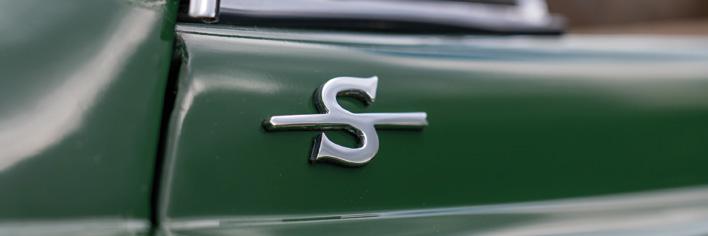



£30,000 - £40,000*
Introduced in 1933, the Gloria model series helped cement Triumph’s reputation as a manufacturer of distinctly sporting motor cars. Based on a sturdy cross-braced chassis equipped with an underslung rear axle, all-round semi-elliptic leaf-sprung suspension and four-wheel hydraulic drum brakes, the newcomers were powered by Coventry Climax designed - but Triumph modified and built - IOE (inlet over exhaust valve) four- and six-cylinder engines. Four-speed gearboxes were fitted as standard and incorporated an ingenious freewheeling mechanism that permitted clutchless gear changing. Able to call upon the styling talents of Frank Warner and Walter Belgrove, the Coventry firm constructed much of its own coachwork (though, Cross & Ellis, Avon and Salmons bodied various drophead coupes). Recruited some two years after his famous Monte Carlo Rally victory aboard an Invicta S-type, Donald Healey wasted little time in furthering Triumph’s competition pedigree. Thus, Gloria variants claimed class victory on both the 1934 and 1935 Monte Carlo Rallies.
Decidedly rakish yet surprisingly practical, the Gloria VitesseTourer made good use of Triumph’s patented system whereby the shape of its doors could be altered from a ‘straight edge’ to a ‘cut away’ profile depending upon the occupants’ wishes. Surprisingly, no other manufacturer worldwide adopted this feature which for the period must have been quite a ‘party piece’ (though, perhaps they were deterred by the associated royalty fees). Priced at £325, the elegant four-seater was a credible rival to similar machines from the likes of Riley, SS, MG and even Aston Martin. Topped by twin Zenith carburettors, its 10.8hp, 1,232cc four-cylinder engine reputedly endowed the Vitesse with a nigh-on 70 mph top speed. However, it was the car’s light, precise steering, powerful brakes and sweet gear change which charmed the contemporary motoring press. The Pre-1940 Triumph Owners’ Club estimates that just 1,100 four-cylinder Glorias of all types were made between August 1935 and July 1937. Of these, just 29 are recorded as having been built as Gloria Vitesse Tourers with only 7 believed surviving.
First registered on the 28th of December 1936, ‘DHT 225’ was acquired by the current vendor’s father in July 1953. After many years of enjoyment, the car was fully restored by him in the late 1990s. Due to ill health, the car was later stored in a dry garage where it has remained for the last fifteen years.

Finished in a striking Light Green over Dark Green with a lovely Red leather interior and Red wire wheels, it is believed that the car is still fitted with the original engine and coachwork. According to the current vendor, the Triumph starts and runs well and comes with all the weather equipment including side screens.
Offered for sale with a 1953 invoice for the purchase of a ‘Triumph Tourer Car’ at the princely sum of £195. a ‘Buff’ log book together with a current V5C, an original owner’s manual and a big collection of spare parts. These include, but are not limited to, a 4 cylinder 10.5hp Coventry Climax engine No. 12/1856, a second Coventry Climax engine number 95495, a gearbox, fuel pumps, starter motor and water pumps. A true time warp with a lovely ownership history, this very rare post-vintage thoroughbred is potentially eligible for a host of VSCC and Pre-1940 Triumph Owner’s Club events. A wonderful motor car, it is a ‘must see’ for those who appreciate originality and character.


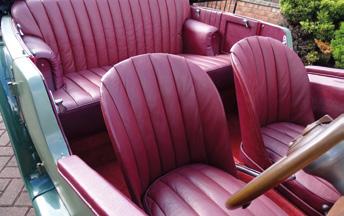



Launched in 1965, the Rolls-Royce Silver Shadow was a bold departure for the Crewe company. Their first monocoque design, it also benefited from olio-pneumatic rear suspension, power disc brakes and GM’s silken 400 series automatic gearbox (though, the latter was not adopted until 1968). Such ‘new technology’ did not encroach on the luxurious interior with its sumptuous leather hides, rich wood veneers and deep lambswool carpets. Performance from the smooth 6,230cc V8 engine (upgraded to 6750cc in 1970) was assured, the car wafting forward on a seemingly unstoppable wave of torque. Still immensely cosseting to drive, Shadows offer a genuinely different ownership experience to their mass-produced peers.
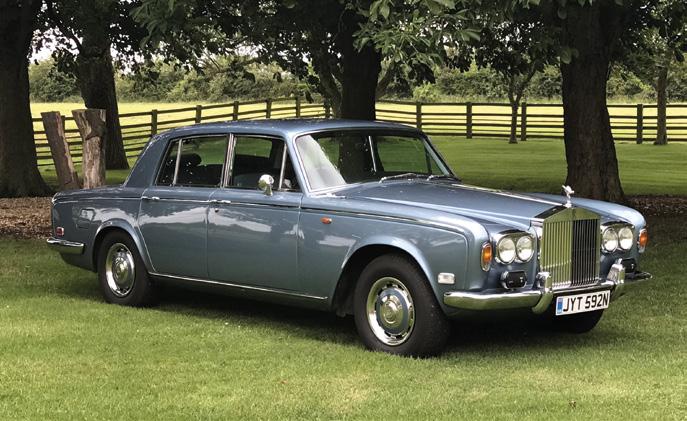

‘SRH 20991’, a wonderfully original and late Series I Silver Shadow, was delivered on the 17th of March 1975 to the Collier family, where it is believed the car was almost exclusively chauffeur driven. It was later sold to the family secretary before being purchased by the previous owner in 2014. Under his ownership the Rolls-Royce underwent a full brake overhaul. Bought by the current vendor in September 2017 with only 36,922 miles on the clock, the car was subjected to a full service, a new water pump, battery and belts. The engine and radiator were backflushed, the entire underside of the car and the inside of the chrome bumpers were Waxoyled and new Avon tyres were fitted. Finished in a striking Caribbean Blue with a Light Blue Connolly Vaumol hide interior this late Shadow I is one of the nicest examples we’ve seen in a very long time.
Having covered an incredible and documented 38,000 miles in the hands of just five owners, this Rolls-Royce comes with its original and complete toolkit, and a thick history file containing invoices, old V5s and MOTs dating back to 1980. Excitingly, the original handbook folder is also still with the car, comprising the handbook, a service handbook, all instructions for the original Blaupunkt radio and even the instruction insert for the heating & air conditioning system, together with a period Jack Barclay customer survey!
Estimate: £25,000 - £30,000*
Reg
Chassis
Introduced in 1933, the Lynx Tourer had much in common with its similarly rakish and elegant Kestrel Saloon sibling. Notably low-slung, both were four-seaters that placed their occupants between the front and rear axles. Powered by a ‘sports’ version of the Coventry marque’s advanced ‘twin-cam’ four-cylinder 1087cc engine mated to four-speed manual transmission, the pair enjoyed a level of performance that belied their 9hp tax rating. Based around a ladder-frame chassis equipped with all round semi-elliptic leaf-sprung suspension and bias-adjustable drum brakes, they were known for their crisp handling too.


Recently repatriated to the UK, ‘AXR 525’ is offered finished in a vivid Blue with a Black full leather interior. A 1934 Riley 9 Lynx Tourer, from the second year of production, the car hides its 88 years incredibly well. The car has lived part of its life in South Africa where the climate appears to have preserved both its paint, wood, bodywork and interior remarkably well, and evidently a testament to the level of care and attention given to the car by its previous owner. The Lynx Tourer comes with a UK V5C.
During the car’s residence with the vendor, we are told that it has been given an inspection by his restoration team. A ‘full’ service, carburettors rebuilt, rear lights and wiring were replaced, as well as a small repair carried out to its folding soft top roof. Additionally, the brakes have had some mechanical fettling, with adjustment all around and road tested on several occasions by the vendor. The gearbox is described as working smoothly, and the engine runs evenly and is said to be balanced through the revs. This is an attractive example of the 9 Lynx Tourer built by Riley which still wears its original brass chassis plate on the top of the firewall. A pre-war classic that would be a beautiful addition to an existing collection or as a single pride and joy for an enthusiast owner.
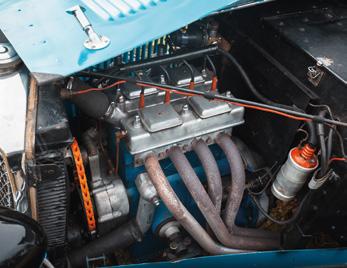
The Pontiac Series 603 for 1934 embodied a bold step forward in performance for this enduring GM marquee. New knee-action suspension, improved induction and a new high-compression head yielded noteworthy power gains while maintaining admirable gas mileage at 19mpg or better, from the Straight 8 223ci engine mated to 3-speed manual transmission. The roomier Fisher body trimmed with features typically reserved for the more upscale Buicks, LaSalles and Cadillacs made the 603 a formidable mid-market competitor. Styling was unmistakably Pontiac, characterized by paint and trim schemes that were tastefully inspired by Native American heritage and homeland.
This example of the rarely-seen Pontiac ‘8’ Series 603 cabriolet is a previous show winner and has been the subject of an extensive restoration. Clad in ‘standard’ trim, distinguished by the Native American Brave hood mascot, this example has a show quality appearance from bumper-to-bumper. Paintwork is a handsome clothing of Douglas Green with Black wings, that presents as almost flawless. Deep chrome Pontiac brightwork is polished to a deep lustre.
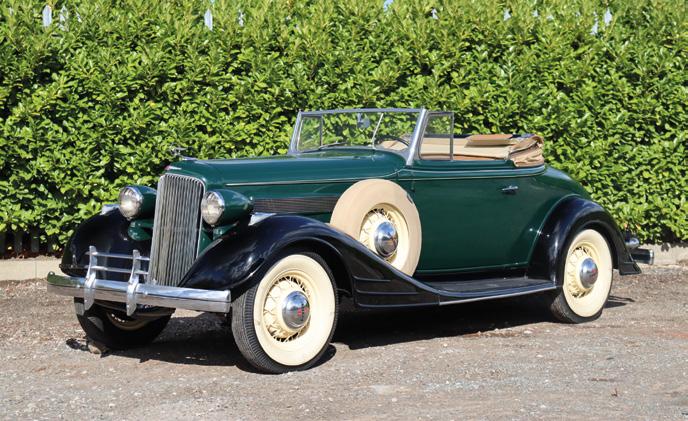
Period features, such as the ornate dashboard and accompanying instrumentation are all in excellent condition. The recently restored interior upholstery in Maple Brown leather, contrasts perfectly with the exterior paint scheme. A Pontiac 603 was even chosen as the official pace-car for the Indianapolis 500 in 1934, so this is a wonderful example of 1930s automotive Americana and a potential centrepiece for any Pre-War American car collector. Offered with the US Texas title with UK duty paid and a NOVA reference number present.


Estimate: £22,000 - £26,000*
The third generation SL (R107) was launched in 1971, initially with just a 3.5-litre engine (350SL) mated to a four-speed automatic transmission. The car featured a two-door monocoque bodyshell with independent suspension and disc brakes all-round. Over its phenomenal 18-year reign, the R107 range was powered by eight different engines - two sizes of straight-six and six versions of Mercedes-Benz’s silky smooth V8.

For 1986, Mercedes-Benz produced its most powerful SL of the decade in the form of the V8 powered 560 SL. The car was the heaviest of the 1971-1989 R107 SLs that Mercedes-Benz produced, but the new 5.5 litre, V8 engine with 227hp did a fine job of mitigating that fact. The top speed was much improved and the car was quicker from a standstill to 60mph by about four full seconds. The engine was much torquier too, which greatly improved the car’s dynamics. Likewise, the car received a new rear suspension and a limited-slip differential to better handle the added torque and power. Mercedes-Benz also added antilock brakes, leather upholstery, an alarm system and an air bag, all of which better suited the car’s $48,000 price tag. The V8powered 560SL was manufactured from 1986 to 1989 and only offered in the US, Japanese and Australian markets.

Displaying just a mere 33,261 recorded and credible miles, this V8 version of the SL. Having previously spent its life living in the warmer climate of the USA, it has come back across ‘the pond’ this year and is therefore left-hand drive. Of course, being an SL, it has the benefit of both hard and soft tops, useful for all-yearround use in the UK. Offered in White with a Blue leather interior, this example still retains the original Becker Grand Prix radio and all the other refinements of the SL. An original bookpack with handbooks and service book, along with a Carfax print out of previous servicing details, accompany the car plus V5C document.

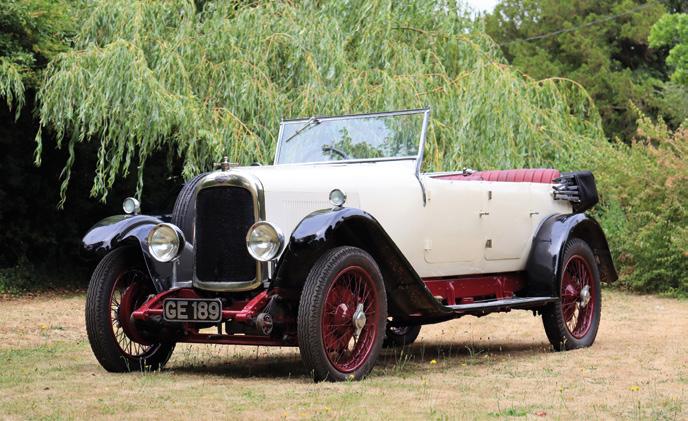
‘GE 189’ was registered new on 2nd April 1928; early history is unknown until it was registered to Louis Walton of Groombridge, Sussex, in January 1957. Passing through one subsequent owner, the car was acquired by the former owner in 1964. Reportedly, the car was then stripped down and the chassis zinc sprayed. During the 1980s, the car spent a period in Canada. It is evident from the car itself that much work was carried out by the former owner, with him stating that the engine had been professionally overhauled and detailed with plating and polishing. The original Zenith carburettor replaced by an SU. With the interior renewed, the exterior has been finished in Old English White on Black with a Maroon chassis and wheels, the hood and side screens have been completely reconditioned. Sundry items include new tonneau cover, separate cockpit cover with storage bag, and hood bag. It is fitted with an adjustable Auster windscreen for the comfort and protection of the rear seat passengers.


‘GE 189’ was re-commissioned following some 12 years off the road during 2008 by the Haynes International Motor Museum at a cost of £1672, spending a further 2 years unused before being purchased by the vendor in 2010. Work carried out by the vendor includes replacing the engine valve rockers with new ones supplied by the Lagonda Club, new brake linings and cables to the rear wheels, new tyres (except the spare), and re-silvering of the lamp reflectors. A major expense was a new radiator honeycomb, and he had the thermostat restored. The fuel system has been completely overhauled by McKenzie Guppy, including the Autovac and the main/reserve tap. The carburettor has also been serviced by the vendor.
It comes with two copies of the handbook – one a later reprint, the other a photocopy of an original. There is a modern jack under the bonnet, but no handle, and tools. Other items include the ‘Buff’ logbook, the V5C document, sundry historical papers and invoices, together with some advertisements taken from magazines of the time.

Estimate: £20,000 - £24,000*
Although Victor Gauntlett had long mooted the idea, it took the arrival of Ford money and TWR Group know-how for a new generation, `small’ Aston Martin to become reality. Unveiled at the March 1993 Geneva Salon, the DB7 utilised a steel semi-monocoque chassis equipped with all-round independent suspension, fourwheel disc brakes, and power-assisted rack-and-pinion steering. Derived from a proven Jaguar unit, the 2+2-seater’s 3239cc DOHC straight-six engine boasted four valves per cylinder, Zytec multipoint fuel injection, and an Eaton supercharger.

Manufactured in 1996, the DB7 Volante offered is a UK-supplied, right-hand drive example, being supplied to the first owner by Grange Aston Martin of Brentwood and first registered in the UK on the 19th of October that year. Fitted with the straight-six 3293cc all-alloy, double-overhead cam, supercharged engine allied to the four-speed automatic transmission, ‘LAZ 8582’ is finished in Mendip Blue Metallic paintwork with Cream leather interior upholstery, and a Blue hood. Entering into current ownership in 2013, the Aston Martin has been in the hands of just three former keepers and has covered a mere c.71,000 miles from new (at the time of consignment).

Offered with a history file which includes the combined owner’s manual and stamped service book which displays seventeen stamps (including the PDI), all of which are from Aston Martin main agents and specialists, and the majority being from main agents such as Grange and Stratstone. Also included in the history file is a collection of invoices, a large selection of previous MOT certificates dating back to 2000, the original purchase invoice from Grange Aston Martin, some tax discs, and a current V5C document.
Benefitting from front and rear brake overhauls with new brake pads in March 2021, the work completed also included some bodywork and paintwork remediation. The vendor currently grades the DB7’s engine, transmission, electrical equipment, and interior trim as ‘Very Good’, and the bodywork and paintwork as ‘Good’.
£450,000
£550,000*

Arguably the greatest piece of product placement in cinematic history, the DB5’s starring role in Goldfinger did more for Aston Martin’s profile than winning the 1959 Le Mans 24-hours or securing that year’s World Sportscar Championship! Unfortunately, the marque’s products were too expensive for its newfound James Bond kudos to translate into a significant sales jump. The DB5’s DNA grew out of the DB4, and though more evolution than revolution was still a significant step forward when it took to the stage in 1963. For a start it was faster than its predecessor. Courtesy of a new 3995cc 282bhp triple carburettor version of Tadek Marek’s masterpiece, it was now capable of almost 150mph and could reach 60mph in a whisker over seven seconds. Initially, there was the option of a five-speed ZF gearbox, but this soon became the standard fit. The car’s general specification had also improved and now included: an alternator in place of the dynamo, reclining seats, pile carpets, electric windows, tinted glass and four silencer exhaust. A total of just 898 DB5s are understood to have been produced at Newport Pagnell before the model was replaced by the altogether larger, Kamm-tailed DB6 in late 1965.
One of just forty-one examples to be finished in Autumn Gold, chassis DB5/1889/R was despatched to Cyril Williams Motors Ltd of Staffordshire on 31st December 1964. Interestingly, Corgi’s first – and most iconic - James Bond 007 DB5 diecast model was also painted Gold (designated C261 it went on to sell 2.7 million copies worldwide). Road registered as ‘DJW 100C’ by Wolverhampton Council on 16th February 1965, the distinctively-hued Aston Martin was specified with ZF five-speed manual transmission, Beige leather upholstery, Selectaride shock absorbers and triple SU carburettors. Entering the current (third) ownership in August 1982 on the day of its second keeper’s wedding (the vendor buying the car to help fund his friend’s nuptials), the four-seater has been affectionately known as ‘Herbie’ ever since. A structural and professional engineer by profession with a wealth of classic car experience gleaned from various Sunbeam, MG, Jaguar, Lancia and Alfa Romeo road cars not to mention racing a Mini Cooper S and Jaguar MKI, the seller has used ‘DJW 100C’ regularly but sparingly over the past four decades with memorable journeys encompassing trips to various UK race meetings, some European travel and two sorties to the Le Mans 24-heures. Kept in the same dehumidified and heated garage alongside various stablemates for the last thirty-five years, the Aston Martin was in good working order by the mid-2000s but looking a little tired cosmetically.
Entrusted to marque specialist Rikki Cann (FIMI) of Shoeburyness, the DB5 was treated to new sills, suspension points, door skins, and all other work required to restore its structural integrity. Evidence of some minor, localised electrolytic corrosion saw the bodywork stripped to bare metal. The interior trim was removed in its entirety and the underside de-rusted, painted and undersealed using POR15 products where applicable. Suitably prepared, the car was repainted Gold by Sandy Coachworks of Hertfordshire during 2010. A return to Rikki Cann’s workshops three years later saw the original factory-fitted engine thoroughly overhauled, converted to unleaded and enlarged to 4.2 litres. It was then dynamometer tested prior to reinstallation. Post paint, the complete dashboard was removed, and all instruments and wiring checked, and replaced as necessary, converting the
car to negative earth. The final mechanical build was carried out by the vendor up to 2016, with final testing and checks made by Rikki Cann. Genuine Aston Martin (mechanical or otherwise) parts were used wherever possible, and included all new suspension and brake components, brake lines, brake and clutch cylinders etc, servos, wheels and tyres, engine ancillaries, electric radiator fan, clutch and stainless steel exhaust etc. In short, the vendor replaced anything he felt was below par with a view to having the four-seater ready in time for his youngest daughter’s prom. The interior has been completely denuded and painted (POR15), and lined with Dynamat soundproofing, along with a refurbished original steering wheel, dashboard, and new carpeting and headlining. The existing seats were kept because of their excellent condition, and to maintain the overall patina of the lovely original beige interior, which has been completely and professionally refurbished using the latest processes for leather ‘Connollising’.
Thought to have covered only 1,000 miles or so since its engine was rejuvenated, ‘DJW 100C’ is being freshly serviced and MOT tested ahead of the auction and currently displays a credible 91,524 miles. A stunning looking machine (and dare we say it a welcome change from ‘me too’ Silver Birch), this fabulous Aston Martin is coming to market for the first time in forty years. ‘DJW 100C’ thus represents a wonderful opportunity to acquire a special DB5 during the 60th Anniversary Year of the James Bond franchise. Offered for sale with V5C Registration Document, Heritage Certificate, flash drive containing photosets of much of the work, two green folders of receipts and other paperwork, workshop and parts manuals, plus a quantity of AMOC magazines.

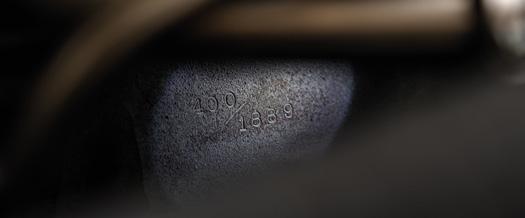






30,000
£26,000
£30,000*
Combining sportscar performance with saloon practicality, the 3.4 litre version of Jaguar’s groundbreaking MkI was introduced in 1957. Sharing the same monocoque bodyshell as its established 2.4 litre sibling, the newcomer was similarly equipped with independent coil and wishbone front suspension and a Panhard rod-located leaf-sprung back axle. However, with some 210bhp and 215lbft of torque on tap, the larger engined model was easily capable of overwhelming its hydraulic drum brakes prompting Jaguar to hurriedly introduce a four-wheel disc option (later standardised). Structurally over-engineered (especially above the waistline), the MkI 3.4 litre lent itself to competition usage with even the standard road going variant being reputedly capable of 120mph. Maintaining a sense of originality despite being stylistically indebted to its MkVII and XK140 siblings, the MkI 3.4 litre remained in production until 1959 by which time some 17,406 are thought to have left the Browns Lane factory.

According to its accompanying Jaguar Daimler Heritage Trust Certificate, this particular example – chassis S992209BW – was built to left-hand drive specification and despatched to Jaguar Cars, New York for distribution on 17th April 1959. A desirable ‘Special Equipment’ model as denoted by its ‘S’ chassis prefix, the sports saloon boasted a 9:1 compression ratio, wire wheels and automatic transmission (complete with ‘Speed Hold’). The original Car Purchase Order on file reveals that the MkI had been ordered by Mrs Margaret Abbot on January 12th 1959 for delivery twelve months later. She had paid $4,446 for the Jaguar and been allowed $1,800 in part-exchange for her existing MkI 2.4. Interestingly, the same document also details an agreement with the supplying dealership, Peter Satori of Santa Barbara Inc, whereby they would pay half the cost of a respray if the factory Black paintwork ‘does not suit’. A California ‘Black Plate’ car, the sports saloon was duly repainted in its current Cotswold Blue livery at six months old. Retained by the Abbot family until 2017, ‘Peter Satori’ stickers still adorn the MkI’s windscreen and driver’s door jamb, while its wooden dashboard carries a plaque for the Santa Barbara Concours d’Elegance.
Repatriated by the vendor and NOVA declared in January 2018, the work he subsequently put into recommissioning the Jaguar convinced him that its current odometer reading of circa 30,000 miles represents the total covered from new. The remarkable condition of the bodywork and lack of heavy wear to the steering, brakes and suspension all added weight to his conviction as did accompanying invoices for work carried out during the 1980s at 22,566 and 26,112 miles. The doors sit well within their apertures and open and close with notable ease. Traces of the original Black paintwork can still be found in places (most notably to the underside of the spare wheel cover). Starting readily and sounding decidedly purposeful thanks to its renewed exhaust system, the MkI 3.4 litre retains its original Black leather upholstery and a period Philips Transistorised radio. Yet to be UK registered (the ‘400 VPX’ number plates visible in the photos are for display purposes only), chassis S992209BW has nevertheless been enjoyed on various road trips. Proof of its soundness and appeal, the sports saloon has been chosen to act as the Course Car at this year’s highly prestigious Goodwood Revival meeting. Surely one of the lowest mileage and most original MkI 3.4 litres left extant?

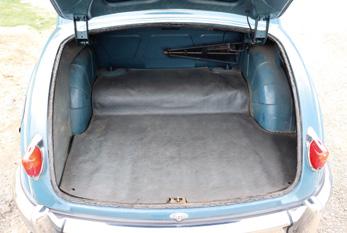




£40,000
£50,000*
Rolls-Royce introduced the 20/25 in 1929 as a successor to the outgoing 20hp model. Although the newcomer was primarily aimed at owner drivers, many examples were nevertheless sold to customers with chauffeurs. The four-speed manual gearbox featured the manufacturer’s traditional right-hand change and was equipped with synchromesh on the top two ratios from 1932 onwards. The substantial chassis sported rigid axles front and rear suspended on semi-elliptic leaf springs. The four-wheeled braking was mechanically servo-assisted. Power came from an enlarged version of the straight-six OHV unit used in the 20hp. Now displacing 3,699cc, it made for swifter acceleration and a higher top speed of up to 75mph. The increased capacity of some 570cc gave useful extra power and allowed coachbuilders of the day to experiment and offer more intricate body styles without impeding performance.
As before, the choice of bodywork for each 20/25 was to the taste of each individual customer, and Freestone & Webb, Gurney Nutting, Park Ward, Thrupp & Maberly, Mulliner and Hooper were among the many coachbuilders selected to clothe these fine motorcars. Usefully faster than its 20hp predecessor, the model remained in production until 1936 by which time some 3,827 had been sold, making it the company’s best-selling model between the wars.
This rare example features particularly handsome Sedanca de Ville coachwork by London-based coachbuilders Thrupp & Maberly. It was originally supplied via Rootes Ltd of Piccadilly to a Mr Hillaby of Bournemouth being first registered in February 1930. The subject of a comprehensive ten-year restoration completed around 1996, it is now finished in Cream & Chocolate with Brown leather to the front compartment and Beige velour to the rear. Our vendor acquired GX 067 from a close friend who had purchased the car from a Sotheby’s auction in 1986 and who then set about restoring it to its former glory. Having seen gentle use since completion, it is now said to be “superb in all aspects” with “excellent” bodywork, paintwork, interior, transmission and engine.
A rare and elegant example of an ‘O’ Series 20/25 with coachwork bearing a close resemblance to GXO 31 (as illustrated in ‘Bird and Hallowes’), GC 2842 is undoubtedly worthy of close inspection.

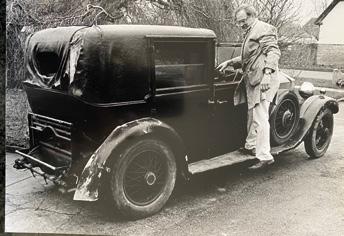
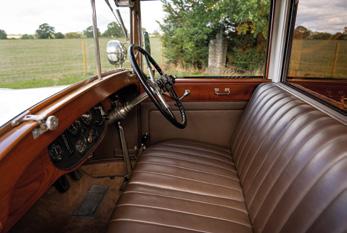

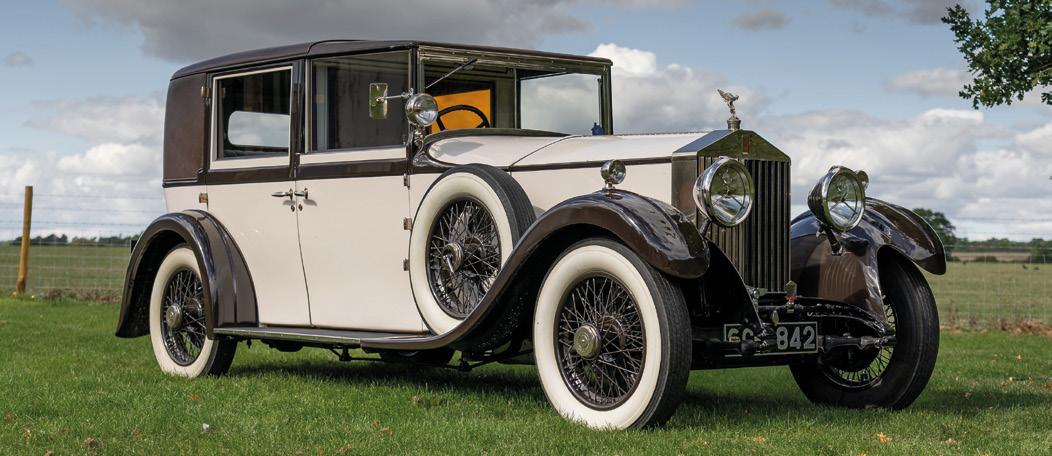
Manufactured on 25 July 1957, this Jaguar XK150 was presented in Mist Grey with contrasting Red interior and dispatched to Jaguar Cars, New York on 14 August that year. Repatriated to the UK in 1991 by its previous owner and subsequently converted to right-hand drive, ‘UXG 570’ was acquired by its current keeper in July 2004. Over the next 18 years, this XK15 would become a well known car in both the Jaguar Enthusiast’s Club and XK Club, participating in rallies across the globe, from the UK and Europe, to Morocco, Budapest and even the Arctic Circle.

Now finished in Maroon, although boasting its original interior, the car benefits from a Jaguar 3.8 Litre straight six engine coupled to a Guy Broad 5-speed gearbox, as well as a switchoperated cooling fan, additional header tank, electronic ignition and Coopercraft brakes to the front wheels. This XK has been subject to a host of works over its current ownership. In 2013, the engine was subject to a major rebuild by Sigma Engineering at a total cost of £4,686. More recently, in 2021, the car was also subject to over 101 hours of work with Rob Noakes including replacement shock absorbers, a reconditioned alternator system, the fuel system updated and relocated to the boot. As well as this, updated anti-roll bars installed with poly bushes, the exhaust system replaced including manifolds, front track rod ends and balls joints replaced, front wheel bearings replaced, rear hubs, half shafts and springs replaced, replacement front and rear discs, pads and braided hoses, the timing checked, carburettors set up and more. Included with the vehicle is a comprehensive history file containing Invoices in current ownership totalling over £63,500, as well as the Jaguar Heritage Certificate, V5 Document, original Moss gearbox and more.



Estimate: £45,000 - £55,000*
Growing up from its first foray as an anemic six-cylinder roadster in 1953, the Corvette matured fast, gaining V8 power in 1955 and packing more muscle (such as a fuel-injected 283ci V8 in 1957), options and ornate styling cues with every year. Arguably the most iconic Corvette, the `Sting Ray’ (or C2) variant was introduced for the 1963 model year. Heavily influenced by GM Design Chief Bill Mitchell’s XP-87 `Sting Ray’ racer not to mention Chevrolet’s striking XP-720 fastback prototype, the newcomer’s styling was primarily credited to Larry Shinoda. A clean sheet design, the C2’s ladder-frame chassis sat on an 8ft 2in wheelbase and featured five cross members, all-round independent suspension (a Corvette first) and large-diameter drum brakes before disc brakes were introduced for the 1965 model year. Initially powered by a ‘small block’ 327ci V8, the Sting Ray was later available with 396ci and 427ci ‘big block’ engines but even the base 327 ci powerplant was rated at 300hp.
Finished in Green, this 1965 C2 Corvette Sting Ray is fitted with an upgraded for the keen drivers’ manual 5-speed gearbox. Displaying c.40,600 recorded miles on the odometer this example is being offered from its current 18 years of long-term ownership, since 2006. Indeed, this C2 Corvette has resided in the UK since 1979. Presenting in Green with a complementing Light Tan interior and soft top, it was repainted some 6 years ago. The car is also offered with a hardtop since built at the St Louis, Missouri factory, and that too is painted in Green to match. Benefitting from some mechanical fettling to the brakes in recent years in 2008 the Vette received a new fuel tank and S/S exhaust followed by a new front bumper in 2009. The Sting Ray has been utilised for classic driving tours by the vendor and it is described as ‘driving well’. ‘FKJ 98C’ is offered with its V5C and a collection of invoices.



The Bentley S1 was unveiled in April 1955. A very different car from its predecessors, it was longer and wider and based on a much stiffer chassis. Though the traditional body-on-chassis construction facilitated the manufacture of special-bodied versions, most were delivered with the standard offering produced by Pressed Steel Ltd, featuring alloy doors, bonnet and boot lid. Powered by the final iteration of the company’s venerable 4.9-litre straight six engine featuring revised cylinder-head porting, power was quoted at 178bhp. As standard, the unit drove through a four-speed automatic gearbox with steering column control. Suspension was independent at the front by wishbones and coil springs and employed a leaf-spring mounted live axle at the rear. Braking was by drums all round. A total of 3,107 examples were produced between 1955 and 1959.
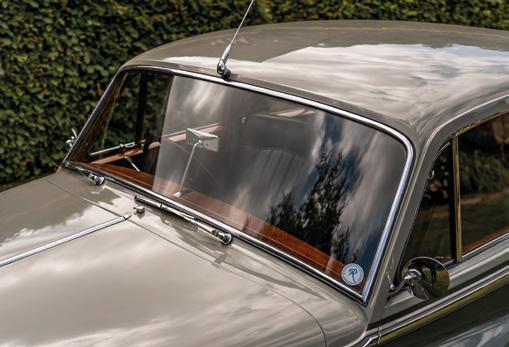
B69GD was delivered on the 13th of April 1959 to its first owner, a Mr H.E. Krueger, through Jack Barclay Ltd of Berkeley Square, London. It was ordered with the John Blatchley-designed Standard Saloon body, finished in Smoke Green with a Green hide interior and the optional electric windows. Exported to the Netherlands in May 1996, the S1 entered into the ownership of David Theobald, a respected Bentley Specialist, who decided to embark on a full nut-and-bolt restoration. He went to great lengths to source original parts from a who’s-who of Bentley & Rolls-Royce Specialists. Going the extra mile, David Theobald also recreated an original specification Continental Touring Kit to accompany the car on continental journeys. This highly desirable and handmade item is also included in the sale.
Having won several prizes at the RREC National Rally Concours, the car is still presented in exceptional condition after having been re-imported into the UK. According to the vendor the S1 is one of the best examples in the world and runs and drives the way it would have done when it left the factory in 1959! The extensive history file which accompanies the car contains several folders with sheaves of invoices from the likes of Jack Barclay, P&A Wood, Ristes Motor Company, Healey Bros, and Fiennes Engineering, together with full folder of photographs documenting the full scope of the restoration, old MOT’s and registration documents, two sets of keys and a current V5C.
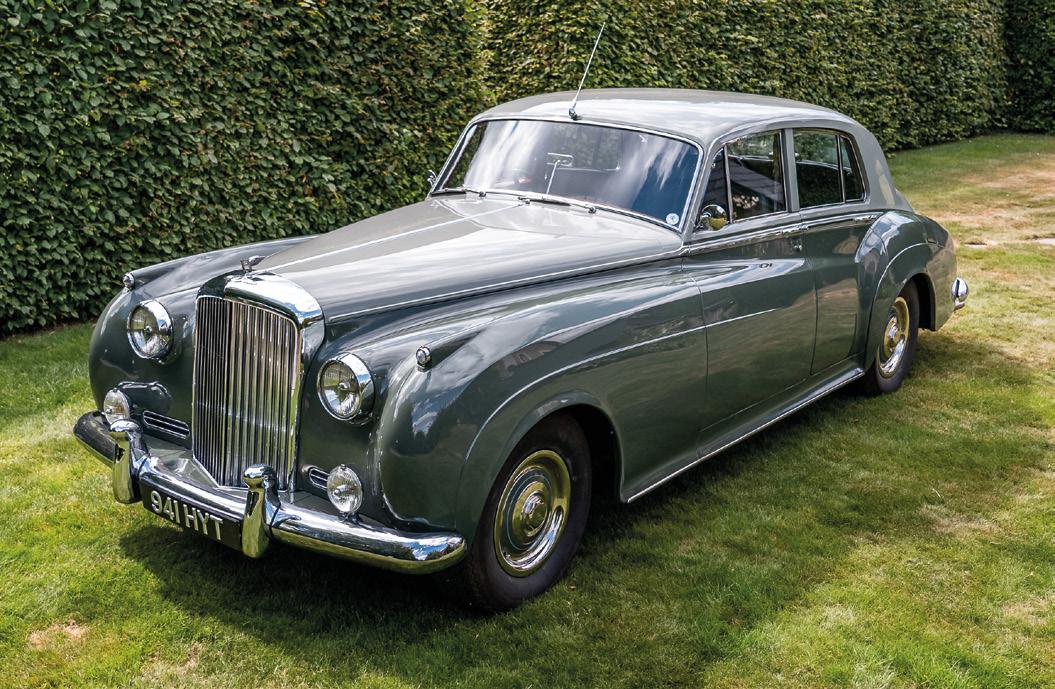



By 1930, ‘tin tops’ had overtaken open tourers in popularity prompting Austin to produce a ‘Box Saloon’ derivative of its immortal Seven. The newcomer featured a steel body bolted to its A-frame chassis. Steering was by worm & wheel and the gutsy 747cc side-valve four-cylinder engine developed some 24bhp at 4,500 rpm - enough to propel the compact four-seater to 60mph for those brave enough to try! Fuel consumption was rated at 35-40 mpg, while braking was by cable operated drums all round. Introduced in 1932, the RN series sat on a six-inch longer wheelbase to the benefit of rear seat passengers. Replaced in 1934 by the more modern Ruby model, these charming Saloons are the final iteration of the original ‘vintage’ design concept. Issued with the Hertfordshire number plate ‘JH 2717’ on August 1st 1932, this delightful RN Saloon had relocated to the King’s Road in Chelsea by the mid-1960s. Apparently found abandoned on an East London building site the following decade, the diminutive ‘tin top’ was rescued by Mr D. Murkett. An upholsterer by profession, as well as a member of the Essex Austin Seven Club, he subsequently treated the RN Saloon to an extensive restoration. Returning to the road during 1985, ‘JH 2717’ was used and enjoyed for the next ten years before being put into dry storage. Purchased by the vendor in 2021 after forty-five years of Murkett family ownership, the four-seater is now running and driving once more. However, further recommissioning would be advisable should reliable / frequent road usage be envisaged. Offered for sale with an Essex Austin Seven Club report valuing it at £12,500, ‘JH 2127’ is also accompanied by a continuation logbook, Seven Workshop parts invoice, post-restoration photos and assorted DVLA correspondence etc.




Estimate: £11,000 - £13,000*
Chassis No: 157117
The Austin Ten with 4-cylinder engine, which was introduced in May 1932 and made in Birmingham to much the same specification until 1947, quickly became Herbert Austin’s top seller during the 1930s. With a three-bearing 21bhp engine of 1.1-litre capacity and 4-speed gearbox with synchromesh from 1934, the mainly saloon model was restyled for the 1935 model year. As with the larger pre-war Austins, the various body styles for the Ten were named after English towns and villages such as the Eton 2-seater, the Ripley Sports Tourer as well as the Sherborne, Lichfield and, as with the car being auctioned here, the Cambridge saloon. By 1939, total production for Tens of all sorts had risen to 161,584 which was sufficient to outsell its 10hp rivals from Morris, Standard and Wolseley. Indeed, Austin remained highly profitable throughout the 1930s with1933 shares oversubscribed eight times and, in 1936, Sir Herbert Austin was created Baron Austin of Longbridge.
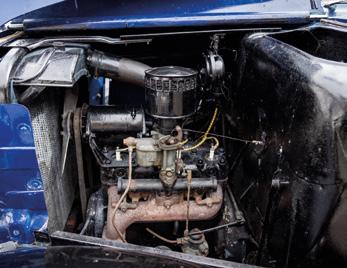
Reputed to have been in single-family ownership for the first 48 years of its life c.4,300 miles recorded, said to be genuine. Restored by the vendor with 12v conversion, electric fuel pump & isolator switch. First registered on 1 November 1938, this Austin 10 Cambridge could possibly be the lowest mileage example extant, since we are advised by the vendor that it has covered just c.4,300 miles and that it remained in single family ownership for the first 48 years of its life.
Finished in Oxford Blue with Black leather, FCD 498 was subject to a comprehensive restoration carried out by the vendor and is currently described as being in “very good” condition as regards its bodywork, paintwork, 10hp engine, 4-speed transmission and interior. Offered with assorted expired MOTs dating back to 1967, V5C and an old-style logbook. Numerous spares accompany the car, which also benefits from a fitted suitcase in the boot, 12v conversion, electric fuel pump and an isolator switch.



Introduced in 1968 as a replacement for the outgoing TR250/TR5 models, the Triumph TR6 proved a strong seller on both sides of the Atlantic. Triumph initially turned to Michelotti for the body revisions - the Italian maestro who styled the TR4/TR5, however, he couldn’t meet their schedule and the changes were ultimately achieved by Karmann. A total of 94,619 TR6s were produced, a mere 8,370 of which were sold on the home market. Crisply styled, its smooth lines and Kamm tail hid a cruciform-braced chassis equipped with all-round independent suspension, disc/drum brakes and rack-and-pinion steering. Powered by a refined 2498cc OHV straight-six engine allied to four-speed plus overdrive manual transmission, it was deceptively fast with contemporary road testers recording 0-60mph in 8.2 seconds and a 121mph top speed. Writing in 1969, Autocar magazine went as far as to comment that “Even if the Austin-Healey 3000 had not been dropped, the TR6 would have taken over as the heman’s sports car in its own right”.
This very pretty-looking TR6 was supplied new in 1971 complete with conversion by SAH Accessories, the tuning shop operated by racing driver Sid A. Hurrell was synonymous with modified Triumphs of the period. Just prior to the vendor’s purchase from a Triumph dealer in 2002, it was treated to an extensive restoration, at which point it gained the following: 40DCOE Weber carburettors, stainless steel exhaust system, overdrive in third and top gears, adjustable gas dampers, uprated front anti-roll bar, five new wire wheels, skid plate, hood and tonneau covers, detachable wind deflector and storage bag. Finished in the pleasing combination of Green bodywork and Tan interior, ‘DUB 548K is currently described by the vendor as having ‘excellent’ bodywork, paintwork, interior trim, six-cylinder engine and manual gearbox. The car comes with a file containing an original handbook, old MOTs, old V5s and the current V5C.

1 of just 3,003 examples manufactured
Estimate: £22,000 - £24,000*
Reg No: LSU 981 MOT: Exempt
Chassis No: TA1734
The first of the famous MG T-series line, the TA was introduced in 1936. Larger, faster and more comfortable than its PB predecessor, the newcomer was powered by an MPJG 1292cc OHV engine that developed some 50bhp @ 4,800rpm. Allied to four-speed manual transmission, it endowed the two-seater with a nigh-on 80mph top speed. Traditionalists may have decried the adoption of a less exotic powerplant, insulating rubber engine mounts and - after a while - synchromesh on 3rd and 4th gears but the TA had accounted for 3,003 sales by the time production ceased in 1939.
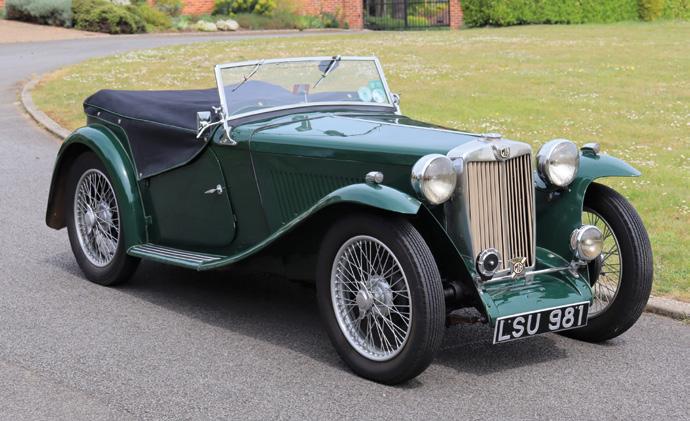
According to the T-Register manufactured on the 21st of September 1937, chassis ‘TA1734’ is finished in Green with complementing Green interior upholstery and Black weather equipment (comprising hood tonneau cover, full-length tonneau cover, soft-top and side screens). Fitted with a replacement 1250cc XPAG four-cylinder engine which is understood to have been fitted by BMC, the TA was subject to a comprehensive body-off restoration during the previous (1989-2006) ownership with some accompanying restoration photographs present.

‘LSU 981’ has benefitted from further improvement work throughout the vendor’s sixteen-year ownership, with the TA benefitting from servicing; the wheel cylinders checked and a new steering wheel (with the original accompanying the car at sale) in 2018; fuel lines in 2017; new starter motor, choke cable, starter switch, speedo cable, and spark plugs in 2015 and a brake and radiator overhaul in 2014, with the majority of the work being completed by DLF Classic Cars of Suffolk. Offered with a history file that contains many invoices from the vendor’s custodianship; previous MOTs dating back to 1996; the aforementioned restoration images; correspondence with previous owners; a reproduction instruction manual and parts catalogue and a current V5C document.

Reg
Chassis
Introduced at the 1959 London Motor Show, the AC Greyhound was closer in price at £3,185 to an Aston Martin DB4 than a Jaguar XK150. Considerably rarer than either, just eighty-three were hand-built before production ceased in 1963. A 2+2-seater featuring a tubular steel chassis, aluminium bodywork, allround independent coil-sprung suspension, front disc brakes and rack and pinion steering, most examples were powered by Bristol straight-six engines (in either 2 litre or 2.2 litre guises) allied to four-speed manual transmission with optional overdrive. Concerns over future engine supply and the demands of the Shelby Cobra contract gave AC little choice but to shelve the Greyhound before its true potential could be realised.

The distinctively registered ‘666 AVY’ has been in current ownership since 2006 and is powered by the desirable 1971cc Bristol 100D2 engine. It is believed that the AC was possibly fitted with a Triumph engine by the factory as an experimental car, as can be seen by the car’s ID plate however factory records show BEF2580 left the factory with the correct Bristol 100D2 engine. Significantly, the AC is car number 80 and therefore that would make it the 3rd to last of just 83 built Greyhounds built. Currently displaying 51,500 miles, ownership of ‘666 AVY’ began with Col. B. Cameron of York, North Yorkshire. ‘VY’ is a registration area code for Leeds, West Yorkshire, which is likely where it was initially distributed to. ‘666 AVY’ was previously in ownership relating to Myers and Burnell Limited of Doncaster, so it has spent some time in the region. It is documented in factory records that the car was once Blue, a colour change to Red occurred in 1999. Over the years the Greyhound has benefitted from improvements such as an engine overhaul, attention to the braking system, a replacement manifold in 2007 and a carburettor overhaul in 2007 was carried out by Gower and Lee Carburettor Specialists of Watford. The brakes have also seen some attention. Amongst the documents with ‘666 AVY’ are a collection of invoices and old MOTs dating back to 1993 plus a copy of the factory records and V5c document.





Estimate: £50,000 - £60,000*
Reg
Last flowering of the separate chassis XK sportscar line, the XK150 was introduced in 1957. A more sophisticated and refined design than its forebears, it benefited from the adoption of four-wheel disc brakes and a more generously proportioned cabin. An effortlessly strong performer, the Jaguar could be had with a choice of 3.4 litre or 3.8 litre DOHC straight-six engines (in various states of tune) allied to either four-speed manual or three-speed automatic transmission. Credited with 210bhp, Special Equipment (SE) 3.4 litre models boasted a B-type cylinder head, wire wheels, front fog lights and a twin exhaust system as standard. Only in production for four years, the total number of ‘home market’ fixed-head coupes has been estimated at just 1,367.
According to its accompanying buff logbook, this particular example was originally finished in White and first registered as ‘4517 W’ to supplying dealer C. Metcalfe Ltd of Sheffield on May 12th, 1960. A desirable ‘Special Equipment’, manual/overdrive model, the Jaguar had migrated to Southend-on-Sea, Essex (via Scotland, Solihull and Cheltenham) by the decade’s end. The earliest bills on file were issued to A. Wiles Esq and date from 1969. Still resident in Essex when D. Davis Esq commissioned marque specialist Flying Cat Engineering to undertake a thorough restoration during late 2002, the XK150 was treated to a bare metal respray (plus associated chassis / floor repairs), rejuvenated brightwork, re-trim, brake overhaul, new fuel tank and replacement exhaust etc. Returning to the road in 2007, the 2+2-seater is said to have become part of a significant, Hertfordshirebased, private collection five years later. Still highly presentable, ‘4517 W’ has seen modest usage since its renovation was completed. Believed but not warranted to have covered some 92,000 miles from new (but only 14,000 of those since 1969), the Jaguar pleasingly retains its original factory-installed engine (V7513-8). Offered for sale with V5C Registration Document and history file, this appealing ‘home market, matching numbers’ XK150 is worthy of close inspection.
Reg
Launched in 1936 as successor to the PB Midget, the TA Midget was an altogether larger and roomier car. Longer in the wheelbase at 94”, the simple chassis followed established Midget practice with semi-elliptic springing all round, though the use of hydraulic dampers at the front and the adoption of Lockheed hydraulic brakes were new departures. Although styled in a manner MG enthusiasts had come to expect, the new two-seater broke with tradition by employing an overhead valve engine instead of the previous overhead-camshaft type.
This exciting and stunning TA is fitted with a bespoke MG Q-type special handcrafted aluminium body featuring Q-type period details like the twin “quick-fill” fuel fillers. The bodies pointed tail is hinged and also removable and houses the battery also allowing for access to the fuel tank, Facet fuel pump and additional in-line fuel filter, this space can also be used for holdall type luggage. The bonnet is doubled hinged allowing for easy access into the engine bay and held firmly in place by leather strapping and bonnet sprung clips. All mounted on a TA chassis which was discovered in Wales. The chassis is immaculate, it was completely refurbished as were the original axles. The car is painted in ‘BRG’ – British Racing Green with Black leather bucket seats and fitted with a distinctive period ‘Bluemels’ steering wheel. The cockpit is well equipped with the gauges that were standard to the Q-type Midget of 1934 with two exceptions, a fully suppressed Jaeger electronic rev counter and an 8 day-24-hour mechanical clock from a Hurricane. The electrical system operates on 12 volts. The car, as well as having an ignition switch, has a period ‘aircraft’ push button start arrangement, and as required for racing, a battery isolator/cut-off switch is mounted on the dashboard. Aero screens are fitted to both the driver and passenger positions.
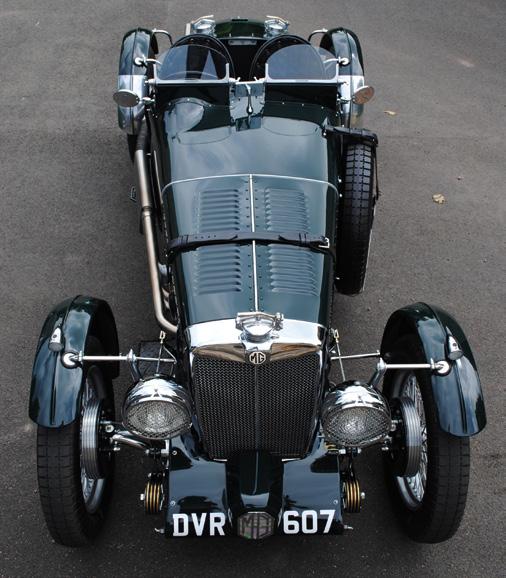
This fully balanced engine is the superior XPAG from the successor TB/TC models. ‘TA1619’ benefits from a complete XPAG engine rebuild by Peter Edney, which included sleeving and boring the pressure-cleaned block to 1,307cc. Fitting of a fast road camshaft with hardened followers, and supercharging the engine with a new Eaton M45 blower, which operates between 4-9psi boost with a single 1 ½” SU carburettor, delivers 91 lb ft torque at 3,400rpm. The car is fitted with an extractor exhaust manifold and connects with a Brooklands regulation side exhaust system, all manufactured in stainless steel. Other noteworthy features include a big-valve cylinder head (unleaded compatible), and spin-on oil filter conversion. The cooling system is aided by an electric fan. A Hi-Gear conversion kit was purchased to accommodate the 5-speed conversion with a Ford Type 9 fully refurbished gearbox and the differential with a 5.125/1 ratio has been comprehensively overhauled. With this package, speeds in excess of 80 MPH are easily achieved. This car is lively, it has an abundance of torque and can easily compete in Track or Hill race events, or just enjoy the thrill of the open roads. The wheels on the car are all new MWS centre laced type WW5772, 48 spoke wheels and fitted with Blockley 4.75/5.00 -19 tyres. The brakes are hydraulic and fitted with new components from C&C Netherlands, the drums are Alfin shrouded for additional cooling. The axles are leaf spring mounted to
the chassis with new Andre Hartford friction shock absorbers on the front and the superior Armstrong hydraulic dampers on the rear.
The car comes with full weather gear in the form of a heavy-duty zipped, split tonneau in Black mohair. Offered with sundry invoices, original ‘Buff’ logbook and Dynacom rolling road test results. No expense has been spared in making this a very exciting car to drive with authentic period Q lines.


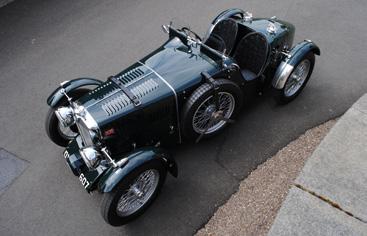

“In 1968, whilst working in Three Mile Cross, Berkshire, I noticed, amongst a large bramble bush, what looked like a car. It was indeed - a 2.2-litre Hadfield Bean Tourer which I learned had crashed into a horse and cart during the wartime blackout in 1944. Simply pulled off the road, it had lain there for 24 years. Eventually, I acquired the car and set about freeing it from its ‘prison’, a massive tangle of vegetation. With the aid of a tractor, we finally had it out in the open air and loaded onto a trailer. It was not surprising that it had seen better days with the bodywork detaching itself from the chassis with great ease! We took it to my home and garage in Newbury and I set about freeing the wheels and acquiring new tyres. That way I could move it and commence work. A daunting challenge and one which I soon realised was beyond my skill level and pocket!
So, with great reluctance, in 1974, I advertised it for sale and very soon a deal was done. Imagine the “interest” of neighbours as a covered lorry arrived and out-stepped two Pearly Kings (or more accurately a King and Queen). As the Bean was being loaded, I persuaded my wife to go up to the bedroom window and to take a photograph as the car departed. I was somewhat upset to see it go, to put it mildly.
In 1986, my wife’s uncle was Treasurer of a village fete in Surrey, not far from where we lived. To support him, we went along and there on the hillside was a row of old cars. Naturally drawn to have a look, imagine my surprise when I recognised the number plate and saw a copy of the photograph that my wife had taken all those years ago resting on the bonnet! The car was beautiful! The owner and restorer having driven down from London for the day. I gently asked for first refusal should he ever wish to sell and he readily agreed. However, this was frustrated by my employer sending me overseas and when I returned 10 years later, the car had been passed on. I tried to keep in touch, learning it remained in very good shape and had been on the Shetland Island car rally in 2008.
The car still held a special place in my memory so in 2015 I made another enquiry as to its whereabouts, only to learn that it was now in Lanarkshire. My correspondent happily agreed to forward my email to the owner and three days later I had a reply to the effect that the car was in great shape, but that he, the owner, was “getting on a bit” and wanted to sell. There and then, and I did “forget” to consult my wife, I bought it back, 41 years after having sold it. A trip to Scotland with a friend, a trailer and a Land Rover brought it home.
I researched what history I could, the earliest records not being available. The Hadfield Bean was only made for two years, and the production run was not high. Thus, and being the only model known to exist, it is rare. In fact, we believe, unique.
The history can only be traced back to 1936 when it was owned by a Londoner which may not be surprising as the Company had a showroom in London. Then came the accident in 1944 and it remaining off the road until 1968. Following the 1974 sale it was restored over the next four years in
Isleworth. In 1991 it found its way to an owner in Hertford and then, in 1995, to an owner in Alcester. Another change of ownership found it in Ayrshire and on to Lanarkshire. Then in April 2015, I acquired the car back again.
The history of the Bean Car company is well covered in the Veteran and Vintage magazine of the Automobile Magazine of October 1983 and the car itself was featured in the Automobile Magazine in November 1983. It reappears in the Automobile Magazine of March 2009 and copies of all of these magazines are included in the sale. Also included are an original Owner’s Handbook, an original sales poster, a complete list of spare parts, a copy of the Bean Bulletin from March 1928 and a ‘Buff’ logbook with the earliest stamp dated January 1943.”
Described as having “excellent” bodywork, pale Yellow / Bronze paintwork, engine, electrics and transmission with “very good” Brown leather interior, this delightful vintage tourer is very much one of a kind.

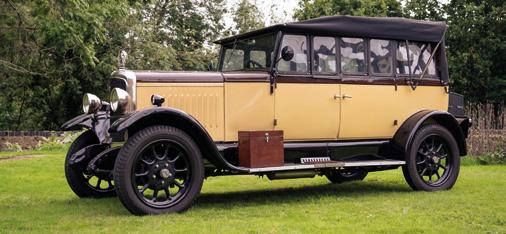

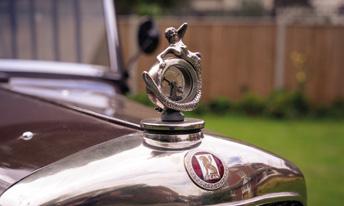

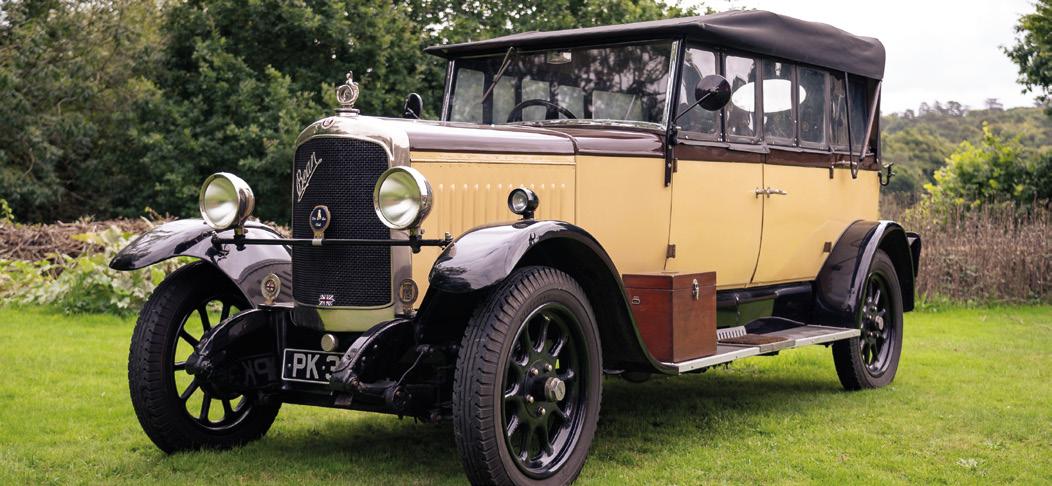
The Morgan Motor Company is probably the oldest independent car company in existence. Morgan made its name with its fearsome brand of three-wheelers and the 4-4 (later 4/4) was its first four-wheeled creation (4-4 signifying four wheels and four cylinders). Launched in 1936, it was initially powered by an 1122cc OISE four-cylinder Coventry Climax engine, but this was superceded in 1939 by a 1267cc Triumph unit driving through a Moss gearbox. It proved deservedly popular and, by 1939, 663 Two-Seater examples had been produced. Like its earlier brethren, the 4-4 was quick to prove its worth in competition contesting such blue riband events as the Tourist Trophy (1937) and Le Mans 24 hours (1938, 1939). Indeed, Prudence Fawcett and her co-driver Geoffrey White won their class and finished 13th overall during the 1938 running of the latter event. Production was stopped at the start of World War II. The production line was started again at the start of peacetime in 1946. The 4/4 then acquired a Standard Motor Company 1290cc engine and Moss gearbox.
Offered here, is a flat radiator Morgan Series 1 and as well as its rarity as a Series 1, it is worth noting that this 1947 example possesses the very rare 4-seat configuration. The subject of a restoration, approximately 6 years ago, the car was gifted a new ash frame. ‘DKG 853’ also benefits from a recently fitted new mohair hood and tonneau cover. Accompanying the Morgan is an extensive history file, which includes the car’s original ‘Buff’ logbook and the equivalent of a Morgan Heritage Certificate, detailing the car’s build details at Morgan’s factory in Malvern, Worcestershire. Offered with an extensive history file plus original ‘Buff’ logbook.

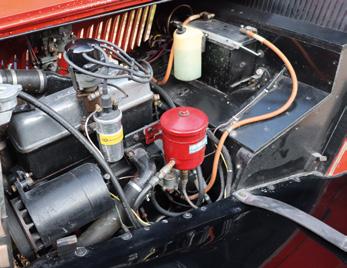
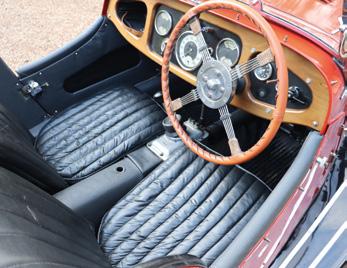

1
Estimate: £24,000
Reg
Introduced for the 1995 model year, the ‘new’ Bentley Turbo R was little changed outwardly, however, its turbocharged 6,750cc V8 engine employed a more sophisticated Zytek EMS3 management system. Developing 385bhp and 553lbft of torque, the unit was somewhat tamed by the adoption of ETAS (Electronic Traction Assistance System) in 1996. Available from autumn 1997 onwards, the 1998 model-year RT borrowed various mechanical features from its Continental T sibling and could thus boast 400bhp and a maximum torque of 590 lb-ft. Visually distinguished by a mesh grille and mesh inserts to its colourcoded bumpers, the turbocharged Bentley could accelerate from 0-60mph in six seconds and attain 155mph flat out. The RT models were fitted with an active ride suspension system, ‘easyentry’ tilt steering wheel, and galvanised zinc coating to the underside. Only 252RTs were produced between 1997 & 1998.

1 of only 252 produced between 1997 & 1998, this Turbo RT LWB model was supplied new by Murray Motor Company of Edinburgh and today ‘R206 DSF’ displays just 43,800 miles from new. Presenting in the beautiful Wild Berry with complementing carpet throughout and contrasting cream leather upholstery and deep red piping and matching leather dashboard top, in fact there is a photographic record of the specification sheet and a copy of the factory records.
Previous attention has been paid to the car from the Rolls Royce and Bentley authorised and historic specialists P & A Wood. In 2019 the Turbo RT was the subject of an extensive service by Veerman Classics at a cost of 5,000 Euros. Last serviced in 2021, this long wheelbase example is offered with the original owner’s handbook and service book and a collection of old MOT certificates. In addition, there are two keys supplied and its original sales invoice for £131,287.45.

Britain has a proud history of special building with everything from Austin Sevens to Bentley MkVIs being given a new lease of life. The process typically involves modifying the donor vehicle’s existing chassis and fitting a lighter, more sporting body. The Hamilton Riley, however, takes things to the next level. Reputedly created by a Riley employee named Mr Hamilton, the two-seater sits atop a multi-tubular steel chassis that is thought to be bespoke. Certainly, it does not correspond to any Riley model we are aware of. If anything, the construction is more like a 1950s sports racer such as a Jaguar C-Type or Aston Martin DB3. The superstructure is made from thinner gauge steel tubing, while the body itself is fabricated from aluminium.
Stylistically, the car resembles nothing so much as a Frazer Nash Targa Florio (at the least from the front). Although the side louvre panels echo those of a Jaguar C-Type, while the blisters above the rear wheels mimic Lister practice. The independent front suspension and rack and pinion steering are seemingly Riley RM-series derived with the leaf-sprung rear axle believed to have come from an AC. Powered by a Riley Pathfinder 2.5 litre ‘twin cam’ four-cylinder engine allied to four-speed manual plus overdrive transmission (presumed to be a Moss ‘box), the Hamilton Riley rides on 16-wire wheels shod with Michelin radial tyres and features drum brakes all-round. The bonnet is held in place with leather straps and the fuel tank accessed via a Monza-style quick release filler cap.


There is some suggestion in the accompanying paperwork that four Hamilton Rileys were completed (it would, after all, seem like an awful lot of effort to go to for a one-off). That said, we have found no trace of any siblings on the internet. The two-seater’s under bonnet ID plate quotes the chassis number of its 1946 Riley RMA donor identity and the engine number for the unit currently installed. It also lists a car number: THR001 which may well signify ‘The Hamilton Riley 001’. Pinning a precise year of manufacture on the Hamilton Riley Special has thwarted us. The Pathfinder was only introduced in 1953 and had the two-seater been completed the following decade then one might perhaps have expected it to carry disc brakes given the sophistication evident in the rest of the design.
Whatever the back story, we believe that ‘THR001’ bears the hallmarks of a professionally conceived and executed Special. Starting readily upon inspection and sounding decidedly rorty thanks to a side exit exhaust, the two-seater is able to accommodate a six-foot plus driver. The car rides better than expected because it underwent a damper set-up programme at the hands of the renowned Dutch firm Reiger Racing Suspension. Not long returned to the UK following time spent in a Continental collection, the Hamilton Riley makes an interesting comparison with the various fibreglass-bodied Jaguar C-Type Evocations we have sold in the past two years. Which would you rather have a potentially unique period machine or a modern facsimile? Offered for sale with continuation ‘Buff’ logbook, V5C Registration Document, Reiger Racing specification sheet and sundry documentation.
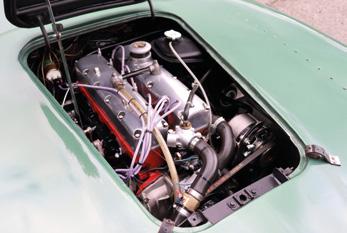



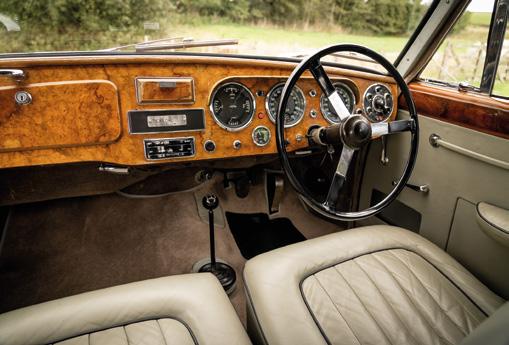
Warranted 36,000 miles from new
The second Lagonda model of the David Brown / Aston Martin era, the DB 3 Litre debuted in 1953. Underpinned by an evolution of its predecessor’s advanced chassis, the newcomer was equipped with all-round independent suspension, servo-assisted four-wheel drum brakes and rack and pinion steering. Shared with the Aston Martin DB 2/4, the Lagonda DB 3 Litre’s straight-six engine featured double overhead camshafts and hemispherical combustion chambers. Rated at 140bhp and 164lbft of torque and allied to four-speed manual transmission, it endowed the four-seater with a near 110mph top speed and spirited acceleration. Initially available in two-door guise only, as a Fixed Head or Drophead Coupe, the range was broadened to include a four-door saloon for 1954. Notable for a host of detail improvements including a floor-mounted gear shift, the MKII version arrived in early 1955. Production continued for another three years, however, a swingingly high purchase price meant that combined DB 3 Litre sales (across Fixed Head, Drophead and Saloon variants) amounted to just 266 cars of which a mere eighty-two are thought to remain intact.

Quite possibly the most original, and perhaps even the lowest mileage, survivor extant, chassis LB290/1/209 was issued with the distinctive number plate ‘SVB 600’ by Croydon Council on 13th December 1957. The DB Lagonda owes its remarkable state of preservation to the Morrow family of Nottingham who cherished it for six decades. Bought by Flight Lieutenant Robert Saunderson Morrow during the early 1960s, the 3 Litre found itself garaged alongside a variety of Alvis, MG and Alfa Romeo models plus a ‘daily driver’ Bentley Continental. A ‘hands-on’ enthusiast, the Flt Lt alternated the usage of his cars such that none accumulated a huge mileage. Correspondence on file from his son, Bob Morrow Jnr, warrants the current odometer reading of 36,000 as representing the total covered from new. Even without his endorsement, the condition of the car itself makes the mileage wholly credible. The stove enamelling to the exhaust manifold is largely intact as is the original paint to the engine. The pedal rubbers show very little wear and the material to the bulkhead / under-bonnet looks similarly well preserved. Although, the real delight is the interior. The carpets have been renewed but the upholstery, wood veneers and headlining have responded beautifully to a thorough clean (with the leather being lightly Connollised).
Finished in the subtle combination of Dark Green over Black, ‘SVB 600’ appears to be free of the electrolytic corrosion which claimed so many of its siblings. Indeed, the floors and sills are remarkably solid. The paintwork is no longer flawless and the brightwork pitted and tarnished in places but the car comes across as ‘all of a piece’. Starting readily and running well during our recent photography session, the DB 3 Litre arguably sounds more like an Aston Martin than a Lagonda! Off the road for some thirty years by the time the Morrow family parted with it in 2016, the Saloon passed into the trade before being bought by the vendor who has spent countless hours recommissioning and reviving it. A true ‘time warp’ even down to its original ‘Hills’ number plates, ‘SVB 600’ exhibits a gentle patina that no restoration could replicate. Offered for sale with V5C Registration Document, MOT certificate valid until August 2023 and history file.
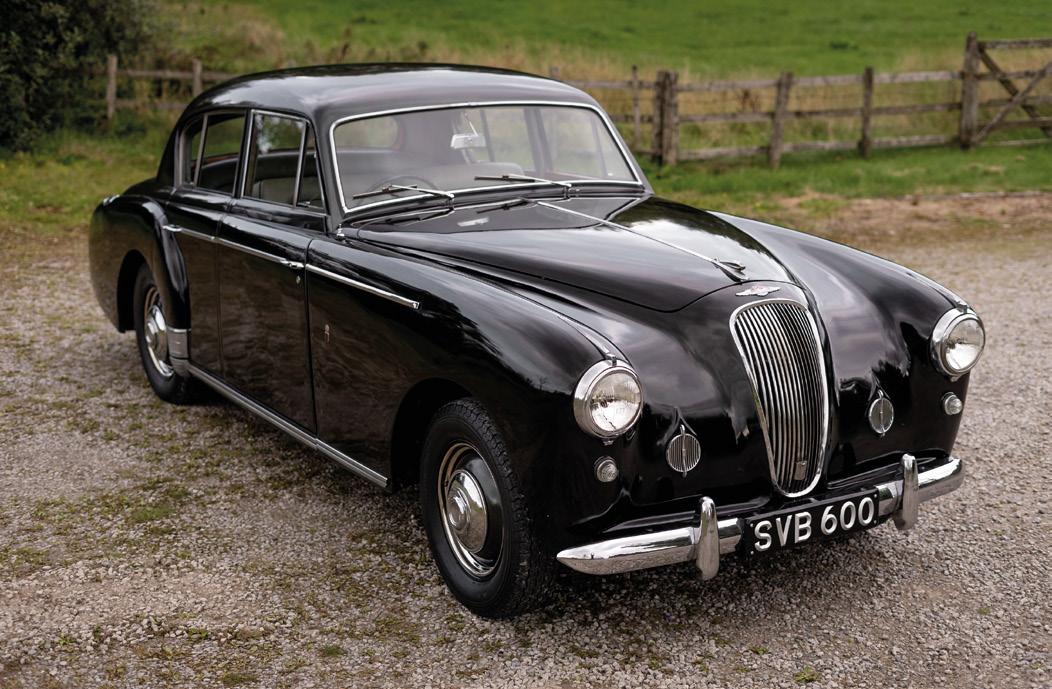
Ex-Sir
Estimate:
Reg
Chassis
Styled by Ian Callum, the Aston Martin DB7 has long been regarded as a modern masterpiece. Priced at circa £80,000 the six-cylinder coupe remained in production until 1999 by which time some 1,578 had been sold.
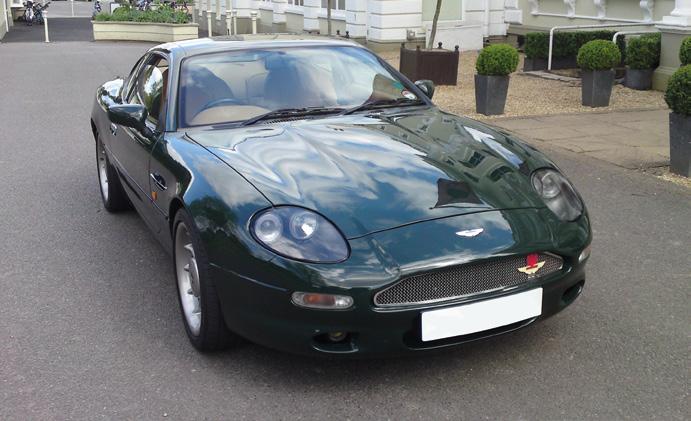

This manual transmission DB7 has covered just c.14,000 miles from new in the hands of two owners, the first being none other than Sir Elton John who acquired it new from HWM Motors of Walton on Thames and subsequently completed some 7,000 miles during his ownership. The enthusiast vendor, a member of the AMOC, purchased the car in 2003 and has covered the remainder. Finished in Rolls-Royce Brewster Green (British Racing Green) with custom Light Tan hide interior as specified by Sir Elton, it features desirable 5-speed manual transmission and boasts an enviable specification including; top of the range Alpine stereo with remote control, 6 stack CD changer in boot with large Alpine V12 amplifier (a non-standard installation to the specification laid down by Sir Elton), Motorola car phone in centre console under arm rest, stainless front mesh grille, heated front and rear screens, heated front seats, fully adjustable electric seats, Aston Martin Stage 1 stainless steel rear exhausts, Aston Martin electric tyre compressor in boot (unused in original bag), Cobra Cat 1 alarm, cruise control, electric aerial, space saver tyre, correctly functioning air-conditioning etc. The jack, spare bulbs and tools are also present and the car comes with two sets of keys. Fitted with matching Bridgestone Potenza S001 tyres in May 2021 that have only covered c.200 miles, the car is offered with an extensive service history and was last serviced at 12,340 miles since when it has covered less than 2,000 miles. This low mileage and pampered DB7, boasting previous celebrity ownership, is accompanied by the original warranty card in Sir Elton’s name along with a copy of its first V5 document. It is offered with a current MOT to May 2023.

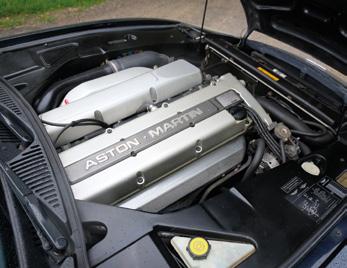

Manual example with just 30,019
Estimate: £20,000 - £24,000*
Reg No: R146 YNB
Chassis
Presented in Mendip Blue with contrasting Cream and Walnut interior, this rare and desirable Aston Martin DB7 i6 features the all-important, and clearly rare, manual gearbox. First registered on 13 November 1997, the car was first delivered to legend footballer Ryan Giggs. Giggs owned the car for just over a year until it was sold to a collector in January of 1999. Here, the car remained in this ownership until ultimately it was to be purchased by its current owner in November of 2017. ‘R146 YNB’ boasts an impressive specification, including air conditioning, cruise control, electrically operated and heated seats and a 6 disc CD interchanger.
Now showing only 30,019 miles on the odometer at time of consignment, ‘R146 YNB’ is offered for sale with a number of previous invoices and MOTs, it’s original owner’s manual which contains 11 stamps – 9 of which being Aston Martin main dealer and the following two from the supplying dealer for the current owner. In addition, this DB7 was recently subject to a major service with Aston Engineering in May of 2021. This was at a total cost of £1468.40. In addition, worth noting is that the headlining was replaced in 2018.

Jaguar
Estimate: £12,000 - £14,000*
Introduced at the 1999 Frankfurt Motor Show, the Bentley Arnage Red Label boasted 835Nm of torque - more than any other production car! Powered by a revised version of the marque’s longserving 6.75-litre V8 (albeit in turbocharged guise) allied to four-speed automatic transmission, the newcomer was reputedly capable of 0-60mph in 5.9 seconds and 155mph. Further benefiting from a stiffer bodyshell, revised suspension and bigger brakes, the luxury sports saloon came with an Alpine sat-nav system and parking sensors as standard. A tangible link to the Crewe-built Bentleys of the 1950s/60s, the last of 2,282 Red Labels was completed in 2005. This Metallic Silver Arnage Red Label has covered just 64,800 miles from new and comes with an extensive Bentley service history which has mostly included main dealer visits. Throughout the last 7 years the ‘V110 WAB’ has been looked after with servicing needs at Hillier Hill Specialists of Olney, indeed the car was last serviced c.400 miles ago. Interior luxury is complemented by Cream leather with grey accents and along with the usual Bentley refinements, there is an Alpine stereo system. Accompanying the car is a trickle charger for keeping the battery conditioned through the colder weather and two sets of keys. The vendor has described the engine, transmission and bodywork as ‘Excellent’ and the interior plus paintwork as ‘Very Good’.


Presenting in a Indigo Blue Metallic exterior paint, matched to a Cream leather interior, the Coupe has the 4.2 V8 engine. The present owner has had the car for five years and is a member of the JEC. Among the work carried out in the upkeep of the XK, services and repairs have been carried out by Jagutek. At the last service at 44,865 miles, the front suspension arms and bushes were replaced, along with the air conditioning compressor and a wheel geometry check. Additionally, in 2018, the car benefitted from a new air conditioning condenser and cooling fans. New front tyres were fitted to the optional Senta alloys in August 2022 and the XK is fitted with parking sensors and sat nav.
Having now covered just 46,500 miles, and with just 3 former keepers from new, the XK was last serviced in 2020, with refreshed gearbox oil in 2018. Its former keepers have demonstrably maintained the car and the current vendor has cleaned and painted the front/rear subframes with Hammerite, and Waxoyled inside all of the box sections.


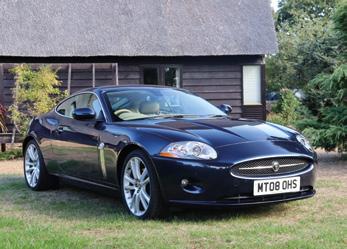
‘MT08 OHS’ is accompanied by its original owner’s wallet, with the handbook and stamped service book along with a collection of old MOTs and invoices. There is also a document in regard to details of what, when and where servicing and maintenance has been carried out. The next MOT is due in September 2023.
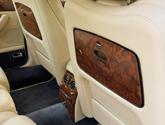
1
Estimate: £14,000 - £16,000*
Reg
Although, based on the Shadow floorpan, the Spirit offered considerable improvements in both ride and handling. By combining copious amounts of sound deadening with the finest quality upholstery, Crewe’s engineers kept intrusion from the 6.75 litre V8 engine to a muted hush. Unveiled at the 1989 Frankfurt Motor Show, the Spirit II featured a sophisticated automatic ride control system that adapted to changing road conditions almost instantaneously, ergonomically enhanced `new look’ dashboard, four-speed automatic transmission and standard-fit alloy wheels. Arriving in 1993, the Spirit III boasted more power thanks to redesigned cylinder heads and manifolding, airbags for both driver and front seat passenger and revised rear lights. Decidedly short lived, just 234 Spirit III saloons are thought to have been made (of which 182 were to right-hand drive specification).

This UK-supplied, right-hand drive example was manufactured in 1995 and supplied new through Stratstone Rolls-Royce in Wilmslow, Cheshire. Finished in the attractive colour scheme of Red Pearl with Cream piped leather interior upholstery, the Spirit III has been in current registered family ownership since 2007, with husband and wife equating to two of the five total owners.

Covering a modest 70,833 miles (at time of consignment) from new, the Rolls-Royce has benefited from replacement head gaskets in 2014 by a specialist, along with a brake overhaul in the same year, again with a specialist. Accompanied by a large history file including the original book pack, the stamped service book shows fourteen stamps from main dealers and specialists, along with further servicing invoices, most recently approximately 1,000 miles ago. Also present on file are a selection of previous MOT certificates, numerous invoices relating to work completed (much by specialists), along with a current V5C document.


The sleek super-formed aluminium body of the DB9 was initially designed by Ian Callum but had also had significant influence from the next director of AM design, Hendrik Fisker. It was powered by a third-generation version of the now familiar 6.0 litre, V12 engine with a top speed of 186mph. The DB9 was the first of what was to become a long line of production Aston Martins to use VH architecture; using super-formed parts in the chassis and footwell as well as the body panels. The DB9 body shell weighed 25% less than that of the DB7 but has double its torsional rigidity.
The DB9 Volante offered was manufactured in 2006 and supplied new through Wilmslow Aston Martin in Cheshire, being registered new in the United Kingdom on the 18th of May that year. Presented in Black paintwork with Cream leather interior upholstery, which many argue is the best colour combination, the Aston Martin is completed with a hood trimmed in Black. Covering a modest 63,040 miles from new (at time of consignment), ‘W1 RPF’ benefited from a full engine overhaul by well respected marque specialist Rikki Cann in 2016 at 58,626 miles, which is understood to have cost in the region of £23,000. Earlier improvements, also provided by Rikki Cann, included bodywork and interior enhancements, braking work, further mechanical fettling, and servicing, costing some £9,200.
More recently entrusted to Aston Martin specialists Nicholas Mee (in 2019), with some £6,000 worth of attention, the Volante is accompanied by a history file that includes the original combined owner’s guide and service book, which illustrates ten stamps, all from main agents and specialists, with the most recent service completed by Nicholas Mee approximately 3,000 miles previous. Also included are a collection of previous invoices, a selection of past MOT certificates, a print-out record of early work completed by Aston Martin, along with a current V5C document. Cherished registration number ‘W1 RPF’, two sets of keys, an Aston Martin umbrella, and trickle charger also accompany.



1
Introduced in June 1992 and based on the flagship Mayfair 1275cc model, just 1,000 British Open Classic Minis were produced for the UK market. Finished in British Racing Green with gold coachlines and ‘Mini British Open Classic’ Coat of Arms decals, the newcomer also sported Black wheelarch extensions/sill finishers and rode on Minilite-style alloy wheels. A full-length electrically operated Webasto sunroof and opening rear windows allowed plenty of fresh air into the interior which featured a Cream leather steering wheel, Stone Beige Countryman Tweed upholstery with leather inserts and green piping, and ‘By Appointment to Her Majesty the Queen’ labels stitched to the front seats.


Manufactured in 1992, the British Open Classic offered was registered new in the United Kingdom on the 10th of December that year, being registered new to Rover Group M.V.O Department. In long-term previous ownership, the former keeper purchased the Mini from his mother-in-law in c.2005 and after a short period of use, embarked on a comprehensive ‘nut and bolt’ restoration. A sheet metal worker for the likes of Aston Martin, Bentley, and Rolls-Royce, he restored the shell before the Mini was painted by an ex-McLaren and Aston Martin paint shop manager.
Subtly upgraded with a stage one kit (including LCB manifold and Maniflow exhaust), Sportspack arches, 13-inch Minilite wheels, Hi-Lo suspension, Spax adjustable dampers, Poly bushes, aluminium radiator, amongst others. ‘K450 EKV’ shows 55,171 miles on the odometer at the time of consignment and is offered with a history file which includes the original book pack including stamped service book and owner’s manual in the Rover wallet, as well as a few previous MOTs, a no advisory current MOT certificate until February 2023, images depicting the restoration and a current V5C.
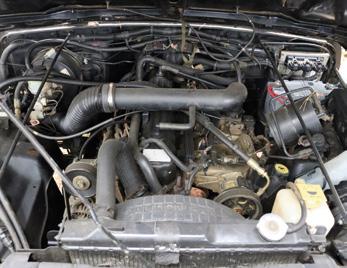
Similar to the Willys MB and the CJ Jeeps before it, all Wrangler models continue to use a separate body and frame, rigid live axles both front and rear, a tapering nose design with flared fenders, a fold-flat windshield, and can be driven without doors. Also, with few exceptions, they have part-time four-wheel drive systems, with the choice of high and low gearing, and standard are open bodies with removable hard- or soft-tops. However, the Wrangler series was specifically redesigned to be safer and more comfortable on-road, to attract more daily drivers, by upgrading its suspension, drivetrain, and interior, compared to the CJ line. The suspension on all Wranglers included trackbars and anti-roll bars, and, from the 1997 TJ onwards, front and rear coil springs instead of the previous leaf springs.
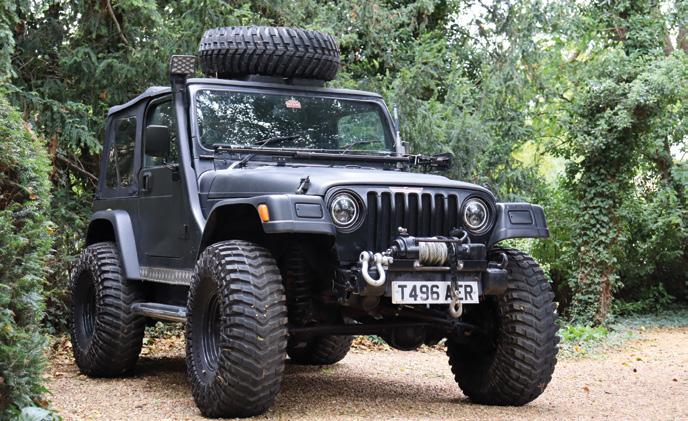
Manufactured in 1999, the Wrangler Sport offered was registered new in the United Kingdom on the 23rd of March that year, being supplied new via Marshall Motor Group Ltd Chrysler Jeep of Cambridge. Fitted with the desirable 3960cc AMC straight-six engine allied to the five-speed manual transmission, the Jeep is finished in Black with cloth interior upholstery. Retained in its first ownership from 1999 until 2017, the Jeep has had just three former keepers from new, and at the time of consignment had covered 88,453 miles from new. Extensively upgraded for off-road use, the Jeep has been fitted with a Rubicon Express suspension kit, FWH conversion, and cast discs amongst further upgrades by FTE 4x4 specialists in 2003 costing over £2,800. Offered with a history file which includes the original book pack containing the stamped service book (displaying ten stamps all from the supplying dealer), and owner’s manual in the Jeep wallet, as well as sundry paperwork, a no advisory current MOT certificate until September 2023, copies of previous logbooks, and a current V5C.
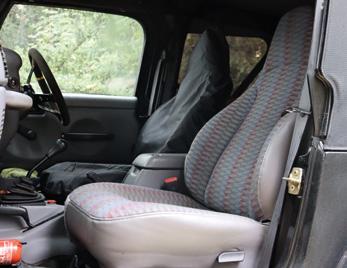
Estimate: £22,000 - £26,000*
Reg No: GT 5291 MOT: Exempt
Chassis No: GPS22
Maintaining its policy of offering one ‘Large’ and one ‘Small’ model (the terms being purely relative), Rolls-Royce introduced the 20/25 in 1929 as a successor to the outgoing 20. Though the newcomer was aimed at owner drivers, many examples were sold to customers with chauffeurs. Power came from an enlarged version of the straight-six unit used in the 20. Now of 3,699cc, it made for swifter acceleration and a higher top speed of up to 75mph. The four-speed manual gearbox featured the manufacturer’s traditional righthand change and was equipped with synchromesh on the top two ratios from 1932 onwards. The substantial chassis sported rigid axles front and rear suspended on semi-elliptic leaf springs. The four-wheeled braking was mechanically servo-assisted. Bodywork for the 20/25, was to the taste of the customer, and Gurney Nutting, Park Ward, Thrupp & Maberly, Mulliner, and Hooper were among the many coachbuilders selected to clothe these fine cars. Nearly 4,000 20/25 chassis were produced, making it the company’s bestselling model between the wars.
Manufactured in 1931, the 20/25 offered was delivered new on the 23rd of June 1931 to the first owner, an S. P. Askew Esq of Redhill, Surrey. Fitted with four-door light Saloon coachwork by Park Ward and finished in two-tone White and Black with Red leather interior upholstery, and specified new with a long type chassis, E-rake steering, and a Staybrite radiator and shutters.
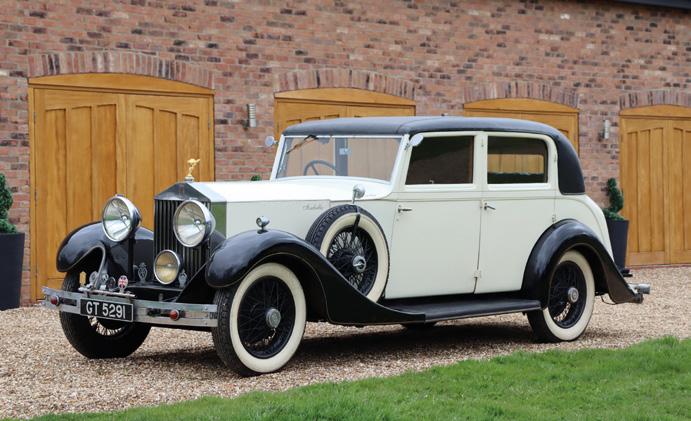

The Rolls-Royce is known to have subsequently resided in South Africa for circa 40 years, before latterly becoming part of the Nobbs collection. Most recently entering into current ownership in 2018, chassis number GPS22 was subject to a radiator overhaul shortly before purchase. ‘GT 5291’ is offered with RREC construction and test records, a few previous invoices, and a current V5C document. The vendor rates the 20/25 as ‘average’ in regards to paintwork and electrical equipment, ‘good’ engine and interior trim, and ‘very good’ bodywork and gearbox.


Expectations were running high when the Virage was unveiled at the 1988 Birmingham Motor Show and, despite a hefty price tag, orders flowed thick and fast. The V8-powered model was intended as the company’s flagship model, with the 6-cylinder DB7, introduced in 1994, positioned below it as an entry-level model. Although the DB7 became available with a V12 engine and claimed a performance advantage, the Virage remained the exclusive, expensive and hand-built flagship of the Aston Martin range. It was replaced in 2000 with the Vanquish.
The chassis was designed in conjunction with the Cranfield Institute of Technology and clothed in hand-beaten aluminium to a design by John Heffernan and Ken Greenley, while power came from an uprated version of Tadek Marek’s immortal all-alloy 5,340cc V8 unit. Some 365 Virages were crafted between 1989 and 1995, at which point the car was reshaped with styling cues from the more powerful Vantage and redubbed ‘V8 Coupe’. Some might describe Aston Martin’s as ‘metal sculpture’, however, you look at it this is a ‘brand new’ Aston Martin bodyshell which was intended for motorsport development. Sculpted in aluminium, it was going to be built as a race car with 4-way rear drop link suspension, however, the 550 Vantage was brought out and that car possessed the 4 way drop link suspension and therefore this Virage project was ‘Black Flagged’ and shelved. Offered from long-term dry storage, this is an exciting opportunity for an Aston Martin build.

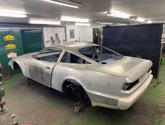
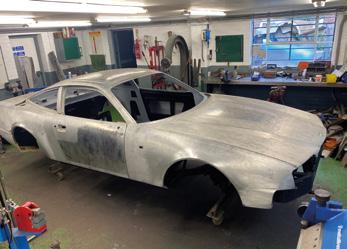


of just 182 right-hand-drive examples
Estimate: £11,000 - £13,000*
No: M675
Chassis
SCAZS02C4SCH55690
Although, based on the Shadow floorpan, the Spirit offered considerable improvements in both ride and handling. By combining copious amounts of sound deadening with the finest quality upholstery, Crewe’s engineers kept intrusion from the 6.75 litre V8 engine to a muted hush. Unveiled at the 1989 Frankfurt Motor Show, the Spirit II featured a sophisticated automatic ride control system that adapted to changing road conditions almost instantaneously, ergonomically enhanced `new look’ dashboard, four-speed automatic transmission and standard-fit alloy wheels. Arriving in 1993, the Spirit III boasted more power thanks to redesigned cylinder heads and manifolding, airbags for both driver and front seat passenger and revised rear lights. Decidedly short-lived, just 234 Spirit III saloons are thought to have been made (of which 182 were to right-hand drive specification).
This Silver Spirit III is offered with an extensive service history and just 73,000 miles and 3 former keepers from new. Finished in Royal Blue, with complementing Cream leather upholstery, there are Blue carpets with piping colour-matched to the Cream leather. The vendor describes the car as having documented history with main dealer Rolls-Royce dealers/specialists’ and ‘a fastidiously maintained car’. This could be an opportunity to own a well-maintained example. The vendor also describes the car as driving ‘superbly with good performance and effortless gear changes’. Keeneyed enthusiasts will notice the number plates for ‘M675 JVK’ are Rolls Royce dealer-supplied number plates (Broughtons of Cheltenham). A complete leather wallet book pack accompanies this Silver Spirit III.
Born in 1940, the only child of only children parents, Bob was educated at Stockport Grammar School then read natural sciences at Christ Church, Oxford. He joined William Deacon’s Bank, and had a stellar ascent through it and its subsequent iterations ending up as Group Treasurer of the Royal Bank of Scotland. He grasped the opportunity of early retirement in 1990 and moved to the Isle of Man where he had been left a house by an aunt. But Bob was far from being inactive, throwing himself into the local community and taking on the turnaround of a local private bank as its Executive Chairman.
Sailing had been a preoccupation during his time in the City, but on coming to the Isle of Man, Bob switched his energies and focus to collecting “quality cars” – principally the products of Cricklewood, Derby and Crewe, but with some maverick exceptions such as Maserati and
Caterham. Daimlers and Lanchesters also featured, and he had to move to a large country house to find garaging for the ever-growing collection. His cars were regularly campaigned at rallies for the appropriate marque and were often deserved winners of various trophies. He also got involved in the relevant enthusiast clubs, usually ending up as Chairman – and his list of appointments included the Chairmanship of the Manx Classic Car Club and the Manx Motor Racing Club.
Bob was always a keen supporter of local charities, particularly maritime and those involving young people, and many will have cause to remember with gratitude his generosity and his apparently bottomless well of technical knowledge on “quality cars”, so freely shared. Bob left his Estate predominantly to Charity with the RNLI being the Residuary Beneficiary. Thus, in effect, the entire proceeds of the car collection sale will be received by the RNLI.

The new Lanchester Fourteen was displayed to the press on the 9th of October 1950. The only familiar feature from the previous model was the fluid flywheel and pre-selective gearbox. In total, some 2,100 examples are thought to have been manufactured in 14 Saloon guise.


Manufactured in 1953, this 14 Saloon was supplied new by Jessops of Romford Ltd to an F. O. Taylor Esq. of Essex, who retained the Lanchester for twelve years, costing £1,197.17.9 when new. Passing to the second keeper, a Mr. Bishop of Bridport who owned ‘VVW 970’ for approximately 35 years. One subsequent UK keeper ensued, before being exported to Ireland during the year 2007. Two Irish keepers preceded the Lanchaster’s return to the United Kingdom, with one further custodian before entering the private collection of Mr. Robert Furniss Riding. Now offered from the late Robert Riding’s Estate, the vast majority of which has been left to charity with the RNLI as the predominant beneficiary. Finished in Maroon paintwork with complementing Maroon leather interior upholstery and carpets, the Lanchester is now displaying a recorded mileage of 52,067 miles at the time of consignment. Running and driving, although may require some further recommissioning, the Lanchester is accompanied by a history file that contains the original purchase invoice from Jessops of Romford, a large selection of older invoices dating back to the 1960s, an original owner’s handbook, factory guarantee card, previous MOTs, and V5C document.
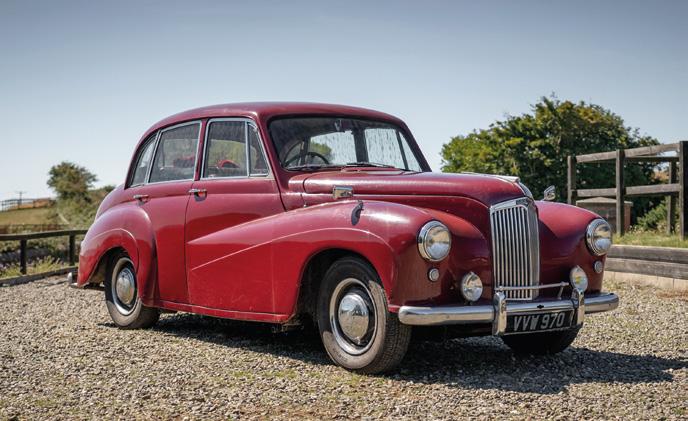
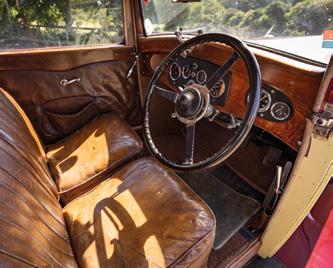
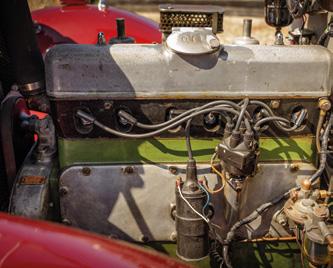
Renowned for its large, luxury motorcars, Daimler had to cut its cloth to suit the times, and its answer to the Great Depression was the Fifteen, launched in 1932. Around 6,000 cars had been sold by the end of production in 1936, making it the most successful Daimler to date.

Supplied new to Australia, chassis number 33784 was provided to coachbuilders Martin & King Ltd. of Melbourne who provided the ‘Sportman’s’ Fixed Head Coupe coachwork; which is distinguishable from Mulliner examples for having full-length doors. Fitted with the 1805cc six-cylinder engine allied to the four-speed pre-selection transmission, the Fifteen is finished in the attractive (and believed original) colour combination of Champagne and Claret two-tone paintwork with Brown leather interior upholstery. Discovered by the restorer at a deceased estate sale in 2001, the Fifteen displayed the remnants of a tax disc from 1963, indicating that was the last year of road use.
The engine, gearbox and mechanicals were overhauled, with many other parts restored and renewed. The bodywork was refitted to the already renovated chassis and the Daimler received a full repaint, with paint matched to surviving paintwork on the panel insides. The interior was professionally re-trimmed, before the car was re-wired throughout. Thirteen-months after purchase, the restoration was completed and elected to be featured in ‘The Automobile’ magazine (October 2002), with a copy of the article included in the history file.
Additional mechanical improvement was provided more recently comprising an overhauled rear axle, reconditioned brakes, fuel system renewal, an overhauled starter motor and flywheel refurbishment costing almost £2,000 in 2017. Accompanied by a documentation file which includes a Daimler & Lanchester Owners Club dating letter; original Instruction book; technical literature and diagrams; photos from its time in Australia; shipping documents; a collection of invoices, large quantity of Isle of Man tax discs; a previous copy of a V5C; sundry paperwork and the Isle of Man registration document. Now offered at ‘No Reserve’ alongside the rest of the Robert Furniss Riding Estate, benefitting the RNLI.
“It was not the means whereby the 3-Litre Bentley performed, but the manner in which it did it, that endeared the car to sportsmen who took pride in their driving. The engine was remarkably flexible, strong and reliable, the gear ratios were admirably chosen, the handling excellent and the quality unremittingly high. So, also, was the price, but an ever-growing reputation, augmented by striking racing victories - including the Le Mans 24 hours of 1924 and 1927 - ensured its success” (‘Classic Sports Cars’ by Cyril Posthumus and David Hodges).
A railway engineering apprentice turned aero-engine designer, Walter Owen Bentley previewed his first creation, the immortal 3-Litre, at the October 1919 London Motor Show (though, he would not deem it production ready for another two years). Inspired by a 1914 Humber TT racer, the newcomer’s ladder-frame chassis was equipped with all-round semi-elliptic leaf-sprung suspension and rearwheel drum brakes (four-wheel brakes becoming the norm from 1924 onwards). The car’s heart and most advanced feature was its 2996cc engine. A long-stroke four-cylinder (80mm x 149mm) that prioritized torque over top-end power, it boasted a five-bearing crankshaft, shaft-driven overhead camshaft, monobloc construction, twin ignition, four valves per cylinder and aluminium pistons.
Developing between 65bhp and 88bhp, the unit was allied to a separate four-speed gate-change gearbox. Supplied in bare chassis guise only, albeit with a choice of wheelbase lengths and engine tune, the 3-Litre remained in production until 1929 by which time some 1,621 are thought to have been made. As well as its two Le Mans victories, the Bentley enjoyed considerable success at Brooklands and even broke the 24-hour world record around Montlhery setting a 95mph average speed.

One of just 765 Bentley 3 Litres to be built on the long standard (10ft 10in) wheelbase, chassis 619 is understood to be the first of its kind to wear this particular style of four-door Vanden Plas coachwork. Sold new via Gilmour Ltd of Glasgow to G.F. Fulton Esq of Lang & Fulton (a Greenock-based company whose Ard Steam Ship Fleet extended to twenty-nine vessels), the four-seater was specified with a B-type gearbox and 13/55 rear axle ratio. The accompanying copy factory service record shows that ‘VS 911’ subsequently belonged to R.A. Morrison Esq of Rutherglen and A.S. Eastburn Esq of Helensburgh before being bought by B.L. Martin Esq of Surrey in 1937. Surviving World War Two, the Bentley is then known to have passed through the hands of Captain J.H. Lane, M.H. Fountain, Brigadier R. Phillipson, R.F. Read Esq and D. Baracos Esq. The latter gentleman took the 3 Litre to Greece from whence it returned during 1989 amassing two further keepers and attending various BDC Hatfield House Concours events prior to joining the late Robert Furness Riding’s collection in 2003.
Drawn to chassis 619 because of its high degree of originality – aside from being upgraded with a more powerful 3 Litre Speed Model engine at some stage (number 983, ex-chassis 977) – Mr Riding thought the four-seater to be to factory specification throughout complete with four-wheel brakes. The chassis number is stamped into the inside of the front dumb iron, front cross member, magneto switch plate and bonnet edges as expected, while the steering box and gearbox are numbered





correctly as 615 and 274 respectively. The original Vanden Plas coachwork remains in situ and boasts an Auster-type foldaway rear windscreen.
A true Rolls-Royce and Bentley enthusiast and frequent concours entrant, the late Mr Riding had ‘VS 911’ treated to some sympathetic coachwork renovation and repainting upon acquisition. New underwing guards and upholstery repairs and retrimming were provided as required, as well as a new hood bag trimmed in Black leather, with the total reaching approximately £7,800 with J. & M. Bentley and Partners. Renowned marque specialist Hofmann’s of Henley were then employed to completely overhaul the engine, with works comprising supply of a new crankshaft to improved design (with large diameter journals and integral counterweights); new centre bearing; overhauled oil pump; Arias pistons; new valves and valve seats; replacement camshaft; magnetos re-wound by D. H. Day; and carburettor servicing amongst much more. Many of the parts were supplied by VBE Restorations. Brake system fettling and specialist radiator repairs were also undertaken while with Hofmann’s, with the expenditure exceeding £30,000.
Covering less than 1,000 miles since it was overhauled, the revitalised engine can still be said to be in the ‘running in’ phase. Further improvements were also made to the Bentley by way of a replacement exhaust system, additional magneto fettling, Autovac refurbishment, carburettor jet assembly
overhaul, and a new fuel tank. Now offered at No Reserve from the late Robert Riding’s Estate, the vast majority of which has been left to charity with the RNLI as the predominant beneficiary.
The four-seater is accompanied by full weather equipment, comprising hood, side-screens, the aforementioned leather hood bag and tonneau cover, all trimmed in Black. The dashboard features period correct instrumentation including an A.T. speedometer and rev counter, Smith’s MA clock, oil pressure and ammeter/electrics cluster. Riding on original specification beaded edge tyres making for ‘light’ steering, running board toolboxes and rear luggage rack complete the period look. The documentation file comprises a copy factory service record; invoices relating to the current and previous ownership; previous MOTs dating from between the 1980s and 2010s; technical literature; a copy instruction book and a current V5C document.
Featured in the Johnnie Green book ‘Bentley: Fifty Years of the Marque’ and Brian Smith’s ‘Vanden Plas Coachbuilders’ and offered from a private collection, this handsome, well-proportioned W.O. is charmingly original and ready to be enjoyed and would naturally provide entry to many prestigious events.
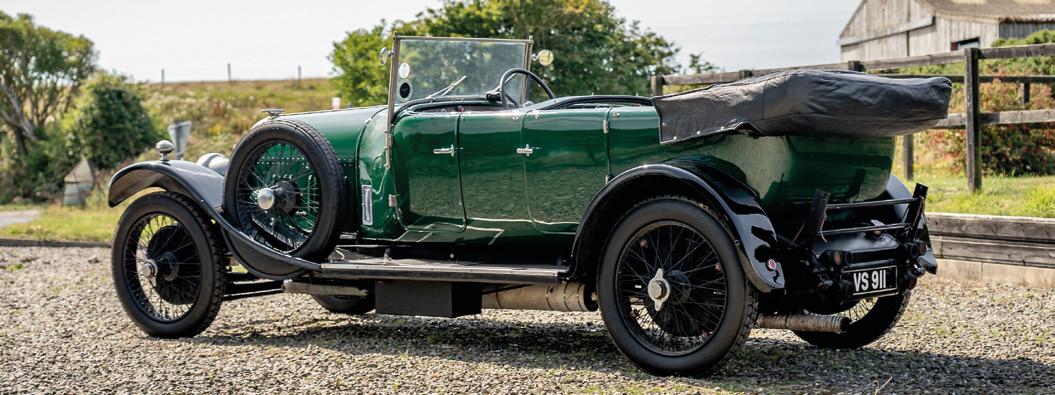


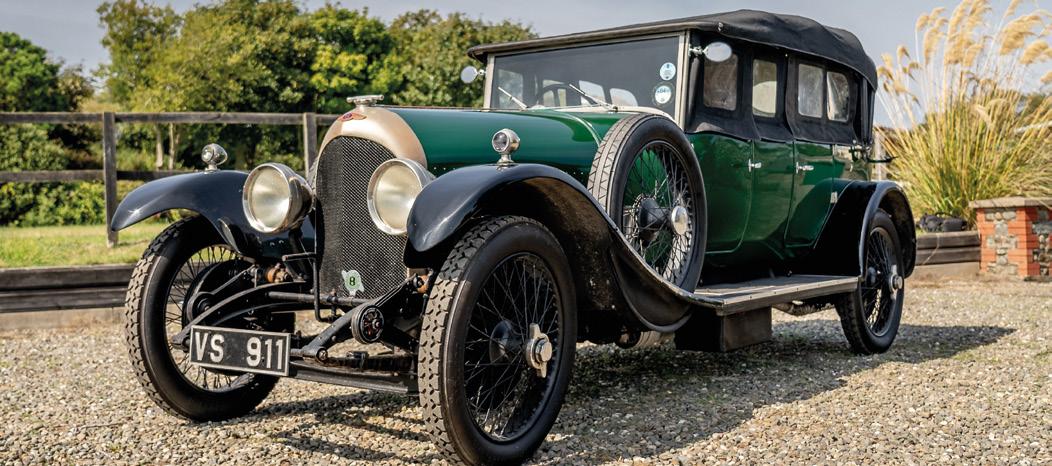
In production between 1971 and 1996, the Rolls-Royce Corniche Drophead is the epitome of luxury open-air motoring. Fabled for its extravagantly sumptuous interior and hushed drivetrain, it was powered by a tuned version of Crewe’s staple 6750cc V8 engine mated to an automatic transmission. The Corniche II was officially launched for the American market in 1986 and other markets in 1988. Anti-lock brakes were added for 1988, along with some detail changes to the interior.

One of only 1,226 examples of the Corniche II are understood to have been produced, the car on offer was supplied new through Rolls-Royce and Bentley dealers Murray Motor Co. of Edinburgh on the 1st of August 1989. A home-market, right-hand drive example, it was specified from new in the rare and striking colour of Nordic Blue with ‘double thin’ fine lines in Magnolia to complement the Parchment hide specified inside. Surf Blue piping and carpets complete the interior look, along with a Cream Everflex hood. The top roll, steering wheel, and lambswool rugs were all specified in Surf Blue, and the underdash and sun-visors to be trimmed in Parchment hide. Further particulars of the order included white-wall tyres, shaded Sundym windscreen, badge bar, and provision for radio/telephone.
Supplied to the initial owner, who is thought to have never used the Corniche, it was soon re-sold to the second keeper, a business owner in the Hamilton area. In 1990, the Rolls-Royce reached its third and soon after, its fourth keeper, both residing in the Manchester and Cheshire areas, before being purchased and entering into the private collection of Robert Furniss Riding in 1992, as a celebration of official confirmation he was regarded as Isle of Man resident. A hand-written story of the negotiation process of the Corniches purchase is present in the history file – which interestingly took around two and a half weeks! Now offered at No Reserve from the late Robert Riding’s Estate, the vast majority of which has been left to charity with the RNLI as the largest beneficiary.

Used relatively regularly through the 1990s by Robert, before the turn of the millennium saw the Corniche used much more sparingly. Having now covered c.11,000 miles from new (at the time of consignment), this very low mileage example has a large and interesting history file including correspondence between R. F. Riding and motor traders such as William Loughran Ltd. who had previously supplied the car to the second owner and a representative at Reg Vardy Ltd., discussing when the Rolls-Royce was borrowed for use in a promotional activity at one of their dealerships alongside a Lamborghini Countach ‘Anniversary’ and Ferrari F40.
The large history file further includes the original book pack containing the owner’s handbook, radio, warranty, and sales and service books, alongside the original stamped service book, all presented in the Rolls-Royce wallet. The service book documents fourteen entries, almost entirely from Rolls-Royce in Crewe, main agents, and specialists, with the most recent service completed approximately 100 miles ago. Original sales literature, a large quantity of invoices for work completed, the aforementioned letters, period photographs, a car specification sheet, Isle of Man tax discs, and sundry paperwork complete the documentation file.
These beautiful convertibles with Mulliner Park Ward coachwork have a timeless elegance and this delightful example looks superb in the head-turning and rare colour combination of Nordic Blue with Parchment hide and Surf Blue interior features. Anyone who saw one of these with the top down when they were first introduced would have found it difficult to conceive that an amalgam of steel, glass, walnut, and leather could have been formed into something so utterly desirable. An eye-catching example with very low mileage, this is an unmissable opportunity at no reserve to purchase one of the most opulent convertibles of the 1980s.

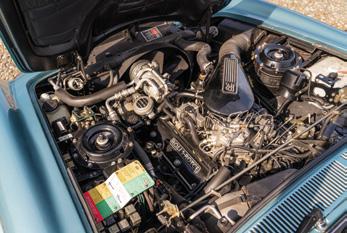
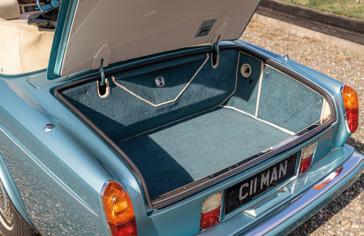
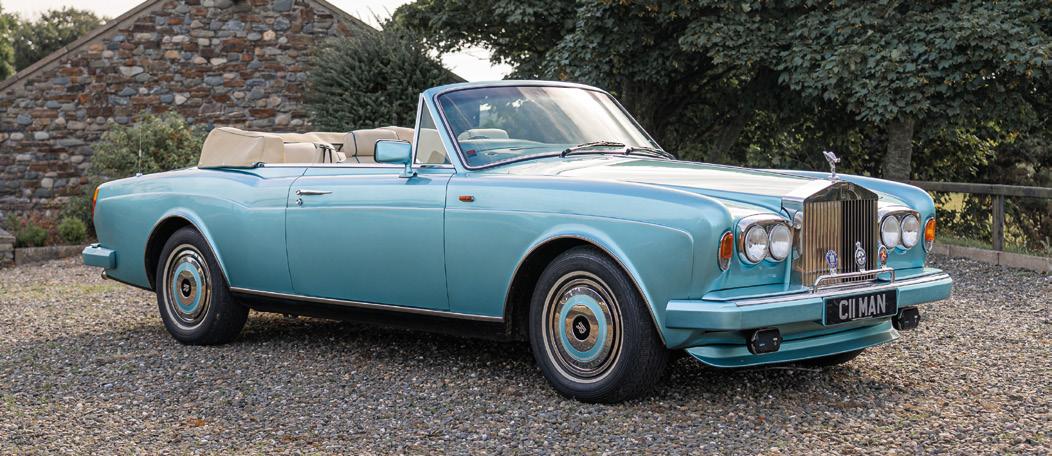

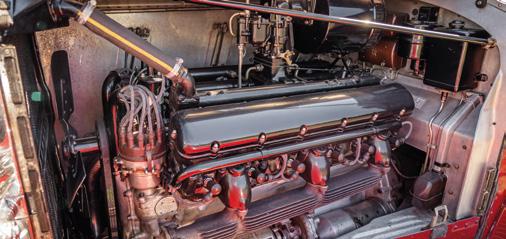
Although unveiled to the public at the October 1935 Olympia Motor Show, the Phantom III did not enter series production until May 1936. A fabulous design that reasserted Rolls-Royce’s right to be considered as the world’s pre-eminent car manufacturer, its cruciform-braced chassis featured independent coil-sprung front suspension, a fully-floating ‘live’ rear axle, hydraulic shock absorbers and gearbox driven servo-assisted four-wheel drum brakes. Drawing on decades of aero-engine experience, it was powered by a 7340cc ohv V12. Fabricated largely from aluminium alloy, this technically advanced unit boasted a seven-bearing crankshaft, eight-bearing camshaft, hydraulic tappets and dual downdraught Stromberg carburettors. Effortlessly potent and eerily smooth, it required a level of care and maintenance not dissimilar to that of its Schneider Trophy-winning siblings. Allied to a four-speed manual gearbox (complete with synchromesh on second, third and fourth gears), it gave most variants a 100mph top speed. Only built for three short seasons, just 727 Phantom IIIs are thought to have been despatched worldwide.
Specified for use ‘in the UK and on the Continent. Town and Touring Work’, chassis 3BU42 was taken off test on February 1st 1937 and delivered to the coachbuilder H.J. Mulliner two days later where it was bodied as a handsome Sports Limousine. Unusually, the five-seater’s wind-up glass division and well-stocked vanity units were complemented by separate radios to the front and rear compartments. The Rolls-Royce’s first owner, the successful City businessman Anthony Hornby (later Sir Anthony), was certainly someone for whom keeping abreast of current affairs was vital. An accompanying copy invoice shows that he purchased the Phantom III from Jack Barclay Ltd of London W1 for the princely sum of £2,783 15d 4d (with a part-exchange allowance of £1,350 being made against its Phantom II predecessor). Rising to prominence as a senior partner at stockbrokers Cazenove, Hornby established one of the UK’s foremost private art collections and later took up residence at Claridge’s.
Changing hands several times thereafter, the Phantom III’s next notable custodian was Stanley Barraclough who acquired it during August 1978. Retiring to the Isle of Man the following year, he chaired the local RREC section for five years and became a prominent member of the Phantom III Technical Society. Spending some £34,000 (a significant sum at the time) with the likes of Roy Creech, Wilkinsons and Brunts of Silverdale, Barraclough had the V12 engine rejuvenated, front suspension refurbished, interior re-trimmed, wiring renewed and chromework replated etc. Tragically killed at the age of sixty-five when he was involved in a road traffic accident as a pedestrian, his noteworthy collection of ‘Best of Breed’ Rolls-Royces and Bentleys went under the hammer with Sotheby’s at the RREC’s 1996 Annual Rally.
Bought by the late Robert Furniss Riding at that auction (alongside the 1932 Rolls-Royce 20/25 Drophead Coupe, chassis GBT80 which also forms part of the collection), the Phantom III was judged ‘Best Overall Car’ on the 2000 Loire Valley Phantom Rally which saw it cover 1,300 miles. A prize
winner some thirteen years later when it was given the ‘Car of the Show’ award at the Gawsworth Hall Vintage & Classic Rally, chassis 3BU42 had had some £88,000 lavished on it between 2010 and 2012 with the majority of the work being carried out by Phantom III specialist M.J. Pickles. As well another engine overhaul, the Sports Limousine benefited from a relined clutch, re-cored radiator, brake system fettling, front hub refurbishment, bodywork fitment / paintwork improvements, renovated fuel tank and a complete exhaust system.
This elegant Phantom III boasts matching chassis and engine numbers, and is accompanied by a very large history file that includes restoration and event photographs; assorted newspaper articles; a vast quantity of invoices from both Robert Riding’s and Stanley Barraclough’s ownerships; RREC chassis card records; technical literature and diagrams; copy of the Sotheby’s auction catalogue; copies of two Jack Barclay order forms and build information; original sales literature and handbook; Isle of Man tax discs; sundry paperwork and Isle of Man registration document.

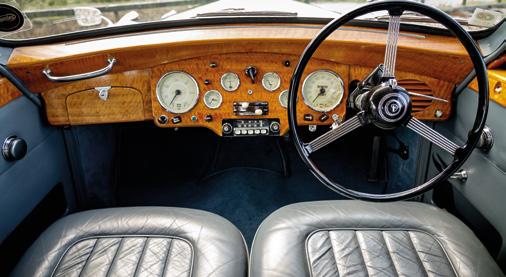
Daimler maintained its long-established position as royalty’s favourite in the immediate post-war years while grabbing headlines in the popular press thanks to a succession of often-outrageous ‘Docker specials’ on the DE36 straight-eight chassis. For the owner-driver though, the six-cylinder Daimler represented a more sensible choice. From 1954 onwards this range comprised the Regency II, Sportsman or Empress saloons, the latter featuring a body by in-house coachbuilder Hooper & Co. The power unit was a 3.5-litre overhead-valve six (there was also an optional 4.6-litre unit) and the transmission was Daimler’s traditional fluid flywheel/pre-selector type. A mere 14 Em-press III models are believed to have been constructed making it one of the rarest post-war Daim-lers.
Chassis 91490 was manufactured in 1955 at Daimler works before being provided for completion to Hooper & Co. in 1956 and registered new ‘SUL 742’ in August 1956. Interestingly used as a Hooper demonstrator vehicle when new, the Empress is one of only 14 of the MkIIIs believed to have been manufactured with the aluminium coachwork. Retained by Hooper initially, it is next known that the Daimler was acquired by a department store, Hills London Shops Ltd in April 1963. Three further owners ensued through the 1960s and an additional trio of custodians during the 1970s before the Hooper was acquired by an A. D. Jackson Esq. He retained ‘SUL 742’ for around eighteen years before it was passed to a family member.
Purchased by the previous owner and restorer in December 1995 at a Sotheby’s auction, the Daim-ler is said to have been in a sorry state (having covered less than 40 miles in the last ten years) with the chassis corroded, paintwork in poor condition, the interior requiring restoration and mechani-cals also requiring attention. A comprehensive restoration ensued with the bodywork being stripped back to bare metal, and the chassis fully renovated. The bodywork was then restored and repainted in the original colour by Kempston Panelcraft and the engine (which overall was very good) was sent to Jaguar specialists VSE for an overhaul. The pre-selector gearbox was sent to Len Stoller of the Daimler and Lanchester Owners Club, before the re-wiring, said to have been especially challenging, notably due to the intricacies within the door for the electric windows. The interior leather upholstery was fed and recoloured, with the vast majority of the original leather trim saved. The dashboard was revarnished and a carpet set produced finishing the interior, with almost all the exterior brightwork rechromed. Elected for a full five-page restoration feature in ‘Classic Cars’ magazine (January 1998 edition), the restoration was completed to a very high standard.
The Empress’ first outing was to the Daimler centenary celebrations at Combe Abbey, with ‘SUL 742’ being given the award for Best Large Post-War Saloon. Purchased by Robert Furniss Riding in 1998 from the restorer, it has resided in his private collection ever since and continued award-winning form when at the Daimler & Lanchester Owners Club International Rally of 2006, the Hooper Empress was awarded The Berglind Trophy (for the vehicle most attendees wished to take home) and The Jaguar Tankard (best post-war saloon). Now offered at No Reserve from the late Robert Riding’s Estate, the vast majority of which has been left to charity with the RNLI as the predominant beneficiary.
Under Robert’s ownership, the Empress has benefitted from a carburettor overhaul in 2019 and in 2021 fitment of a replacement cylinder head gasket, thermostat and housing, and servicing. ‘SUL 742’ is accompanied by a large history file that includes a vast selection of photographs of the res-toration work; a very large quantity of invoices for work both during the restoration and current ownership; numerous MOTs from between 1982 and 2013; Green ‘Buff’ logbook and copies of previous logbooks; a copy of the ‘Classic Cars’ magazine in which the Hooper features; sundry paperwork and correspondence; and the V5C registration document. This decidedly attractive and rare Hooper bodied Empress is surely the best example extant and is worthy of close inspection.


Manufactured in 1990, this 260E was supplied new to the United Kingdom through Puttocks Mercedes-Benz of Guildford, being registered new on the 14th of March that year and delivered to Royscot Southgate Ltd. of London. Finished in Midnight Blue paintwork with Mushroom leather interior upholstery, the Mercedes is fitted with the 2599cc straight-six engine allied to the four-speed automatic transmission. Entering the sole private ownership in February 1991, the 260E has remained with Robert Furniss Riding ever since and has covered some 75,950 miles from new at the time of consignment. Offered from the late Robert Riding’s Estate, at no reserve, the vast majority of which has been left to charity with the RNLI as the predominant beneficiary


Specified from new with electric sunroof, cruise control, outside temperature indicator, electric windows, paintwork preservation treatment, leather steering wheel and gearknob, and walnut wood trim amongst others, the 260E is offered with a history file that contains the original book pack comprising the owner’s manual; Alpine stereo, guarantee and service guides; price list and the stamped service book, the last being c.800 miles ago. Eighteen of twenty-four stamps from Mercedes-Benz main dealerships. The most recent service was completed last year (around 800 miles ago). Also on file are the PDI check sheet, original sales literature, a handwritten log of the 260s journeys and mileages from new, two sets of keys, a no advisory MOT certificate until August 2023 and a current V5C document.
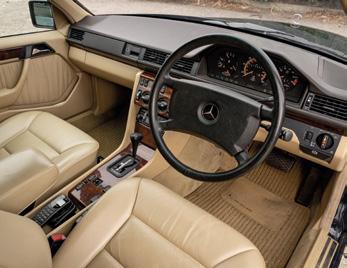



Chassis No: 26004
The Lanchester Light Six of 1935/1936 became an early example of badge engineering, being very similar to the BSA Light Six and sharing its body with the Lanchester 10. The standard fare was a four-door, four-seat Saloon mounted on cross-braced chassis. However, some very attractive bespoke alternatives were produced by a range of independent coachbuilders.
Chassis number 26004 was manufactured in 1935 and supplied to Mulliner’s (of Birmingham) who provided the attractive twodoor, four-seater Fixed Head Coupe coachwork the Lanchester is presented in. Purchased into the private collection of the late-Robert Furniss Riding in 2002, the collection is now offered from the collection at No Reserve, the vast majority of the estate having been left to charity with the RNLI as the predominant beneficiary. Originally fitted with the 1378cc six-cylinder overhead valve engine, this unit has been replaced with a later introduced 11hp four-cylinder engine (of 1444cc) allied to the pre-selector transmission. Previously in the family ownership of Lanchester marque historian, Chris Clark, it was thought to have been retained in his family for some 38 years.
Presented in Red with a Black roof, the interior features Red leather interior upholstery, door-cards and carpeting, and a wool-cloth headlining. The Lanchester was subject to much restoration work in 2007 comprising a complete re-wire; an electric fuel pump; renewed cooling system; exhaust system repairs; relined brakes; an overhauled distributor and much more. Recently provided with further improvements encompassing a refurbished water pump, radiator renovation, and coolant system flush; bodywork repairs; and a fuelling system overhaul totalling approximately £2,000 through 2020-2021. Accompanied by a history file that contains a collection of invoices; model and technical information; an original spare parts catalogue and reproduction maintenance manual; a previous V5C document; MOT certificates from between 1984 and 2002; sundry paperwork; and the Isle of Man registration document.




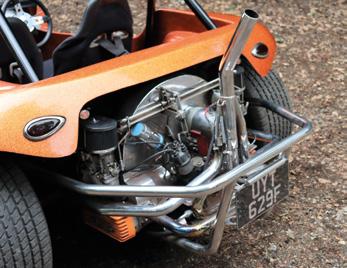
Reg No: UYT 629F MOT: Exempt
Chassis No: 118483131
Entered from a private collection, offered here is believed to be a Prowler dune buggy. The Prowler buggy was originally developed by British dune buggy specialist Mel Hubbard in the mid-2000s. For more UK tastes, the Prowler utilised the original design of Bruce Meyers’ Meyers Manx (the original dune buggy) and ‘updated’ the design. The arches are wider (front 1.5” rear 2”) which allows lowering and tyres with more width. The rear is more open than other buggies; fitting a larger engine with big carbs requires no cutting or reshaping.
‘UYT 629F’ is based upon a 1968 Type 1 Beetle, with a specification that includes the use of an 1835cc litre, flat-four VW engine, essentially a rebuilt AD code VW (1600cc) engine rebuilt to a higher power output and carburetted by twin Webers.
The windscreen and bonnet of ‘UYT 629F’ have been changed from those originally offered as part of the kit. Other windscreen screen frame heights and designs and a Manx bonnet could be used (hence the bonnet badge plinth which would have held the Meyers Manx badge). Sometimes referred to as a ‘Prowler Manx’ because of this, it was an upgrade suggested by East Coast Buggies selling the Prowler in the UK: “If the Prowler bonnet is not to your taste, then we can supply a combination of a Manx bonnet and Bounty Hunter (buggy) screen for a whole new look.”
In the cockpit, the specification is more that of a ‘street rod’ than buggy for the dunes. The addition of a Sunpro tachometer, Cobra seats, Sparco harnesses, performance road tyres, battery isolator switch and a Gene Berg oil pump, suggest it has been built for land speed. Other notable ‘dune buggy’ custom items include a ‘Tri-Mil Bobcat’ style exhaust, CSP rocker covers and an EMPI trigger shifter. ‘Vintage Porsche’ style rear teardrop lights complete the look. Said to be in ‘very good overall’ condition, this ‘dune buggy’ is accompanied by a V5C and no other paperwork.
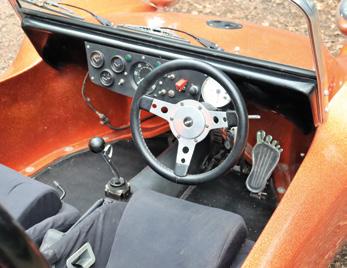


The Armstrong Siddeley engineering group was created in 1919. Over its forty-one year reign it produced some thirty models of luxury cars and for many years was also one of the UK’s largest manufacturers of aero engines. The very week WWII ended in Europe, the company introduced its first post-war model, the Hurricane - a large two-door three-position Drophead Coupe. The Lancaster Saloon and Typhoon Sports Saloon followed during 1946. All the 16hp and 18hp models built between 1945 and 1954 were named after aircraft built by the group under the Hawker-Siddeley banner. The early versions of each model were powered by 2-litre OHV six-cylinder engines (capacity later increased to 2.3 litres). The same cruciform chassis served as the base for all the derivatives. Suspension was independent at the front courtesy of longitudinal torsion bars. Braking was by Girling hydro-mechanically operated drums all round. Two gearbox options were available, a four-speed manual unit and Wilson preselector one. A total of 2,606 Hurricanes were made with survivors numbering in the hundreds.
Sold new to Mrs G.J. Humphreys on 1st June 1949, chassis 166566 was road registered as ‘NPB 989’ by Surrey County Council. Changing hands several times thereafter, the 2-litre (16hp), manual gearbox derivative was acquired by its previous keeper in 1988 who had the interior re-trimmed and the hood renewed. Purchased by the vendor during 2009 because it was a model his father had always admired, the Hurricane was shipped to his then home in Florida. Treated to a photographically documented restoration of its bodywork and paintwork from 2010 – 2012, the Drophead Coupe was sidelined by various work commitments. Repatriated to the UK earlier this year and currently in the process of being re-registered with the DVLA, the Armstrong Siddeley has been serviced and tuned but would doubtless benefit from recommissioning on the basis that it has not seen serious usage for a dozen years or so. Rare and elegant, this much underrated Hurricane is offered for sale with history file.


Introduced in 1962, the MGB Roadster enjoyed an eighteen-year production run. With nicely balanced handling and a good turn of speed, it merited the old MG marketing slogan ‘Safety Fast’. Based around a monocoque chassis featuring independent coil-sprung front suspension and a leafsprung ‘live’ rear axle, its 1798cc ‘B’ series four-cylinder engine was allied to a four-speed manual transmission. Capable of over 100mph, the provision of front disc brakes and rack-and-pinion steering greatly aided control.
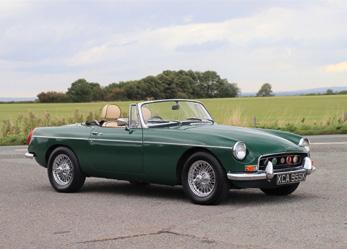
First registered on 4th April 1972, ‘XCA 995K’ displays 84,900 recorded and credible miles and has just 5 former keepers since 1972. It has been the subject of extensive bodywork restoration and paint in the early 2000’s with extensive receipts from The Welsh MG Centre and Moss Europe, that include the purchase of new front wings, new fuel tank, bumper parts and grille pieces (to name just a few items) since 2001. The car also benefits from a Kenlowe fan, electronic ignition and is fitted with overdrive. Inside, the cockpit has been freshened with an aftermarket burr walnut - effect dashboard trim, and complementing it all is a set of Cream leather MGF seats with Cream door cards and carpet set. There is an extensive collection of old MOT certificates and related MOT garage test invoices. ‘XCA 995K’ is accompanied by a large collection of the aforementioned invoices.

Successor to the race-proven (E9) 3.0CS/ CSi high performance sports coupes, the 6-series was introduced in August 1976. More forgiving than its predecessors, it utilized a modified version of the (E12) 5-series saloon platform equipped with all-round independent suspension (coil and wishbone front, trailing-arm rear) and powerful disc brakes. A natural rival to the 928 and XJS, the four-seater 6-series proved more capacious than the Porsche and sportier than the Jaguar. Immediately recognizable thanks to its distinctive ‘shark nose’ frontal styling and thin pillared glasshouse it boasts real road presence. An impression backed up by the various versions of BMW’s mighty M30, SOHC straight-six engine fitted throughout the range. Second only to the BMW Motorsport tuned M6 version, the 635CSi’s 3430cc unit developed some 216bhp and 232lbft of torque (outputs that were reputedly sufficient to propel it from 0-60mph in 8.4 seconds and on to 135mph).

First registered on the 7th of May 1986, this original UK-specification right-hand drive BMW 635CSi is finished in a beautiful Polaris Silver with a stylish Dark Blue leather interior. Having been in the vendor’s ownership since October 2016 the car has recently been recommissioned after a few years in dry storage. Work was carried out on the engine and brake system along with the fitment of a custom-made exhaust system, invoices for which are kept on file. Having had only 8 previous keepers and with 126,500 recorded miles on the odometer, this car is said by the vendor to drive well and is considered by him to be in very good condition, especially after just having completed a substantial respray. Offered with a partial history file including invoices for recent works completed.
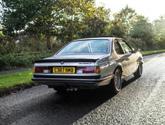

Estimate:
Introduced at the 1968 Geneva Salon, the Lamborghini Espada was a true four-seater supercar. Styled by Marcello Gandini of Bertone, it was visually indebted to the carozzeria’s previous ‘Marzal’ and ‘Pirana’ show cars. Although, the ‘quad-cam’ Bizzarini 3,929cc V12 was front-mounted and mated to a fivespeed manual gearbox, the Espada enjoyed near ideal front to rear weight distribution (52:48). At the 1970 Brussels Motor Show Lamborghini unveiled the Espada S2 (aka the ‘400 GTE Espada’), with the major external changes being the rear lights and deletion of the grille covering the vertical glass tail panel. Inside changes were more radical: an all-new dashboard, centre console and steering wheel were installed. The instrument binnacle was of a more conventional rectangular shape, with round gauges. Power output was increased to 350 hp (261 kW; 355 PS) due to a higher 10.7:1 compression ratio, and correspondingly, the brakes were upgraded to vented Girling discs instead of solid discs. CV joints were now used on the rear half-shafts. Just 575 Series II Espadas were made, with even fewer being right-hand drive.
Offered here is an opportunity to take custodianship of a rare right-hand drive Espada Series II. It would be down to the new owner whether it ends up as a parts car or a full restoration. Sadly the vehicle bodyshell and chassis have extensive rust issues and the rodents have had a field day on the interior, therefore a detailed physical inspection is highly recommended in order to establish if the current body can indeed be saved/restored. Nevertheless potentially an exciting opportunity to see another Espada back on the road. Originally a UK-supplied, right-hand-drive example it is in ‘garage find’ condition, with a the V12 Engine which turns over by hand. The vehicle is offered along with a cherished number plate, in itself, of potentially significant value.





£12,000 - £14,000*
Launched in 1975, Jaguar’s XJS was never envisaged as a direct replacement for the E-Type. Underpinned by the same all-round independent coil-sprung suspension and power-assisted rack and pinion steering as its fixed head coupe siblings, the soft-top came with anti-lock brakes as standard. Priced at some £40,000, a waiting list was quick to form.
Supplied new by Henlys of London in June 1988 and enjoyed sparingly throughout ownership, this XJ-S Convertible displays very low mileage of c.33,800, despite its age. Just 4 keepers are shown on the HPi report and within that history it appears this right-hand drive market Convertible made its way to the Netherlands in November of 1996, being repatriated to the UK in recent years. There is a large history file with some details of its time in Holland. A stack of certificates from the Dutch version of the MOT, evidentially represents little mileage between tests. Among the invoices is a receipt from 2017 for a new steering rack, purchased from S.N.G Barratt and automatic transmission oil in 2016. Back in the UK, 2022 has already seen an oil and filter change and a right-hand front brake caliper. ‘E748 ERR’ is offered with the owner’s guide tape cassette, owner’s wallet (handbooks and service record with 6 main dealer entries) and a collection of invoices plus V5C document.
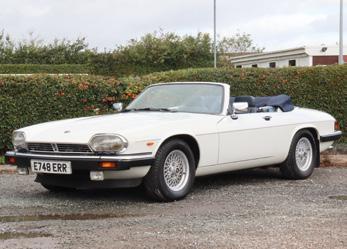
Reg No: BN 1661 MOT: Exempt
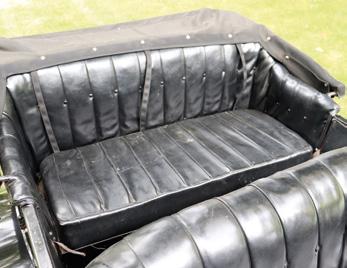
Chassis No: 80801
With the introduction of a moving assembly line in 1913, Henry Ford famously turned his Model T into the world’s first mass made car. A year later, Model Ts represented 56% of all automobile manufacture in the USA at 308,162 units. However, it was not just the sheer volume of Model Ts rolling off the production line that motorised America, it was the inherent quality of the design. Launched in 1908, the T’s chassis and mechanical components were made from exceptionally durable, high-grade vanadium steel. The Ford also featured a compact 2890cc, sidevalve, fourcylinder engine that pioneered the use of a detachable cylinder head. Developing 23hp at a leisurely 1,600rpm and 80lbft of torque, it was mounted in unit with the clutch and two-speed epicyclic gearbox assembly. Top speed was limited to around 45mph depending upon bodywork, whiles brakes operated on both the transmission and the rear wheels. With a 100” wheelbase, 10” ground clearance and transverse leaf-sprung suspension, the T was perfectly adapted to unmade roads.

A well-known car, ‘BN 1661’ has been enjoyed on numerous events throughout the UK and Europe with its most recent outing being the Model T Ford Register of Great Britain’s Irish Tour of Wexford & Cork from July 6th – 12th 2022. Suitably uprated, the four-seater boasts a modern starter motor, alternator, improved brakes and a Warford gearbox (the latter enhancing its cruising capabilities). Riding on solid wheels and said to be ‘ready to go’, it is offered for sale with a V5C Registration Document showing six former keepers. Ford transitioned from brass to painted radiator cars with the former being particularly prized by enthusiasts and collectors.

The SL500 featured a 5.0 V8 producing 326bhp, with 0-62mph in 6.2 seconds and a top speed of 155mph. The model featured many innovations, including electronically-controlled damping, an automatically expanding roll-over bar, and a multi-link rear axle. In addition, there was a fully elec-tric package of an electric roof, windows, door mirrors, and seats, making the ownership experi-ence luxurious, stress free, comfortable, and with easy to operate equipment.

Manufactured in 1991, the SL 500 offered is a UK-supplied, right-hand drive example, being sup-plied new by Normand (Mayfair) Ltd of Wembley and first registered in the UK on the 22nd of February that year. The R129 is fitted with the 4973cc V8 engine allied to the automatic transmis-sion and is finished in Brilliant Silver Metallic paintwork with Royal Blue leather interior uphol-stery, a Blue mohair hood (which was renewed in 2017), and body-coloured hard-top. ‘H616 GLX’ was specified from new with air-conditioning, electric memory front seats, memory mirrors, headlamp cleaning equipment, paintwork preservation, and a heated rear window, amongst other options.
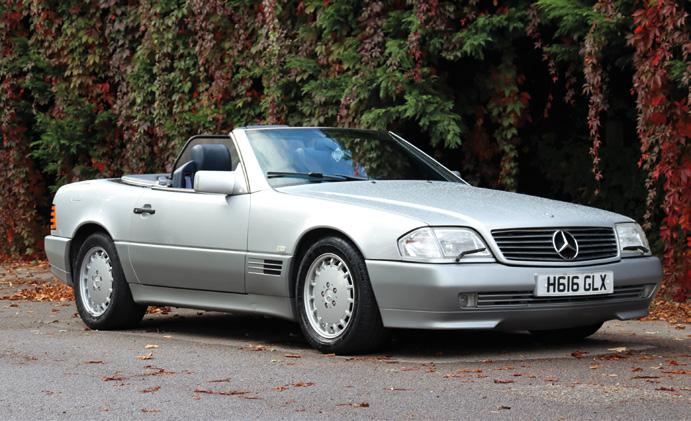
Entering into current ownership in 2009, the SL has been in the hands of just five former keepers and has covered a mere 88,661 miles from new (at the time of consignment). Offered with a history file which includes the original book pack in the Mercedes wallet, with the stamped service book displaying twenty stamps (including the PDI), the majority of which are from MercedesBenz main dealers and specialists. Also included, is a collection of invoices, a large selection of previous MOT certificates dating back to 2002, an MOT certificate until November this year, a current V5C document, and three sets of keys. Rated as ‘very good’ by the vendor in regards to paintwork, bodywork, engine, electrical equipment, gearbox, and interior equipment.


Estimate: £16,000 - £20,000*
American dealers’ demand for TR3 cars led to the definitive TR3, the TR3B. For the collector or connoisseur today, this variant with the extra 20% cubic capacity is both rare and has more ‘poke’ than its predecessors, with a total production run of 3,331 TR3Bs manufactured in 1962.
Chassis number TCF/2561-L was manufactured on the 19th of October 1962, being despatched to the United States on the 29th of October. Supplied new to the first owner through Genser and Forman Inc. of New York, the TR3B was specified from new with a Black tonneau and side-screens, as well as a heater according to the accompanying BMHIT Heritage Certificate. A TCF-series version, featuring the TR4 2138cc engine and TR4 gearbox, ‘308 XVF’ was imported into the United Kingdom in 2018 and purchased by the late vendor, who then embarked on a full restoration, that was completed in March 2019.
The body was removed from the chassis with the chassis refurbished. The TR3B’s bodyshell was restored and repainted in ‘Ice Blue’ paintwork. The engine was provided a full overhaul with new pistons and liners, as well as an unleaded cylinder head. A new fast road cam, Kenlowe fan and exhaust manifold completed the engine refresh with a new wiring loom provided. An ‘A’-type overdrive unit was added to the original gearbox, with the interior completely retrimmed in Mulberry with Mint piping. The tonneau cover, side screens, hood and wind dodgers were all trimmed in Mulberry, complementing the interior upholstery.
Expenditure added up to over £11,000 on the restoration with the TR3B being chosen for a feature in ‘Triumph World’ magazine (Summer 2020 edition). Added to the TR3B Register upon completion, this matching chassis and engine numbers example is offered with a history file that contains the aforementioned BMIHT Heritage Certificate, TR3B Register Certificate, a very large collection of invoices relating to the restoration, a large selection of photographs documenting the restoration, a copy of the ‘Triumph World’ magazine, and current V5C document.
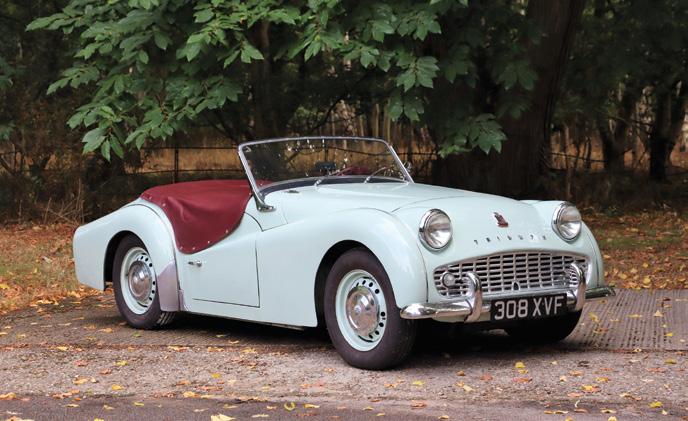


Reg No: WEE 435 MOT: Exempt
Chassis No: K-A2S4-442687
The Mini was actually detuned before launch in 1959. The prototype’s 948cc engine made it embarrassingly rapid compared with other more expensive cars in the BMC group, and it was downgraded to 848cc and 34bhp. A collaboration between racing car builder John Cooper and the Mini’s creator Alec Issigonis, the Mini Cooper debuted in September 1961 with the ultimate 1275cc S variant arriving three years later. Famously winning the Monte Carlo Rally for the third time in 1967, that same year saw the Mini updated to MkII specification complete with redesigned radiator grille, revamped interior, larger rear windscreen and a host of other minor changes. Total MkII Cooper S production across both Austin and Morris brands amounted to just 6,300 cars.
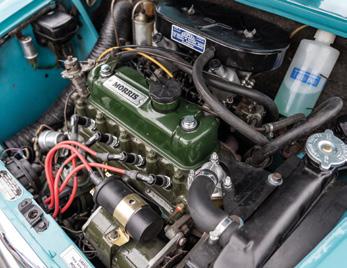
This delightful Surf Blue Morris Mini Cooper was restored to a very high standard a few years ago. An authenticating British Industry Heritage Trust Certificate is on file and states that ‘WEE 435’ was built for the right-hand drive home market and specified in Surf Blue with a White roof. Originally built on the 5th of August 1963, the Cooper was then despatched to Roland C Bellamy in Grimsby.
Being offered from a private collection of Minis, this particular MkI Morris Cooper provides the opportunity to be the custodian of a very collectible model in the great Surf Blue colour scheme. Adding to the ‘look’ are a set of ‘deep rim’ Cooper steel wheels. Certainly, for the future owner, an example of the Mini marque to be proud of at many classic car shows. We have been informed by the vendor that ‘WEE 435’ is running well. Accompanying the Morris Mini Cooper are a selection of old MOT certificates, tax discs and other paperwork, plus the aforementioned British Industry Heritage Trust Certificate.

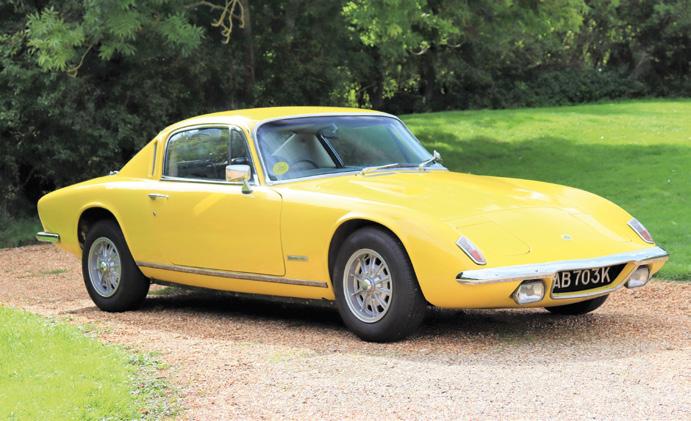
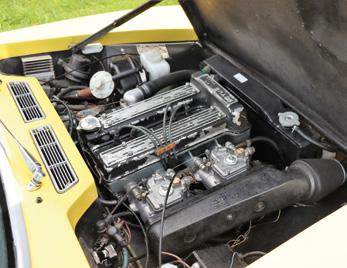

Estimate: £16,000 - £20,000*
According to its accompanying Lotus Classic Certificate of Vehicle Provenance, chassis 7101020360L was completed during January 1971 and originally finished in Lotus Yellow with a Silver roof and Black upholstery. Despatched to Foley Park Motors on 19th February 1971, the Elan +2S 130 changed hands several times thereafter before being bought by marque enthusiast Michael West during February 1992. A designer for Hoover at the time, a subsequent job with Mercedes-Benz in Stuttgart gave him the funds to have ‘LAB 703K’ fully restored and upgraded. Having obtained a new chassis from Fibreglass Services of Arundel (the Lotus Chassis Registration Card for which remains on file), he tasked CVT Classic Sports Cars of Surrey with beginning work on the car in June 1995. However, the following year saw him entrust the project to the renowned, Club Lotus Heritage Approved specialist, Robin F. Alabaster of Aldermaston. Utilising the replacement chassis as a basis, Mr Alabaster undertook a through refurbishment of the fibreglass bodyshell as well as overhauling the steering, brakes and suspension. The ‘twin-cam’ engine was thoroughly rejuvenated by Rapier Services including the installation of an uprated water pump and conversion to unleaded fuel etc. Fitted with air-conditioning (since disconnected), rewired and boasting upgraded driveshafts etc, ‘LAB 703K’ returned to the road in 1997 and was used to commute between Surrey and Stuttgart for a time! Now showing five former keepers on its V5C Registration Document, the Lotus has recently been recommissioned following a period of dry storage. Starting readily and running well during our recent photography session thanks in part to a new WOSP hi-torque starter motor and replacement fuel lines, the Elan +2S 130 is expected to possess a fresh MOT certificate by the time of sale. Three decades after it was applied, the Lotus Yellow paintwork is still bright but not imperfection free. The wood veneer dashboard is cracked in places but overall ‘LAB 703K’ remains a credit to the skill of Robin A. Alabaster and Rapier Services.
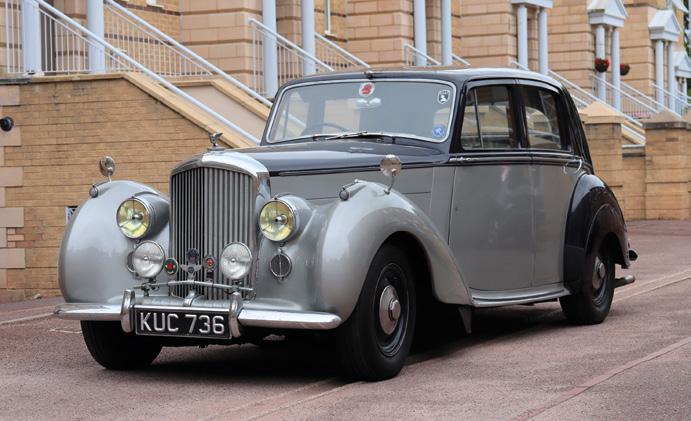
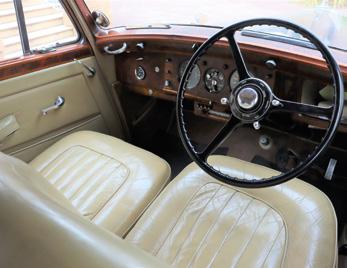
Introduced in 1946, Bentley’s MkVI was the first vehicle ever offered by the company with factory-designed coachwork, and the first to be assembled in Rolls-Royce’s Crewe factory rather than the old Derby premises. Aimed at the emerging ‘ownerdriver’ luxury car market, the newcomer was closely based on the 1939 MkV (of which only fifteen were produced). Built around a massive cruciform-braced chassis with independent front suspension and a leaf-sprung ‘live’ rear axle, it was fitted with a freshly developed 4257cc OISE (overhead inlet side exhaust valve) straight-six engine mated to a four-speed manual gearbox. Capable of over 100mph when clad in the factory’s understated ‘standard steel saloon’ coachwork, the MkVI quickly developed a reputation for being a refined yet responsive drive.
Manufactured in 1949, the MkVI offered was registered new as ‘KUC 736’ to Jack Barclay Ltd of W1 London before being supplied through ‘Bentley Special Retailers’ P. J. Evans Ltd. of Birmingham to the first private keeper, a C. J. Mackay Esq of Edgbaston. Finished in complementary two-tone Silver Grey over Midnight Blue paintwork, with Tan interior upholstery, the Bentley was purchased by the late vendor in 1968 from the fourth private keeper, equating to a mere five private owners from new. Fitted with the four-speed manual transmission, the MkVI displays a recorded mileage of just 46,004 miles at the time of consignment, the Bentley ran well through our photography session. Serviced annually by the late vendor, who was a wellregarded engineer in Rolls-Royce’s Nuclear department, ‘KUC 736’ is offered with the original service handbook, RF60 ‘Buff’style logbook, and a current V5C document, the Bentley is rated as ‘good’ throughout.

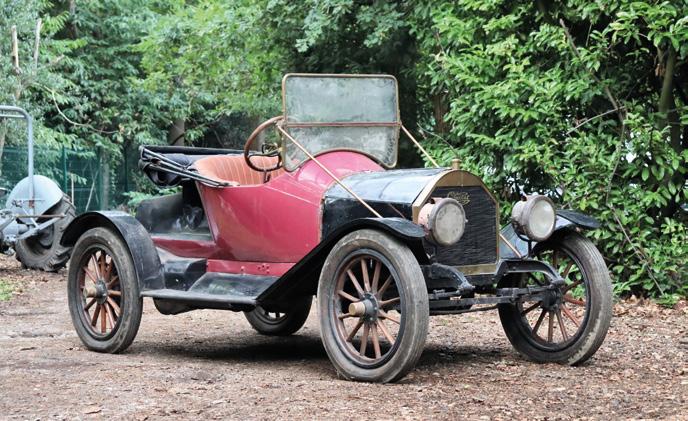

A motoring pioneer who is understood to have begun experimenting with various steam- and internal combustionpowered designs as early as 1887, Byron J. Carter was a founder member of the Jackson Automobile Company fifteen years later. Unable to convince his partners to adopt the friction transmission he devised whereby two discs ran at right angles to each other with the driven disc moving across the face of the driving disc to increase the gear ratio, Carter struck out on his own. Initially based in Jackson, his Motorcar Company relocated to Detroit in search of investment and then again to Pontiac by which time it had been rebranded as Cartercar. Hailed by none other than NASA as a progenitor of CVT (Continuously Variable Transmission) systems, Carter succumbed to a tragic accident in 1908 but not before his company had come to the attention of William C Durant and General Motors. Absorbed by the latter during 1909, Cartercar never achieved the sales success that Durant predicted for it. Ceasing production in 1915 and dissolved the following year just fifty or so Cartercars are understood to have survived to the present day.
Decidedly rare, chassis 363 is known to have been Californian registered during the 1930s before migrating to Mexico and then Texas. A Model R Roadster sat on a 112-inch wheelbase with semi-elliptic front and three-quarter elliptic rear suspension, its 253.9 cu in (4160cc) L-Head four-cylinder engine fed power to the rear wheels via the patented friction transmission and an enclosed ‘silent chain’ drive. Partially restored in Mexico from 2008-2010, accompanying photos show the two-seater running and having attention paid to its bodywork and upholstery. Part of a private collection since 2019, the Cartercar has been NOVA declared but not UK registered. A fascinating ‘what if’, this obscure Edwardian is surely worthy of further restoration and a return to the road. Offered for sale with NOVA declaration and history file with receipts for new spark plugs plus work to the starter motor, upholstery and radiator etc.
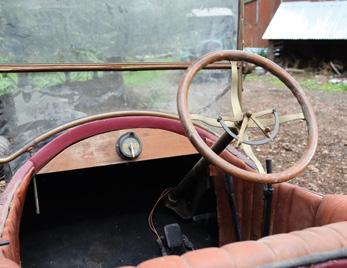

Introduced in 1968, the second generation of Volkswagen’s iconic, forward-control Type 2 which has proven versatile enough to serve as a panel van, minibus, camper van and even fire engine was immediately recognisable due to its adoption of a large single-piece windscreen. Nicknamed the ‘Bay Window’ with the 1968 version referred to as an ‘Early Bay Window’, the newcomer incorporated a revised half-shaft driveline to the rear which not only facilitated an increase in ride height but also improved handling. The T2’s lengthened wheelbase was welcomed by motor caravan builders if only because the increased interior space it yielded made conversion and customisation easier. In 1972 it was facelifted again.
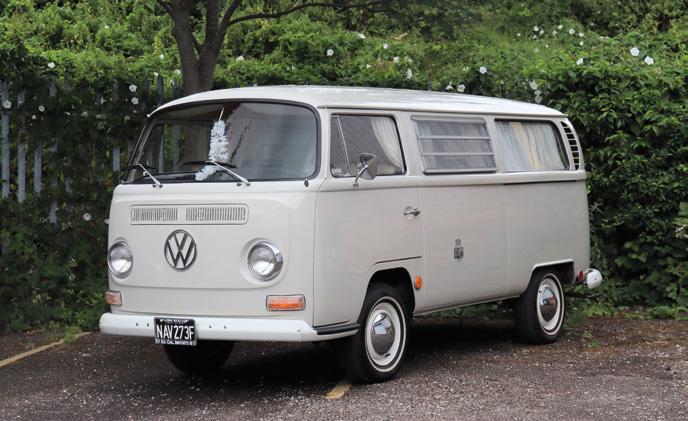
Imported from the USA in 2009, this 1968 VW Type 2 retains features of its Westfalia camper heritage. Westfalia was the designated Camper builder of the VW factory, they offered quality cabinets, which this Camper retains, and a functional interior when new. The 1968 ‘Early Bay Window’ provided greater visibility and practicality. This model is a classic icon and this example wears many attractive features that have given these campers a following as a vehicle, not just as a ‘camper’. Features include: Thin band ‘period correct’ whitewall tyres; deluxe model ‘chrome’ VW badge on the front panel; aluminium rear window ‘jail bars’; reversing lights; side step; glovebox door; VW rubber cabin floor mats. Self-evidently the subject of much restoration work, the interior has also had work and an upholstery re-trim to a high standard, as can be seen from the Cream VW style ‘basket weave’ front seats with matching camper interior seats. There isn’t a ‘pop-top’ roof on this specification, however, no roof leaks to worry about and many like the lines of the un-cut steel roof, as VW intended. More modern compromises for the owner today, include a modern Pioneer in-car entertainment head-unit and inertia reel front seat belts. Accompanying, the Camper is a spreadsheet of previous servicing. The Camper is offered with a collection of invoices, old MOT certificates and a V5C.
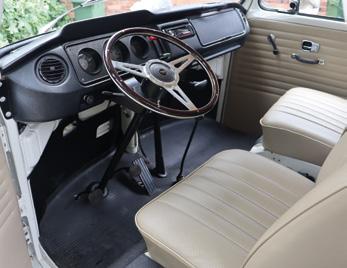
Estimate: £15,000 - £18,000*
Although Victor Gauntlett had long mooted the idea, it took the arrival of Ford money and TWR Group know-how for a new generation, ‘small’ Aston Martin to become a reality. Introduced at the March 1993 Geneva Salon, it’s based around a steel semimonocoque chassis the production version was equipped with all-round independent suspension, four-wheel disc brakes and power assisted rack and pinion steering. Styled by Ian Callum, the DB7 has long been regarded as a modern masterpiece. Priced at circa £80,000 the six-cylinder coupe remained current until 1999 by which time some 1,578 had been sold.
Manufactured in 1996, this DB7 was supplied new to the United Kingdom, being first registered on the 13th of April that year.
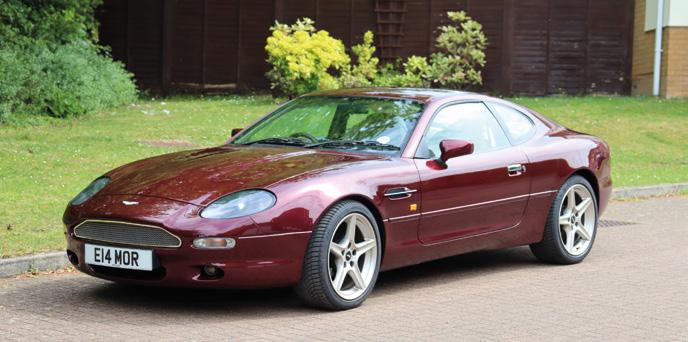
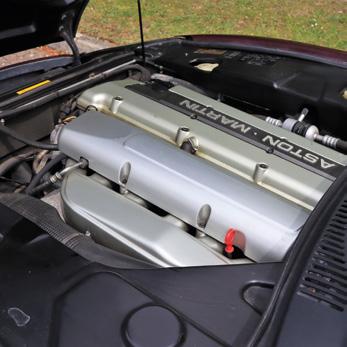
Fitted with the 3239cc straight-six engine allied to the fourspeed automatic transmission, the Aston Martin is finished in the striking colour combination of Maroon paintwork with complementary Cream and Maroon leather interior upholstery. Having just five keepers from new, ‘E14 MOR’ was purchased by the vendor in 2006 from the well-renowned Chiltern Aston Martin Centre and has covered a mere 67,282 miles from new (at time of consignment). Offered with the combined owner’s handbook and service book which displays 30 stamps (including the predelivery inspection) with many of them supplied by main dealers with Lancaster Sevenoaks, H.W.M, Stratstone and JCT600 Aston Martin entries all present, as well as specialists, Chiltern Aston Martin Centre, and a Bosh accredited garage. Most recently serviced in August 2021 (at 66,778 miles) by Chiltern Aston, the DB7 also benefited from new boot struts, air-conditioning regassing and front anti-roll bar drop links and bushes along with further improvement to the cost of some £2,300 in August 2021, along with new tyres. ‘E14 MOR’ is accompanied by several previous invoices relating to work completed and servicing, as well as a selection of MOT certificates, and a current V5C. There are three key remotes present for we the DB7, one in working order, however, two are temperamental.



The Bentley Brooklands was introduced in 1992 as a replacement for the Bentley Mulsanne and Bentley Eight models. It was intended as a slightly cheaper alternative to the Bentley Turbo R. The Brooklands offered here, was first registered on the 7th of March 1996 and delivered by Harwoods of Sussex to a Mr J. Young of Haslemere. The accompanying Factory Build Sheet states that this Brooklands was ordered in Wildberry Mica paintwork with Sandstone Fine Lines and an interior finished in Sandstone hides with Wildberry piping and matching Wilton carpets. For the first four years the car was serviced by Harwoods after which P & A Wood was entrusted with maintaining the Bentley to the highest standards.
As one would expect from an owner who is a Concours Judge at the BDC and RREC, the car is, in his own words: ‘virtually flawless’. The paintwork is still lustrous and blemish-free, the Connolly leather interior is like new and all the woodwork is as it left the factory. The toolkit and spare wheel have never been used and all keys are present, including the wheel lock keys. Even the rear remote control for the radio is still in its pouch. The Service Booklet is fully stamped and there’s a sheaf of invoices from Harwoods and P & A Wood together with MOTs dating back to April 2000, attesting to the lavish care that has been spent on this Bentley.

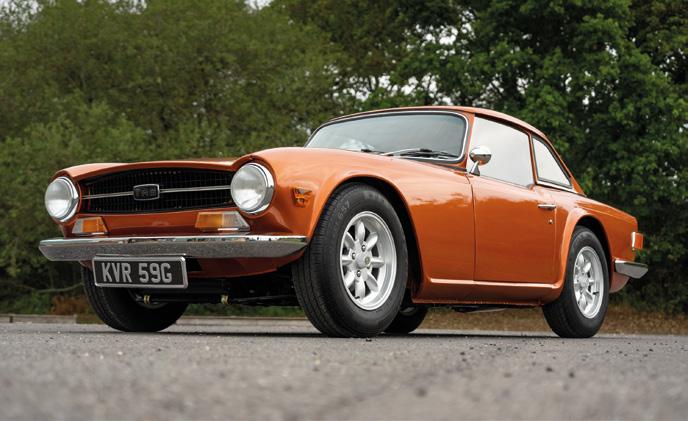
Subject to an extensive restoration
Estimate: £12,000 - £16,000*
Reg No: KVR 59G MOT: Exempt

Chassis No: CC26315LO
Introduced in 1968 as a replacement for the outgoing TR250/ TR5 models, the Triumph TR6 proved a strong seller on both sides of the Atlantic. Crisply styled, its smooth flowing lines and Kamm tail hid a cruciform-braced chassis equipped with allround independent suspension, disc/drum brakes and rack-andpinion steering. Powered by a refined 2498cc OHV straight-six engine allied to four-speed plus overdrive manual transmission, it was deceptively fast with contemporary road testers recording 0-60mph in 8.2 seconds and a 121mph top speed. Writing in 1969, Autocar magazine went as far as to comment that “Even if the Austin-Healey 3000 had not been dropped, the TR6 would have taken over as the he-man’s sports car in its own right”.
This very striking Triumph TR6 has had an extremely extensive restoration, whereupon it was completely stripped and many new panels fitted. With the engine also out of the car, it too was subject to an overhaul along with ancillary components around it. Certainly, a labour of love for the vendor it is now complete and ultimately clothed in striking Bentley Orange Flame paintwork. Due to the vendor’s situation and workload, alas he has been unable to use the car as envisaged, since completion. Any new custodian would need to use the car carefully, in order to ‘run it in’ with the usual fettling that a fresh restoration is deserving of. Accompanying the TR6 are many pictures of the restoration and the extent of work carried out. There are also invoices for some of the parts purchased for the restoration. The specification includes Willwood front disc brakes, Minator 8 spoke Minilitestyle wheels (including the spare wheel), Talbot mirrors and more modern supportive high-back seats. Offered with an accompanying V5C.

Previously known for their side arms and bicycles, BSA. had begun motorcycle manufacture in 1910. A BSA three-wheeler designed by F.W. Hulse using the Hotchkiss 1021cc twin-cylinder engine later emerged. It was a competitor to the Morgan three-wheeler and although less sporting it was more comfortable and easier to drive.
Manufactured in 1934, ‘ABY 977’ is fitted with the 1075cc four-cylinder engine allied to a three-speed manual transmission. Finished in Cream and Black paintwork with Red interior upholstery, the BSA is offered with weather equipment trimmed in Black comprising hood, side screens and full-length tonneau cover. Unfortunately, little is known of chassis number F75770s early history until it was discovered as a resident of the Isle of Man during the 1990s and 2000s. Returning to mainland United Kingdom in 2005, entering the ownership of the previous custodian, the vendor purchased the TW3510 in 2016. Benefitting from much improvement since the vendor’s purchase, the BSA has received an engine overhaul which has included a re-bore, new pistons, replacement white metal rods, an electric cooling fan, and new electric water pump, as well as the fitment of new tyres. With a recorded mileage of 9,740 miles, the vendor rates the paintwork as ‘good’ and the bodywork, engine, gearbox, interior trim and electrics as ‘very good’.

£11,000 - £13,000*
Reg No: LWT 295H Chassis No: OE54H262411 MOT: Exempt
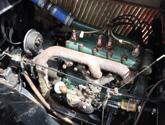

Built from 1959 through to 1974, the ‘Galaxie’ name was used for the top models in Ford’s range in an attempt to capture the excitement of the Space Race in period. Billed as “the newest since 1949”, Ford’s Galaxie underwent a major restyle for 1965, emerging with sharper, cleaner lines, more luxury interior features and coil sprung rear suspension, dramatically improving the ride. There were several trim levels available, including the intermediate 500 series (named after the 500-mile NASCAR events), the sporting XL range or the luxury-oriented LTD.

Manufactured in 1970, this particular Galaxie is offered for sale as a ‘Chicago Police’ homage with, you guessed it, working sirens, blue flashing lights and flashing headlights. Imported to the UK in 2021 and purchased by the current owner from a friend of his, as a fun vehicle to take to the golf course, this Galaxie is mated to a Ford 302 ci ‘Windsor’ V8 with a 3 speed automatic gearbox. Now displaying 78,402 miles on the odometer, ‘LWT 295H’ was recently subject to works totalling over £1000 in June 2022 consisting of the cylinder heads being removed, valves re-ground, replacement gaskets and push rods and a service.


2004 BMW 645Ci
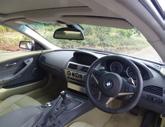

Less than 12,000 miles since new
Estimate: £10,000 - £14,000*
Reg No: EW04 MWA Chassis No: WBAEH72040B524208 MOT: June 2023
The second generation of the BMW 6 Series, designated the E63, was produced by BMW from 2003 to 2010 at the Dingolfing BMW plant. The E63 uses a shortened version of the E60 5 Series chassis and subsequently shares many features. The car initially drew criticism, due to the contro-versial styling of the exterior which was designed by Adrian van Hooydonk, based on the 1999 BMW Z9 concept car designed by the then BMW Design Chief Chris Bangle. To reduce weight, the doors and bonnet are made of aluminium, and the boot and front wings are made of carbon-reinforced plastic. The kerb weight is 1,490–1,930 kg (3,280–4,250 lb).
The 645Ci offered here was originally delivered to Singapore on the 1st of July 2004 and imported into the UK in July 2021. Having covered a mere 11,715 miles from new, this BMW is described by the vendor as being as close to perfect as you can find. Offered with the original handbook, two sets of keys and invoices for servicing carried out in the UK, this BMW 6-Series is an attractive coupe with usable seating for four adults, a large boot for extended holidays and a powerful engine for transcontinental journeys just waiting for its next enthusiastic owner.

Estimate: £16,000 - £20,000*
Reg No: EKP 751K Chassis No: 1S72851BW MOT: Exempt


The Jaguar E-Type wowed the world upon its launch in 1961. Here was a sportscar that offered performance to beat Ferrari and Aston Martin at just half the price, wrapped up in a beautiful muscular body that was unlike any other contemporary sportscar. This combination of style, speed and value endeared it to the world’s elite and the E-Type was one of the coolest cars to be seen throughout the 60s and 70s. The range expanded with a 2+2 derivative joining the Coupe and Roadster and evolved through steady stages until the final Series 3 V12s bowed out in 1975. Weighing just a few pounds more than the smaller 4.2L engine it replaced, the alloy blocked 5.3L V12 produced 272 BHP with vastly improved torque at 349 lb/ft.
Offered here is a 1972 Jaguar E -Type V12 in the 2+2 Coupe Automatic configuration. It is a left-hand drive former USA car that has been repatriated back to the UK and is now available complete with a UK registration number ‘EKP 751K’. With c.24,400 miles displaying on the odometer the 2+2 Coupe does require restoration after a long period of storage. Presenting as a matching numbers car the E-Type is offered with a V5C document.

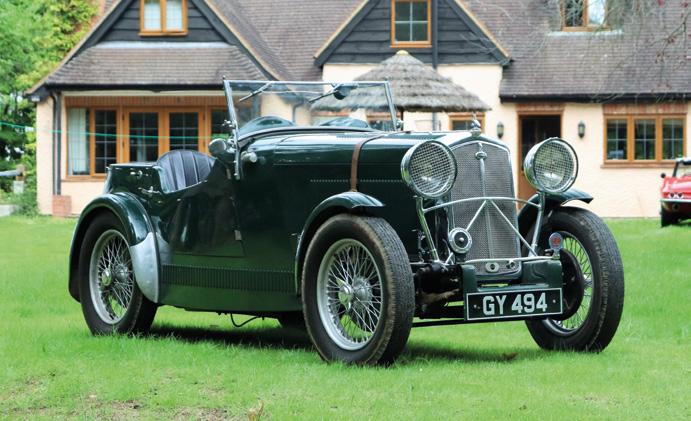
Introduced in April 1932, the Special was a more performanceorientated version of Wolseley’s existing Hornet model. Available in bare chassis guise only, the newcomer was powered by a 1271cc OHC straight-six engine allied to four-speed manual transmission. Clothed by the likes of Avon, Abbey, Swallow, Cunard and London Wolseley dealer Eustace Watkins, the Hornet Special could be had with a variety of open and closed coachwork. A team of three Hornet Specials driven by F.S. Hutchens, B. Wickens and E. Erith won the 1932 LCC Relay Race at Brooklands (averaging 77.5mph for 270 miles). Progressively developed, the sporting Wolseley gained a stronger chassis, crossflow cylinder head and part synchromesh before production ceased in 1935 after some 2,300 had been sold.

Issued with the London registration number ‘GY 494’ on 30th June 1932, this Eustace Watkins Daytona bodied example was still resident in the Heathrow area some forty-three years later. Purchased by Roger Gray as a project in September 1975, it took him until May 1983 to complete the Wolseley Hornet Special’s restoration. The chassis was shot blasted and stove enamelled, a new ash frame made, the bodywork refurbished or refabricated as necessary, the interior re-trimmed and the mechanicals thoroughly overhauled including the stronger 1933 rear axle and engine. Written up in the Wolseley Hornet Special Club’s magazine (Spring 1984 edition), the quality of the workmanship was such that the four-seater won a well-deserved first place at the 1983 WHSC AGM. Belonging to Malcolm Alderton, John Sutton-Coulson, David Lamb, Christopher Rowe and Robert Turner prior to entering the current ownership, ‘GY 494’ started readily and ran well during our recent photography session. Still highly presentable, the four-seater carries a Eustace Watkins dashboard plaque and an ‘EW’ branded spinner for the rearmounted spare wheel. Offered for sale with V5C Registration Document and history file.

Estimate: £15,000 - £18,000*
Reg No: Unregistered MOT: Exempt

Chassis No: 1123455
Along with the Ford Model T, Citroen 2CV and BMC Austin/ Morris Mini, the Volkswagen Beetle is generally recognised as being one of the elite pack of pop motoring icons. Its story is like no other. Sixty-six years of production, over 21 million examples manufactured, factories on five continents, etc. The statistics are as staggering as the car’s history. In 1933, Ferdinand Porsche was instructed to design and develop a ‘Volkswagen’ (People’s Car) that was basic, affordable, and capable of transporting two adults and three children at up to 100kmh. The newcomer finally went into production in 1938 and, while it inevitably evolved over the years, the basic concept was never altered - an enduring tribute to the genius of Dr. Porsche.
Presented in its original Green paintwork complemented by the original Tan interior, this Type 11 ‘oval window’ Beetle was delivered new to the O’Brien family in New Zealand in 1956. The O’Briens kept the car until 2006 when it passed into the ownership of the current vendor. In 1967 the original 1192cc engine was replaced by a more powerful 1490cc. With the odometer showing just 81,204 unwarranted kilometres (50,458 miles) the vendor has described the paint, bodywork, interior, engine and transmission as being ‘Very Good’. Excitingly, the rare, original and complete(!) spare wheel-mounted Hazet toolkit is still with the car. The entire brake system, including all brake cylinders, linings and hoses was replaced in June 2022.

This ‘oval window’ Beetle comes with its original New Zealand registration document from 1956, as well as a modern New Zealand registration showing the current vendor’s ownership. All import duties have been paid by the vendor so all that it needed is for the new owner to apply for a UK registration.
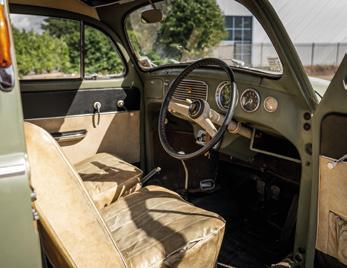


Triumphantly unveiled at the 1961 Geneva Motor Show, the Jaguar E-Type created a furore thanks to its supercar performance, stunning looks and modest price tag. Early racing success at the hands of Graham Hill and Roy Salvadori amongst others helped cement the newcomer’s reputation. Built as a monocoque with an engine cradling front sub-frame, the E-type’s combination of all-round independent suspension and disc brakes allied to rack-and-pinion steering resulted in excellent roadholding and handling capabilities. The indomitable straight-six XK twin-cam engine supplied abundant power. If the design had an Achilles’ heel then it was the recalcitrant Moss gearbox. However, Jaguar was quick to correct this shortcoming with a four-speeder of its own design just part of a continual programme of E-Type development that saw the model metamorphose through three Series. Introduced in August 1968, the Series II cars were distinguishable by their revised bumper and light arrangements. Less noticeable was the increased size of the front air intake that in conjunction with dual cooling fans made the Series II better behaved in hot weather and heavy traffic. With its 4235cc engine developing a quoted 265bhp and 283lbft of torque, it was reputedly capable of nearly 150mph and 0-60mph in 7.5 seconds. Available in open two-seater, fixed-head two-seater and fixedhead 2+2-seater guises, the American market accounted for the vast majority of Series II production.
According to its accompanying Jaguar Daimler Heritage Trust certificate, chassis 1R13091 was initially finished in Regency Red with Beige upholstery (the same combination it pleasingly sports today). Completed on 23rd March 1970 and shipped to New York the following month, the twoseater had relocated to the Isle of Man by the late 1990s. Sent to appraise the Jaguar on behalf of his then employer who had a significant car collection, the vendor was so impressed with the lack of corrosion that he asked to buy it for himself. The E-Type’s sole UK registered keeper to date and used to working on all sorts of exotica, he methodically went through the engine, gearbox, back axle, steering, brakes and suspension. A list on file details the following: replaced o/s front frame due to crack where car had previously been jacked, replaced front suspension bushes, new engine and gearbox mountings, replaced front brake discs, pads and pipes, replaced fuel pump, alternator overhauled, replaced brake servo, rear - replaced brake discs, pads and pipes, powder coat rear axle cage and replace metalistic mountings, replace radius arm bushes, powder coat and overhaul heater assembly, re-chrome bumpers, fit new wire wheels and tyres, fit triple SU carburettors, fit stainless steel exhaust manifold, replace exhaust silencers, replace battery - July 2022, replace interior trim, fit new mohair hood and replace boot trim. The older repaint was deemed presentable enough but is by no means perfect. Starting readily and running well during our recent photography session, the factory-fitted straight-six sounded smooth and powerful. Covering a modest 6,000 miles over the past twenty-four years and riding on MWS wire wheels, recent work has seen a new clutch slave kit installed and even a gear lever bush renewed. Retaining its original LHD configuration and thus ideally suited to Continental touring, ‘WWU 223J’ has much to recommend it. As sound underneath as it is on top, this tempting E-Type Roadster is offered for sale with V5C Registration Document, owner’s wallet / handbooks, assorted invoices and MOT certificates dating back to 1998 (the current certificate remaining valid until August 2023).


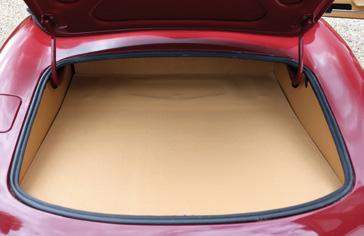

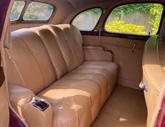
Estimate: £12,000 - £14,000*
Reg No: WSL 733 Chassis No: 13303651 MOT: Exempt
Buick produced a number of RHD vehicles destined for export to RHD countries up until the early 1950s. 1999 produced for export and we believe that just 25% would have been right-hand drive.
‘WSL 733’ is like so many cars from this period has been subject to various levels of restoration work, spread over a number of years, at some point we believe the car had its 5.2 litre engine overhauled. In the mid-2000s much was spent on the Series 80 for mechanical work, including work on; the clutch, gearbox, steering suspension, sump, oil pump, fuel pump, suspension and a brake overhaul. It is also believed that the car was last painted in 2005.
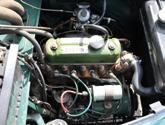
The extensive history file for the car includes a copy of the certificate of registration from South Africa from where the car was exported to the UK in 2001. This is believed to be a matching numbers car benefiting from the dry climate in South Africa. It is likely to be eligible for all manner of pre-war events and able to keep pace with any number of Bentley and other pre-war exotica, which presently can cost so much more. ‘WSL 733’ is offered with a large collection of invoices and details of some of the work carried out since the car was imported.


Estimate: £11,000 - £13,000*
Reg No: YYA 519 Chassis No: AV5/LCS/41948 MOT: September 2023

Introduced in 1956, the Austin A35 could be had as a two- or four-door saloon, two-door Countryman estate or Van. The latter became a familiar sight the length and breadth of the UK serving tradesmen and delivery drivers alike. Powered by three different A-Series OHV four-cylinder engines during its twelve-year production life, the diminutive commercial was surprisingly fun to drive thanks to the provision of independent front suspension, a well-located hypoid rear axle and hydraulic drum brakes. With so many worked into the ground, survivors are comparatively few and far between.
An older restoration which is thought to have spent time on the show circuit (it still carries a plaque for the 2007 Corsley Show), this particular example has been liveried as a ‘Speedwell Performance Conversions’ Van. The London firm certainly tuned more than its fair share of Austin A35s as well as developing British Rally Championship and British Saloon Car Championship winning machinery. Starting readily upon inspection and running well, ‘YYA 519’ was driven to and from this year’s Silverstone Classic (a 160-mile round trip) by the vendor who used it to ferry petrol and tyres around whilst there. Offered for sale with V5C Registration Document, ‘The Book of the Austin A30 and A35’ and MOT certificate valid until September 2023.


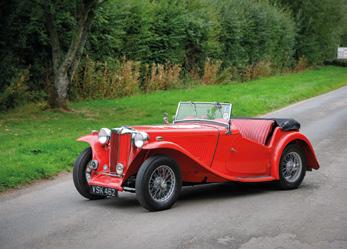
Estimate: £18,000 - £22,000*
Reg No: VSK 462 Chassis No: TC / 7021 MOT: September 2023
The TC was announced within five weeks of the end of WWII. With a wider cockpit, power came from MG’s proven 1250cc OHV XPAG unit, a slight rise in compression ratio lifting output to 54.4bhp and raising the top speed to almost 80mp. It sold exceptionally well, with immense interest in the United States to the point it is stated the TC was responsible for starting the American craze for the British Sportscar. 10,001 TCs were produced with notable owners including HRH the Duke of Edinburgh, who owned one before marrying Queen Elizabeth in 1947.
A factory right-hand drive example exported to the US when new, this 1949 TC was repatriated to the UK by its current owner in 1991. Manufactured in a pleasing MG Red with matching Red leather interior and Red grille, ‘VSK 462’ benefits from the desirable Italmechanica Supercharger upgrade. Now in current ownership for some 31 years, this TC was partially stripped and rebuilt by the vendor in preparation for sale and is offered with an MOT valid until 20 September 2023 for good measure. Included with the vehicle are a number of MOT certificates dating back as far as 1993 and a small collection of previous invoices.
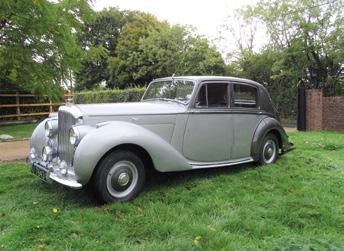
Estimate: £18,000 - £22,000*
Reg No: 7543 F Chassis No: B89HP MOT: Exempt


Introduced in 1946, Bentley’s MkVI was the first vehicle ever offered by the company with factorydesigned coachwork, and the first to be assembled in Rolls-Royce’s Crewe factory rather than the old Derby premises. Aimed at the emerging ‘owner-driver’ luxury car market, the newcomer was closely based on the 1939 MkV (of which only fifteen were produced). Built around a massive cruciformbraced chassis with independent front suspension and a leaf-sprung ‘live’ rear axle, it was fitted with a freshly developed 4257cc OISE (overhead inlet side exhaust valve) straight-six engine mated to a four-speed manual gearbox. Capable of over 100mph when clad in the factory’s understated ‘standard steel saloon’ coachwork, the MkVI quickly developed a reputation for being a refined yet responsive drive.
B89HP was delivered new in September 1950 to a Mr Alfred L. Levy of Rockley Caravan Sales Ltd. During the second half of the 1970s and throughout the 1980s the car was owned by Mr R.J. Wheeler with the Bentley passing into the custodianship of Mr W.M. Wheeler in January 1990. He kept the car until 2021, selling it to Mr S.D. McLaren who then spent close to £17,000 recommissioning and improving the Bentley. Finished in two-tone Grey with a Blue/Grey hide interior, this MkVI is fitted with the 4 1/4 litre straight-six, a manual gearbox and the standard oversized sunroof. It comes with a history file containing invoices, correspondence, factory test records, old MOTs dating all the way back to 1988 and a current V5.
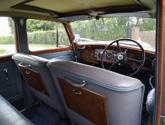
‘The chassis of your T was built at Trafford Park Manchester during the middle of 1918 (possibly July) for supply to the Military. Subsequently, it was bought as Military Surplus by The Slough Trading Company in April 1920 – one of the unidentified mass of vehicles ‘somewhere in Europe’. It was repatriated and refurbished at The Slough Depot and sold through the trade in early 1921. At this relatively early stage of The Slough Company, it is likely to have been the Van as you have it, and that there was only light damage or minor problems – they shifted the easiest to refurbish stock first in order to generate cash flow. This is further illustrated by the fact that you have a standard Trafford Park built Delivery Van with matching chassis and engine number (bulkhead plate)’ (Martin Riley, Librarian to The Model T Register of Great Britain).

Known as ‘Lizzy’, this remarkable survivor was first road registered as ‘AB 6938’ by Worcestershire Council in February 1921 to William McNeil who used it for delivering eggs. Thereafter it is known to have belonged to A. Butterworth of Bury Hall, Wolverley, Ralph Hayes and Mr Hudson before being bought by K. Knapton during 1977. Partially renovated in time to participate in the 1979 London to Brighton Commercial Run, ‘Lizzy’ remained in Mr Knapton’s possession until being bought by P. Chubb during 1991 who in turn sold it to P. Stroud four years later. Treated to an engine overhaul using parts supplied by Tuckett Bros during 2000, the Delivery Van was entrusted to The T Service Ltd of Oxon in 2012 for a carburettor overhaul, new rear hub seals and attention to its handbrake etc. Part of a private collection for the past four years, ‘AB 6938’ participated in The Model T Register’s 2019 Salop Sortie Tour but would now benefit from recommissioning. Offered for sale with V5C Registration Document and history file.

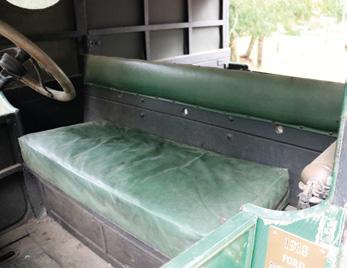
Estimate: £12,000 - £14,000*
Successor to the race-proven (E9) 3.0CS/CSi high performance sports coupes, the 6-series was introduced in August 1976. More forgiving than its predecessors, it utilised a modified version of the (E12) 5-series saloon platform equipped with allround independent suspension (coil and wishbone front, trailingarm rear) and powerful disc brakes. A natural rival to the 928 and XJS, the four-seater 6-series proved more capacious than the Porsche and sportier than the Jaguar. Immediately recognisable thanks to its distinctive ‘shark nose’ frontal styling and thin pillared glasshouse it boasts real road presence. An impression backed up by the various versions of BMW’s mighty M30, SOHC straight-six engine fitted throughout the range. Second only to the BMW Motorsport tuned M6 version, the 635CSi’s 3430cc unit developed some 216bhp and 232lbft of torque (outputs that were reputedly sufficient to propel it from 0-60mph in 8.4 seconds and on to 135mph).
Manufactured in 1986 and supplied new to the United Kingdom in right-hand drive, this 635 CSi is thought to have been sold into London when new, remaining there for around a year before being exported to Spain (although never Spanish registered).
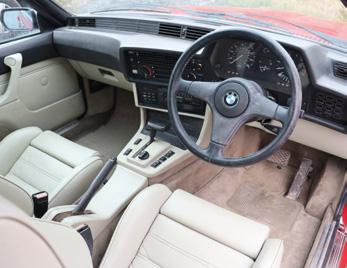
Remaining there under the ownership of a few different family members, until 2017 when discovered by the vendor, the final ten years of this period are understood to have been spent residing under a pine tree. Brought back to the UK to be renovated over the course of four years, the vendor informs the 635 has been sympathetically restored including professional repainting, a comprehensive engine overhaul, renewed brakes, a purpose made exhaust system, and mechanical renewal wherever required. The interior was provided with a thorough cleaning and refresh. Now showing a recorded mileage of approximately 127,000 miles, the BMW was fitted with the aftermarket wheels that it is pictured on, with a set of BBS TRX wheels included.
Accompanied by the mostly complete tool kit, the 635 CSi is accompanied by a no advisory MOT certificate until November 2022 and a current V5C document.

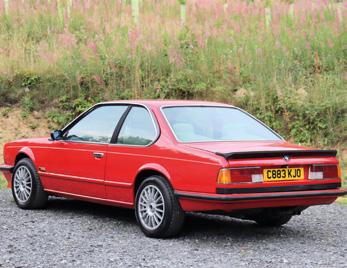
The Model T phenomenon lasted 18 years, but by 1926 even Henry Ford had to admit that the car that ‘put the world on wheels’ had finally run out of steam. No follower of convention, he terminated T production on May 26th 1927 immediately after the 15 millionth example had rolled off the line, despite having nothing to replace it with. Henry himself directed the development of: a new longer, lower-slung chassis; a Howard Hicks-designed 3285cc, fourcylinder engine; three-speed manual transmission and novel electrical system. His son Edsel was appointed to mastermind a scaled-down version of the Lincoln he had guided to success. By the time the Model A made its debut on December 2nd, there was a backlog of 400,000 orders for a car nobody had seen. Nearly 5 million Model As were produced by the time the range gave way to the Model B in 1931.
Finished in Blue over Black with Brown upholstery, this particular example – chassis 4600087 – belonged to New Jersey resident Mr V. Bassani before being bought by the vendor for $16,500 during January 2020. Subsequently imported to the UK and road registered as ‘OXS 620’ thanks to an inspection by the Ford Model A Club of Great Britain, the Roadster presents as an older restoration. Running and driving during our recent photography session, it would nevertheless benefit from a check over / servicing prior to sustained usage. Offered for sale with V5C Registration Document, Ford Model A Club of Great Britain report, copy New Jersey Certificate of Title, copy Bill of Sale and sundry other paperwork.




1
Estimate: £35,000 - £45,000*
The fifth of Rolls-Royce’s stately Phantom models replaced its predecessor in 1959 and was based on the company’s Silver Cloud II model. The notably stiff chassis and generously proportioned wheelbase of 3,683mm were perfectly suited to the coachbuilder’s art and a total of 516 Phantom Vs were clothed by the combination of H J Mulliner, Park Ward and James Young designs before the model was superseded in 1968. Examples built from 1963 onwards benefited from the Cloud III’s engine, which is said to have produced seven percent more power; they also incorporated that model’s revised frontage, with its quad headlamp arrangement and squatter radiator grille.

Chassis number 5VD23 was supplied new to the United Kingdom, being registered new on the 4th of March 1963. Registered new to Capt. George E. Coles Esq of Campden Farm Estates Ltd. Esq, the Phantom was bodied by Mulliner Park Ward to Design 2003 (with glass partition) and is fitted with rare factory air conditioning. Fitted with the aforementioned alloy 6230cc V8 engine with the four-speed Hydramatic automatic transmission, the Phantom is finished in the striking colour combination of Black with a Tan leather interior upholstery. The odometer shows the mileage as 91,187 miles, with the Phantom residing in current ownership since 2017. Subject to £8,000 worth of improvement in August this year with marque specialist Chris Lee’s Ltd., the work completed comprised an interior refresh with attention to the leather and woodwork; a brake refresh with a new master cylinder, brake servo and hoses; new distributor and coil; replaced fuel pump and fuel system flush, and servicing. Featured in the popular TV-series ‘The Crown’ in scenes where the Phantom carries (the then) Prince Charles (portrayed by Josh O’Connor) and Diana, Princess of Wales (portrayed by Emma Corrin), the Rolls-Royce has also found popular culture fame in the music video for Liam Gallagher’s song ‘Once’ where Liam Gallagher poses as a chauffeur for the footballing icon Eric Cantona.
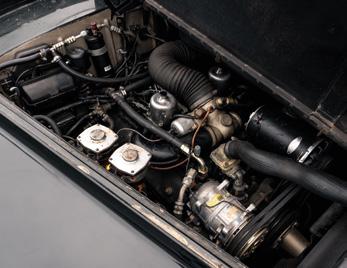
The Mercedes R107 retains a reassuring air of solidity, in an attempt to avoid falling foul of threatened American safety legislation. Allied to this was sure-footed handling courtesy of all-around independent coil-sprung suspension, power-assisted steering, and disc brakes. Always more of a ‘grand tourer’ than an out-and-out sports car, the vast majority of R107s were fitted with automatic transmission. Launched in September 1974, the Eurocentric 280SL was less powerful than its V8 brethren. Powered by a 4520cc SOHC V8 engine, the 450SL model was quoted as developing some 225bhp and 278lbft of torque. A strong 120mph-plus performer, it remained in production until 1980. This American expat’ came into the UK in 2017. Wearing whitewall tyres and stateside specification twin headlights and larger federal bumpers with over-riders, this is a V8 example that has ambled and cruised in the American sun. There is the ability for an owner to utilise the soft top, with the convenience of having the hardtop ready for the inclement UK days listening to the period rangetopping Becker Mexico radio in comfort. It has clocked up just 42,250 credible recorded miles in its life and is offered with a V5C on an appropriate ‘R’ suffix number plate.

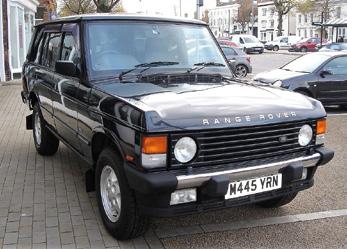
Estimate: £25,000 - £30,000*
M445 YRN Chassis

SALLHBM33MA652904
October 2023
There was always scope to produce a vehicle that combined the no-nonsense Land Rover’s off-road prowess with a greater degree of on-road chic and comfort. Though various plans were mooted in the 1950s, it was the emergence of the American SUV a decade later that finally convinced Rover to create such a model. Spen King famously oversaw the ‘100-inch Station Wagon’ project that was finally revealed as the Range Rover in 1970. The David Bache-penned newcomer was powered by the ubiquitous Rover V8 which was connected to a permanent four-wheel drive system for optimum traction.
A rare LWB model offering rear passengers an additional 20cm legroom, this particular example was supplied new to the car-friendly climate of Japan where it was serviced eleven times before being repatriated during 2020 with a warranted odometer reading of 120,282km (74,740 miles). Since UK road registered as ‘M445 YRN’, the four-door Classic is rated by the seller as being in ‘good’ (interior trim) or ‘very good’ (engine, automatic transmission, electrical equipment, bodywork, paintwork) condition. Converted from air to coil suspension but with much of the gubbins for the former left in situ, this ‘original, unrestored, last of the soft dash Rangies is offered for sale with V5C Registration Document, history file and fresh MOT certificate.

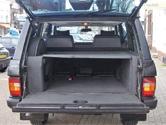

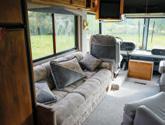
Estimate: £12,000
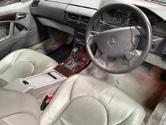
£15,000*
The fourth generation of Mercedes-Benz’s much-vaunted SL model (the R129 Series) was launched at the Geneva Motor Show of 1989. It was a beautifully-engineered motorcar that bristled with technical refinement and innovative safety features. The specification included independent suspension all round (double wishbone at the front/five link system at the rear), adaptive damping, ventilated disc brakes with ABS, electronic stability control, integral roll-over bar and front air bags. When introduced in 1993, the SL320 variant featured a DOHC in-line six-cylinder engine of 220bhp and was continued through to 2002, following a facelift and change of engine in 1998.


With only 74,000 miles from new in the hands of four careful owners (two in the last eighteen years), this lovely SL is reluctantly offered for sale due to the new ULEZ restrictions in the City of London. Presented for sale in very good order throughout, the stunning Obsidian Black Coachwork is complemented by a Grey Leather interior and recently refurbished upgrade Alloy Wheels. The Service Book and a thick sheaf of accompanying invoices confirms regular maintenance (mainly Main Dealer) with apparently a ‘no expense spared attitude at all times’. Only a few hundred miles have been covered since the last service was carried out. The vendor confirms that the SL drives ‘very well’ and that the roof mechanism operates as it should.
One of the biggest names in North American RVs, Safari Motor Coach was founded in Oregon in 1986. Its aim was to build a high quality, supremely well-specified motor home offering unmatched value for money. From these humble beginnings this small company would grow to command a major slice of the market. In 2001 Safari was purchased by another Oregon manufacturer, the Monaco Coach Corporation, which had established itself as one of the foremost makers of ‘highline’ luxury motor homes and diesel coaches.
An example of Safari’s flagship Serengeti model which includes a full bathroom; washer/dryer; queen-sized bed and a sofa bed, this particular Serengeti has been in current ownership since April 2012. Used approximately four times per year as a base by the vendor when competing in historic motorsport, including Historic Formula 1, Formula Junior and much more with trips as far as Spa and Zandvoort, this RV would now benefit from some light recommissioning work after having been last used at the Goodwood members meeting in March of this year. Worth noting, is that the engine and generator are started on a monthly basis and the RV is moved around the yard it is stored. Now showing just 44,198 miles on the odometer, the vehicle is offered with a history file containing a number of previous MOTs and invoices, some import documentation confirming duties are paid and the current V5C document which shows 1 former keeper.

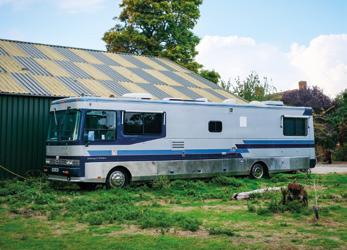
Reg No: DU 490 MOT: Exempt

Chassis No: 140

Widely acknowledged as Britain’s first popular light car, the Humberette was introduced in 1903. Assembled at both Humber’s Coventry and Beeston works, its lightweight tubular steel chassis frame was an apt reminder that the marque’s roots lay in the bicycle industry. Equipped with all round leaf sprung suspension and contracting band rear wheel brakes, it was powered by a water-cooled, 613cc single-cylinder engine that developed some 5hp @ 1,500rpm. Admirably advanced, it used shaft drive where many of its competitors persisted with chains and featured a two-speed manual gearbox. Reputedly capable of 25mph, the presence of “a hand wheel on the Humber Olympia differential system” greatly assisted with highspeed manoeuvres.
Issued with a Certificate of Dating by The Veteran Car Club of Great Britain on 16th July 1958 (photocopy on file), chassis 140 has participated in numerous London to Brighton runs. Believed but not warranted to retain much of its original paintwork, the Humberette’s leather upholstery has a great deal of age about it too. Sporting a Brevet carburettor, Lucas King of the Road sidelamps and wire wheels, the two-seater’s ‘DU 490’ number plate was first issued by Coventry Council. Previously belonging to W. Faulkner Esq of Witney, it was acquired by the seller in 1998 and entered for the following two years’ London to Brighton runs. Not started for some time, the Humberette will require recommissioning/ servicing prior to use. Worthy of close inspection, this delightful Veteran is worthy of close inspection. Offered for sale with V5C Registration Document and sundry paperwork.



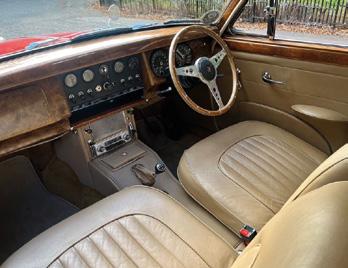
Estimate: £22,000 - £26,000*
Chassis No: 170203DN
More widely admired than any other Jaguar sports saloon, the MKII now seems synonymous with the 1960s. Built as a monocoque, it featured independent coil-sprung front suspension, a welllocated ‘live’ rear axle and all-round disc brakes. Available in 2.4 litre, 3.4 litre and 3.8 litre guises, the larger-engined variants soon became known as capable sports saloons. A reputation underscored by their racing siblings’ numerous track victories against assorted Mini Cooper and Ford Galaxie etc opposition.
The 3.4 litre cars boasted some 210bhp and 216lbft of torque, outputs sufficient to ensure a circa 120mph top speed and spirited acceleration especially when fitted with the desirable four-speed plus overdrive manual gearbox.
According to its accompanying Jaguar Heritage Trust Certificate, chassis number 170203DN was completed on 7th December 1965 complete with engine number KJ8597-8 (the block of which it retains to this day) and four-speed manual plus overdrive transmission. Despatched to Spink of Bournemouth that same month, the Jaguar was bought by R.W. Ford of Poole and road registered as ‘FLJ 558D’ on 3rd February 1966. Still resident in Dorset some forty-seven years later when it was sold to M. Cumberland for £29,000, the MKII graced the front cover of The Dorset Jaguar Magazine in March 2014. Restored prior to then, the sports saloon had acquired its current Carmen Red paintwork, Beige leather upholstery, power steering, Coombs-style rear wheel arches and wire wheels. The subject of significant recent expenditure - new water pump and exchange radiator (2016, £902.34), front suspension overhaul (2017, £495.47), mechanical and bodywork fettling (2018, £2,151.61), front chassis leg repairs, new engine mounts, upgraded brakes, fresh radiator mounts, undersealing etc (2021, £6,347.97), Moss gearbox refurbished, overdrive reconditioned (2022, £3,100) – ‘FLJ 558D’ was issued with a ‘no advisories’ MOT certificate on June 29th 2022 at an indicated 75,928 miles. A seemingly well-sorted and presentable example, this appealing MkII has much to recommend it. Offered for sale with V5C Registration Document and history file.
£20,000 - £25,000*
Introduced at the 2003 Geneva Salon, the Continental GT was the most technologically advanced Bentley in generations. Powered by the marque’s first all-new engine since 1959, its twin-turbocharged 5998cc W12 was allied to six-speed ZF Tiptronic transmission. With a quoted 552bhp and 479lbft of torque on tap plus Torsen-based permanent four-wheel drive, the 2+2-seater GT was reputedly capable of 0-60mph in 4.8 seconds and 198mph. A deft blend of muscularity and elegance, the two-door coupe’s lines were the work of Dirk Van Braekel. Equipped with sophisticated independent suspension and ventilated ABS disc brakes all-round, the Continental GT proved an accomplished transcontinental express.
The Bentley Continental GT offered here was first registered on the 4th of January 2005 and delivered by Bentley Manchester to its first owner, a Mr. P.J. Bailey of Whitmore, Staffordshire. Finished in a striking Silverlake Blue Metallic paintwork with a Cream and Blue hide interior and fastidiously serviced by its supplying dealer, he kept the car for five and a half years before selling the Bentley to a Ms. A. Burke of Sarisbury Green, Southampton. During her ownership the car was kept maintained by Bentley Hampshire before being acquired in July 2013 by Sir Anthony Jolliffe, Lord Mayor of London from 1982 to 1983. He kept the Continental GT for almost seven years and had it serviced by specialists during his ownership. The current vendor bought the Bentley in July 2020 and has had it serviced by Bentley Specialists The Beaconsfield Workshop, who have just completed a full service on the car. Only being sold due to the advancing age of the vendor, this very well looked after Continental GT has covered only 43,942 warranted miles since new and comes with a full history file and a current V5C.
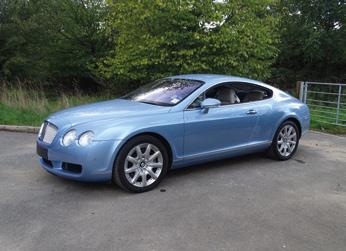
2009 Mercedes-Benz CL500
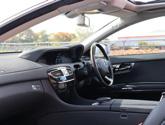
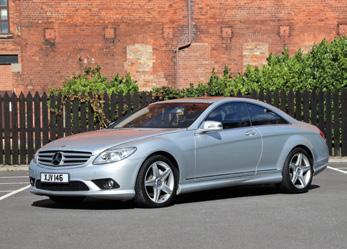
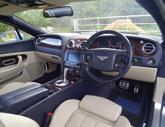
Warranted 50,000 miles from new
Estimate: £12,000 - £14,000*
Reg No: HV59 UAF Chassis No: WDD2163712A024291 MOT: October 2023
239
‘Mercedes’ stated aim with the new CL was to build ‘the best luxury coupe in the world’ – what else? The engine is virtually inaudible at city speeds, adding to excellent overall refinement’ (Evo magazine, October 2006).
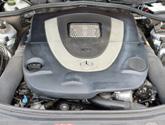

Launched at the 2006 Paris Salon, the C216 generation of Mercedes-Benz’s long-running S-Class Coupe was styled by Gorden Wagener and Peter Pfeiffer. An extravagant 2+2-seater intended to do battle with the Aston Martin DB9 and Bentley Continental GT, the newcomer was powered by various V8 and V12 engines with the CL500 reputedly capable of 0-60mph in 5.4 seconds and 155mph (limited). As technologically advanced and cossetting as its S-Class underpinnings would imply, the pillarless ‘Benz also boasted a wonderfully cocooning interior.
Finished in Iridium Silver metallic with Anthracite Black leather upholstery, this particular example has covered 50,000 miles from new (a figure corroborated by ten main dealer services). Visually enhanced via an AMG Sport Pack, 19-inch AMG alloy wheels and Black Ash wood trim, ‘HV59 UAF’ still has a wow factor about it. Close to £100,000 when it left the showroom, this decidedly smart CL500 is offered for sale with V5C Registration Document, book pack, digital service history printout and two keys.

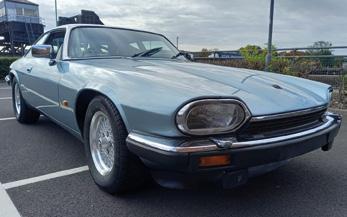

39,000 miles from new
Estimate: £12,000 - £14,000*
Reg No: K792 NML Chassis No: SAJJNAEW3EP185560
October 2023
Launched in 1975, the XJ-S could only cheat time for so long and in 1991 parent company Ford thoroughly reworked the luxury grand tourer at a cost of £50 million. With its sheet metal incorporating some forty percent new panels, the rejuvenated model range sported a revised grille, headlamps, taillights, bumpers and rear wings. While its cabin gained a new walnut trim fascia and improved sports seats. Powered by either a punchy straight-six (3980cc) or soporific V12 (5343cc) engine, the latter SOHC unit was quoted as developing some 280bhp and 306lbft of torque. Featuring smooth shifting automatic transmission as standard, the 5.3 litre XJS was reputedly capable of 0-60mph in 7.5 seconds and 150mph. Yet for all its performance capability, the Jaguar proved a refined and relaxing drive.
Supplied new by Harvey Hudson & Co Ltd of Woodford, ‘K792 NML’ is warranted to have covered some 39,000 miles from new. Serviced at 834, 1,437, 2,361, 3,434, 4,171, 5,984, 7,860, 9,633, 11,318, 18,598, 26,518 and 30,849 miles prior to being acquired by its current registered keeper in May 2003, the Jaguar’s accompanying service book carries two further stamps at 35,553 and 38,139 miles. Taken off the road approximately fourteen years ago, this appealing low mileage V12 XJS has recently been recommissioned and will be presented for sale with a fresh MOT certificate.
Estimate: £11,000 - £13,000*
The third generation SL (R107) was launched in 1971, initially with just a 3.5-litre engine (350SL) mated to a four-speed automatic transmission. The car featured a two-door monocoque bodyshell with independent suspension and disc brakes all-round. Over its phenomenal 18-year reign, the R107 range was powered by eight different engines - two sizes of straight-six and six versions of Mercedes-Benz’s silky smooth V8. The V8-powered 560SL was manufactured from 1986 to 1989 and only offered in the US, Japanese and Australian markets. With 227bhp on tap it was a genuine 130mph car, with ample reserves of effortless acceleration.
A 1986 Mercedes-Benz 560SL, this is a third generation R107 with an automatic transmission. Built for export to the USA, the car has been repatriated to European shores and is now fully UK registered. Displaying 144,000 miles on the odometer the ‘C631 XRT’ is offered with the factory hardtop. Tan leather upholstery complements the interior well and there is a Blaupunkt Miami Beach CD/radio fitted in the dashboard. Externally, the US specification includes the boot mounted high level brake light and the usual SL front fog lights, mounted more centrally under the bumper. An MOT runs into June 2023. The vendor says it starts, runs and drives. Accompanying this V8 version of the SL, is the bookpack, stamped service book and two keys.



The motorised ‘High Wheeler’ – in many ways the exemplar of a horseless carriage – was a popular design concept during the early twentieth century especially among rural communities where its familiar looks, lower price and (puncture free) solid rubber tyres found particular favour. Succumbing to a patent infringement lawsuit, High Wheeler manufacturer Kiblinger of Auburn, Indiana was bought out by its factory manager, W.H. McIntyre in 1909. Duly named after him, the new venture offered no fewer than ten High Wheelers from Runabouts to Surreys to Tourings. Marketed as ‘Cheaper than Horses’ and ‘The right car for the most people’, they were powered by a range of twoand four-cylinder engines allied to planetary transmission and utilising chain drive. Dropping High Wheelers in favour of more conventional Low Wheelers by 1911 and dabbling with cyclecars too could not prevent McIntyre from ceasing production during 1915 after some 1,699 cars had been completed.
Identified by the Pre-’50 American Auto Club as a Model NN dating from 1909, chassis 73 was thus originally built on a 191cm wheelbase and fitted with an 18.2hp twin-cylinder engine. Previously resident in Kansas, the McIntyre was imported by renowned Ford Model T specialists, Tuckett Bros, during 2008. Entering the current ownership five years later, the High Wheeler has not run for some time and as such will require recommissioning / checking over. One of just 264 McIntyres (across all model types) produced in 1909, ‘BF 7732’ is a very rare survivor. Offered for sale with V5C Registration Document and sundry paperwork.
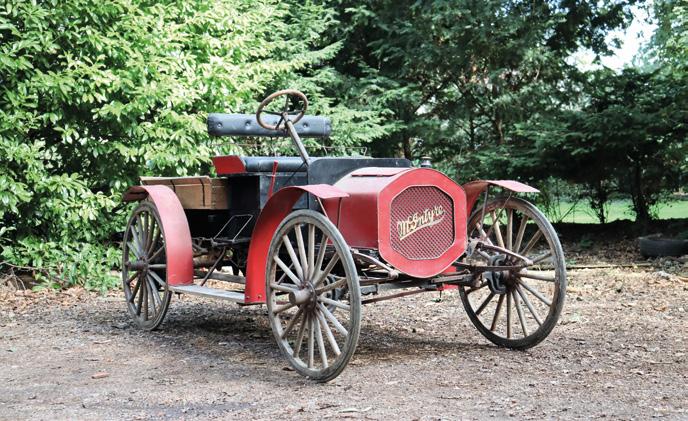

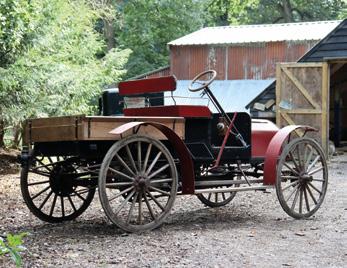
Estimate: £16,000 - £19,000*
Introduced in 1968 as a replacement for the outgoing TR250/TR5 models, the Triumph TR6 proved a strong seller on both sides of the Atlantic. Crisply styled, its smooth lines and Kamm tail hid a cruciform-braced chassis equipped with all-round independent suspension, disc/drum brakes and rack-and-pinion steering. Powered by a refined 2498cc OHV straight-six engine allied to fourspeed plus overdrive manual transmission, it was deceptively fast with contemporary road testers recording 0-60mph in 8.2 seconds and a 121mph top speed. Writing in 1969, Autocar magazine went as far as to comment that “Even if the Austin-Healey 3000 had not been dropped, the TR6 would have taken over as the he-man’s sports car in its own right”.


Rescued from a Pennsylvanian scrapyard by its previous registered keeper in 1992, chassis CF/9150-U was subsequently repatriated and treated to a meticulous, multi-year restoration. Benefiting from a brand-new chassis, bodywork renovation, new interior, fresh wiring and refurbishment of its steering, suspension and brakes etc, the Triumph had its engine, gearbox and overdrive professionally overhauled by Peter Cox of Moss Europe (with the 2.5 litre straight-six being converted to unleaded and uprated to Stage 3 specification). UK road registered as ‘FTM 509L’ on April 13th 1995, the TR6 was used for numerous jaunts around the UK and Europe thereafter including a 3,000-mile Alpine Tour during 2000. Suffering a punctured oil cooler whilst in Scotland five years later, the twoseater was then taken off the road and given a further engine refresh as well as undergoing a colour change from Carmine Red to its present Jasmine hue plus a new clutch, poly bushed suspension, Aeroquip brake hoses and replacement carpets etc. Featured in Classic & Sportscar magazine’s 2009 Calendar, the Triumph passed to its present (second UK) registered keeper during August 2017. Riding on correct-type steel wheels, this appealing TR6 is offered for sale with UK V5C Registration Document, various restoration photos, numerous old MOTs and a wealth of invoices / receipts.
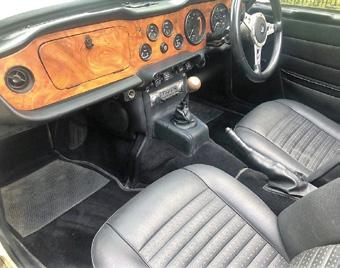
Launched in 1975, Jaguar’s XJS was never envisaged as a direct replacement for the E-Type. More of a soporific grand tourer than an out-and-out sports car, it was designed to seamlessly blur borders rather than blast down back roads. Introduced at the 1988 Geneva Motor Show, the long-awaited full convertible version featured a reinforced floorpan, frameless doors and a sophisticated electric hood.

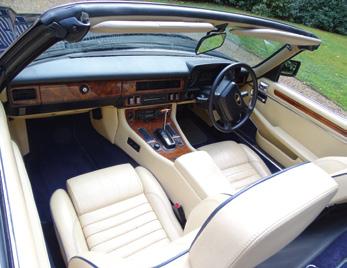
Manufactured in 1990, the XJ-S offered here was supplied new via Harwoods of Sussex to a Mr P. Kirch in London, being delivered on the 4th of January 1990. Pleasingly still displaying its Harwoods of Sussex rear window sticker, the Jaguar is finished in the attractive colour combination of Westminster Blue paintwork with complementary Beige leather interior upholstery and a Dark Blue hood. Fitted with the 5343cc V12 engine allied to the automatic transmission, UPO 1N has covered a mere 54,658 miles from new in the hands of only six keepers since first delivery.
The XJ-S, which is believed to still carry its original paintwork and hide interior, is accompanied by the owner’s handbook, the original stamped service book illustrating 18 stamps (the first 11 from Jaguar main dealers and the rest by Jaguar Specialists), a collection of previous MOTs, invoices and a current V5C document. The vendor rates the bodywork, electrical equipment, gearbox, paintwork, engine, and interior trim as ‘very good to excellent’.

Reg
Chassis
With the introduction of a moving assembly line in 1913, Henry Ford famously turned his Model T into the world’s first mass made car. A year later, Model Ts represented 56% of all automobile manufacture in the USA at 308,162 units. However, it was not just the sheer volume of Model Ts rolling off the production line that motorised America, it was the inherent quality of the design. Launched in 1908, the T’s chassis and mechanical components were made from exceptionally durable, high-grade vanadium steel. The Ford also featured a compact 2890cc, sidevalve, fourcylinder engine that pioneered the use of a detachable cylinder head. Developing 23hp at a leisurely 1,600rpm and 80lbft of torque, it was mounted in unit with the clutch and two-speed epicyclic gearbox assembly. Top speed was limited to around 45mph depending upon bodywork, whiles brakes operated on both the transmission and the rear wheels. With a 100” wheelbase, 10” ground clearance and transverse leaf-sprung suspension, the T was perfectly adapted to unmade roads.

Looking somewhat older courtesy of its brass radiator, windscreen surround and lighting set, this particular example is understood to date from the final few years of Model T production. Previously registered to Brian Belcher of the renowned preWW2 Ford specialist, Belcher Engineering, the Roadster joined the vendor’s collection during 2000. Deemed to be in ‘good overall’ condition, the two-seater has not run of late and so will need recommissioning / servicing prior to use. Uprated with an alternator, it also sports wire wheels (a comparative rarity on a Model T). Offered for sale with V5C Registration Document.

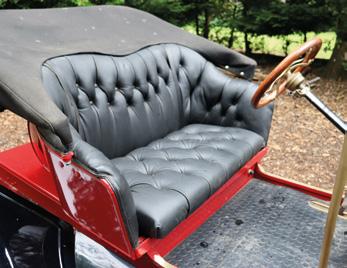
The Mini was actually detuned before launch in 1959. The prototype’s 948cc engine made it embarrassingly rapid compared with other more expensive cars in the BMC group, and it was downgraded to 848cc and 34bhp. A collaboration between racing car builder John Cooper and the Mini’s creator Alec Issigonis, the Mini Cooper debuted in September 1961 with the ultimate 1275cc S variant arriving three years later. Famously winning the Monte Carlo Rally for the third time in 1967, that same year saw the Mini updated to MkII specification complete with redesigned radiator grille, revamped interior, larger rear windscreen and a host of other minor changes.

First registered in November 1966 and built as a RHD MkI, originally for personal export to Iran, it is entered from a private collection of Minis. Previously the subject of an older restoration that is holding up very well and would be a delight to own in the iconic combination of Tartan Red with a Black roof. Among the invoices are bills from Martin Bowen at Eardisland Garage, Herefordshire, in 2000, to overhaul; the fuel pump; clutch; lights; exhaust, rear brakes, exhaust and cooling system. In 2015 the head was ported and polished to ‘fast road’ specification by Brett Sims Motorsport.
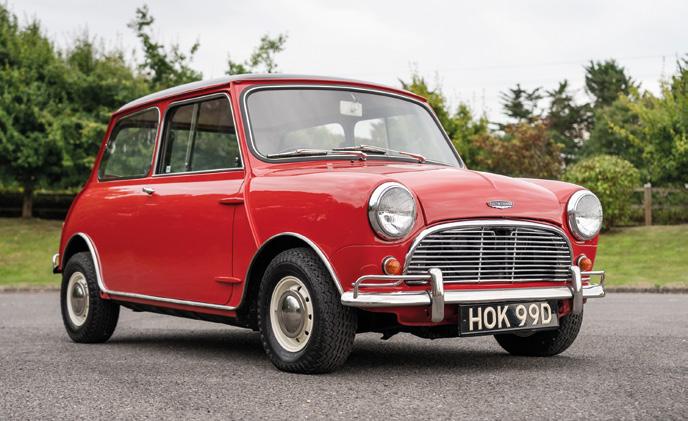
Nicely detailed throughout, this 998cc Mini Cooper has the benefit of a gas-flowed cylinder head, original interior and alloy Cooper-style wheels. The accompanying history file includes a British Motor Industry Heritage Certificate confirming the car’s status as being built in June of 1965, in Tartan Red with a Black Roof, old invoices and previous MOT history with certificates dating back to 1969.

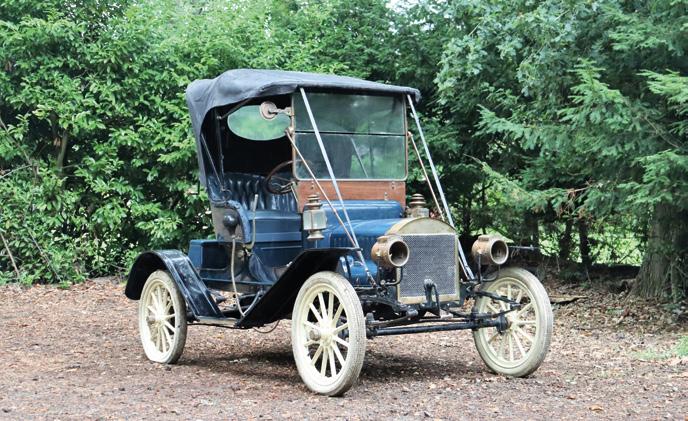

Reg
Founded in 1904 by Jonathan Maxwell and Benjamin Briscoe, the Maxwell-Briscoe Motor Company soon developed a reputation for the quality and durability of its products. Powered by flat twin-cylinder engines and bedecked with Runabout / Roadster coachwork, early Maxwell cars featured mechanically-operated inlet valves, thermo-siphon cooling and shaft drive. An eager participant in the American Automobile Association’s legendary Glidden Tours held between 1905 and 1913, Maxwell was one of only three teams to complete the 1911 event with a perfect score (an impressive feat after 1,476 miles of time checks). Migrating from Tarrytown, New York to a purpose-built factory in New Castle, Indiana during 1907-8, Maxwell began to experiment with four-cylinder designs. Although, the twin-cylinder models which so neatly embodied the company’s ‘Simply Perfect, Perfectly Simple’ motto remained a staple part of the range until 1912 (by which time the Messenger was listed at $625).
Finished in Blue over Black with Blue deep-buttoned upholstery, this particular right-hand drive example was imported by the vendor from Kansas during 2006. UK road registered as ‘BF 7365’ some nine years later, it has not run for some time and as such will require recommissioning / checking over prior to use. The headlamps lack lenses and the engine carries the same number as the chassis. More usable than many ‘Brass Era’ cars, two-cylinder Maxwells have a surprising turn of speed. Offered for sale with V5C Registration Document and sundry paperwork.
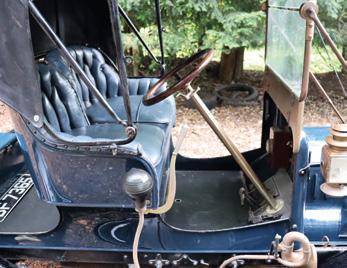
Triumph’s TR Series began with the unveiling of a prototype at the 1952. The newcomer’s 1991cc four-cylinder Vanguard engine sported twin SUs and was tuned to produce 90bhp. Motor magazine’s road test of a TR2 in 1954 achieved 11.9 seconds for the 0-60mph sprint and an ultimate speed of over 107mph.


Chassis number TS/6692-O was manufactured in the United Kingdom on the 9th of June 1955 in right-hand-drive configuration. Destined for Bulawayo, Southern Rhodesia (now Zimbabwe), the TR2 was finished in Signal Red and with a Stone interior and Fawn hood, being originally specified with a cable operated overdrive (which has since been removed). The Triumph is believed to have been rallied in its time due to the finned bonnet, spare fanbelt clipped around the timing chain cover, previous radiator amendments, and believed engine fettling. Repainted in Orange at some stage prior to being exported to Holland in 2005, ‘498 UYN’ was retained in the hands of one Dutch owner for some ten years, being driven around Europe extensively.
Driven to England for the 2015 TR International weekend at Malvern, it was spotted by the late vendor and a deal was struck to buy the car. This was much to the annoyance of the Dutch-owners girlfriend, Marge, who jokingly commented ‘I only went out with him because of the car!’ – and who the Triumph is named after. A pleasingly unmolested example displaying delightful patina, the TR2 has been subject to much mechanical improvement since entering current ownership. In 2021, ‘498 UYN’ has received a new alternator and renewed seat springs and seat upholstery. A matching chassis and engine numbers example, the car was the feature of a five-page article in ‘Triumph World’ magazine (August/September 2017 edition). Accompanied by a history file which includes the original instruction book, a collection of invoices from the period in Holland and the UK, a copy of the ‘Triumph World’ magazine, older photographs of the car, a copy of a BMIHT Heritage Certificate, and current V5C document.


Reg No: NF 985 MOT: Exempt
Chassis No: 109887
The first model series to be introduced after the Flint, Michiganbased company had become part of General Motors, the Buick Four was in production from 1908-1918. An advanced design, its in-line four-cylinder powerplant featured overhead valve gear and was allied to three-speed manual transmission.

Available in Phaeton, Roadster and Touring guise, the Buick was underpinned by a sturdy ladder frame chassis equipped with allround leaf-sprung suspension (semi-elliptic front / three-quarter elliptic rear) and rear wheel brakes. Made from high quality materials, the Four proved a great sales success. Debuting in 1915, the Model C-37 was a five-seater Touring car propelled by a 3.6 litre engine (rated at 37bhp). Featuring a ‘Streamline Body’ and electric lighting set, it was priced at $1,235 and achieved some 12,450 sales. Though, today survivors are comparatively few and far between.
Finished in Black with Maroon upholstery, this particular example is rumoured to have appeared in the Brad Pitt film ‘Legends of the Fall’ or at least that is what the vendor was told when he bought it (sadly, there is nothing on file to substantiate the claim). Seemingly very original, the Buick still carries its correct specification Marvel carburettor, Jacox steering box and Delco starting, lighting and ignition system. Not run for some time, the Model C37 will require recommissioning / servicing prior to use. Entering the current ownership in 2016, this handsome and powerful Edwardian Touring car is offered for sale with V5C Registration Document.


2005 Alfa Romeo 147 GTA
2000 Audi RS4 Avant
1968 Austin Mini Cooper S 1275 Mk2
1979 Austin Morris Mini 1275 GT Rally car
2008 Bentley Continental GT Speed
2011 Bentley Continental Supersports GTC
1983 BMW Alpina B2.8
2005 BMW M3 Convertible
1970 BRA / MG 289 MKII Cobra Evocation
1969 Chevrolet Corvette Stingray
2004 Ferrari 360 Spider
1970 Ford Escort RS1600
1975 Ford Escort RS2000 Evocation
1984 Ford Escort RS Turbo
2010 Ford Focus RS500
1965 Ford Mustang 289 Fastback
2005 Honda S2000
2005 Honda Integra Type R
2009 Honda S2000 2.0i VTEC Roadster
1969 Lotus 7 S3
1999 Lotus Elise TT190 Supercharged
2005 Lotus Elise 111R
1998 Lotus Elise S1
1981 Lotus Esprit S2
1979 Lotus Esprit S2 ‘JPS’ World Championship Commemorative Edition
2005 Mercedes-Benz C55 AMG
2014 Mitsubishi Lancer Evolution X FQ-440 MR
2008 Mitsubishi Lancer Evo X GSR FQ300 SST
2000 Mitsubishi Lancer Evo VI Tommi Makinen

1964 Morris Mini Cooper S 1293
2005 Nissan 350z Convertible
1969 Pontiac GTO Judge
1976 Pontiac Firebird Esprit ‘Trans Am’
1984 Porsche 944
1990 Porsche 928 S4
2007 Porsche 911 Carrera 2S
2007 Porsche 911 Carrera 4S
2005 Porsche 911 Carrera 2 Cabriolet
1999 Porsche 911 Carrera 2 Cabriolet
1987 Porsche 911 Carrera 3.2 Sport
1989 Porsche 911 Carrera Targa Sport
1994 Porsche 968 Clubsport
1992 Porsche 928 GTS
No.
1989 Porsche 944 Turbo
1999 Rover Mini Custom
1994 Toyota Supra Mk4 Twin Turbo
1982 Triumph TR7 V8
1998 TVR Chimaera 450



Prospective purchasers are respectfully advised to read the Terms and Conditions of Sale carefully before bidding on any lot, as they form the terms of your contract with us, whether or not you are a successful bidder.
Admission H&H has the right at its sole discretion, without assigning any reason whatsoever, to refuse admission to any of its sales or indeed its premises to any person. The purchase of a catalogue does not constitute an entry ticket or guarantee entry.
All intending buyers are required to complete a Bidder’s Registration Form. This will enable you to bid at the sale by means of a number allocated to you. All prospective bidders must provide photographic identification and bank card details to verify their identity. Lots sold will be invoiced to the registered bidder.
We reserve the right to request banker’s references from prospective purchasers and these should be supplied in time to allow them to be taken up prior to the sale. Failure to comply with this could result in the facility to bid being withdrawn.
Solely for the convenience of bidders, a currency converter is provided at H&H sales. The rates quoted for conversion of other currencies to pounds sterling are indicative only and provided by our partner Argentex. We will not be responsible for any errors, inaccuracies or omissions in the currency converter.
In the case of Commission, Telephone and Online Internet bidding, the following increments will apply:
Under £1,000 At the Auctioneers discretion
£1,000 - £2,000 £100
£2,000 - £5,000 £200/300
£5,000 - £10,000 £500
£10,000 - £20,000 £1,000
£20,000 - £50,000 £2,000/3,000 £50,000 - £100,000 £5,000
Over £100,000 At the Auctioneers discretion
Purchasers are reminded that a Buyers’ Premium is payable on all lots and is subject to VAT at the prevailing rate. The rates are as follows:
Motor Cars 12.5% (minimum of £150)
Registrations 15% (minimum of £50)
Motorcycles 15% (minimum of £50)
Bicycles 15% (minimum of £10)
Automobilia 15% (minimum of £5)
Please be reminded that the insurance is the buyer’s responsibility from the fall of the hammer.
H&H is acting as the agent of the Seller in offering his lot for sale by auction. We cannot and do not inspect each lot in detail to verify the Seller’s description - often we only see it shortly before the Sale. Therefore, we cannot and do not take responsibility for the condition of the lot or the accuracy of its description. This is the reason for our very specific terms as to roadworthiness (Condition 19.1) and absence of warranties (Condition 12.1), which intending purchasers should read carefully.
We will make reasonable efforts to execute commission and telephone bids when instructed provided they are received by 5pm the day before the Sale. Lot(s) will be bought as cheaply as is allowed by other bids and reserves. Where more than one commission bid is submitted at the same winning amount, the commission bid submitted to the Auctioneer first will be the winning bid. We reserve the right to request a refundable deposit of approximately 10% of the intended bid amount.
For immediate clearance of Lot(s) full payment must be made to H&H Classics Limited by means of Visa Debit or Credit Card, Maestro, MasterCard, Cash up to the GBP equivalent of €10,000 or Interbank Transfer by 12.00 noon the day following the sale. In any event purchasers are reminded that clearance of Lot(s) may only be effected once we have received cleared funds in our account. For Purchaser’s wishing to pay by bank transfer our bank account details are as follows:
NatWest, 23 Sankey Street, Warrington, Cheshire, WA1 1XH
Account Name: H&H Classics Client Account Account No: 58868984
Sort Code: 01-09-17
BIC: NWBKGB2L
IBAN: GB20NWBK01091758868984
Buyers are reminded that the presence of an old HVIF (FIA papers) or other documentation does not constitute a ‘promise’ on behalf of the MSA or other issuing authority that they will be re-issued on demand. A car’s application for a Historic Technical Passport will be subject to the prevailing regulation in Appendix K and can be reviewed, much the same way Veteran Cars can be re-dated, as new information comes to light. The Issuing Authority can refuse to issue new papers. Any prospective purchaser should check the position of the Lot prior to bidding.
When mention is made of the Veteran Car Club of Great Britain Dating Plates and Certificates in this catalogue it should be borne in mind that the Veteran Car Club of Great Britain does from time to time review cars already dated and, in some instances, where fresh evidence becomes
available, alter the date. Whilst the Club makes every effort to ensure accuracy, the date shown on the Dating Plate or Dating Certificate cannot be guaranteed as correct and intending purchasers should make their own enquiries as to the date of the car.
Export licences may be required for any lot manufactured or produced 50 years or more prior to the date of export from the U.K. It is the responsibility of the buyer to obtain the licence and correct documentation prior to the exportation of the lot.
PLEASE NOTE: We have been advised that vehicles registered on, and imported from, the Isle of Man are not subject to Import Duty. Nor is a NOVA application required for their re-registration in the United Kingdom.
Any motor vehicle is sold as a collector’s item and not as a means of transport. Buyers are specifically warned that any vehicle sold as such may well have had parts replaced and paint renewed or be made up of parts from other vehicles the condition of which may be difficult to establish. The Auctioneer has to rely on information as to the date, condition and authenticity provided by the Seller and does not provide its own description, and does not and cannot undertake its own inspection of vehicles or other Lot and it is the responsibility of the Buyer to ensure that the Lot conforms to the description in the catalogue. The Auctioneer cannot check or verify the authenticity of the chassis or VIN number under which a vehicle is offered, but relies on the Seller’s description. Buyers should take particular care to verify in advance the authenticity of a vehicle that is claimed to have important racing, rallying or ‘exworks’ history as it was common in period for a competition vehicle of a single identity to have more than one chassis, body or other mechanical components. This may have happened several times, both in a vehicle’s ‘works’ career and thereafter in private owner hands. Sometimes ‘works’ vehicles were fitted with different registration plates, so that a vehicle could meet a particular event’s start date deadline. These historical factors may lead to there being in existence multiple and competing claimants to the same vehicle identity.
A representative of our preferred transport provider E.M. Rogers will be present at the sale to assist with any transport requirements. All lots are held at the purchaser’s risk at the fall of the hammer and must be removed not later than 1pm on the day following the sale. Please note, if lot(s) are not removed by then the standard charges as stated in our Terms and Conditions will apply.
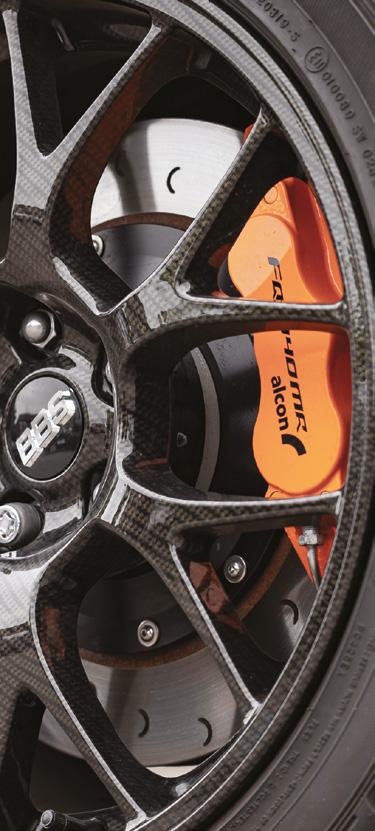

Introduced three years after Chevrolet’s wonderfully dramatic 1965 Mako Shark II show car, the so-called ‘C3’ Corvette borrowed heavily from its design exercise sibling’s ‘coke bottle’ silhouette. Underpinned by a perimeter frame chassis featuring all-round independent suspension, recirculating ball steering and fourwheel disc brakes, the newcomer’s beautifully moulded fibreglass skin wore slimline chrome bumpers. With even the mildest of its ‘small block’ V8 engines being rated at 300bhp and 360lbft of torque, the C3 was a predictably strong performer. Tested by Road & Track magazine against a Porsche 911, Jaguar E-type and Mercedes-Benz 280SL just such a ‘baby’ Vette acquitted itself with honours. Demolishing the opposition in a straight line, it split the Europeans on the slalom and other handling tests. A stronger seller than its soft-top sibling, some 22,129 Stingray Coupes were completed during the 1969 model year.
Fitted with four-speed manual transmission, this particular example was originally finished in Riverside Gold Metallic with Black upholstery. Imported by the vendor from California during 2011, he sold it to a friend the following year before buying it back four months later. Repainted Red but not run for a good while, the Coupe will require recommissioning prior to use. The door cards are currently detached as is part of the centre console. Riding on Boyd Coddington five-spoke alloy wheels shod with BF Goodrich tyres, this striking Stingray is thought to be only the twenty-first Coupe built during the 1969 model year. Surely worthy of a return to the road, it is offered for sale with a V5C Registration Document, copy State of California Certificate of Title, assorted US bills and two old MOTs.



Reg
Introduced in October 2007, the final generation of Mitsubishi’s legendary, rally-bred EVO road rockets – the X – was no mere rehash of its forebears. Under the four-door saloon’s menacing Omer Halilhodzic-penned skin lay a brand-new, all-alloy 2.0 litre DOHC engine, the 4B11 MIVEC, which allowed service intervals to be increased from 4,500 to 10,000 miles and a thoroughly revised version of Mitsubishi’s permanent all-wheel drive system dubbed S-AWC (Super All Wheel Control) that enabled torque vectoring across the rear axle. Also new was the option of a six-speed, dual clutch ‘SST’ transmission (akin to VW’s DSG or Porsche’s PDK) with steering-mounted magnesium alloy shift paddles. A far more engaging unit than the Tiptronic automatic gearbox it supplanted, SST quickly found favour with those driving at ‘maximum attack’. Unique to the UK and honed by HKS Engineering, the Evo X FQ-300 GSR SST boasted some 295PS and 300lbft of torque and was reputedly capable of 0-60mph in 4.5 seconds and 155mph. Winner of the 2008 Automotive Excellence Awards’ ‘Fun to Drive’ category and shortlisted for the ‘World Performance Car of the Year’ prize, the Evo X was also chosen by the British constabulary for use as a high-speed pursuit police car.
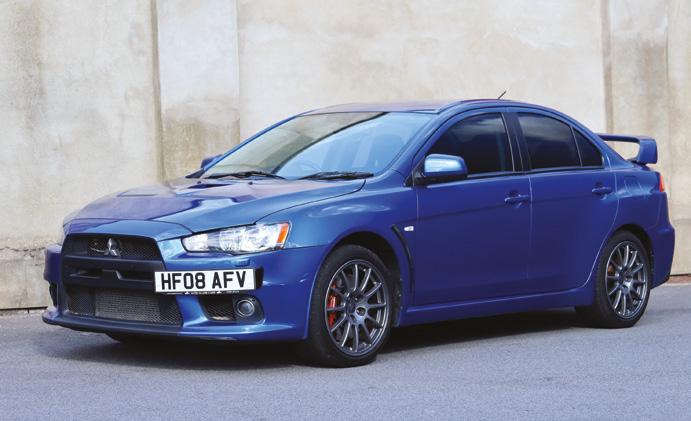
Finished in Lightning Blue with Black cloth upholstery, this particular example was supplied new by the Poole Car Centre Ltd of Dorset (an authorised Ralliart dealer). Serviced at 1,493, 9,594, 10,976, 11,783, 23,008, 34,061, 40,028, 43,739, 51,252, 56,784 and 61, 251 miles, the odometer currently shows some 68,600 warranted miles. Accompanying invoices record the fitment of lighter Girodisc brakes and various suspension polybushes.
Under the bonnet, ‘HF08 AFV’ appears largely standard aside from a HKS sports air filter and aftermarket ‘dump valve’. Starting readily and running evenly during our recent photography session, the Mitsubishi is still electrifyingly fast (especially cross country). Practical, affordable and fun, this Evo X is offered for sale with V5C Registration Document, original book pack, MOT certificate valid until June 2023 and sundry invoices.

This powerful hill-climb/sprint car was formerly owned & developed by a British hill-climb champion and is a class-winning car. Ex British Hill climb champion Rhys Howells competed ‘BRW 490Y’ competed with the car in the national sprint and hill-climb championships (although the car had also competed successfully prior to his purchase). Previously prepared by Simpson motorsport of Lydney, who put MOTs on the car in 2019 & 2020, it has a highly desirable & valuable J.E. Developments (John Eales) engine fitted. Stamped #4501047 (next to dip stick) it is a 4.5 litre TVR Tuscan Challenge engine producing c.350bhp. Putting the power down is a five speed Borg Warner gearbox via LSD, driving 17’’ lightweight Image wheels with brand new Nankang AR1 tyres. The height adjustable suspension uses a bespoke rear 4 link trailing arm with Panhard rod. The bonnet, boot and both front/rear bumpers are lightweight GRP. It’s evident the TR has been purpose-built and ready to go.


TT Motor Racing of Dorset have worked through the brakes, fitted new Lumenition, coil & tuned the engine. It has recently had new belts, new fluids, a new water pump and a new battery fitted. A new high pressure fuel pump and regulator have also been fitted. In addition, it is spanner checked along with wheel alignment & corner weights checked. The car weighs 1,050kg in total. A June 2021 rolling road session enabled the set-up of carburettors and revealed a strong engine producing 350bhp. A track test at Castle Combe in October 2021, showed the car to be fast and handling very well. Owing to a change of the vendor’s plans this great looking car is offered for sale. I bought this road legal car 2020 to do French hill-climbs in 2021 and then the pandemic came along and the events were cancelled. It has had a current MOT up to 18th October 2022 and much expense has been recently spent getting it to this point.
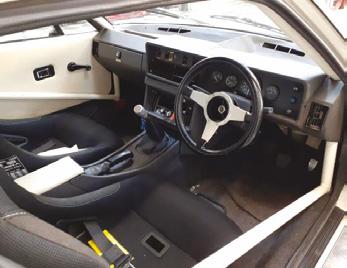

Estimate:
Notable as the first Lotus Elise to be sold in America, the 111R was launched at the 2004 Los Angeles Auto Show and powered by a more emissions compliant Toyota 1.8 litre engine allied to six-speed manual transmission. Housed in a bespoke subframe, the incoming powerplant featured a Yamaha-designed DOHC cylinder head, variable valve timing and a carefully remapped ECU. Credited with developing 189bhp and 138lbft of torque, the 111R was reputedly capable of 0-60mph in 4.9 seconds and 150mph. Equipped with servo-assisted ABS brakes as standard, customers could pay £1,995 extra for a Touring Pack that transformed the car’s usability courtesy of better sound insulation, carpet, electric windows, uprated stereo and full leather or Alcantara upholstery.

Finished in the striking combination of Saffron Yellow with Black leather upholstery, this particular example was supplied new by Christopher Neil Ltd of Northwich complete with the desirable Touring Pack. Serviced at 1,210, 8,125, 17,300, 20,336, 26,984, 29,928, 37,975, 44,519 and 52,796 miles, ‘DK55 ETA’ currently shows a warranted 54,700 miles to its odometer. Acquired by its last (third) registered keeper during March 2009, the Elise proved a reliable companion. Starting readily and running well during our recent photography session, the two-seater provides a notably engaging driving experience. Indeed, it still feels capable – in the best Lotus tradition – of showing a clean pair of heels to far more exotic machinery on the right road. The softtop is in good order and the presence of factory stickers within the rear boot compartment reassuring. Interestingly, it appears that the DVLA’s listing for the Lotus Elise 111R (Touring) amounts to just 317 cars. Offered for sale with original book pack, V5C Registration Document, two keys and assorted paperwork.


No Reserve
304

Estimate: £12,000 - £14,000*
Reg No: YR05 GHH
The 350z has become somewhat of a cult classic, not only for its fantastic exhaust note, driveability and reliability, but also due to its use in popular film franchises including the ‘Fast and the Furious’. With values steadily increasing, these are a fantastic opportunity for the driver among us.
Presented in Black with contrasting Burnt Orange interior, this particular 350Z benefits from specification including air conditioning, cruise control electrically adjustable seats, 6 CD interchanger, telephone connectivity and much more. Now showing just 55,026 miles on the odometer with 3 former keepers, the car benefited from a replacement clutch and flywheel in December 2013, ECU remap January 2017 with rolling road power runs, which show an increase from 241bhp to 261bhp, replacement hood in July 2017 and more recently in 2021/22, a replacement exhaust centre and rear section, replacement battery, petrol air filter and a full detail.
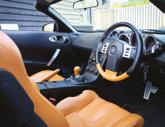
Included with the vehicle is a comprehensive history file including its original bookpack, which contains service manuals, as well as the warranty and maintenance record which displays 5 stamps. As well as this, a large collection of previous invoices and MOTs, as well as the V5C document. The vendor rates the condition of the bodywork, engine, electrical equipment, paintwork, transmission and interior trim all as ‘Very Good’.
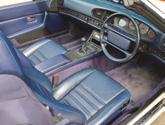
Reg No: J950 TRP Chassis No: WP0ZZZ94ZMN430358 MOT: December 2022
Introduced in 1989, the Porsche 944 S2 was powered by a 3-litre (2990cc) DOHC four-cylinder engine allied to a five-speed manual transmission. With a quoted 208bhp and 207lbft of torque on tap, the model was reputedly capable of 0-60mph in 6 seconds and 150mph. The first open-topped 944 derivative - the S2 Cabriolet - featured a body built by the American Sunroof Company (ASC) of Weinsberg, Germany and many of the same styling cues as its Coupe sibling. Just 5,656 944 S2 Cabriolets were made before the model was superseded by the 968 in 1991.
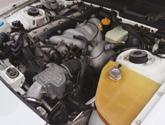
Having been first registered in March of 1992 this very attractive and original-looking 944 Series 2 Cabriolet was delivered with the 5-speed transmission. Showing evidence of careful ownership and just 89,800 miles on the odometer, the car comes with its original Porsche service book with 19 stamps for servicing. A further 8 stamps show fluid, belt and condition checks at Porsche dealerships as well as independent specialist garages. The MOT history is extensive and includes an itemised list of service and repair work and a collection of invoices for parts and work carried out. Inside this 944 has a Blue leather interior with the Blue leather carried through to the dashboard steering wheel. A Blaupunkt Lausanne CD radio player provides the tunes for that perfect long-distance trip with the fabric soft top down.


Introduced at the March 1999 Geneva Salon, the Aston Martin DB7 Vantage eschewed its predecessor’s 3228cc supercharged straight-six for a 5935cc 48-valve, all-alloy V12 that developed 420bhp and 400lbft. Available with a choice of six-speed manual, five-speed automatic, or (later) Touchtronic semi-auto transmission, the DB7 Vantage could be had in Coupe or Volante (Convertible) guises.

Presented in Slate Blue with complementing Grey leather interior, this 2003 model year DB7 was purchased by its current owner in 2012 and shortly after, was subject to extensive works to bring it to standard, totalling over £11,000. Since purchase, the car has been dry stored, seeing occasional use, but turned over monthly and run to temperature, rolled to prevent flat spots and serviced routinely. Now showing just c.81,000 miles and benefiting from having had just 3 former keepers, this DB7 Vantage is offered with its original bookpack containing 16 service stamps, with the most recent with EMS Ltd at 79,862 miles. Also included is a hand-written expenditure record for 2012 when the car was purchased, a small collection of previous receipts and invoices and the current V5C Document. As well as this, the car boasts an MOT valid until 22 August 2023.

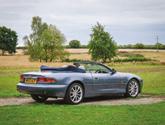

Along with the mid-generation refresh of the C-Class in 2005, the C32 AMG was replaced, giving way to a new 5.4-litre naturally aspirated V8-powered C55 AMG. This was an evolution of the V8 engine found in the previous E-Class, with power raised to 270 kW (367 PS) and torque climbing to 510 Nm (376 lbft). The C55 AMG uses a V8 from the same engine family as the W202 generation C43 AMG. Though maximum speed is still electronically limited to 250 km/h (155 mph), the 0 to 100 km/h (0 to 62 mph) time has dropped to 4.7 seconds. Unlike the less-powerful V6s in the rest of the MercedesBenz line-up, the C55 AMG continued to use the five-speed automatic with AMG Speed shift. The C55 shares its longer front end design with the CLK55 AMG to accommodate the larger 5.4-litre engine. The C 55AMG is one of two AMG models to feature different structure than its base Mercedes platform, the other being the W204 C63 with its custom elongated engine bay. The C55 was the first AMG C-Class to feature quad exhaust outlets and an external differential cooler. The Nürburgring Nordschleife lap time for the C55 AMG is 8:22 compared to 8:37 for the C32 AMG mainly due to the revised suspension and extra torque.
The C55 AMG offered here was originally delivered to Japan and first registered in November 2005. In 2021 the car was imported into the UK, with the odometer reading just 70,615 kilometres or 43,878 miles, which is warranted by the Japanese Export Vehicle Inspection Center (JEVIC) as the accompanying certificate will show. While in the current vendor’s ownership, the C55 AMG has benefitted from a recentMOT and service, new spark plugs and a replacement Lambda sensor. Described by the vendor as being in exceptional condition inside and out and driving as it should, the car comes with the owner’s manual, a JEVIC certificate, two sets of keys and recent invoices.

The chance meeting between John Cooper and Aurelio Lampredi at the 1959 Italian GP is now an established part of Mini folklore. Having charmed a very early 850cc model out of BMC and driven it to Monza, Cooper was accosted by Fiat engineer (and ex-Ferrari F1 designer) Lampredi. Infected by his old enemy’s enthusiasm, the Italian asked to borrow the new wonder car. Returning several hours later, he heralded it as the future of automotive design before adding “if it weren’t so ugly, I’d shoot myself”. Unperturbed Cooper continued to harass Issigonis and BMC until they agreed to build a ‘hot’ version. Initially conceived as a homologation special, the Mini Cooper was launched in July 1961. Powered by an enlarged 997cc engine and benefiting from front disc brakes, it gave way to a succession of ever quicker variants culminating in the 1275 ‘S’ of 1964.
Manufactured on 5th March 1964 and sold through Morris Garages Ltd of Oxford, ‘8007 ET’ was supplied new to the home market, in right-hand drive Mk1 Morris Mini Cooper 1071 ‘S’ form. Entering into the ownership of one family in 1977 (and remaining until 2003), during their ownership the Mini was subject to a full restoration, with the bodyshell receiving restoration in 1995. New subframes front and back were fitted with a bare metal repaint in Tartan Red and a Cambridge White roof, as presented today.


In 2009, the Cooper S was professionally built to a full race FIA specification at a not inconsiderable expense, with bills on file for during 2009 amounting to over £35,000. This decision was prompted by an announcement from Goodwood that the 2009 St Mary’s Trophy two-driver race would be run exclusively for Mini Coopers in celebration of the Mini’s 50th Birthday. Built to FIA spec and fitted with a full roll cage, Cobra seats with five-point harnesses, internally routed brake lines, heated front screen, plumbed-in fire extinguisher, and genuine Vortz ‘rose petal’ wheels.
The Saturday seat for the St Mary’s Trophy was offered to multiple CART Champion and 1986 Indy Car winner Bobby Rahal. Front-wheel drive Minis didn’t seem to appear anywhere on Mr. Rahal’s CV, yet despite this, he finished Saturday’s race in a respectable 13th ahead of some talented drivers including Jochen Mass, Warwick Banks, Vern Schuppan, Andy Rouse, Tiff Needell, John Cleland, and Stephan Johansson. Following the 2009 race, the car has seen very little competition use.
Powered by one of Swiftune’s legendary 1293 cc engines, incorporating a Tuftrided crank, race pistons, Stage 3 head, lightened and balanced flywheel, and twin HS4 carburettors, and is believed to produce 115bhp at the flywheel. To keep temperatures under control, it benefits from an oil cooler accompanied by a wide radiator coupled with a multiblade fan. The gearbox is a close-ratio fourspeed coupled to a competition differential and clutch. Hi-Lo adjustable suspension provides the handling and nimbleness synonymous with Minis and braking by way of ‘S’ discs and calipers up front and Minifins to the rear.
Accompanied by a large history file including restoration/build photographs, MOTs dating back to 1973, the aforementioned BMHIT heritage certificate, a large selection of invoices, and a copy of the Mini World article where it was featured as the cover car in June 1996. A very capable Cooper S with previous Goodwood experience and lightly raced since completion. A fabulous opportunity.






Reg
The Honda Integra Type R DC2 was a smash hit when it launched in 1995. Car journalists and motoring enthusiasts alike praised the little Honda for its incredible handling and performance. With such high regard for the first-generation Integra Type R, the second generation had a lot to live up to. The fourth-generation Integra would be introduced in Japan in April 2001, and produced until 2006. Ultimately, it would be regarded as one of the besthandling front-wheel drive cars of all time and is fast becoming a modern classic. The Integra received a facelift in 2005. The headlight and taillight assemblies lost the so-called ‘teardrop’ shape. This made the assemblies flush with the bumpers. The interior received new trim and gauge clusters, an immobilizer and alarm became standard, the body became stiffer, the suspension springs were redesigned, and the car’s tendency to bump steer was reduced.
Presented in Nighthawk Black Pearl with contrasting red Recaro seats, this stunning facelift Integra Type R was manufactured for the Japanese market in 2006. Imported to the UK and registered in May of 2021, the odometer now displays only 59,430 miles. ‘EG55 FWM’ comes accompanied with its Auction window display sheet, showing the car as a highly regarded Grade 4. As well as this, its Honda bookpack containing an impressive sum of Japanese service history and documentation. Within the bookpack is also the Japanese tear-out maintenance booklet, owner’s manual, Honda Safety Points manual, Honda Maintenance Notes booklet, another Honda booklet, Pioneer stereo booklet and further Japanese documentation. In addition, the car also includes its export certificate, as well as the Kenwood stereo manual still in its plastic wallet, with spare lead, remote, radio code card and manuals. Finally, a spare key and the UK V5C document which displays ‘zero’ previous keepers.

Built between 1981 and 1985, this is one of less than ten cars that are thought to have survived. Supplied with the M30 528i straight six-cylinder engine that was upgraded as part of the conversion with the Alpina B9 type exhaust system, and the power output measured an impressive 192bhp at 5800rpm. Alpina springs and Bilstein gas dampers cost a considerable premium over the BMW 528i SE (E28) upon which it was based.
Manufactured in 1983, this B2.8 is a rare UK-supplied, right-hand drive, 5 speed manual example, being supplied new via Western Counties BMW and is finished in stunning Henna Red In previous long-term ownership, from 1988 until 2021, and remaining in storage from 2006 until the end of that period, ‘A818 VNY’ has covered just 54,460 miles from new, at the time of consignment, and has had only four former keepers.


The Alpina specification visually includes; Alpina 16in wheel rims, dealer stripe kit, Alpina front spoiler, rear spoiler, Alpina badges and dashboard plaque and steering wheel. It has benefitted from recommissioning in 2022, which includes full brake overhaul with new discs, pads, and hoses; full service; new fuel tank and fuel lines; valve clearances adjustment and general thorough check through.

In the last six months thousands of pounds have been spent and a massive amount of man hours improving and transforming this example to the car presented today. The exterior has been repainted in factory correct Hennarot (Henna Red) paint, the engine bay has been refreshed, being cleaned, repainted and detailed and ancillaries have been replaced/refurbished where required. The original wheels have been fully refurbished. Original Alpina & BMW parts have been sourced from Germany at great cost to complete this car as accurately as possible including a correct Gold stripe kit, original Alpina rear spoiler, all badges, Alpina wheel centres, fog lamps, grille and many other parts.
‘A818 VNY’ is offered with the original book pack, including the original stamped handbook, a current V5C, and is MOT’d until April 2023.
Reg
Using body moulds taken from a Cobra MKII as its basis, the BRA 289 was among the first evocations to appear on the UK market with over 260 examples being produced from 1981 to 1998. Designed by John Berry and Peter Ibbotson in Doncaster, its bespoke square-section tubular chassis made use of MGB running gear (front suspension, steering, rear axle etc) and was clothed in lightweight fibreglass. Rover’s delicious sounding, allalloy 3.5 litre V8 engine was the powerplant of choice often allied to five-speed manual transmission. A power to weight ratio of over 200bhp per ton was readily achievable and fun behind the wheel all but guaranteed if a BRA 289 was built / set-up correctly.

An accompanying photo album shows the care and consideration that Rodney Rushton of The Laleham Forge & Engineering Company put into constructing this particular example. Displayed at the National Component Car Show midbuild, the two-seater is understood to have been fitted with a Rover 3.5 litre V8 engine tuned to circa 225bhp and allied to a strengthened five-speed manual gearbox. Further benefiting from BRA’s optional Handling Pack and an estimated 100 hours of preparation work prior to being painted Ferrari Red, the twoseater also boasted a soft-top, hardtop, tonneau cover and sidescreeens. Interestingly, the MG B Roadster which served as its donor is understood to have appeared in the TV series, Inspector Morse. Sparingly used since being purchased from Classic Cars & Campers Ltd of Herefordshire for £14,900 in June 2019, ‘VOJ 809J’ is now in need of recommissioning. Registered with the DVLA as a BRA / MG 289 MKII, it passed its last MOT test on 26th February 2020 with ‘no advisories’ (less than 200 miles ago). Offered for sale with V5C Registration Document, sales invoice and the aforementioned photo album.
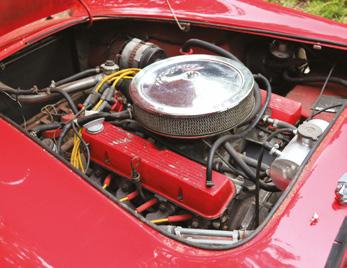


£40,000 - £45,000*
Developed under the watchful eye of Porsche Chief Executive Peter Schutz, the 911 Carrera 3.2 made its debut at the Frankfurt Motor Show of September 1983. Estimated to be 80 percent new, the model’s 3164cc (hence ‘3.2’) flat-six engine was credited with developing some 231bhp and 209lbft of torque. Allied to a fivespeed manual transmission, it proved both rev-happy and flexible, making the model capable of 0-60mph in 5.3 seconds and a 153mph top speed. In order to cope with the increased performance, the brakes were enlarged and the top two gear ratios slightly raised. Among other improvements was a redesigned timing chain tensioner - the Achilles heel of the earlier engines. Early examples of the 3.2 employed the 915 type manual gearbox with reverse gear located beneath fifth, while 1987 to 1989 models had the stronger G50 unit in which reverse was located beside the fifth ratio. An optional ‘Sport’ pack became available during 1984, comprising a deeper front valance, ‘tea tray’ rear spoiler, stiffer Bilstein dampers and 16-inch Fuchs forged alloy wheels with Black centres.
Here we have a wonderful example of the much sought after Porsche 911 Carrera - Targa Sport, finished in Grand Prix White with a Black Targa Top that is in great condition. The interior is impressive with its Blue leather and Red seat piping, which we are informed was an original option at the point of ordering.

“G743 GJT” was first registered in 1989 and was a factory “UK Sport” model specification, which included electronically adjustable seats, air conditioning, electric windows and the iconic “Whale Tail” spoiler. The 231 BHP 3.2 litre normally aspirated flat-six engine supplies the power to the much favoured G50 manual transmission, it can propel the car from 0-60 mph in just 5.3 seconds and achieve a top speed in excess of 150mph. Its worth noting that the speedometer was replaced on 11th September 1990 by Mann Island official Porsche centre when it had 8577 recorded, therefore the total mileage covered is now c.108,000, this is correctly documented in the service record. The vehicle comes with a comprehensive service history carried out mainly by Porsche main dealer and Specialist garages, the service book shows that the vehicle has covered only c.500 miles since its last service. As well as benefitting from a Clifford alarm plus immobiliser the car will be sold with 2 original keys, 2 original alarm fobs and comes complete with bookpack, service records, V5C, and original jack and tool kit. This is a great opportunity to purchase an iconic “Fast Road” classic Porsche that presents really well and has clearly been looked after.

The MkI Ford Escort was introduced in Ireland and the United Kingdom at the end of 1967, making its show debut at the Brussels Motor Show in January 1968. The Escort had conventional rear-wheel drive and a four-speed manual gearbox, or threespeed automatic transmission. The suspension consisted of MacPherson strut front suspension and a simple live axle mounted on leaf springs. The Escort was the first small Ford to use rack-and-pinion steering. The MkI featured contemporary styling cues in tune with its time: a subtle Detroit-inspired “Coke bottle” waistline and the “dogbone” shaped front grille – arguably the car’s main stylistic feature.



Manufactured in 1975, chassis number ‘BBATPA79227’ was supplied new to the European market. Discovered by the vendor in Malta in 2016, when on holiday in the country, the vendors purchased the car from the owner and arranged for its repatriation to the United Kingdom that same year. An evocation of the iconic RS2000, ‘KAJ 163N’ began life originally as a 1300 two-door, since being fitted with a 2.1 litre Pinto straight-four engine allied to a five-speed Type-9 manual gearbox. Finished in Black with a complementing Black interior upholstery, the Escort has been fitted with new RS alloy wheels and tyres, a twin-box RS2000 exhaust system; RS2000 alloy sump and bell housing during current ownership, as well as the RS steering wheel.
Subject to much further improvement while with the vendor, the work has included a full interior refresh with retrimmed seats and a Newton Commercial carpet set; bare metal repainting; new front discs and pads; new top mounts, ball joints and Bilstein front struts; a replacement distributor; and rolling road tuning in 2021. With a recorded mileage of 73,337 miles (at time of consignment), the Ford is accompanied by a history file comprising of a collection of invoices relating to the vendor’s improvements, previous MOT certificates and a current V5C. The Escort is also expected to possess a fresh MOT certificate in time for sale.
Introduced at the 1992 Motor Show, the Chimaera was intended to be a more practical, user-friendly machine than the formidable Griffith. To this end, it sported a proper boot and a more cosseting interior. Power came from a variety of Rover V8-derived units, though, even the entry-level 4.0 litre was quoted as developing 240bhp/270lbft. The slowest of the range, it was reputedly capable of 0-60mph in 4.7 seconds, 0-100mph in 12.1 seconds and 152mph! Luckily all Chimaeras came with four-wheel disc brakes and a Quaife differential as standard.
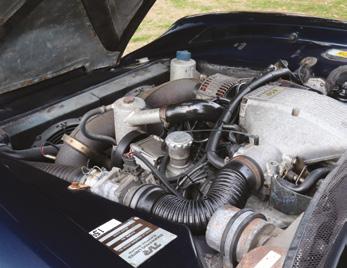

A 4.5 litre model was added to the line-up in 1997. Peter Wheeler took over TVR Engineering in 1982 and Rover V8s up to 4.5-litres were developed. It was originally intended to be fitted with the AJP8 V8 engine but due to the engine not being ready on time, a bored version of the Rover V8 was used instead. The Chimaera 450 was said to offer 285bhp and 0-60mph in 4.7 seconds.4,546cc
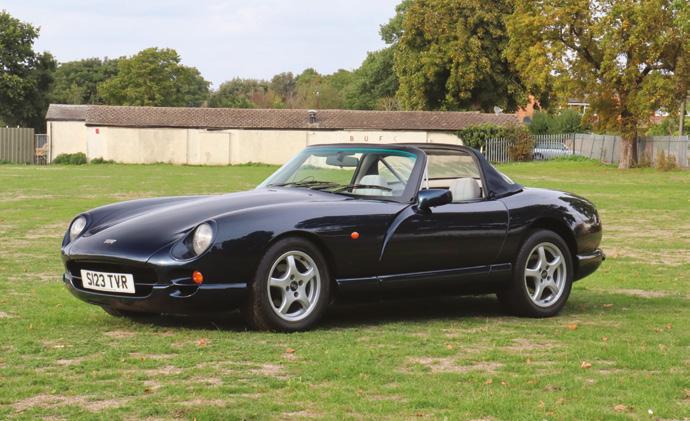
With an original order form still with the car, dating from 1998, this Chimaera 4.5 (aka 450) was supplied new by S.P Brough and Company that year. Finished in Starmist Blue with Light Grey hide, with just 1 former private keeper we are told it has always been garage stored. Power steering is a welcome option as part of the package and the alloy wheels have recently been refurbished. An appropriate TVR related plate, ‘S123 TVR’ is offered as part of the sale.
Last serviced in 2020 at 54,923 with a brake and clutch fluid change, the 4.5 is offered with a collection of invoices for the servicing. There are two keys and two key fobs along with an owner’s wallet and service book with 22 stamps from an independent specialist and will be offered with a fresh MOT certificate by the time of sale.
c.£25,000 spent on the build
The original Mini was a revolution on wheels, offering iconic style and space for the masses. The fuel crisis beating ‘people’s car’ that became a fashion icon, synonymous with Britain and the ‘swinging ‘60s. The mechanical genius of the design placed the ubiquitous ‘A-Series’ engine transversely across the frame with the gearbox with its sump. A rubber cone suspension replaced springs, accentuating the ‘go kart’-like handling and allowing for 80 percent of the floorpan to be used by passengers and their luggage.

Described by the vendor as a ‘no expense spared’ custom build by Chay Spellman from Mini World on the Costa Del Sol, it was actually circa £25,000 that was spent on the builder’s vision for this Mini. The new Pearlescent Pink and White paintwork alone would have been a healthy chunk of that, however, the specification goes beyond paint. Upgraded with a fuel-injected 1480cc ‘Mini Speed’ engine and a stainless exhaust, the car sits on Hi-Lo suspension, Spax shock absorbers and 7x13 ‘ultra-light’ 8-spoke chrome Minilite-style wheels. Inside the dashboard has been given a fabulous looking Cooper 500 dash with Pink and White Alcantara seats with silver stitching and Swarovski badges. Since the finish of the build, it has covered just 14,500 miles (new clocks fitted) since, rarely seen the rain and was subject to a full service in 2021.


2005 Honda S2000 Estimate: £12,000 - £14,000*

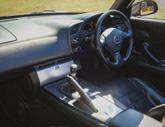

Reg No: LB05 YKV Chassis No: JHMAP113055201513 MOT: February 2023
First registered in 2005 and presented in Moonrock Grey, this facelifted Honda S2000 has been in current ownership since January 2015. A desirable unmodified example, ‘LB05 YKV’ has been regularly maintained during its current ownership using Honda spares in servicing and maintenance where possible.
Now showing 73,897 miles at the time of consignment, this S2000 has benefitted from Waxoyl treatment in October 2018, brake line replacement and the valve clearances checked that same year, as well as the fuel filter being overhauled in January 2021 in addition to regular servicing. More recently in February of this year, noting the MOT advisory for the tyres cracking, the rears were replaced together with a new drive belt in advance of the service schedule. In March, the car was subject to a service, along with a health check in early September in preparation for sale. This S2000 is accompanied by its original bookpack including both one complete service book containing 12 stamps until 2016 at 48,496 miles and a second service book with 4 stamps from 2017 until the most recent in March 2022. Also included are a large collection of invoices and MOTs, as well as the current V5C document which shows 6 former keepers.
This 147 GTA was delivered new on the 20th of May 2005 and is finished in the traditional Alfa Romeo Red with a Black leather interior. Its 3.2-litre six-cylinder engine coupled to a six-speed manual gearbox has undoubtedly provided a lot of joy to its 5 previous keepers, covering 106,400 at the time of consignment. To improve the enjoyment factor even further, this 147 GTA has been fitted with a few tasteful modifications, including a Quaife diff, KW fully adjustable suspension, a Wizard stainless steel cat-back exhaust system, Autolusso silicone water pipes and air intake pipe, a BCM CDA carbon air intake, braided brake hoses, an engine strut brace, polished plenum, rocker cover and intake pipes, Alfa Romeo 159 wheels and refurbished brake callipers painted in yellow. The fact that it comes with a full service history, with the last service completed in May 2022, says a lot about the pride the current and previous owners have taken in the GTA and it is clearly evidenced by the condition of the car. Having benefitted from a new clutch, cambelt and water pump together with a refurbishment of the gearbox in 2020 and a new battery in 2022, the Alfa Romeo is described by the vendor as being in a very good condition mechanically and cosmetically, and is said to drive and handle very well. Offered with a big folder containing the handbook, service booklet, original brochure, invoices dating back to 2005, the car also comes with the original Teledial wheels, the original suspension with Eibach springs, air intake and coilover adjuster tool and an aluminium undertray. The original radio will also be refitted prior to the auction.

1999 Porsche 911 Carrera 2 Cabriolet



Estimate: £12,000 - £15,000*
Reg No: FCZ 6856
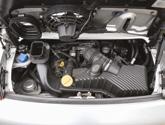
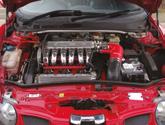
WPOZZZ99ZXS641112
July 2023
Supplied new by Official Porsche dealer Glenvarigill of Glasgow and first registered in Glasgow, Scotland on 19th July 1999, this 996 Carrera Cabriolet cost £71,450 when new and is finished in Artic Silver Metallic with a lovely and rare Nephrite Green leather interior. Featuring a desirable 6-speed manual gearbox, the car also benefits from a matching hard-top. In October 2009, ‘FCZ 6856’ benefited from a full gearbox rebuild by Porsche specialist Autostrasse in Coggeshall, Essex @ 85, 907 miles and this also included replacement bearings, new rear main oil seal, new intermediate shaft bearing/ IMS & housing and a new clutch. More recently, the car has been subject to works including four-wheel refurbishment in June 2021, along with regular maintenance when required. ‘
‘FCZ 6856’ comes accompanied with its original leather bookpack containing a Porsche Centre brochure, guarantee and maintenance booklet, Porsche Assistance booklet, 911 drivers’ manual and bodyshop leaflet. In addition, a large collection of previous MOT certificates and invoices for servicing and work completed. The current V5C document is also included and displays 7 former keepers and the car has an MOT valid until 23 July 2023.
Estimate: £50,000 - £60,000*
The most successful Formula One team of the 1970s with four World Championships to its credit, that same decade saw Lotus launch a credible rival to the Ferrari 308 and Porsche 911. Unveiled at the October 1975 Paris Salon, the Esprit was notable as one of Giorgetto Guigiaro’s earliest polygonal designs. A mid-engined two-seater equipped with all-round independent coil-over suspension, four-wheel disc brakes and rack and pinion steering, the newcomer also featured a recumbent, racing car-esque seating position. Powered by a 1973cc DOHC four-cylinder engine allied to five-speed manual transmission (housed in a transaxle), the fibreglass-bodied Esprit weighed just 900kg. Although road testers found it difficult to emulate the factory’s performance figures (0-60mph in 6.8 seconds and 137mph), their praise for the Lotus flagship’s ride / handling balance and overall poise was universal. Arriving in 1978, the Series 2 (or S2) version sported an integral front spoiler, revamped interior, C-post ducts, bespoke 14-inch alloy wheels and new taillights. More refined than its predecessor, production lasted until 1981 by which time some 1,061 had been made. However, by far the most famous and sought after S2 derivative was the ‘World Championship Commemorative Model’. Released in 1978 to celebrate Lotus winning its seventh World Championship title that year and finished in the same, highly distinctive Black and Gold ‘JPS’ livery as the company’s Formula One cars, the original idea had been to build 300 (100 for the UK, 100 for America and 100 for the Rest of the World). In practice less than half that number are thought to have been completed with the UK receiving 92 or 94 examples (sources differ).

According to an accompanying Group Lotus PLC facsimile, this particular example – chassis 79020641G – was UK car number 61. Completed on 20th February 1979, it was road registered less than two weeks later and supplied via the London Lotus Centre of Chelsea. Exceptionally original, the Esprit is warranted to have covered only 26,000 miles from new. The ‘JPS’ livery is no longer perfect with signs of crazing in the gel coat and micro blistering etc but, if anything, that only reinforces the car’s authenticity. The interior trim is notably well preserved with the model specific three-spoke Mario Andretti-signed, leather-rimmed steering wheel and commemorative plaque remaining in situ. More unusually, ‘FBC 199T’ is also able to boast its factory-fitted Hitachi Digital stereo complete with ‘JPS’ knobs not to mention its ‘JPS’ logoed gear lever and door-mounted cigarette lighters. Purchased by the vendor from marque specialist Bell & Colvill under the Lotus Approved Used Car scheme at 22,575 miles in May 2011, the Esprit joined his collection of Lotus single-seaters, road cars and memorabilia. Sparingly used over the past eleven years, the two-seater was entrusted to the renowned Paul Matty Sports Cars for a new exhaust and cambelt plus attention to its cooling fans and carburettors etc. during April 2019 at 25,822 miles (£2,882.69).
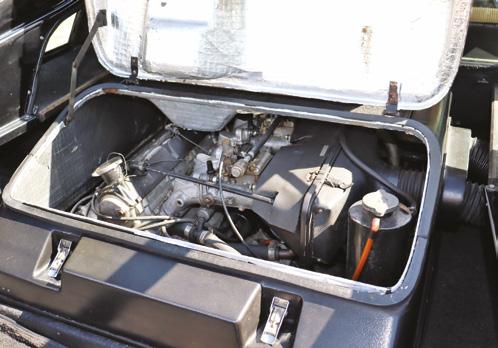
Featured in CAR magazine’s ‘50th Birthday Special’ (October 2012) and the subject of a six-page article in Classic Cars magazine (June 2013), ‘FBC 199T’ was used by Omologato to promote their ‘heritage Racing Special’ limited edition watch and won the ‘Judges’ Choice’ Trophy at the 2015 Cholmondeley Pageant of Power Concours. Treated to a new Silver Top fuel pump by Simon Rudge Motorsport last October, No. 61 started readily and ran well during our recent photography session. Offered for sale with V5C Registration Document and history file, this special example of a special car is surely worthy of a place in another Lotus collection?
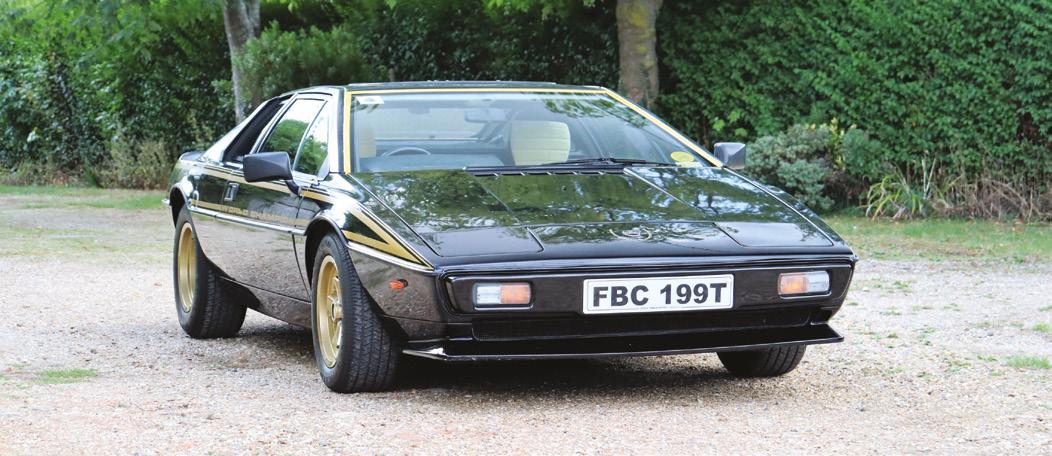

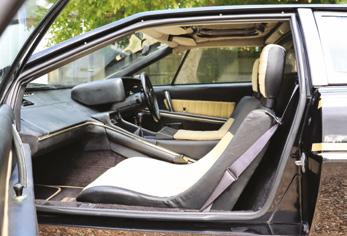
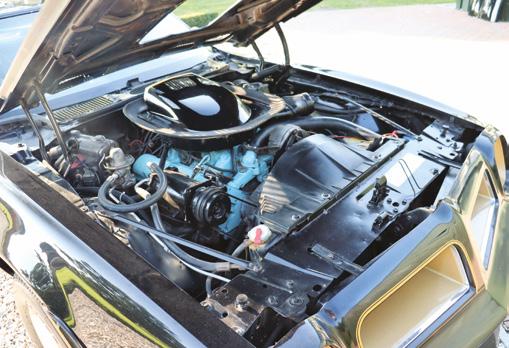

Estimate: £30,000 - £40,000*
Mixing two of America’s great loves, the motorcar and the big screen, can have a seismic effect on popular culture. Petrolheads around the globe struggle to disassociate a Highland Green Ford Mustang Fastback from Steve McQueen’s Frank Bullitt (‘Bullitt’), a speeding DeLorean from Michael J. Fox’s Marty McFly (‘Back to the Future’) or a Black and Gold Pontiac Firebird from Burt Reynolds’ Bo ‘Bandit’ Darville (‘Smokey and the Bandit’). Of the three iconic machines, it is the Firebird which had by far the biggest starring role. Indeed, director Hal Needham often cites the Pontiac as one of his film’s biggest characters!
Although ‘Smokey and the Bandit’ was the second highest grossing film of 1977 (behind Star Wars), much of it had been shot the previous year. All four of the Firebirds that Pontiac supplied were actually 1976-model year cars with 1977-model year front ends grafted on. Conscious of this ‘anorak fact’, the previous owner of chassis 2T87M6N595918 actively sought a 1976 model-year car in which to live out his Bandit dreams. A true fan, he recreated various scenes from the film including having a police car pictured in his driver’s door mirror and running in convoy with a big rig as well as participating in the 40th Anniversary ‘Bandit Run’. The Firebird he chose began life as one of the more luxurious Esprit models equipped with a 350 cu in (5.7 litre) V8 engine allied to automatic transmission. Repainted in the trademark Black and Gold colour scheme, the 2+2-seater’s exterior also sports a ‘flaming chicken’ bonnet decal, Gold-centred alloy wheels and lift-out targa roof panels. While, the interior’s Black upholstery is offset by an authentic-looking anodised Gold dashboard and a (non-functioning) CB radio. Starting readily and running well during our recent photography session, the Pontiac sounds decidedly menacing courtesy of its non-standard exhaust system. However, the ‘icing on the cake’ so to speak are the genuine Burt Reynolds signatures to the centre armrest and ‘Bandit’ rear number plate which were obtained when the legendary actor made his final public appearance at Bubba Fest in Tennessee, August 10th-12th 2018.
Among the very last, and possibly THE last, Firebirds to be signed by Reynolds, chassis 2T87M6N595918 prompted a friendship between its previous and current keepers. Tragically, the former lost his life in a light aircraft crash on Independence Day. Imported by the seller and UK registered, this Reynolds-signed ‘Trans Am’ draws a crowd wherever it goes. A ‘must have’ for Bandit fans everywhere, it is offered for sale with UK V5C Registration Document, owner’s manuals and sundry paperwork. It is worth noting that a 1977-model year Trans Am which had previously belonged to Burt Reynolds sold for $495,000 nine months ago, while one of the Trans Ams used to promote the film in period fetched $550,000 during 2016.




Following the international success of their nimble 924, Porsche designed an all-alloy, 2.5-litre inline-four for their new 944 which they planned to introduce in 1982. Their talented engineers were able to produce a very smooth running four-cylinder engine by utilising two counter-rotating balance shafts running at twice engine speed. The result is a large fourcylinder engine that feels as turbine-smooth as a six-cylinder. A turbocharged version of the 944 was always on the cards, and for the 1985 model year, Porsche introduced the 944 Turbo, known internally as the 951. Forced induction boosted the 2.5-litre engine by a healthy 60bhp, up to 217bhp, with the clutch and gearbox uprated to suit while the Turbo S version of model year 1988 produced up to 250 hp thanks to its larger turbocharger. For model year 1989, the 944 Turbo received the same engine as the Turbo S model. The 944 Turbo also featured several other changes, such as improved aerodynamics, notably an integrated front bumper, standard external oil coolers for both the engine and transmission, standard 16-inch wheels (optional forged Fuchs alloys), and a slightly stiffer suspension set-up. The Turbo’s front and rear brakes were borrowed from the Porsche 911, with Brembo 4-piston fixed callipers and 12-inch discs. ABS was also standard.
This Porsche 944 Turbo was first registered on the 4th of January 1989 and is an original UK-supplied, right-hand drive example finished in the striking combination of Porsche White with a Black cloth and leather interior upholstery. The Porsche is fitted with the turbocharged 2479cc four-cylinder engine mated to the uprated five speed manual gearbox and has the optional glass sunroof. Having covered a total of just over 85,000 miles from new, the 944 Turbo has had only eight former keepers and been in the present ownership since September 1999. In that time it has often been shown at various events and, reputedly, it has frequently been placed in the top 3 of the many Porsche Owners Club meetings and shows it attended. This exceptional 944 Turbo is offered with a comprehensive history file showing it has a full up to date service record including a fresh cambelt replacement and a new head gasket fitted, a sheaf of invoices, the original book pack and two factory keys with a working original alarm/immobiliser.


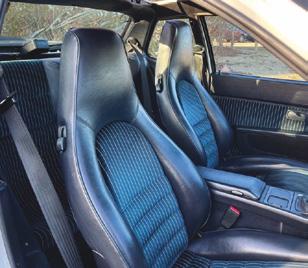
The Lotus Elise was rightly described as the world’s most advanced sports car when it made its debut at the Frankfurt Motor Show in September 1995. Famously named after a granddaughter of Romano Artioli, the then chairman of Lotus, it was built on a futuristic epoxy-bonded extruded aluminium chassis and all designed and developed in-house at Lotus.
The time-honoured relationship between ‘form and function’ was clearly evident in the way the Elise handled, with doublewishbone, independent coil-over suspension, rack and pinion steering, and ventilated disc brakes. Its lightweight chassis-tub, at just 690kg and two-piece ‘clamshell’ fibreglass bodywork paired to a mid-mounted, 1.8-litre K-series engine, produced 118bhp, enough to propel the car to 60mph in just 6.1 seconds with more than adequate torque.


This particular Elise, first registered in March 1999, is a rather special iteration, having been fitted with the ever popular Turbo Technics TT190 Supercharger conversion by Hanger 111 when just 5000 miles old. This particular system results in a power increase from the 118 BHP as standard, to an astonishing 188bhp, with 170lb-ft torque. Purchased by its current owner from Cotswold Motorsport in July 2019, ‘T945 JOG’ has now covered just 33,411 miles from new, with only 4 former keepers and has been looked after largely by Lotus and performance car specialists.
‘T945 JOG’ comes accompanied with its original book pack containing driving controls, technical data and warranty booklet, dealer directory and maintenance record book. As well as this, a copy of the original purchase order, Lotus EEC Certificate of Conformity, a large collection of previous MOT certificates and invoices, the current V5C document and two sets of keys with accompanying fobs.


Introduced in 1999 as a replacement for the F355, the 360 was an entirely new design featuring an aluminium spaceframe chassis which was 40% stiffer and 28% lighter than the tubular steel arrangement of its predecessor. The revised bodywork resulted in the downforce being improved by a factor of four over the F355. Powered by a 3.6-litre V8 coupled to either a six-speed manual or F1 electrohydraulic manual transmission, the 360’s lighter weight improved the 0-60 mph dash to just 4.2 seconds with a nominal top speed of over 180mph. In 2001, the ‘Spider’ version was introduced, the stiffness of the spaceframe being ideally suited to handle an open top. This was followed in 2003 by the ultimate incarnation - the 360 racing series inspired Challenge Stradale - featuring a number of weight-saving and tuning modifications by the factory.
First registered in March 2004 by supplying dealer Graypaul of Loughborough, this late-model manual ‘Spider’ was acquired by the vendor in 2017 and has since spent its life in Northern Ireland at his holiday property. Retaining its full document pack, including factory-supplied service book; it displays eleven stamps between 2004 and 2018 from a combination of approved and independent specialists. The cam belts were replaced in 2014 and again more recently in 2017 at 31,088 miles.
The paint presents in good condition with only minor blemishes and scuffs reported by the vendor - the wings are also embellished with the optional ‘Scuderia Ferrari’ shields. Weather protection is provided in the form of a black fabric convertible hood, which is in good shape, with no rips or tears, and the mechanism worked perfectly during our recent photography session. The interior is finished in striking Crema and the condition of the cabin reflects the modest mileage, with minimal wear. There is slight rubbing to some of the buttons and controls which is a common issue with Ferrari cars of this period, and the original analogue Ferrari-branded stereo head unit has been replaced with a far more user-friendly contemporary system. Accompanying the car is the original leather document pack, including the Guarantee card from Graypaul Motors, factory toolkit, NOS Ferrari-branded tyre inflator and an indoor car cover.
This privately-owned Ferrari 360 Spider is a thrilling open-top supercar, which benefits from a timeless factory specification. Even more aurally exciting than the Modena coupe thanks to being able to drop the roof to listen to the glorious V8 behind you; this is a well-maintained car that presents well in arguably the most desirable colour combination. It is now ready to be cherished and enjoyed on the road by a new owner, and would make a fine addition to any collection of Maranello’s finest.





Believed
Styled by American Tony Lapine, Porsche’s front-engined, water-cooled, V8-powered 2+2 928 was launched at the 1977 Geneva Salon. Not only was it about as mechanically different to the ubiquitous 911 as it could possibly be, but represented the company’s first foray into grand touring territory. Nevertheless it received a rapturous reception from the press and was duly awarded the 1978 Car of The Year Award. Built from 1992 to 1995 the 928 GTS was the last evolutionary stage of the 928 model which featured flared rear wings, a red light panel at the rear, a rear wing painted in exterior colour, exterior mirrors in the Cup design plus 17” Cup rims as standard. The 5.4-litre engine of the GTS generated 350 hp.
It is believed that this 928 GTS was first delivered in 1992 through Porsche Malaysia to the Sultan of Brunei’s Royal Garage as its chassis number features on a published list of cars owned by the Brunei Royal Family in the 1990’s. It is finished in a striking Porsche Coral Red with a Black hide interior piped in Red and is fitted with an automatic transmission. After having remained in the Brunei Royal Collection for quite some time the car was acquired by a Brunei resident and subsequently had a few local owners before being imported into the UK in September 2020 by its only UK keeper to date. Since then the Porsche has been well looked after and after having covered less than 42,000 kilometres or 26,000 miles the car is said by the vendor to be in very good condition mechanically and cosmetically. Having undergone a recent service, this very low-mileage 928 with its special provenance comes with a partial service history, special Brunei Ministry export licence, a fresh MOT and current V5.



The E46 BMW M3 was previewed at the German Motor Show in 1999 as a concept. Although, when manufactured, the actual car bore a very close resemblance when it was introduced in October 2000, the E46 M3 was only available as a two door coupé or convertible body style. It was available with the 3.2-litre (3246cc) S54 M-tuned engine. The M3’s S54 engine had a redline of 8,000 rpm and as with most M engines, the S54 had 6 individual throttle bodies, in this case electronically operated (drive-by-wire throttle). With power going through either a six-speed Getrag gearbox or an SMG (sequential manual gearbox) drive logic transmission, the E46 M3 was full of electronic gadgetry, which included driver aids such as dynamic stability control, cornering brake control and a limited slip differential. With a reported top speed of 155mph and 0-60mph in a blistering 5.1 seconds, the M3 certainly lived up to its name and did not disappoint!
This example of the desirable E46 M3 Convertible was manufactured in 2005 and is fitted with the 3246cc M Power straight-six engine mated to the desirable 6 Speed manual gearbox. Finished in Metallic Silver complemented with a Red leather interior upholstery, Parrot phone kit and headrest TV screens, the specification certainly makes it into a usable and comfortable ‘mile-munching’ Munich cruiser. It is said to have had the boot floor inspected and requiring no remedial action, as historically there have been issues with cracks in the floor where the subframe mounts are located in the boot area. The M3 has covered 75,100 miles from new across six former keepers and was subject to a full service in 2021 and has recently benefitted from a wheel refurbishment and a pair of new rear tyres. It is offered with a bookpack, handbooks and service book with 11 entries, collection of invoices, old MOTs, spare key and rear parking sensors.



One owner and 1,800 miles from new
£85,000 - £100,000*
Reg No: GT10 EVO Chassis No: EU000235 MOT: July 2023
The Mitsubishi Lancer Evolution X – FQ-440 MR Is perhaps the ultimate Evo, only 40 were built to celebrate 40 years of Mitsubishi Motors in the UK and the end of the Evo bloodline. The “FQ” is rumoured to stand for something like ‘ferociously quick’ or something much less printable! which Mitsubishi have never denied or confirmed. With 440PS under the bonnet: an incredible 220hp per litre, delivered via a rather large turbocharger, custom intake system, intercooler and exhaust manifold from Janspeed, and bazooka-like tailpipes, the FQ-440 is not only “FQ” it sounds awesome as well. This road going Japanese super saloon is capable of 0-62mph in just 3.6 seconds and boasts amazing handling with its 4-wheel drive system, hi-tech suspension and Active Yaw Control, bringing the car to a halt is also enhanced with the beefed-up Alcon brakes. Power is transmitted to the 4 road wheels via the legendary Mitsubishi SST automatic transmission, with flappy paddle steering controls for those who prefer to control the shift pattern. The exterior styling of the car is not exactly subtle either, with lowered suspension, BBS alloys, front and rear spoilers, and a vortex generator on the roof.

Our vendor purchased ‘GT10 EVO’, No. 27 of 40 built, new from one of Mitsubishis’ premier Ralliart dealers in 2014 and the same dealer has maintained it ever since. Despite just having 1,800 miles on the clock at the time of consignment the car has been serviced annually by a team of Ralliart trained technicians and has a service book full of stamps to substantiate this. The vendor, an avid collector of special cars ordered the car from Mitsubishi with £10,000 worth of factory upgrades which included the Appearance Pack with carbon grilles in the wings and bonnet, bespoke full leather trim embossed with serial no. “027”, carbon dipped alloy wheels, premium mat set, privacy glass, and Cobra Trak 5 anti-theft tracking system.

‘GT10 EVO’, part of a large collection, has been dry stored in a heated garage from new and reportedly never ventured out in the rain. The story goes, that due to the considerable list of factory extras specified, the vehicle delivery deadline to our vendor was missed, by way of an apology and as a gesture of goodwill Mitsubishi presented the vendor with a ‘40 year anniversary EVO’ watch, which will be included in the sale along with a brand new ‘Ralliart’ garage sign. The car will come with the aforementioned extras, service book, owner’s bookpack, and V5C logbook.
‘GT10 EVO’ is probably the finest “near new” example of the iconic Lancer Evolution FQ-440 and perfect for collectors of such iconic cars.





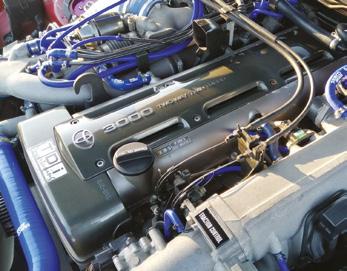
With its sizeable tail spoiler and bonnet scoop Toyota’s A80 model Supra Turbo certainly displayed the hallmarks of a performance 2+2, yet few British drivers will have experienced its full potential, as the sale car is understood to be one of just 250 genuine UK specification examples made. Think 320bhp resulting in a 0-60mph acceleration time in the mid 4 second bracket and an electronically-limited top speed of 155mph, rising to nearer 180mph if unfettered – i.e. serious performance even by today’s standards.
This rare UK-market Toyota Supra Mk4 Twin Turbo was originally delivered to its fortunate first owner by Rylands Solihull and registered on the 14th of November 1994. Finished in striking Red paintwork with a Beige leather interior, it is fitted with a 3.0-litre twin-turbocharged ‘2JZ-GTE’ straight-six engine, producing 326bhp, coupled to a Getrag V160 six-speed manual gearbox with a Torsen limited-slip differential. Further improvements and upgrades include ‘Blitz Techno’ staggeredfitment alloy wheels with Pirelli P Zero Nero tyres, Brembo Gran Turismo brakes, a TRD fuel cap, adjustable HKS coilover suspension, an HKS competition exhaust and front-mounted intercooler, HKS and Samco hoses, braided oil cooler hoses, an HKS Electronic Valve controller and A-pillar mounted gauges, Momo pedals and a Cobra Cat 1 alarm system.
The history file accompanying the car shows that this Supra has been very well looked after and serviced regularly. In July 2021 it was serviced by Revolution of Bromyard, which included a timing belt replacement, fresh fluids and filters and two new Pirelli P Zero Nero rear tyres. According to the vendor the car drives and handles beautifully and is in stunning condition inside and out, having covered only 49,000 miles. It has had just four previous keepers on the V5c and was in single-family ownership from 2002 to 2021. Forming part of a private collection of 1980s and 1990s Japanese vehicles and having been used sparingly it is now offered for sale including the cherished registration ABJ 746. Accompanying the car is a large history file with owners handbook, stamped service book, invoices, workshop handbooks and drawings, tools and two sets of keys.

Historically, and thus far, the most important Porsche model has been the 1964-introduced 911, which was to remain in production in much the same form for the next 30 years, albeit progressively updated and modified. With a basically similar layout to the 356, the new 911 was built on a steel platform chassis with suspension by torsion bars, Macpherson struts at the front and trailing arms at the rear. The first version of the 911 was powered by an air-cooled 2-litre, horizontally opposed six with 5-speed box first used on the 904 competition coupe. Capacity increased, first to 2.4, then 2.7-litres, whilst from 1984, the capacity of the legendary Porsche motor was increased from 3.0 to 3.2-litres and the SC 911 became the 911 Carrera.
Supplied new by JCT600 of Leeds, this Carrera 3.2 Sport displays just c.67,700 miles from new and has been looked after in current ownership since 2013. This is a desirable 1988-model year (‘J’ Series) example with the preferred G50 manual gearbox. Finished in the rare and stunning combination of Diamantblau Metallic (LM5U Diamond Blue Met.) which was only offered for two years; the matching Black leather upholstery complements the exterior colour and the marque. 2012 saw the car receiving refreshed paintwork and the interior trimmed in its factory colours.
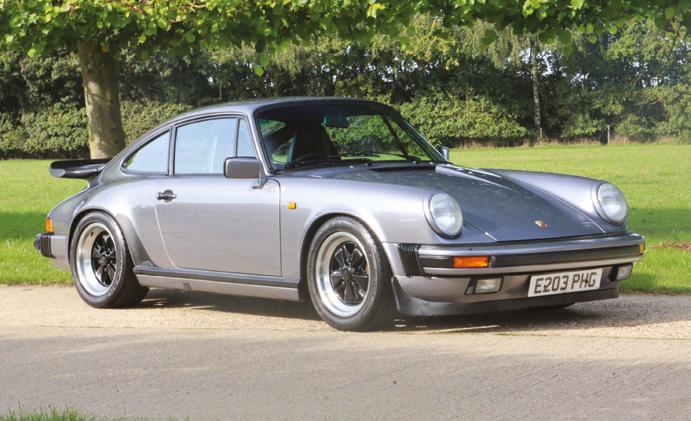

‘E203 PHG’ is offered with 2 keys and the original book pack, with it’s owner’s manual and service book, the latter containing twenty-two entries. Additionally, there is a large collection of old MOTs and tax discs and with many invoices which include mechanical work in 2005. The last minor service was at 66,236 miles. The car benefits from a recent new battery, speed sensor, and a new front brake caliper in September 2022. The MOT runs through into April 2023. The vendor currently grades the paintwork, bodywork, interior, engine and gearbox as ‘Very Good/ Excellent’.

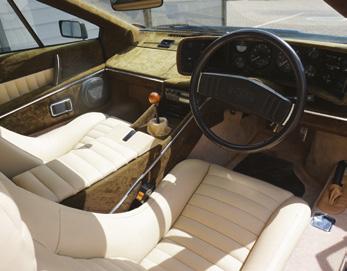
On the 27th July 1978, Lotus released details of the Esprit S2. The S2 was primarily a machine of greater creature comfort, rather than of improved performance. Made between 1978 and 1981, 1,061 S2s rolled of the production line. The top speed claim remained at 138mph for the 2.0 litre engine, whilst stability was improved via the use of the integrated front spoiler rather than a blade spoiler, seen on the S1. Additional aero included a set of ‘ears’ that were grafted onto the rear side windows and the S2’s rear received ribbed Rover SD1 tail lamps.


Finished in Bermuda Blue Metallic with cream leather interior. Offered here, is a Series 2 built for the 1980 home market. It presents extremely well, having had many thousands of pounds spent by its previous owner on a restoration project over a number of years. The car has been off the road and dry stored since 2014. Very low mileage of c.48,000, which is believed genuine. Mechanically, has had a thorough going over, servicing the engine, replacing the cambelt, manifold gaskets, cam cover gaskets, oil and filters etc. The engine and bay were then detailed and the cam covers were powder-coated and polished resulting in a superbly presented engine bay. The rear brake discs were replaced and the calipers were stripped and rebuilt and the front brakes were stripped & cleaned. The underside and suspension components of the car were then cleaned and the underside treated with fresh underseal. The interior was removed and completely re-carpeted and the seats cleaned and refreshed. The exterior was given a full respray and then polished & ceramic coated and the car sits on its fully refurbished alloy wheels.
A file with a large number of receipts and MOT certificates etc. accompanies this stunning Esprit, an iconic British Sportscar that comes fully prepared along with a fresh MOT ready for its new owner to enjoy. This is a fantastic opportunity to own a piece of British motoring heritage.

Porsche introduced the 944 in 1982 to replace the Porsche 924 as their entry-level model, although the 924 continued until 1988 as an even lower-priced alternative. Many Porsche enthusiasts considered the 944 to be the first real front engine Porsche, because it didn’t have the Audi sourced 2.0 litre engine from the 924. Instead, the 944 started life with a 2.5 litre straight-4 engine which was based on one-half of the Porsche 928’s V8 engine. Based on the earlier 924 body, some noticeable changes included flared wings, flared quarter panel and a larger rear spoiler.

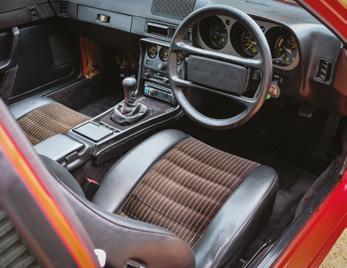
Presented in Guards Red with contrasting Black cloth interior, this 1984 Porsche 944 was purchased by its current owner in 2013 with the intention of undertaking some minor renovations, but unfortunately never found the time. The car has been stored in a dry barn, with the condition of the interior and plastics clearly showing this, but is now offered for sale due to relocation. Subject to a recommissioning service including oil filter and plugs on 03 May 2022, this particular example is offered with related registration ‘OIB 9442’, as well as a small number of spares including drive belts, replacement gear cover and more. The odometer currently displays only 89,203 miles.
Offered with the vehicle is a comprehensive history containing a Haynes repair manual, 2x 944 service information manuals, its original leather bookpack containing pocket guide to Porsche ownership, letter from Porsche GB, Porsche Possessions booklet, Porsche directory and service booklet and maintenance book containing 10 stamps. Also included is a large collection of previous MOTs dating back to 1989, with most years from 1989 to 2005. As well as this, an extensive collection of previous invoices dating back to 1990.
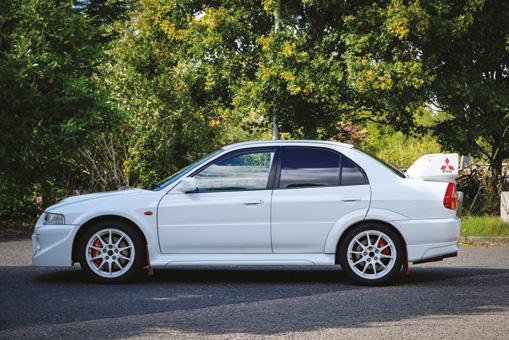
Estimate: £38,000 - £45,000*
By mid-1996, Mitsubishi’s rallying success began to really reflect in Lancer Evolution sales. The 1996 WRC season brought Mitsubishi, together with a blisteringly quick Finn named Tommi Makinen, its first World Rally Championship drivers’ title. The fiercely competitive Makinen borrowed the phrase “maximum attack” and used it to devastating effect. By 1997, rallying had captured the imagination of petrol-heads all over the world and Mitsubishi sold 6,000 Evolution IVs in the first three days of its launch! In quick succession, the Lancer Evolution VI came to be and in the latter-half of 1999, Mitsubishi unleashed a special edition to celebrate its favourite son’s four consecutive WRC drivers’ titles from 1996-1999 - the Mitsubishi Lancer Evolution VI ‘Tommi Makinen Edition’ (TME). The Evolution VI was already a technological tour de force, but the TME had a more responsive titanium turbocharger, uprated and lowered suspension (‘tuned to give improved initial response on tarmac surfaces’), quicker steering, a different exhaust, a new ECU, beefed-up transfer case internals, a redesigned front bumper for even better cooling and authentic 17-inch WRC Enkei alloy wheels. Plus, there was a special interior, featuring embossed Recaro seats, a MOMO steering wheel and red stitching. The performance upgrades saw the 0-60 mph sprint obliterated in 4.4 seconds and a maximum top speed of 150 mph. Power was rumoured to be over 300 bhp, rather than the 276 bhp ‘agreement’.
This particular Tommi Makinen Evo VI, a Japanese market car brought to the UK in November of 2006, is presented in the incredibly attractive combination of white with white wheels, and contrasting red and black embossed Recaro seats. Offered for sale with just 55,458 miles on the odometer, this incredibly collectible example has benefited from having had just 2 former keepers over the 16 years it has been in the UK. ‘W221 EHR’ has recently been subject to all 4 wheels refurbished with new centre caps, which have then been dressed in 4 new Toyo Proxes sport tyres, as well as a new battery. Unusually for a Japanese import, the vehicle is an extensive history file. Included is the Japanese service book, two Japanese owner’s manuals and further Japanese manuals, the number plate authorisation certificate, an English unstamped service book, most MOT certificates from 2006 to current, a large collection of previous receipts and invoices and a spare set of keys. The vendor rates the condition of the bodywork, paintwork, electrical equipment and interior trim all as ‘Excellent’, with the engine and transmission ‘Very Good’ purely as they are not standard.
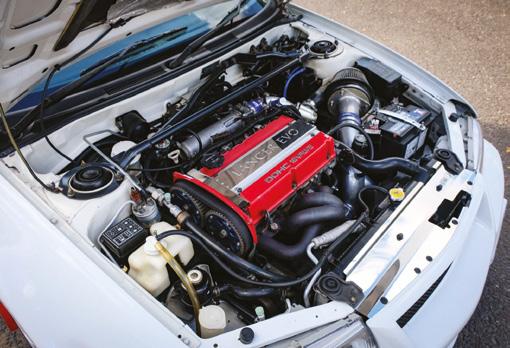




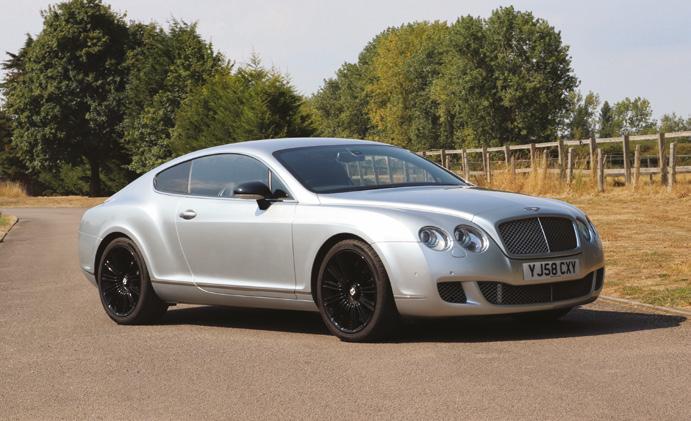

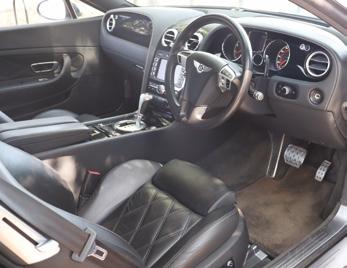
Launched in 2007 at Laguna Village Polo and the Frankfurt Motor Show, the Continental GT Speed, available on the twodoor coupe platform only, featured an increase in power over the standard W12 being rated at 602bhp with 553 lb-ft of torque. 35kg was shaved off the weight over the normal GT, whilst its lower ride height and revised spring / damper and anti-roll bar settings improved handling. The 0-60mph sprint now took 4.3sec instead of the 4.6sec needed in the regular GT, and the top speed rose to 202mph. This electrifying performance was delivered to the road via 20” alloys with bespoke Pirelli P-Zero tyres. Further developments included the speed-sensitive Servotronic system being retuned, a solid-mounted front subframe and stiffer rear bushings added, and a ‘Dynamic’ mode for the Bosch 8.1 ESP system introduced. The front grille and lower air intakes were housed in a dark-tinted chrome matrix whilst wider rifled sports exhaust tail pipes adorned the rear.
Finished in Silver with contrasting Black leather upholstery, multi-spoke alloy wheels and interior wood accents, ‘YJ58 CXY’ has covered just 54,500 miles from new. A stunning looking machine, the Continental GT benefited from replacement rear exhaust boxes and repainted brake calipers in 2019. Treated to the last of eleven services during July 2020 (circa 1,400 miles ago), there can be few such inexpensive entries to 600bhp and 200mph-plus motoring! Steeped in history, it is almost a century since the ‘Speed’ moniker was first applied to a Bentley. Then, as now, it denotes a very special motorcar. Offered for sale with V5C Registration Document, stamped service book and DVLA MOT history (the current certificate being valid until January 2023).

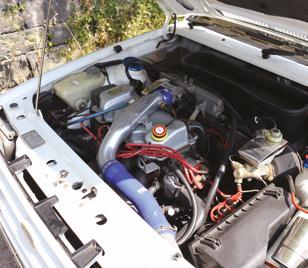
Estimate: £18,000 - £22,000*
Developed by Ford’s Special Vehicle Engineering Department, the Escort RS Turbo broke cover in October 1984. A production run of 5,000 was planned to homologate the model for Group A competition but demand was such that 8,604 were made (with 5,576 being UK supplied). Only available in Diamond White - except for Lady Diana Spencer’s unique Black example - the three-door sported a comprehensive body kit and was powered by a turbocharged 1597cc CVH four-cylinder engine allied to a five-speed manual transmission. With some 132bhp and 133lbft of torque on tap, the ‘fast Ford’ was reputedly capable of 0-60mph in 7.8 seconds and 128mph. Described by Motor Sport magazine as “perhaps the most enjoyable hot hatch currently available on the British market”, the Escort RS Turbo attracted a cult following that has gone from strength to strength, and with the model approaching its 40th anniversary, they could well be a very shrewd investment.

Manufactured in 1984, this RS Turbo was supplied new on the 25th of February by Hooley’s Garage Ltd of Nottingham to the first owner, Auto Windscreens of Chesterfield, who are understood to have ordered new a few Series 1 Escort RS Turbos, with this example being registered as ‘15 CXO’. Finished in the solely available colour of Diamond White matched to the iconic Grey Recaro interior upholstery, the Escort is thought to have been retained by Auto Windscreens until 1988. Presenting for sale now having covered a modest 83,136 miles from new (at time of consignment), ‘B490 GWF’ has been in current ownership since 2014 with seven former keepers.
While in the vendor’s possession, the Escort has benefitted from a new cambelt and tensioner less than 500 miles previous, as well as more recently, refurbishment of the RS alloy wheels, a replacement battery, and servicing. Offered with a large history file which contains the book pack comprising Motorists, Operations, and Dealer Guides, as well as the original service book. Also present is a handwritten log of ‘B490 GWFs’ maintenance, improvement, and servicing from 1990 onwards, with invoices dating back to 1990, twenty-eight MOT certificates dating back to 1989 (including a ‘no advisory’ MOT until June 2023), over twenty tax discs (dating onwards from 1992), a workshop manual, and a current V5C document completing the documents on file.
Subject to a £150,000 build and producing some 750hp!
The original much-vaunted series of GTOs reigned from 1964 to 1974 and were classic muscle cars of the period. Forced to adhere to the US manufacturers’ voluntary ban on factory-sponsored racing, GM had turned its attention to optimising the performance of its road cars, in order to maintain the interest of the young American enthusiast. The GTO was essentially the brainchild of three men - engine specialist Russell Gee, chassis engineer Bill Collins, and chief engineer John DeLorean; who later achieved fame for the car bearing his name and cheating the British taxpayer of millions of pounds. The GTO was DeLorean’s clever idea, but one strongly resented by Ferrari enthusiasts.

Originally conceived as a bare-bones, entry-level performance car, with the aim to counter the Plymouth Road Runner, the GTO Judge evolved into a top-of-the-line model for the GTO series and was available in both coupe and convertible body styles. In today’s market, the GTO Judge is now one of the most sought-after GTOs ever produced.
Manufactured in 1969, the GTO Judge offered has had somewhat an international existence, arriving in the United Kingdom very shortly after manufacture, and is thought to have resided in France at some stage since, reputedly while in the ownership of Argentinian footballer Javier Pastore during his time at Paris Saint-Germain F.C. Finished in the signature colour combination of Orange with Black leather interior upholstery, the Pontiac was the beneficiary of an extensive restoration and upgrade build in c.2000 with the cost understood to be somewhere in the region of £150,000 and producing a Judge with a massive specification and yielding around 750 horsepower.
The engine of choice was a Lamude Racing 455ci V8 with forged pistons, roller COMP cam, Edelbrock

Performer aluminium cylinder heads, Vortech supercharger, Holley dominator ECU, bespoke wiring loom, Edelbrock manifold fuel rails, Powertec starter motor, and an uprated regulator. The engine specification goes on with an uprated alternator, Accusump oiling system with electronic control, MSD ignition, distributor, 10mm leads, and with built-in full data logging. A Pro Alloy fuel tank with collector, Aeromotive fuel pump and filters and Aeroquip fuel lines throughout provides the fuelling with a Pro Alloy radiator, intercooler, and pipework cooling the V8.
Power is transmitted to the wheels through a Jerico five-speed straight cut dog gearbox and McLeod twin-plate clutch. Underneath, a Mark Williams nine-inch fabricated axle, locking differential, StrongArms front suspension, Hotchkis rear sport suspension (adjustable), and Halo adjustable dampers with Eibach springs all round control the ride and Baer/Alcon discs and calipers all round, allow the 750hp GTO the stopping power required.
The interior has been upgraded with diamond stitched leather upholstery and GTO embossing seats, Autometer gauges, a Hurst shifter, a hydraulic handbrake, and an adjustable AP Racing pedal box. The shell was provided with a full body-off restoration with bare metal re-painting and the external appearance is completed with 20-inch forged American racing wheels with Michelin Pilot tyres and an uprated exhaust system.
Recently receiving a gearbox overhaul and clutch inspection in preparation for sale, as well as servicing and valve lash checked, the Pontiac is now offered to the market as an exciting opportunity, that will undoubtedly get the blood pumping, and that is certainly not for the faint hearted! The 750hp muscle car is offered with a large history file which includes a vast quantity of invoices, previous MOT certificates, and a current V5C document
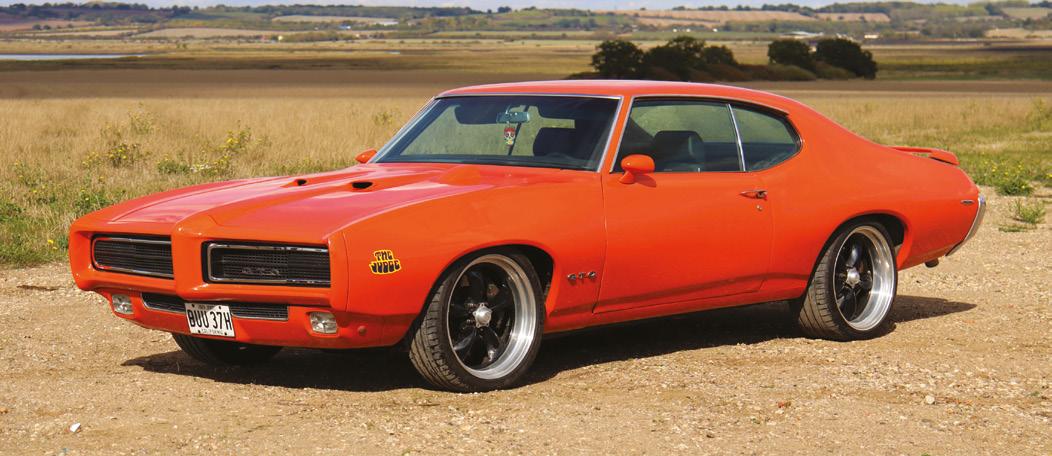
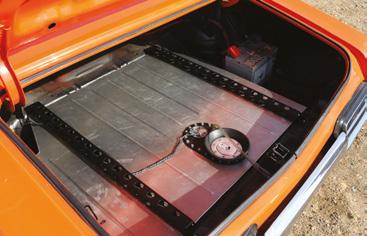


One owner and just c.19,000 miles
Estimate: £23,000 - £26,000*
Reg No: PJ09 TYU MOT: June 2023
Chassis No: JHMAP11308S200820
The S2000 was Honda’s 50th birthday present to itself. From its 1999 launch to its retirement in 2009, it had the ability to more than hold its own against the Porsche Boxster for the thrills and ability. Powered by the 2.0 litre VTEC engine, exotic and reliable engine performance could be had without a turbocharger. The later Suzuka-built examples, benefitted from many improvements, such as the suspension, with improved geometry and stability. A subframe revision improved rigidity. Revised cosmetics included the bumpers and lights.

H&H are delighted to offer for sale this beautiful Honda S2000 2.0i VTEC Roadster finished in red with a full black leather interior. This is truly a stunning example that has covered less than 20,000 miles and has only one owner from new. PJ09 TYU also boasts a complete Honda service history as documented in the service book. The vendor has looked after and maintained this car incredibly well and it was last serviced by Honda at the beginning of June 2022. The overall condition of this wonderful car has to be seen to be fully appreciated.
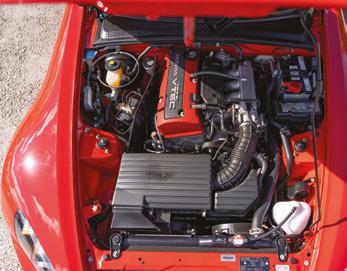

£32,000 - £36,000*
Introduced in 2004, the 997-series of Porsche’s iconic 911 allied all the technological improvements of its 996-series predecessor – a lighter / stiffer bodyshell, better suspension / brakes, four-valve cylinder heads and a superior HVAC system – to more classical styling. Available in Carrera or Carrera S guises when launched, the latter boasted a more powerful 3.8 litre engine (rated at 350bhp/295lbft), sports exhaust, Porsche Active Suspension Management (PASM) and 19-inch wheels as standard. Reputedly capable of 0-60mph in 4.6 seconds and 182mph, it soon became a driver’s favourite. Better built and better looking than a 996 and smaller and more agile than a 991 (or current 992), great examples of 997 manual gearbox cars are becoming increasingly collectible.
Finished in the handsome combination of Aluminium Silver with Metropole Blue leather upholstery, ‘CN56 NYG’ was also specified with a sunroof, cruise control, Sat Nav, upgraded BOSE stereo and electric / memory front seats. Supplied new by Porsche Centre Cardiff, the 997 is warranted to have covered just 48,900 miles from new and to have been main dealer serviced up until 37,780 miles. Thereafter, it has been looked after by various specialists. Acquired by its last registered keeper in February 2014, the past 6,000 miles have seen the Coupe treated to a new brake boost vacuum tandem pump, Sachs clutch, rear main seal, air-conditioning condensers, front brake discs, coolant / AC hard lines and timing chain tensioner sealing washers etc. Last serviced by Octane Garage of Crowborough during December 2021 at 48,768 miles (including fresh brake fluid and spark plugs), the 2+2-seater started readily and ran well during our recent photography session. Able to outrun and outhandle 1980s supercars like the Ferrari Testarossa or Lamborghini Countach yet tractable enough to trundle to Tesco, the Porsche 997 is for many the definition of a modern classic. Offered for sale with V5C Registration Document, book pack and history file, this smart, low mileage, manual gearbox 3.8 S example has much to recommend


The limited-edition RS500 Focus launched for its global debut at the Leipzig Motor Show in April 2010 and marked the final swansong for the remarkable Focus RS second generation. Designated to highlight its strictly limited production run of 500 vehicles, all sporting their own individual number, power was provided by a 2.5-litre, 5-cylinder engine, which generated 15% more power than the standard Focus RS, with some 345bhp, driving the front wheels via a six-speed manual transmission. Sporting a unique matt-black paint finish and then given a professional 3M satin foil film wrap to complete the exterior, with matching alloy wheels, the raw appearance was completed with 19-inch wheels, flared arches, a deep diffuser, and a wing that would embarrass a Porsche Turbo, leaving no doubt about its intentions and delivering a powerful visual impact unmatched by any other production Ford. The ultimate performance Ford at the time of launch, the last of these remarkable vehicles left Ford’s Assembly Plant in Germany in September 2010.
One of just 101 examples supplied new to the United Kingdom, number 129 of the 500 total cars, was distributed to Ford dealers Cliff Dickenson & Son, and registered new to the Director at the time. Finished in the iconic matt Panther Black, the RS500 passed to a second keeper before being repurchased by the Cliff Dickenson Director. Subsequently purchased by the vendor in 2012 (equating to four recorded owners across three individuals), it has been retained in his ownership ever since, and at the time of consignment has covered a mere 7,879 miles from new. Factory equipment includes the Lux Pack 2, comprising a seven-inch screen with satellite navigation and a rear-view camera.
While in the vendor’s possession, the RS500 has benefitted from a fully refurbished head unit by Blaupunkt in Germany to the cost of some £550, as well as a replacement cambelt, water pump, and auxiliary belts and tensioners in 2020 at 7,396 miles (with the originals still accompanying the car). Serviced solely by manufacturer main agents with eleven service records, the most recent being completed in July this year at 7,851 miles. A further three body and paint record stamps and a brake fluid change stamp are shown in the accompanying service book, all also from Ford dealers. Offered with a history file which contains the full original book pack comprising the handbook, service book, quick guide, and initial shipping tags and stickers, amongst more, the file also contains corresponding service invoices, the vendors purchase invoice, a letter from Cliff Dickenson & Son, a no advisory MOT until August 2023 and a current V5C document.
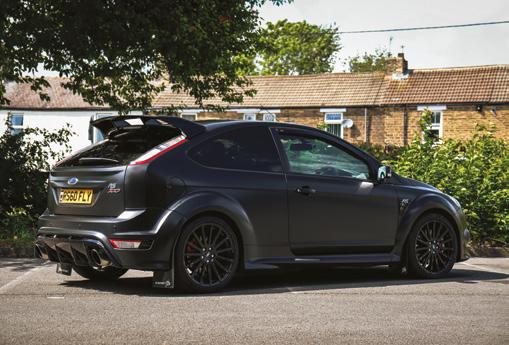
Provided a new battery and four tyres in 2021, the vendor has changed the inlet plenum (a known fragility of RS500s), as well as the fog lights and Ford wheel badges, but the originals are all accompanying. Pleasingly retaining the factory Continental Puncture Pack, and seat cover, the Focus is offered with the apt registration number of ‘RS60 FLY’. Surely a great opportunity for the “Fast Road” collector, especially being a low mileage example?
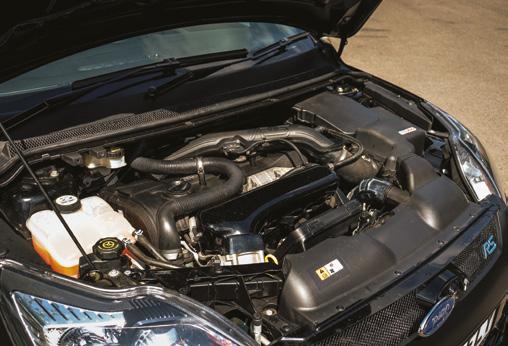



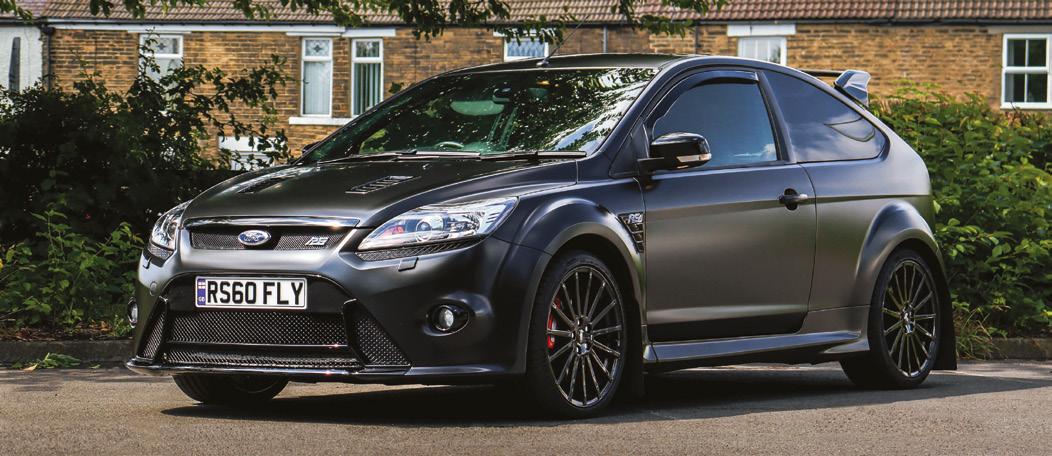

No: CA2SB/118701A
The Mini was actually detuned before launch in 1959. The prototype’s 948cc engine made it embarrassingly rapid compared with other more expensive cars in the BMC group, and it was downgraded to 848cc and 34bhp. A collaboration between racing car builder John Cooper and the Mini’s creator Alec Issigonis, the Mini Cooper debuted in September 1961 with the ultimate 1275cc S variant arriving three years later. Famously winning the Monte Carlo Rally for the third time in 1967, that same year saw the Mini updated to MkII specification complete with redesigned radiator grille, revamped interior, larger rear windscreen and a host of other minor changes. Total MkII Cooper S production across both Austin and Morris brands amounted to just 6,300 cars.

Built on the 21st of August 1968 and issued the London registration number ‘WLH 297G’in February of 1969, this is a 1968 MkII Mini Cooper S that is known to the Mini Cooper Register. It will come as no surprise then that this S is accompanied by a British Motor Industry Heritage Trust Certificate. The BMIHT Certificate states that the car was built for the right-hand drive home market in Snowberry White with a Black roof . The car has previously benefitted from an extensive restoration some years ago, c.1989, and still appears to be in excellent order, with the paintwork holding up well. ‘WLH’ wears some desirable extras that include MkII Cooper S factory-style reclining seats (from Newton Commercial in 2015), Dunlop alloy wheels, a tachometer, a polished steering wheel and period front spot lamps.
Of the many receipts, an engine, gearbox and head overhaul was carried out in 2002 by MED Race Engines of Leicester. A history file includes sundry restoration photos, numerous bills, old tax discs and MOT certificates and so on, dating back through the decades.

Estimate: £24,000 - £28,000*
Chassis No: SB2541
Typifying the maxim that a whole can be greater than the sum of its parts, the Lotus Seven was introduced at the 1957 Earls Court Motor Show. Based around a multi-tubular spaceframe chassis, the aluminium-panelled newcomer was powered by a choice of Ford 100E, Coventry Climax FWA or BMC A-series engines. Popular with sporting motorists and club racers alike, the Lotus Seven evolved through Series 2, 3 and 4 guises before the design rights were sold to Caterham in 1973.
Looking at Lotus Register information, it indicates ‘TDD 354H’ left the factory on the 17th of October of 1969 and was first registered in Gloucestershire of that year. 1 of just c.340 Series 3 Lotus 7s made, before production ceased in 1969, this pretty example still possesses ‘in-period’ features. ‘TDD’ has benefitted from a recent restoration, however, it remains a notably correct car with what we understand to be its original factory bodywork throughout, original Lotus 7 steering wheel, road wheels and even windscreen bolts etc.
An extensive history file documents the car over the decades with many receipts reflecting sensitive upgrades and maintenance and they include invoices from Caterham Cars. Amongst the receipts are those for; a rev’ counter repair in 2013 and a carburettor rebuild kit; new starter motor; new seat belts and a new manifold in 2015. Around this time a modified Ford Crossflow head was made to 1.580 x 1.340 with hardened seats. As part of the file, there are old MOT certificates dating back to the 1980s, along with an old ‘Blue’ V5 document. A notebook documents the car through maintenance entry notes from 10,766 miles up to 83,575 miles! The factory-fitted engine has been thoroughly overhauled to ‘Supersprint’ (1700cc) specification and still requires runningin. The car is offered complete with the current V5C.

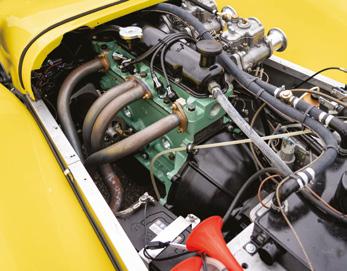

Everything about the Bentley Continental Supersports was engineered for a single purpose: to deliver the most exhilarating driving experience possible from behind the wheel of a Bentley. The fastest, most powerful Bentley ever, it features a significantly tuned, more powerful twin-turbocharged engine and extensive use of lightweight components throughout, including carbon fibre and Alcantara interior trim, and the largest carbon fibre-reinforced silicon carbide ceramic disc brakes on a production car. The result was 0–60 mph in 3.7 seconds and a top speed of 204 mph. In 2011, the original Supersports was joined by a convertible version that lost virtually nothing to its coupe sibling; 0–60 still took 3.9 seconds and top speed was down by only two, to 202 mph.
Costing some c.£190,000 when new, ‘HF61 ETL’ was manufactured in 2011, being supplied new through Bentley Hampshire in Lyndhurst. Fitted with the 6.0-litre W12 twin-turbocharged engine allied to the six-speed automatic transmission, the Bentley is finished in Tempest Grey metallic paintwork with Beluga Charcoal leather interior upholstery on carbon sports seats. The interior is finished with carbon fibre dash inlays, diamond-quilted Alcantara door panels, drilled-alloy sports foot pedals, and a wind deflector. In current registered ownership since 2018, the Supersport has had just three former keepers and had covered a mere 34,570 miles from new at the time of consignment.


Specified from new with the cost optional extras of the enhanced vehicle tracker system, powered boot opening and closing, rear-view camera (in addition to the ultrasonic park distance control), TV tuner to the infotainment system, 20’’ Supersport wheels, and space-saving spare wheel. Further equipped from standard with Bluetooth telephone system, CD-Changer, cruise control, climate control, heated front seats, navigation with colour screen, rain sensitive wipers, electronic sports air suspension, ventilated and cross-drilled brake discs.
Offered with a history file which includes the original stamped service book displaying eight entries (including the PDI), all of which are from Bentley main dealers and specialists. Also included is a collection of invoices and previous MOT certificates, a no advisory MOT certificate until August 2023, a current V5C document, and two keys. Rated by the vendor as ‘very good to excellent’ in regard to paintwork, and ‘excellent’ in respect of bodywork, engine, electrical equipment, gearbox, and interior equipment.
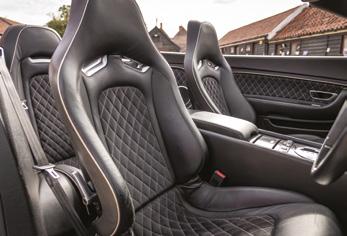

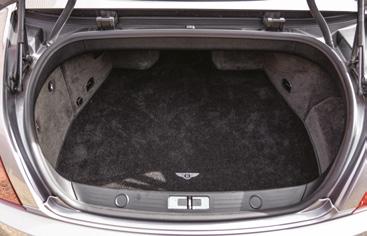

Manufactured in 2005 and presented in Basalt Black Metallic with matching Black leather interior, this desirable manual Carrera S Cabriolet shows just 45,956 miles from new with only 3 former keepers. Benefitting from a very high factory specification including Porsche Active Suspension Management with Electronic Damper Control, Porsche Stability Management, sports exhaust system, park distance control, xenon lighting system with headlamp washers, electric and heated mirrors, Porsche Communication Management 2 (with PCM 3 basic module and telephone) with CD autochanger, Euro navigation, BOSE sound system, heated hardback sports seats with seatbelts in Guards Red and Silver instrument dials, this presents a fantastic opportunity for any Porsche enthusiast looking for a high specification vehicle.


Not only does ‘HF05 GXW’ have a high specification, but the car has also benefited from a borescope inspection along with major service in July 2021, which came back all clear. More recently between October and November 2021, the car has benefited from a number of works to bring it to standard, including replacement switches for AC controls, a Dansk exhaust system with tailpipes, replacement wheel bolts with turbo 2 design wheel centre caps and the roof module repaired and calibrated. The cost of these works totalled over £2,400.
Accompanied with the vehicle is its original leather bookpack containing a number of bookletst. Please note there is no Service booklet, however, Porsche have confirmed the car was serviced both 2016 and 2019 at 44,564 miles in addition to the major service mentioned above in July 2021 at 45,687 miles including drivebelt, air, oil and pollen filters, spark plugs and fluids. In addition, here, a replacement Bosch battery was fitted. There is a small collection of previous receipts and invoices, as well as the V5C document which displays 3 former keepers.
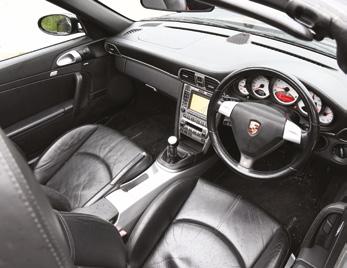

Estimate: £20,000 - £24,000*
Chassis No: XE2D2629583A
Offered with an MSA passport up until 2029, this is a ‘rally spec.’ 1275 GT build, which was completed in 2019 and has seen very little use since. Originally, this Mini 1275 GT was supplied new by Mann Egerton Co. Ltd of London, to a Mr Church of London. The service book still retains some service stamps and with its current ownership dating from 1989. The body has been prepared with a strengthened front subframe and looks every inch the rally car with its Cibie Oscar spot lamps and Dural sumpguard. It wears four new Revolution 12” wheels with Yokohama tyres and is has two spare wheels.

Power is delivered from a 1293cc engine, with a 45” DCOE carburettor and straight-cut Jack Knight gears, providing a sound that evokes the memory of historic Mini racers. Circa 87bhp can be found at the flywheel, the output aided by a Peter Burgess race head and rally cam, balanced crank, steel flywheel and competition clutch. Fuelling from a large capacity tank is via an electric fuel pump with gases exiting via a 3 branch competition manifold. Cooling is aided by an alloy radiator. Other rallying enhancements have been suitably made to the running gear, brakes with 8.4” discs and Mintex 1144 brake pads and for the purpose of regulated safety specifications which include an FIA safety devices roll cage with door bars.
Offered with a new MOT certificate as well as the original owner’s wallet (handbook and passport to service) and a collection of invoices.



Reg No: W271 EWL MOT: August 2023
Chassis No: 8D1N900385
First registered on the 18th of July 2000, this particular car was retained by Audi UK as its Press Demonstrator and featured in several car publications, most notably in Evo Magazine, a copy of which accompanies the car. This RS4 is finished in a striking Avus Silver with the Black RS Recaro leather sports interior. The current owner has fitted a different set of Recaro seats with painted seat backs but has retained the original Recaro seats which are still in excellent condition. From new the car has always been meticulously maintained, as evidenced by the stamped service booklet and a sheaf of invoices. The history file also includes email correspondence with Audi confirming W271 EWL as being one of their cars, old MOTs and Tax discs. Described by the vendor as being in excellent condition cosmetically and mechanically, having just had a full service, new cam belt and water pump, new Clutch, flywheel, Bilstein B16 suspension and new rear suspension turrets, throttle body and a brake fluid change, this very special and beautifully presented RS4 comes with some additional exciting extras. Firstly, it still has the very rarely seen Pewter Scale Model which was presented to owners of the new cars upon delivery. Secondly, a full Press Introduction Kit released by Audi inclusive of 3 sets of negatives, glossy press photos & full Audi narrative on the car and the cars release complete with handwritten notes by Brian Laban. Thirdly, renowned Audi specialist QST undertook sympathetic modifications, including full MTM brake caliper and disc upgrade, full stainless steel Miltek exhaust system, and a custom remap to 430 bhp. The power is validated by a rolling road test and printout by QST in 2019 which is also in the history file. The exceptional condition of this historically significant car, together with its Audi AG provenance and all the extras must surely put this at the top of any RS4 lover’s wish list.


Introduced in 2004, the 997-series of Porsche’s iconic 911 allied all the technological improvements of its 996-series predecessor – a lighter / stiffer bodyshell, better suspension/brakes, four-valve cylinder heads and a superior HVAC system – to more classical styling. Available in Carrera or Carrera S guises when launched, the former allied a 3.6 litre engine (rated at 321bhp/273lbft) to either a six-speed manual or five-speed Tiptronic transmission. Reputedly capable of 0-60mph in 4.8 seconds and 178mph, it may have been outgunned by some of its siblings but arguably offered the sweetest driving experience. Better built and better looking than a 996 and smaller and more agile than a 991 (or current 992), great examples of the 997 cars are becoming increasingly collectible.

Manufactured in 2007, the 911 offered was first registered in the United Kingdom on the 5th of May that year. Fitted with the 3824cc flat-six twin-turbocharged engine allied to the five-speed Tiptronic transmission, the Porsche is finished triple Black with Black paintwork, Black leather interior upholstery, and Black alloy wheels. ‘SM07 GWL’ has covered some 92,000 miles from new and has had only four former keepers. Specified from new with optional extras including PCM navigation module, sports exhaust system, Park Assist, electric sports seats, and stainlesssteel entry guards, the 911 is rated as ‘good’ throughout by the vendor. Offered with the original stamped service book which displays eleven entries (all present from Porsche main agents and specialists) as well as three brake fluid changes. The Porsche is accompanied by a current V5C document.and due to possess a fresh MOT at the time of sale.

Reputedly one of the Ford press and development cars
Where the Ford ‘RS’ moniker started. The RS1600 was announced in 1970 and was the successor to the Escort Twin Cam model. 1970 was a year when the Daily Mirror World Cup Rally was won by Hannu Mikkola driving a Ford Escort whilst Escorts also won 1st, 3rd, 5th, 6th positions. A 16 valve double overhead cam replaced the twin cam of the earlier performance model, the Twin Cam. As well as higher performance engines and sports suspension, like the Mexico these models featured a strengthened bodyshell.

‘GNO468H’ is believed to be one of the Ford press and development cars. It carries the ‘GNO’ plate, so often seen on these related to the Ford factory marketing and development activity and ‘Works’ cars, in fact it is ‘53’ number plate digits different than a Hannu Mikkola ‘Works’ Escort Twin Cam. An article in a club newsletter by William Arnold refers to the car as one of the Escort RS1600 ‘Press cars...’ also used ‘for development purposes’.
Evidently, the Escort has been used in Historic Rallying, with much of the specification retaining factory spec. or typical ‘in-period’ motorsport upgrades. ‘GNO 468H’ competed regularly as an RS2000 Mk1 between 2002 and 2010 as part of the British Historic rallying season, entered into Class C3 for the Bulldog Historic Rally 2002/2009; Harry Flatters Historic Rally 2008/2009; Robin Hood Historic Stages 2003/2004/2008; Pirelli Historic Rally 2009/2010 and the Isle of Man Historic Rally in 2009/2010, amongst others.
The 2002 MSA Competition Car Log Book is present, showing that in 2002 MSA documents state an engine code of D179428 (Pinto engine) and the specification uprated to RS2000 specification and a 2038cc fitted with twin Weber 45 DCOE carbs. Other details from the early 2000s, state the car fitted with an alloy dry sump tank and oil pump, alloy 13” x 6” Minilite 8 spoke alloy rims and Polycarbonate windows. There is a Brantz 2 rally navigator trip computer and motorsport seats and roll cage etc. Accompanying this RS Escort are multiple MSA documents, a copy of the ownership history from the DVLA and invoices relating to the maintenance of the car in recent years.



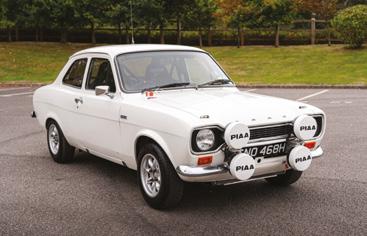

Finished to a high specification
Launched in 1964, the Mustang was originally offered in Notchback Coupe or Convertible guise only, based on the underpinnings of the Falcon and powered by a range of six- and eight-cylinder engines of up to 289ci (4.7-litre) capacity. The ultimately more famous Fastback option appeared a year later, with the model’s first significant facelift occurring during 1967. If you are a fan of the model of Mustang immortalised by Steve McQueen’s Lieutenant Frank Bullitt, and one of the most memorable car chases in cinematic history, then you’ll probably be taken by ‘JGU 257C’, which is perhaps the best 289 Fastback we have seen, and one of the highest specifications we have seen.
Manufactured on 23 November 1964 for the 1965 model year, this Mustang has had somewhat of a globetrotting history, living in Florida until it was imported to the UK in 1998. In 2009, the car was purchased by its next owner, who lived in the Netherlands, Monaco and back to the UK, with the car in that ownership being used on a number of European road rallies at the time. In April of 2020, the car was purchased by its current owner, with the car being stored professionally since.

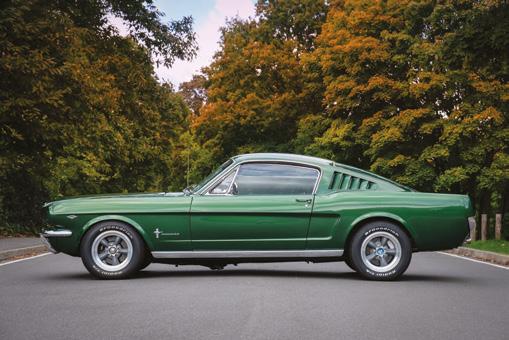
Presented in a beautiful shade of Pearlescent Green with contrasting Black interior, ‘JGU 257C’ benefits from an impressive specification, including Ron Morris adjustable engine mounts, Edelbrock Performer Aluminium cylinder heads, Comp Cams magnum aluminium roller rockers, Edelbrock Performer RPM high lift hydraulic lifter camshaft, Edelbrock Performer timing gear set, Edelbrock Performer dual plane with Endurashine finish, Edelbrock Performer 4bbl 600cfm carburettor with silicone vacuum hose kit, high capacity air filter with chrome housing, MSD Pro-Billet electronic distributor with Blaster II Coil, Ford C4 Automatic transmission subject to overhaul in August of 2009 with Tru-Trac limited slip differential, Wilwood Front disc brakes with power booster and dual circuit master cylinder with proportioning valve. In addition, American Racing Torque Thrust D wheels, dressed in B F Goodrich Radial T/A tyres, Chrome plated Export Brace, heavy duty rear leaf springs with KYB Gas-A-Just shock absorbers and Prothane bushing kit, Ceramic coated exhaust with Try-Y Headers, Pypes 2.5’’ stainless steel Street Pro with X-Pipe dual exhaust and electric cut-out valves, High output 130 amp alternator with compact high torque starter motor, Wagner Brite-Lite headlights, MustangProject.com sequential LED tail lights, LED parking lights and LED instrument back lights, Grant 15’’ Riveted Walnut and brushed stainless steel steering wheel and much more.
In current ownership, the car has been subject to works including ceramic coating, pressed number plates and a Vodafone S7 tracker fitted in October 2020 at a cost of nearly £1,500. As well as this, in July 2021, power steering was fitted, along with some corrosion around the front and rear windscreen apertures rectified and replacement door seals. The total cost of this was over £4,600.
Included with the vehicle is an impressive history file, containing an extensive collection of documents from its time in the US, Europe and the UK. Included are invoices and receipts mainly from 1998 to present, in GBP, USD and EURO which total over £53,600 at today’s rates. A specification list of the vehicle lists a printed timeline of most of the major works undertaken between 2012 to present. As well as this, the history file does include a Florida title from 1989, and included is an original 1965 Mustang owner’s manual, instruction manual, spare set of keys and the current V5C document.


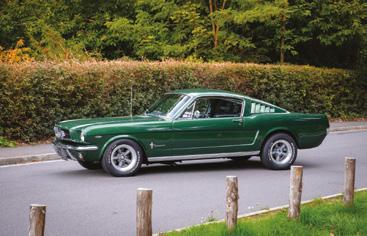

Styled by American Tony Lapine, Porsche’s front-engined, water-cooled, V8-powered 2+2 928 was launched at the 1977 Geneva Salon. Not only was it about as mechanically different to the ubiquitous 911 as it could possibly be, but represented the company’s first foray into grand touring territory. Nevertheless it received a rapturous reception from the press and was duly awarded the 1978 Car of The Year Award.

‘H567 JDE’ was originally delivered to Japan in 1991 and is finished in the rare combination of Amazon Green (Dark Blue Metallic) bodywork and a Can-Can Red hide interior trim. It was ordered with protective side mouldings, top tinted windscreen and a leather dashboard as optional extras. In 2015 the car was imported into the UK and has only had 2 previous UK keepers. A Porsche Certificate of Authenticity confirms the original details of the car.
The Porsche’s comprehensive UK history file shows that it received a lot of attention since 2015 with invoices totalling over £6850 on maintenance including cambelt, brakes and discs, suspension dampers, replacement of aged hoses and various other items. The current vendor has had the car fitted with a 928sport ceramic catalyst and stainless X-pipe imported from the USA which, according to him, add a further 30HP. The original exhaust is included in the sale. Furthermore, the tyres were upgraded to Pirelli N specification and a high end audio system was also fitted.

The vendor considers the paintwork to be in ‘really good condition’ while, following a recent service, he judges all the mechanical ‘to be in very good order’. At the time of consignment the 928 displayed a total of just over 87,000 kilometres, which roughly equates to 54,000 miles. It comes complete with a full toolkit, additional service history, owner’s books, a collection of invoices and current V5C.

Introduced at the 1995 Frankfurt Motor Show, the Lotus Elise was a driver’s car par excellence. A paragon of lightness, agility and responsiveness, the newcomer utilised a bonded extruded aluminium chassis clad with fibreglass body panels. Midmounted and allied to five-speed manual transmission, its 1.8 litre K-Series engine produced a modest 118bhp and 122lbft of torque. However, with a kerb weight of just 725kg the two-seater was capable of 0-60mph in 5.8 seconds and over 120mph. Able to glide over a broken British B-road in typical Lotus fashion, the Elise did without power steering, ABS or traction control and was all the better for it. Early models featured Metal Matrix Composite (MMC) brake discs which not only minimised unsprung weight but also provided great feel. Enthusiasts are already seeking out Series 1 cars (especially MMC equipped examples) as representing the purest incarnation of the Elise; a trend which seems bound to continue.

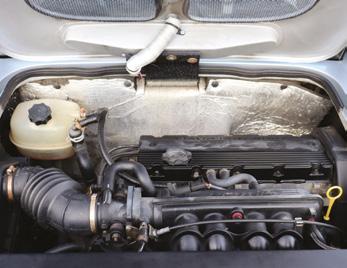
Having placed his order through the London Lotus Centre, the first owner of ‘R404 JTM’ was such a marque enthusiast that he made several trips to Hethel to observe it being built (the associated photographs remain on file). Passionate about the Elise, he not only had it serviced on an annual (and sometimes biannual) basis initially but also subtly enhanced the two-seater’s driving dynamics and interior with S2 suspension components and S2-style upholstery. Another Lotus aficionado whose uncle had worked for the Norfolk firm before becoming specialising in the marque, the vendor was drawn to ‘R404 JTM’ by its condition, originality and impressive history file. Only the car’s second owner, he rates the engine, gearbox, electrical equipment, bodywork, paintwork and interior trim as all being ‘very good overall’. The Dark Blue soft-top roof is in good order as is the ‘shower cap’ and underside. Starting readily and running well during our recent photography session, this low mileage Elise S1 has much to recommend it and would certainly grace a marque collection.

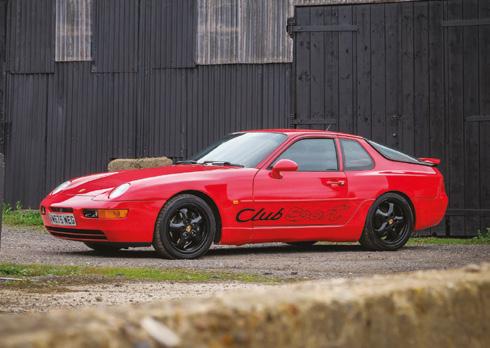
Intended for enthusiasts seeking enhanced on-track performance, the lightweight Club Sport did without much of the 968’s ‘luxury’ equipment; for example: there was less sound deadening insulation and the window lifts were hand operated, though features such as air conditioning, a sunroof, and an audio system remained available as options. The rear seats were deleted; the fronts replaced with lightweight Recaro competition seats; and a non-airbag steering wheel fitted. There was also a less complex wiring loom and a smaller battery; the result being a reduction in weight of around 100kg when compared to the standard 968. Improvements to the running gear included revised suspension, lowered ride height and 17” wheels shod with wider tyres. In 1993, the Porsche 968 Club Sport was voted ‘Performance Car of the Year’ by the UK’s Performance Car magazine. Stated by Porsche Club GB to be ‘arguably best of them all’, supported by a number of racing drivers, who have quoted it to be the best driving Porsche in Existence, the 968 Club Sport is tipped to be one of the next investment vehicles to buy and one of the greatest cars of all time.
One of 179 UK cars, this particular example, a 1994 model year car, is presented in Guards red and features the highly rare and desirable Guards Red backed Recaro bucket seats. In addition. Factory specification including Limited Slip Differential (M220) with 40% lock, side protection mouldings, top tinted windscreen and detachable and electrically operated roof panel make this a very collectible example. Subject to a full respray in 2017, ‘M675 WEG’ has benefited from extensive maintenance including a major service along with replacement fuel pipes and belts in August 2020, and a subsequent service in August of 2021 including a power steering overhaul, and Waxoyl treatment. Now showing 128,708 miles on the odometer, equating to just 4,500 per year, the car is offered for sale to its lucky new owner.
‘M675 WEG’ comes with what could well be one of the best history files we have seen. Certainly at least one of the most organised. The ring-binder included contains an abundance of invoices and receipts for work done over the years, totalling over £27,500. The folder is separated and organised by year going back to not only 1995, but before it was new, with each year having a cover page for clarity. At the front of the folder, presented is the Porsche Certificate of Authenticity which supports that this Lancaster Cambridge supplied Club Sport was originally Guards red, with the red wingback Recaro seats, with the options as mentioned above. Towards the back of the folder, included are two press release information documents on the Club Sport from 1992, which detail technical information on both the 968 Club Sport and the 968. As well as this, there are also both original brochures for the 968 and 968 CS, with an invitation to apply leaflet for the CS and of course the current UK V5C document, which, although displaying 15 former keepers, does not detract from the fact this car has clearly been well looked after throughout its life. Additionally, and importantly, also included is this car’s original leather wallet including Porsche Assistance brochure, Porsche Service directory, driver’s manual and guarantee and Maintenance manual which contains 22 stamps, with the most recent by Porsche specialists Braunton Engineering in August 2021. In addition, the book includes 3 coolant change stamps, 4 brake fluid change stamps and 4 belt tensioner check stamps. With an MOT valid until 17 August 2023.

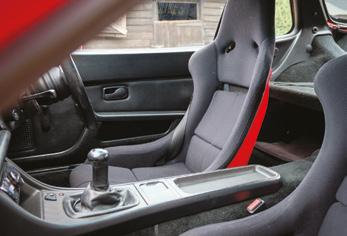

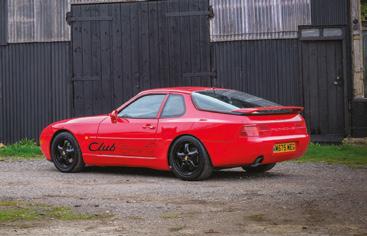
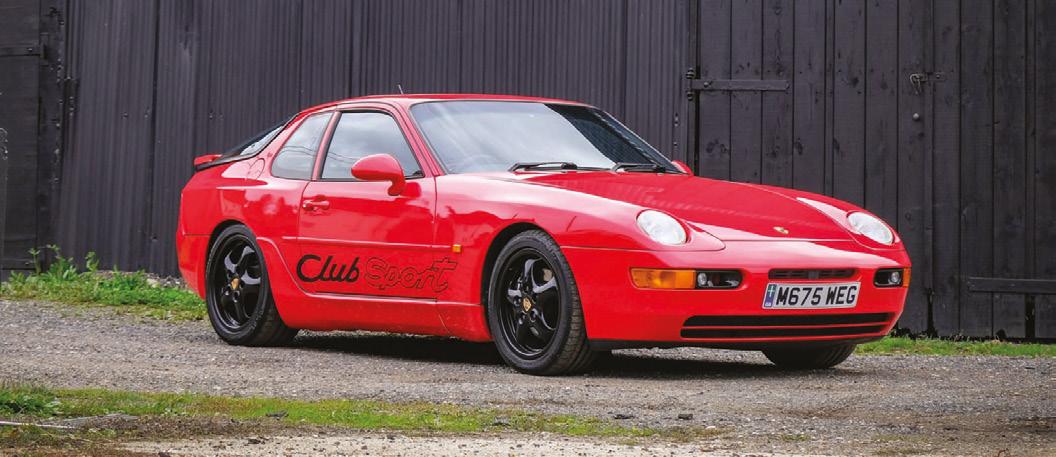














H&H Classics, The Motor House, Lyncastle
Auction Date
Paddle No. (official use only)
Warrington,
sales@HandH.co.uk
Debit / Credit Card Details
Bank Name
Account No.
Sort Code
Personal Details
Title Name
Surname
Address
Town / City Country Postcode
Contact Telephone No.
Mobile No.
I hereby give consent for H&H Classics to hold my personal data and send me auction updates and preview catalogues. I may withdraw consent at any time by contacting sales@HandH.co.uk
Card No.
Valid From
Expiry Date
Issue No. Security Code
Billing Address
Town / City Country Postcode
Identification
Identification Type 1
Identification Type 2
Please provide a minimum of two forms of identification: Passport, Drivers License or Bank Card (photocopies or scans only)
I have read and understood the terms and conditions printed in this catalogue. I agree that they are incorporated into this contract and I agree to be bound by them. I also understand that I must pay H&H Classics Ltd a Buyer’s Premium equal to 12.5% of the Hammer Price plus VAT.
Date Bidders Signature
(PLEASE COMPLETE IN BLOCK CAPITALS)
H&H Classics, The Motor House, Lyncastle Road, Warrington, Cheshire, WA4 4SN, United Kingdom | HandH.co.uk | sales@HandH.co.uk | +44 (0)1925 210035
Auction Date
Paddle No. (official use only)
Title Name
Surname Address Town / City Country Postcode
Contact Telephone No.
Mobile No. Email
I have read and understood the terms and conditions printed in this catalogue. I agree that they are incorporated into this contract and I agree to be bound by them.
I also understand that I must pay H&H Classics Ltd a Buyer’s Premium equal to 12.5% of the Hammer Price plus VAT.
Debit / Credit Card Details
Bank Name Account No.
Sort Code Card No.
Valid From Expiry Date
Issue No. Security Code
Billing Address Town / City Country Postcode
Identification
Identification Type 1 Identification Type 2
Please provide a minimum of two forms of identification: Passport, Drivers License or Bank Card (photocopies or scans only)
I hereby give consent for H&H Classics to hold my personal data and send me auction updates and preview catalogues. I may withdraw consent at any time by contacting sales@HandH.co.uk
H&H Classics are instructed to accept telephone / commission bids on the following lots. I understand that all the lots on offer are sold as collectors’ items and are not sold as operational means of transport. Please indicate if your bid is a telephone bid (Tel.) or commission bid (Com.) by ticking the relevant box on the table provided below.
Tel. Com. Lot No. Description £ (Com. bids only)
These conditions apply to all sales held by H&H Classics Limited in England and Wales to the exclusion of all other Terms and Conditions and no alteration or modification to these Conditions will be binding on H&H Classics Limited unless accepted in writing by them.
Your attention is specifically drawn to the “Notes for Intending Purchasers” published in the front of the catalogue.
In these Terms and Conditions the following words and expressions shall unless the context otherwise requires have the following meanings:
Auctioneer means H&H Classics Limited whose Registered Office is at 8 Eastway, Sale, Cheshire UK M33 4DX; company number 02852199 and Auctioneer means its representative who actually conducts the sale.
Bidders Registration Form means the form to be completed by each bidder pursuant to Condition 12.5.
The Buyer is the only person whose bid is accepted by the Auctioneer to conclude the contract for the purchase of a Lot.
Buyer’s Commission shall have the meaning given in Condition 14.
Catalogue includes any advertisement, brochure, estimate, price list and other publication generated or published by or on behalf of the Auctioneer in relation to a sale.
Contract means the contract formed pursuant to these Conditions between any of the Seller, the Buyer and the Auctioneer.
Entry Form means the form to be completed by the Seller as to each separate Lot pursuant to Condition 1.1.
Estimated Value means the value given by the Seller in the Entry Form as the Estimated Value of the vehicle and if more than one value is given, the higher of those values.
Expenses in relation to a Lot means the Auctioneer’s charges and expenses for illustrations, special advertising, packing, freight, transport, storage and any other charges and expenses of that Lot (other than the commission) plus VAT on any of them.
The charges for uplifting an item, either sold or unsold, into storage, with charges, are as follows:
Uplift - From £175
Storage - £10 per day for the first fourteen days or part thereof and £30 per week or part thereof thereafter (subject to change without notice).
Uplift - From £100
Storage - £5 per day for the first fourteen days or part thereof and £12 per week or part thereof thereafter (subject to change without notice).
Uplift - £20
Storage - £3 per day for the first fourteen days or part thereof and £8 per week of part thereof thereafter (subject to change without notice).
Charges for these items are determined by size and weight:
‘A’ - the standard charge and will not be marked in the sales catalogue£8 uplift and £1 per day storage (subject to change without notice).
‘B’ - larger items and marked * in the sales catalogue - £20 uplift, £2 per day storage (subject to change without notice).
‘C’ - the largest items marked ** in the sales catalogue - £50 uplift, £5 per day storage (subject to change without notice).
‘R’ - items needing to be ‘Referred’ for individual quotations marked ‘R’ in the sales catalogue (subject to change without notice).
Hammer Price means the price in £ sterling at which a Lot is knocked down by the Auctioneer to the Buyer at the fall of the hammer.
Lot means any item or items consigned with a view to its or their sale at auction.
Premises means the place at which the Auctioneer are conducting that particular sale.
Reserve means the minimum Hammer Price (if any) agreed between the Auctioneer and the Seller at which the Lot may be sold.
The Sale means the auction sale in respect of which the Lot is consigned for sale.
Sale Proceeds means the net amount payable by the Auctioneer to the Seller being the Hammer Price less the sum of the commission, the expenses, the entry fee (if not already paid) and the VAT chargeable on any of them.
Seller means the person who offers the Lot for sale whether or not he is the true owner.
Seller’s Commission means commission payable by the Seller pursuant to Condition 6.
Stated rates means the usual rates of Commission, Entry Fees and any other charges for the time being plus the VAT chargeable on any of them. The current rates are as follows:
Motor Cars
12.5% to the Buyer, 5% to the Seller (minimum £150 to both parties)
Entry Fee - £100 for a Standard Catalogue entry £200 for a Premium Catalogue entry £400 for a Deluxe Catalogue entry
15% to the Buyer, 10% to the Seller (minimum £50 to both parties) Entry Fee - £50 for a Standard Catalogue entry £100 for a Premium Catalogue entry £150 for a Deluxe Catalogue entry
15% to the Buyer, 15% to the Seller (minimum £50 to both parties) Entry fee - £50
15% to the Buyer (minimum of £10)
Seller’s charges available on application
Automobilia/Motobilia
15% to the Buyer (minimum of £5) Seller’s charges available on application
Total Amount Due means the Hammer Price in respect of the Lot sold plus the Buyer’s commission and additional charges and expenses due from a defaulting Buyer under these Conditions plus VAT chargeable on any of them expressed in £ sterling.
Payment can be made by bank transfer using our bank account details as follows:
Nat West, 23 Sankey Street, Warrington, Cheshire WA1 1XH
Account Name: H&H Classics Client Account Account No: 58868984
Sort Code: 01-09-17 BIC: NWBKGB2L IBAN: GB20NWBK01091758868984
Usual Charges means the total of the Commissions, Entry Fees and any other reasonable costs and expenses plus VAT payable thereon.
VAT means UK Value Added Tax at the prevailing rate from time to time.
Vehicles includes, where appropriate, incomplete vehicles.
1.1 An Entry Form in respect of each Lot must be completed fully and accurately, with an honest description of the Lot, signed and dated by the Seller and accompanied by the Entry Fee, when the Lot is entered. The Auctioneer may at any time ratify an incomplete form.
1.2 Any documentation pertaining to the Lot must be sent with the Entry Form to the Auctioneer’s office, or in any event delivered with the Lot to the Premises. The Contract between the Seller and the Auctioneer will be formed when the Auctioneer receives a signed Entry Form for the Lot, whether by hand, post, fax, email or by any other means, and whether or not the Entry Fee for that Lot has been paid, and whether or not the Form has been signed by the Auctioneer.
1.3 All relevant matters pertaining to the Lot such as a financial encumbrance, serious accident damage or other factors affecting value which are known to the Seller must be stated on the Entry Form. If a sale is lost because of the failure of the Seller to disclose to the Auctioneer all information which may reasonably be expected to affect the provenance, title, value or any other aspect of the Lot, the Auctioneer will charge and the Seller must pay the stated rates (both to Seller and Buyer) plus VAT.
1.4 If the Seller wishes to retain the registration number of a Lot, it is the Seller’s responsibility to notify the Auctioneer in writing on the Entry Form. It is the Seller’s responsibility to take all necessary steps to ensure that the current registration number is retained and a new number allocated prior to the Lot being sold. If the Seller does not do so, the Auctioneer shall not be responsible for any loss or damage whatsoever and howsoever arising out of the Seller’s loss of the right to the registration number following the sale of the Lot.
2.1 The Auctioneer shall have absolute discretion whether or not to accept any Lot for sale and shall be entitled to select the auction place, date, catalogue placement and photographs for the Lot.
2.2 The Seller gives the Auctioneer full and absolute right to photograph and illustrate any Lot placed in its hands for sale, and to use such photographs and illustrations as are provided by the Seller at any time at its absolute discretion (whether or not in connection with the Sale), with indemnity against copyright infringement.
2.3 The Seller is wholly responsible for the factual accuracy of, and for any judgments or opinions expressed in, the catalogue description of each Lot entered by him, and for any error, misstatement or omission of information in that description. Whether the description has been prepared by the Auctioneer or the Seller, a copy of the typed text will be provided to the Seller within a reasonable time prior to the Auction, and unless the Seller reacts with comments or changes prior to the Auction, the Auctioneer may treat that description as accepted by the Seller.
3.1 The Seller warrants to the Auctioneer and to the Buyer either that he is the true owner of the Lot or that he is duly authorised to sell the Lot by the true owner, and is able to transfer or procure transfer of good and marketable title to the Lot free from a third party claims or encumbrances.
3.2 In the event of an unsettled hire purchase, finance agreement or any other charge or lien affecting the Lot, the Auctioneer reserves the right to settle the amount due of such charges not exceeding the Sale Proceeds and if the Sale Proceeds are less than the charges outstanding the Seller will be responsible for the settlement of the balance forthwith. There will be a charge of £75 plus VAT for this service.
3.3 Each Lot, in the condition as described on the Entry Form, and with all keys, spare or extra items and documents shall be delivered to the Premises at the expense of the Seller. The Seller of a Lot not held by the Auctioneer at the Premises or under its control warrants and undertakes to the Auctioneer that the Lot will be
made available and in a deliverable state at the time stated by the Auctioneer.
3.4 The Seller shall indemnify both the Auctioneer, its Employees and Agents, and the Buyer separately, against all payments, costs, expenses, demands, or any loss or damage whatsoever and wheresoever incurred or suffered by any of them in respect of any breach of these Conditions on the part of the Seller.
4.1 The Seller shall be entitled, prior to the sale to place a Reserve on any Lot, this being the minimum Hammer Price at which the Auctioneer is authorised to sell that Lot and to make its usual charges. A Reserve once placed by the Seller shall not be changed without the consent of the Auctioneer.
4.2 The Auctioneer may, at its option, sell the Lot at a Hammer Price below the Reserve but in any such case the Sale Proceeds to which the Seller is entitled shall be the same as if the sale had been at Reserve.
4.3 Where no Reserve has been placed on the Lot the Auctioneer shall in no way be liable should the Lot be purchased for a price below the lowest estimated selling price. In any event, any written or oral estimate of likely selling price given by the Auctioneer is an expression of opinion only and may not be relied upon by the Seller nor give rise to any claim.
4.4 If a Reserve is placed by the Seller in a currency other than Pounds Sterling, such a Reserve shall be calculated and converted into Sterling at the spot rate of exchange quoted to the Auctioneer by the National Westminster Bank Plc at close of business on the last banking day prior to the date of the Sale. The certificate in writing of the Auctioneer as to such rate shall be conclusive.
4.5 Where a Reserve has been placed, only the Auctioneer may bid on that Lot on behalf of the Seller. Should the Seller buy in his own Lot, the Seller must pay to the Auctioneer its stated rates (both Seller and Buyer) before the Lot is removed.
5.1 The Seller may by notice to the Auctioneer withdraw the Lot from the Auction. If the Seller does so he shall be liable to pay the Auctioneer the stated rate of the Seller’s and Buyer’s commission calculated on the estimated value of the Lot that the Auctioneer would have received had the Lot been sold for the estimated value. For the purposes of this clause the estimated value shall be the higher of:-
(a) the Seller’s estimate of value as previously notified to the Auctioneer or if more than one figure the highest figure or if none;
(b) the value estimated in the catalogue or if more than one figure is given the highest figure, or if none,
(c) the Auctioneer’s reasonable estimate of its value; (d) plus VAT on such fee in either case and expenses;
5.2 In the event that the Seller withdraws the Lot from the Auction the Seller shall arrange for the collection/removal of the Lot at his own expense within 2 working days after the date of withdrawal provided that the Seller may not collect the Lot unless or until any withdrawal fee payable under Conditions 5.1 shall have been paid in full and any storage charges have been met by the Seller.
6. The Seller authorises the Auctioneer to deduct from the Hammer Price commission at the Stated Rate subject to the relevant minimum commission for each Lot, plus Expenses and VAT on both. The Seller acknowledges the Auctioneer’s right to charge and retain the Buyer’s Premium also in accordance with Condition 14.
7. The Seller of a Lot which is a road going means of transport warrants and undertakes to the Auctioneer that, as at the date of the Sale, either:
(a) the Lot will be VAT paid in the EU and registered in the UK, will be lawfully usable on the public road, complying with the provisions of current Road Traffic Legislation and all relevant regulations made thereunder and any statutory modifications thereof, and there is or will be in force an MOT Certificate required in relation to such use; or (alternatively)
(b) the Seller has notified the Auctioneer that the Lot does not or will not meet these requirements, and cannot legally be used on the road.
8. The Seller hereby agrees to indemnify the Auctioneer, its Agents and Employees against any and all claims, liability or damage and all related costs and expenses arising out of the proper execution by the Auctioneer of their obligations to the Seller under these Conditions, and in particular against any liability or claim which may be incurred by the Auctioneer as a result of any defect in the Lot, whether proving dangerous to human life or health or otherwise giving rise to a claim against the Auctioneer, or as a result of any default by the Seller or any breach of any of the warranties or undertakings herein by the Seller.
9.1 Where any Lot fails to sell, the Auctioneer shall notify the Seller accordingly. The Seller shall make arrangements either for the Auctioneer to re-offer that Lot for sale, or forthwith to collect the Lot and to pay the Expenses. If such arrangements are not made:
(a) by 1pm on the day following the date of the Sale, the Seller shall be responsible for the costs of any removal, storage and other expenses related to that Lot;
(b) within 3 months after formal notification by the Auctioneer to the Seller, the Auctioneer shall have the right (pursuant to the Torts (Interference with Goods) Act 1977 or any legislation that re-enacts or replaces it) to sell the Lot by private treaty or at public auction without reserve and to deduct from the Hammer Price or price received any sum owing to the Auctioneer including (without limitation) removal, storage and insurance expenses, the Expenses of both auctions, Commission at the Stated Rate on the sale and all other reasonable expenses, before remitting the balance to the Seller; or if he cannot be traced,
placing it in a bank account in the name of the Auctioneer on behalf of the Seller.
9.2 If the Seller later sells the Lot as a result of its exposure at the auction the Auctioneer will be entitled to their normal commission. In any event the Auctioneer will be entitled to try and effect a sale as the Seller’s agent within 14 days after the date of the auction (that time limit does not apply to a sale by the Seller). If the Auctioneer does so sell the Lot, they will also be entitled to their normal commission.
10.1 Where a Lot is sold, the Auctioneer shall initiate payment, by bank transfer, of the Sale Proceeds to the Seller 14 days after the Auctioneers have received in cleared funds the Total Amount Due from the Buyer. Should no bank details be provided by the seller, the Auctioneer will effect payment by sending its cheque, drawn in favour of the Seller, 14 days after receipt of cleared funds, by first class mail at the Seller’s risk.
10.2 If before the Total Amount Due is paid by the Buyer (whether or not because the Auctioneer has given credit terms to the Buyer) the Auctioneer pays to the Seller an amount equal to the net Sale Proceeds, title in the Lot shall pass from the Seller to the Auctioneer.
10.3 In the case of overseas Sellers, the Sale Proceeds will be paid to the Seller either in Sterling or in such other currency available to the Auctioneer as may have been agreed in writing between the Seller and the Auctioneer before the date of the Sale. The Auctioneer shall calculate the rate of exchange for the Sale Proceeds by reference to the spot rate of exchange quoted by the National Westminster Bank Plc at close of business on the date of the Sale, whichever is more favourable to the auctioneer.
10.4 If the Auctioneer receives notice of any dispute related to a sold Lot before the Sale Proceeds have been remitted to the Seller, the Auctioneer may withhold payment from the Seller until it thinks fit or until the Dispute is resolved, whichever is earlier.
10.5 The Auctioneer retains the right to withhold partial or total payment for any Lot if items committed to the Sale by the Seller and sold as part of the Lot, including any relevant documents, have not been delivered by the Seller.
10.6 The Seller shall maintain their insurance of the Lot until they are in receipt of the Sale Proceeds
11.1 If the Buyer fails to pay the Auctioneer the total Amount due within 21 days after the Sale, the Auctioneer will notify the Seller and take the Seller’s instructions as to the appropriate course of action. So far as in the Auctioneer’s opinion it is practicable, the Auctioneer will at the Seller’s expense assist the Seller to recover the Total Amount Due from the Buyer, but the Auctioneer shall be under no obligation to institute proceedings in its own name.
11.2 If circumstances outside the Auctioneer’s control do not permit the Auctioneer to take instructions from the Seller, the Seller hereby authorises the Auctioneer, at the Seller’s expense, to agree special terms for payment of the total Amount Due; to remove, store and insure the Lot sold; to settle claims made against the Buyer or the Seller on such terms as the Auctioneer shall in its absolute discretion think fit; to take
such steps as are necessary to collect the monies due by the Buyer to the Seller; and if necessary to rescind the sale and refund money to the Buyer.
12.1 Any motor vehicle is sold as a collector’s item and not as a means of transport. Buyers are specifically warned that any vehicle sold as such may well have had parts replaced and paint renewed or be made up of parts from other vehicles the condition of which may be difficult to establish. The Auctioneer has to rely on information as to the date, condition and authenticity provided by the Seller and does not provide its own description, and does not and cannot undertake its own inspection of vehicles or other Lot and it is the responsibility of the Buyer to ensure that the Lot conforms to the description in the catalogue. The Auctioneer cannot check or verify the authenticity of the chassis or VIN number under which a vehicle is offered, but relies on the Seller’s description. Buyers should take particular care to verify in advance the authenticity of a vehicle that is claimed to have important racing, rallying or ‘exworks’ history as it was common in period for a competition vehicle of a single identity to have more than one chassis, body or other mechanical components. This may have happened several times, both in a vehicle’s ‘works’ career and thereafter in private owner hands. Sometimes ‘works’ vehicles were fitted with different registration plates, so that a vehicle could meet a particular event’s start date deadline. These historical factors may lead to there being in existence multiple and competing claimants to the same vehicle identity.
12.2 The Buyer shall be the person making the highest bid at or over Reserve (if any) that is accepted by the Auctioneer, and the Contract shall be concluded at the fall of the hammer. The Auctioneer shall have the absolute discretion to settle any dispute related to bidding at the Sale. All sales are deemed not to be sales in the course of a business, unless notified to the contrary.
12.3 Every bidder shall be deemed to act as a principal unless the Auctioneer has, prior to the auction date, acknowledged (either by acceptance of the Bidder’s Registration Form which discloses the true principal, or otherwise in writing) that the bidder is acting as agent on behalf of a disclosed principal.
12.4 The Auctioneer may in its absolute discretion refuse to accept any bid, advance the bidding as it may decide, withdraw or divide any Lot, combine any two or more Lots, and in the case of dispute may put up any Lot for auction again.
12.5 A prospective bidder should register his intention to bid for a Lot by completing fully and signing a Bidder’s Registration Form prior to executing his bid. If this has not been completed before the fall of the hammer, the Buyer shall forthwith complete the Bidder’s Registration Form. The Bidder shall also provide photographic identification. Failure to do so shall not invalidate the sale, unless the Auctioneer, in its absolute discretion, so decides.
12.6 Any bid which fails to reach the Reserve may be submitted by the Auctioneer to the Seller and if the Seller accepts that bid, the Lot will be deemed to have been sold to the Buyer at the sum bid at the fall of the hammer and the normal Terms and Conditions will apply to that sale.
13.1 Where a Lot is illustrated by a photograph, in the case of a vehicle with a registration number visible, that number will not be transferred with the vehicle to the Buyer unless the registration particulars appear in the written part of the description and the transfer has been authorised by the Seller. If the vehicle is sold to the Buyer before the formalities of the allocation of a different registration number to that vehicle are completed with the DVLA, the Buyer accepts that he will take all steps necessary to co-operate with either the Seller or the Auctioneer to have the number re-transferred to the Seller or as may be, and will take no steps to register the vehicle with the number in his name.
13.2 Whilst the interests of prospective Buyers are best served by personal attendance at the Sale, the Auctioneers will if so instructed execute bids on their behalf. Neither the Auctioneer nor its Employees or Agents will be responsible for any error or default in doing so or in failing altogether to do so. Where the Auctioneer executes bids on behalf of an absent bidder, each Lot will be bought as cheaply as is allowed by other bids and any relevant Reserve.
14. The Buyer shall pay to the Auctioneer in respect of each Lot the Buyer’s Commission calculated on the Hammer Price at the stated rates as set out above.
15. Where a Lot is described in the Catalogue or announced at the time of Sale as being subject to VAT on import, VAT will be payable in addition to the Hammer Price (which VAT may or may not be refundable by HM Customs & Excise on proof of export).
16.1 Upon the sale of a Lot, the Buyer shall:
16.2 Unless he has already done so, complete a Bidder’s Registration Form as in Condition 12.5 above;
16.3 Pay to the Auctioneer the total amount due, at latest by midday on the day after the Sale, notwithstanding that where the Buyer wishes to export the Lot, an export licence may be required which must be obtained by the Buyer at his own cost;
16.4 Accept that any payments received by the Auctioneer from a Buyer may be applied by the Auctioneer towards any sums owing from that Buyer to the Auctioneer on any account whatsoever, without regard to any directions of the Buyer or his agent, whether express or implied.
17.1 Until the total amount due has been received by the Auctioneer:
(a) title in a Lot shall not pass to the Buyer but the risk shall;
(b) no Lot may be taken away by or on behalf of the Buyer.
17.2 The Buyer shall be responsible for any removal, storage and insurance charges and any other Expenses on any Lot not paid for and taken away from the by 1pm on the day following the day of the sale.
17.3 If the Lot remains under the vendor’s control for any reason, either at their property or a third-party one, then the Buyer must remove it within ten days of the sale. Failure to do so will result in the Lot being uplifted to secure storage at the Buyer’s expense.
18.1 If a Buyer fails either to pay for or to take away any Lot, the Auctioneer may without further notice to the Buyer, at its discretion and without prejudice to any other rights or remedies it may have, exercise one or more of the following rights or remedies, as may be relevant, in relation to any and all remedies for non-payment that the Auctioneer may choose to exercise. The Buyer will pay to the Auctioneer all legal and other costs borne by it on a full indemnity basis.
18.2 To charge interest at a rate not exceeding 3% per month over Natwest Bank’s base rate on so much of the total amount due as remains unpaid after the date and time referred to in condition 16.3 for the first two months. After that period of time to charge interest at a rate not exceeding 1.75% per month over Natwest Bank’s base rate on so much of the total amount due as remains unpaid after the date and time referred to in condition 16.3.
18.3 To issue proceedings against the Buyer for payment of the total amount due and/or for damages for breach of contract. If the Seller decides to sell the Lot elsewhere, the Auctioneer may proceed against the Buyer for the Commission which it would have earned both from the Seller and the Buyer together with VAT on both had the Buyer paid for the Lot in accordance with these Conditions.
18.4 To rescind the sale of that or any other Lots sold to the same Buyer at this or any other Sale, in respect of which title has not passed.
18.5 To resell the Lot or cause it to be resold by public or private sale, such that any deficiency in the total amount due resulting from such resale (after giving credit for any payment) together with the full costs incurred in connection with the Lots shall be paid to the Auctioneer by the Buyer; any surplus in excess of the Sale Proceeds of that resale shall belong to the Seller.
18.6 To store the Lot at the sole expense of the Buyer and to release the Lot only after payment in full of the total amount due, together with the accrued cost of the removal, storage and insurance and all other expenses incurred in connection with the Lot.
18.7 To retain that or any other Lot sold to the Buyer at the same or any other auction and to release the same only after payment of the total amount due.
18.8 To apply by way of set-off any Sale Proceeds of any Lot then due or at any time thereafter becoming due to the Buyer towards settlement of the total amount due and expenses and the Auctioneer shall be entitled to a lien on any property of the Buyer which is in the Auctioneer’s possession for any purpose.
18.9 To reject or ignore any bids made by or on behalf of the defaulting Buyer at any future sales or insist upon a cash deposit before accepting any bids in future.
19.1 All Lots are offered as seen with all faults and defects without any guarantee or warranty attaching thereto as to condition, roadworthiness or otherwise and with all faults and defects whether apparent upon examination or not.
19.2 In any event, neither the Seller nor the Auctioneer shall be liable for
any indirect or consequential loss whatsoever, and the maximum liability of the Auctioneer together with its Employees and Agents, in the event of any claim against them arising from the sale of any Lot shall be limited to the Hammer Price plus Buyer’s Premium in respect of that Lot.
20. The Auctioneer in all respects acts and will be treated as agent for the Seller (except where the Auctioneer is expressly stated to be selling as principal), and is not responsible for any default by the Seller or the Buyer to the other party.
21. The Auctioneer will not accept any liability for damage sustained to a Lot that is attributable to members of the public or non-Auctioneer operatives during the Sale or any removable items left within lots during the same period. Any claims for damage and / or lost items must be submitted to the Auctioneer in writing no later than 3 working days after the date of the Sale and include a valid quote for repair or replacement and digital photographs where applicable.
22. The Auctioneer shall be under no liability for any injury, damage or loss sustained by any person while on the Auctioneers premises (including any premises where a sale may be conducted or where a Lot, or a part of a Lot, may be on view from time to time) except for death or personal injury caused by the negligence of the Auctioneers or its employees and agents in the course of their duties to the Auctioneers.
23. The Auctioneer shall have the right, at its sole discretion, without assigning any reason, to refuse any person admission to its Premises or attendance at any of its Sales, or to view any Lot.
24. The Auctioneer shall keep and use any data relating to the Buyer and the Seller in accordance with the provisions of all relevant data protection legislation. The Buyer and the Seller consent to such data being kept and used for appropriate purposes, including informing the Buyer and the Seller of any offers or other matters of interest from time to time.
25. The copyright in all written matter and illustrations relating to Lots shall remain at all times the absolute property of the Auctioneer, and any person wishing to use such materials, or any part of them, shall require the prior written consent of the Auctioneer.
26. If any Condition or part of a condition in these Terms shall be held to be invalid or unenforceable, the validity or enforceability of the remaining Conditions will not thereby be affected.
27. These Conditions shall be governed by and construed in accordance with English Law. All transactions to which these Conditions apply and all matters connected therewith shall also be governed by English Law. Each of the Auctioneer, the Seller, the Buyer and any bidder hereby submits to non-exclusive jurisdiction of the courts of England and Wales.

